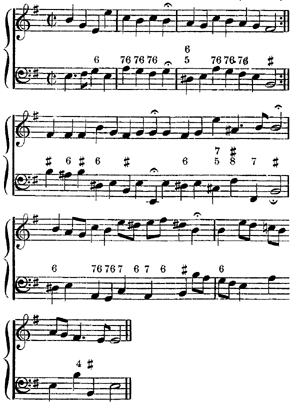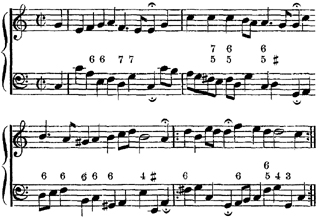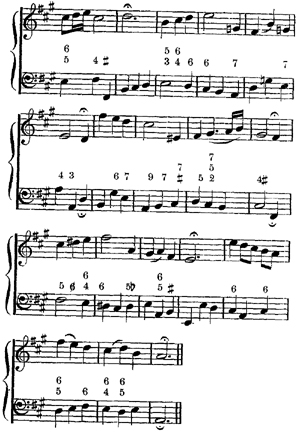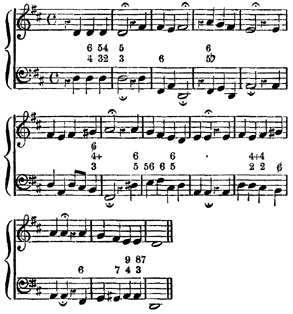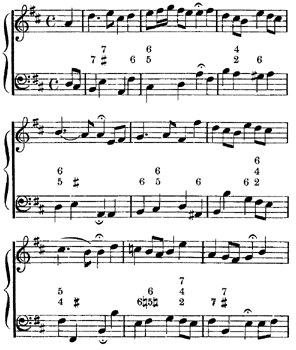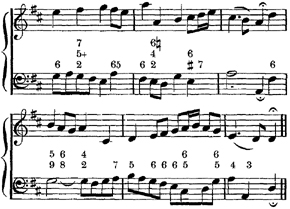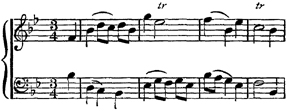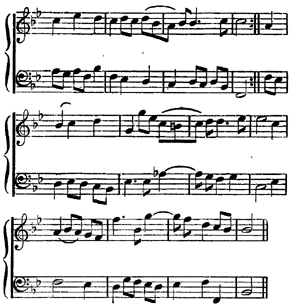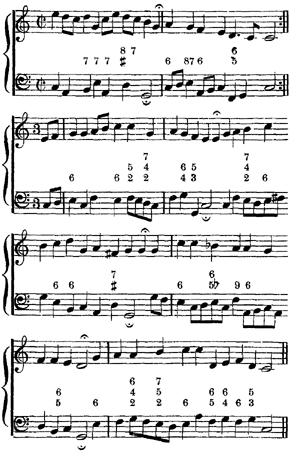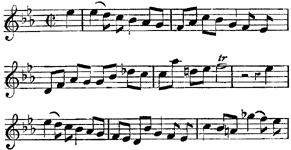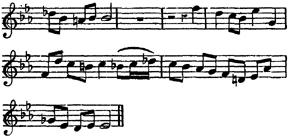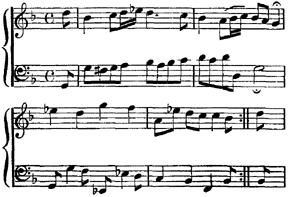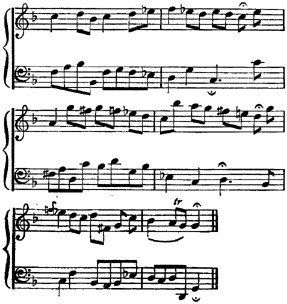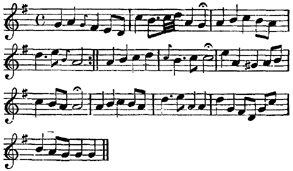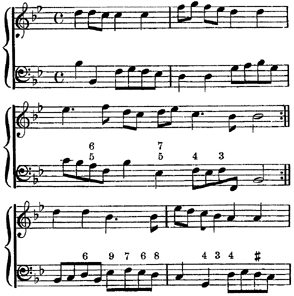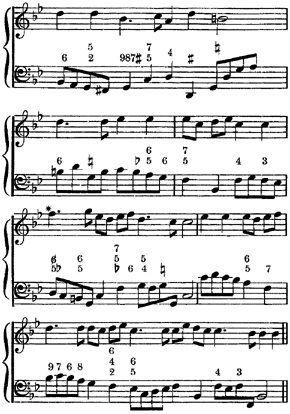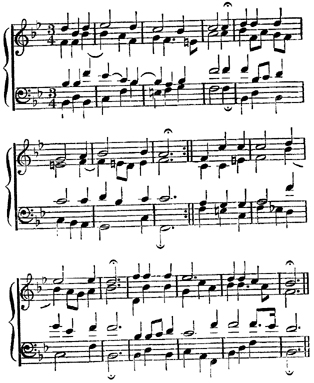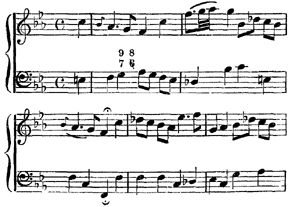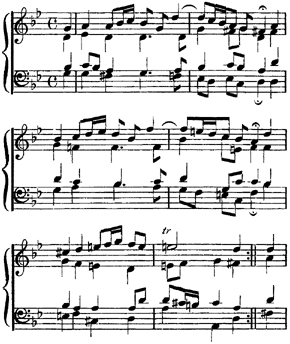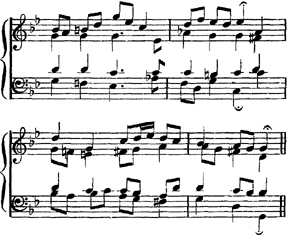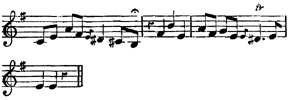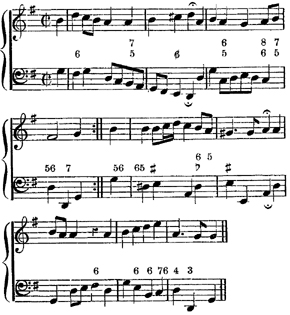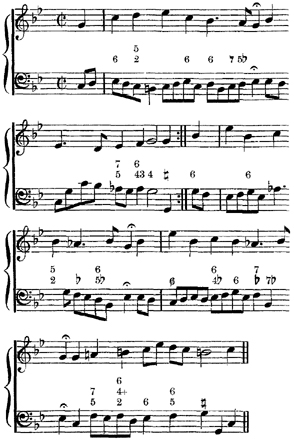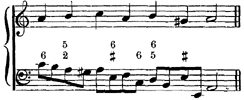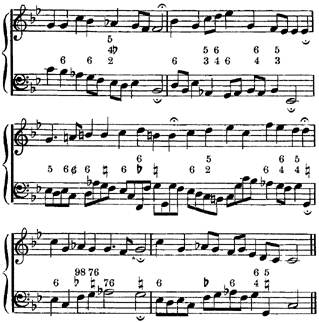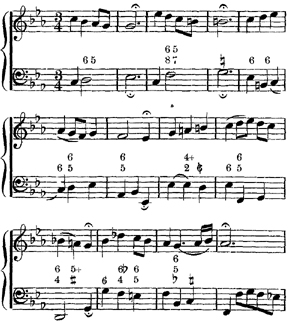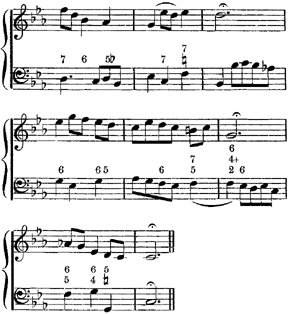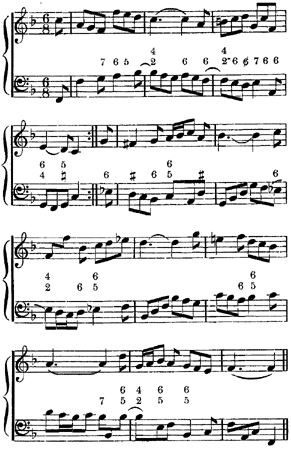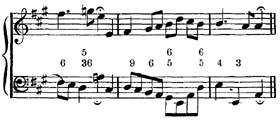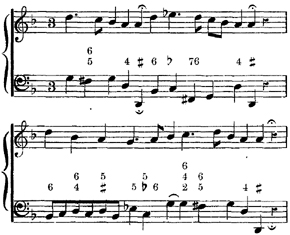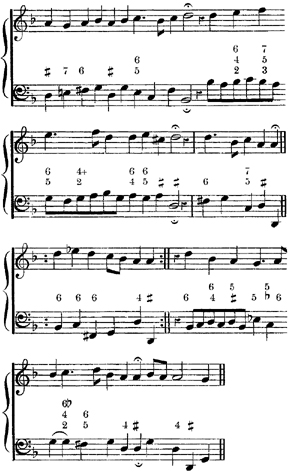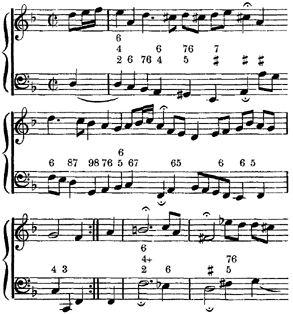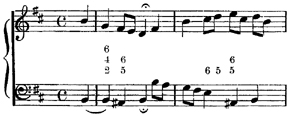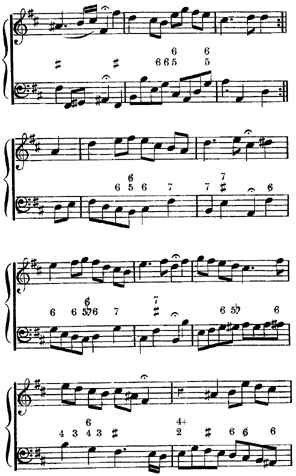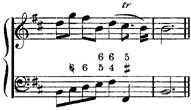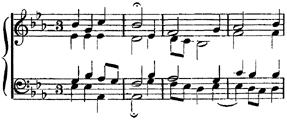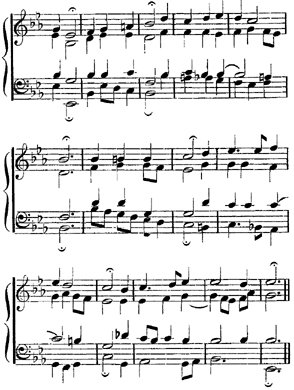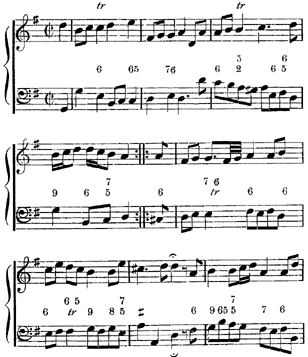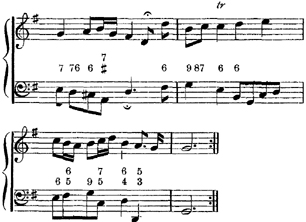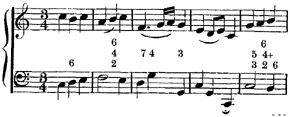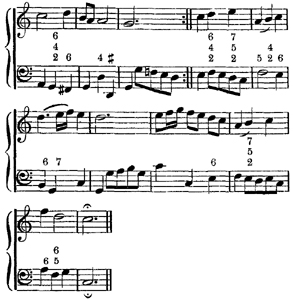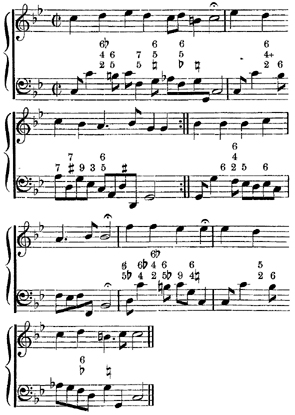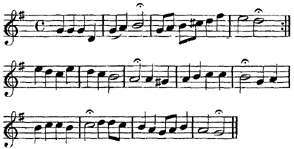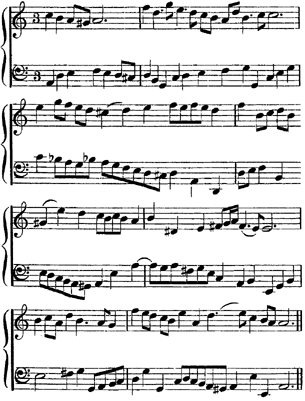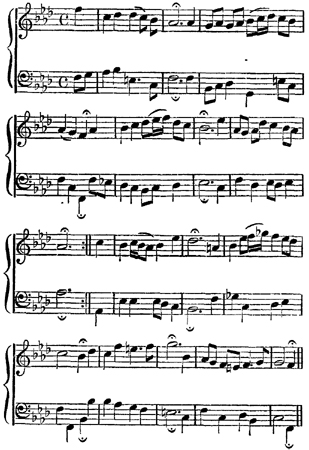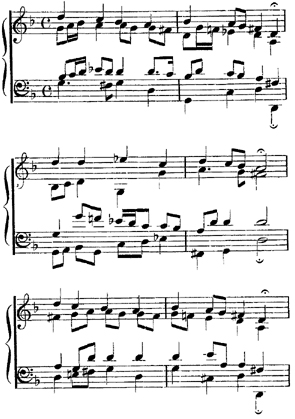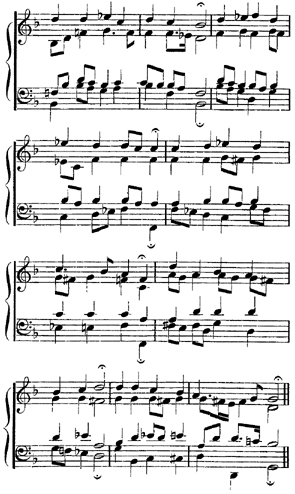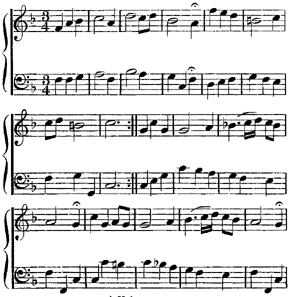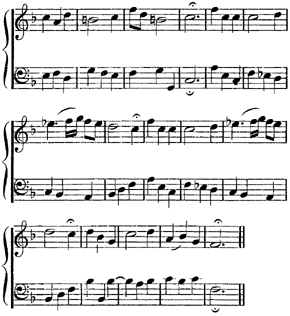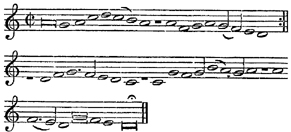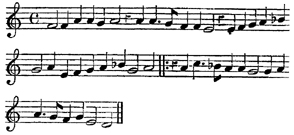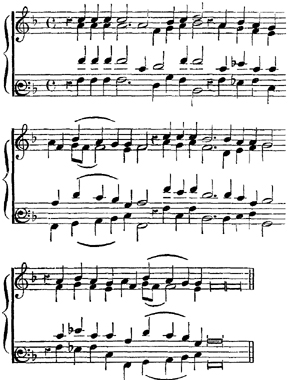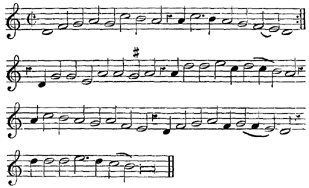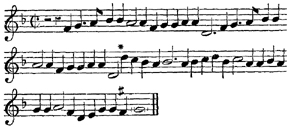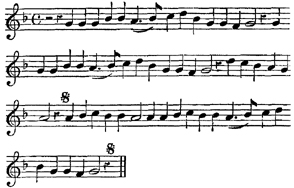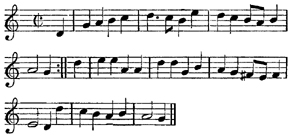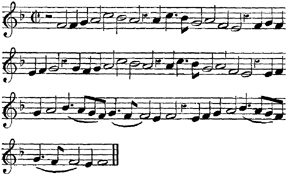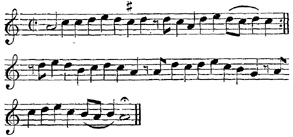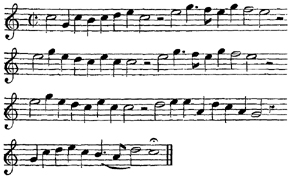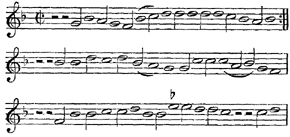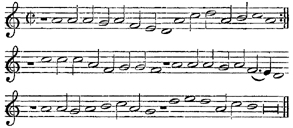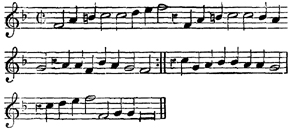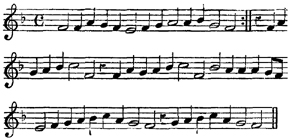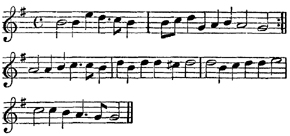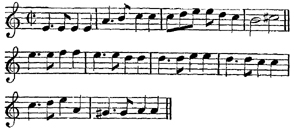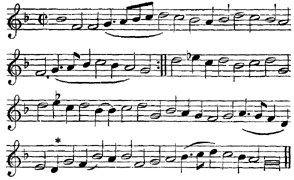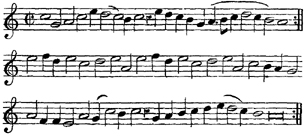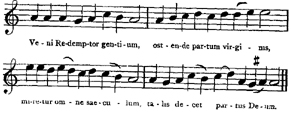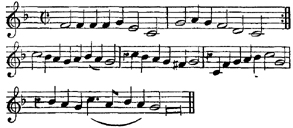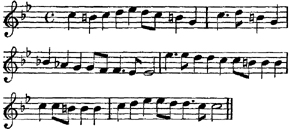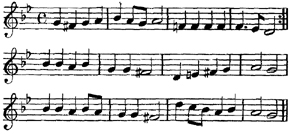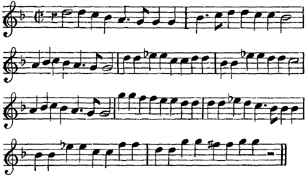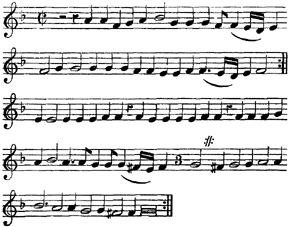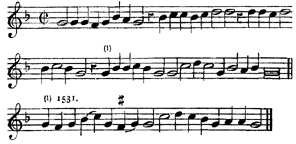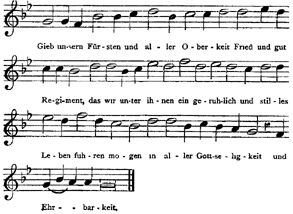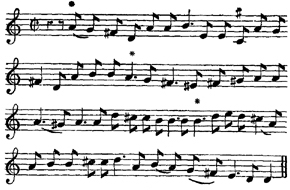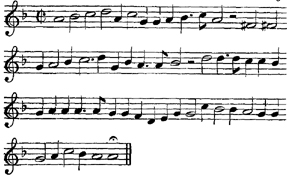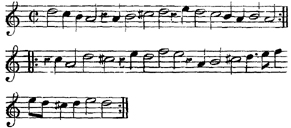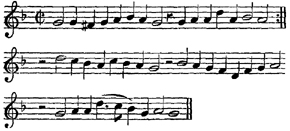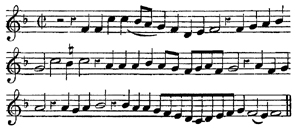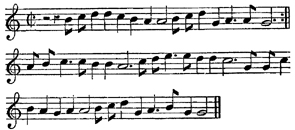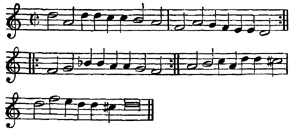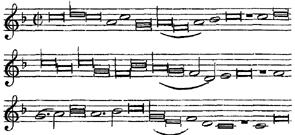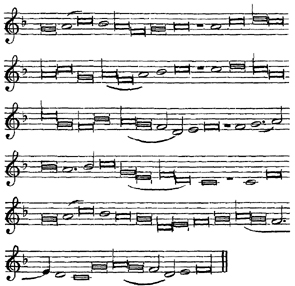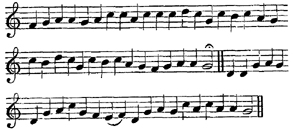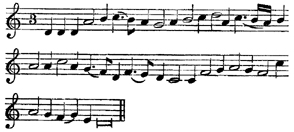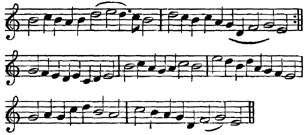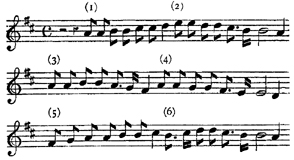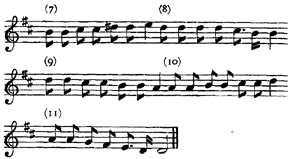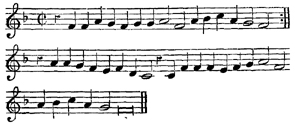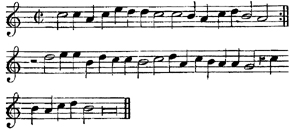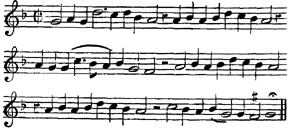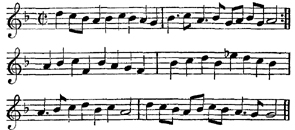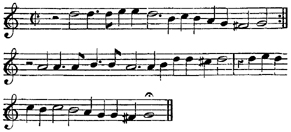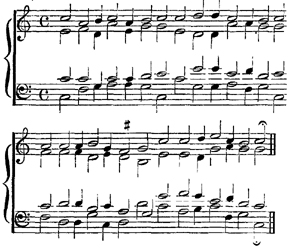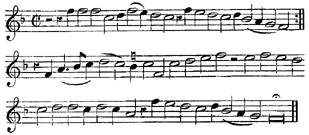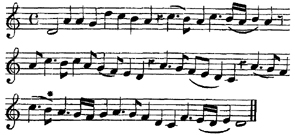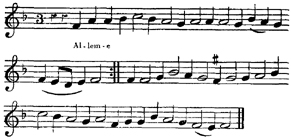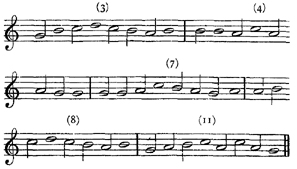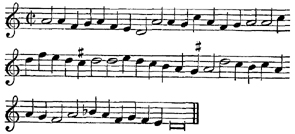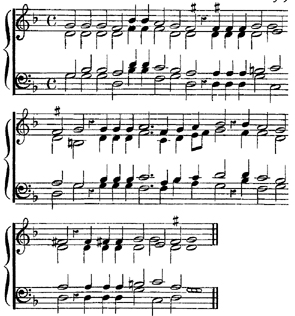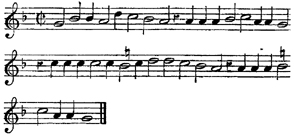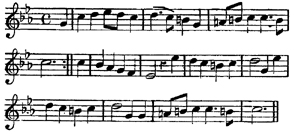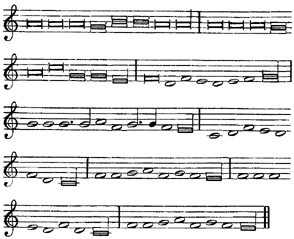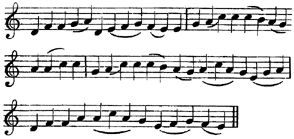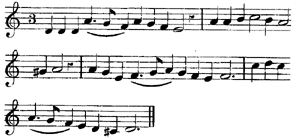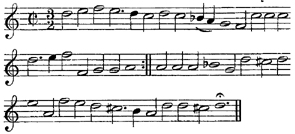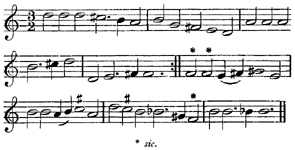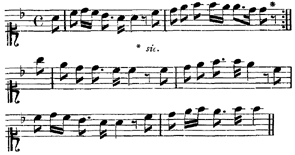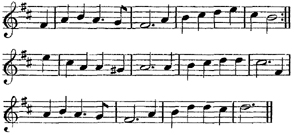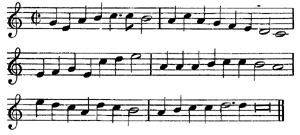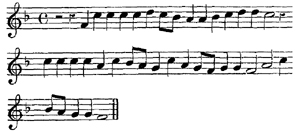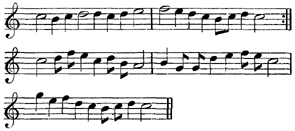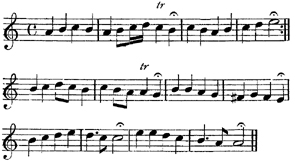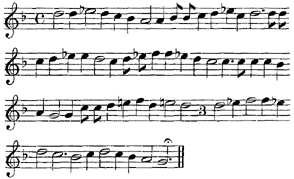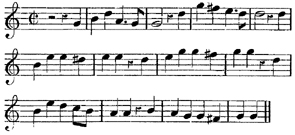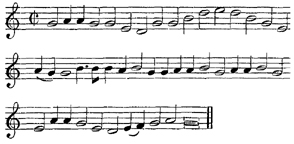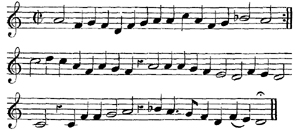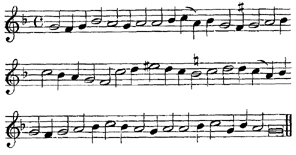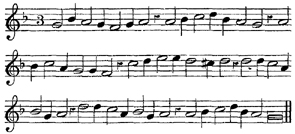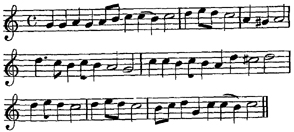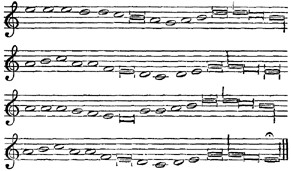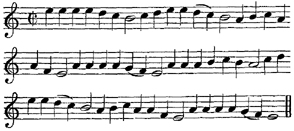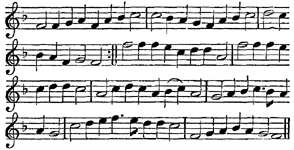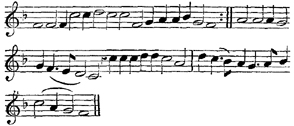INTRODUCTION
The Cantatas
There is early and adequate authority for the belief that Bach wrote five complete “year books” of Church Cantatas, i.e. five Cantatas for every one of the Sundays and Festivals of the ecclesiastical year. At Leipzig fifty-nine Cantatas were required annually. Consequently, Bach must have written two hundred and ninety-five Cantatas. Of that number certainly thirty were written before he was inducted at Leipzig as successor to Johann Kuhnau (1667-1722) on May 31, 1723. Bach did not write Cantatas during the last years of his life: the latest that can be dated is “Du Friedefürst, Herr Jesu Christ” (No. 116), written for the Twenty-fifth Sunday after Trinity, November 15, 1744. It is therefore reasonable to limit his Edition: current; Page: [2] activity as a composer at Leipzig to twenty-one years. On that hypothesis, he must have written twelve or thirteen Church Cantatas every year, or at the rate of one every month. If it be remembered that during the same period Bach’s genius was exceedingly productive in other forms of musical expression, the conclusion that he was a rapid writer hardly can be challenged, though Spitta disputes it.
Less than seventy per cent. of Bach’s Church Cantatas survive. The set of five is complete only for Christmas Day, New Year’s Day (Feast of the Circumcision), Whit Sunday (though one of the five is of doubtful authenticity), Feast of the Purification of the B. V. M., and the Feast of St Michael the Archangel (one of which is of doubtful authenticity). There are four Cantatas in every case for the Third Sunday after Epiphany, Quinquagesima, Easter Day, Ascension Day, Sixteenth Sunday Edition: current; Page: [3] after Trinity, and the Twenty-first Sunday after Trinity. For no other Festival or Sunday have more than three Cantatas survived, and most of them have less.
Without reckoning the six Cantatas which form the “Christmas Oratorio,” there survive two hundred and six Church Cantatas composed by Bach, or attributed to him, all of which are published by the Bachgesellschaft. Nos. 1-190 bear the numbers assigned to them in the volumes of the Bachgesellschaft. Nos. 191-198, which are not grouped in a single volume of the B. G. edition, bear the distinguishing numbers attached to them in vol. xx of Breitkopf & Haertel’s vocal scores of the Church Cantatas. No. 199 is published by the Neue Bachgesellschaft. There remain three Cantatas which are incomplete: in the following pages they are designated U 1, U 2, U 3. Finally, there are four Cantatas of doubtful authenticity (B. G. xli): they are here indicated as D 1, D 2, D 3, D 4.
Four of the Church Cantatas (Nos. D 1, D 2, D 3, D 4) were written at dates which are not ascertained.
Edition: current; Page: [4]
The remaining 202 Cantatas are distributed between the five periods of Bach’s career:
I. (1704-1708). Arnstadt and Mühlhausen Cantatas (3). Nos. 15, 71, 131.
II. (1708-1717.) Weimar Cantatas (23). Nos. 18, 21, 31, 59, 61, 70, 106, 132, 142, 147, 150, 152, 155, 158, 160, 161, 162, 163, 182, 185, 189, 196, 199.
III. (1718-1722.) Cöthen Cantatas (4). Nos. 47, 134, 141, 173.
IV. (1723-1734.) Leipzig Cantatas (100). Nos. 4, 8, 9, 12, 16, 19, 20, 22, 23, 24, 25, 27, 28, 29, 35, 36, 37, 40, 42, 44, 46, 49, 51, 52, 55, 56, 58, 60, 63, 64, 65, 66, 67, 69, 72, 73, 75, 76, 77, 80, 81, 82, 83, 84, 86, 88, 89, 93, 95, 97, 98, 99, 102, 104, 105, 107, 109, 112, 117, 119, 120, 129, 136, 137, 140, 144, 145, 148, 149, 153, 154, 156, 157, 159, 164, 165, 166, 167, 168, 169, 170, 171, 172, 174, 177, 179, 181, 184, 186, 187, 188, 190, 191, 192, 194, 195, 198, U 1, U 2, U 3.
V. (1735-1750.) Leipzig Cantatas (72). Nos. 1, 2, 3, 5, 6, 7, 10, 11, 13, 14, 17, 26, 30, 32, 33, 34, 38, 39, 41, 43, 45, 48, 50, 53, 54, 57, 62, 68, 74, 78, 79, 85, 87, 90, 91, 92, 94, 96, 100, 101, 103, Edition: current; Page: [5] 108, 110, 111, 113, 114, 115, 116, 118, 121, 122, 123, 124, 125, 126, 127, 128, 130, 133, 135, 138, 139, 143, 146, 151, 175, 176, 178, 180, 183, 193, 197.
It will be convenient to group the Church Cantatas according to the seasons of the Church’s year:
Sundays in Advent.
First (Epistle Rom. xiii. 11-14. Gospel St Matt xxi. 1-11).
| The text of the Cantata is suggested by the Epistle for the Day. |
| The text of the Arias and first Chorus is by Christian Friedrich Henrici. He was born at Stolpe in 1700, and, about the time of Bach’s appointment as organist, settled in Leipzig, where he held a position in the Post Office, and later in the Excise. He died in 1764. In 1725 he published a “Collection of profitable thoughts for and upon the ordinary Sundays and Holy Days” (Sammlung Erbaulicher Gedancken, Bey und uber die gewohnlichen Sonn- und Festtags-Evangelien, Leipzig). To avoid the ridicule which his religious reflexions might arouse, Henrici adopted the pseudonym “Picander.” In 1728 he published a collection of texts for Cantatas, the only one of the kind which he brought out: Cantaten auf die Sonn- und Fest-Tage durch das gantze Jahr (Leipzig). In the Preface to the volume he declares that he had been impelled to write by the prospect of his work’s deficiencies being made good “by the loveliness of the music of our incomparable Kapellmeister Bach.” He must be regarded as the author of most of the Cantatas Bach composed at Leipzig. But it is difficult to point absolutely to the texts which are by him, since he published none but those in the collection of 1728. His Cantata libretti show facility rather than sincerity and poetic expression. His power of pictorial representation commended him to Bach, and there can be little doubt that he put his texts together in the form in which Bach required them. Though the list is necessarily incomplete, the following Cantatas were either positively or probably composed to Picander’s texts: Nos. 6, 30, 36, 42, 67, 73, 84, 93, 144, 145, 148, 156, 157, 159, 171, 174, 188, U 1. See Spitta, ii. 340 et seq. on Picander. |
| The text of the Cantata is suggested by the Epistle for the Day. |
| The Cantata bears the title of the first stanza of a congregational Hymn. See infra the section on the Cantata. |
| Text by Erdmann Neumeister. He was born at Uechtritz, near Weissenfels, in 1671, was educated at Leipzig University, and, after holding Court appointments at Weissenfels and Sorau, was appointed in 1715 pastor of St James’ Church, Hamburg. He died at Hamburg in 1756. He was a very prolific Hymn writer; over 650 are attributed to him. Of his Cantata texts Bach set eight. They are Nos. 18, 24, 27, 28, 59, 61, 142, 160. On Neumeister see Spitta, i. 470 et seq. |
| 36 |
Schwingt freudig euch empor, |
|
| 61 |
Nun komm, der Heiden Heiland, , . |
| 62 |
Nun komm, der Heiden Heiland, . |
Second. See No. 70. (E. Rom. xv. 4-13. G. St Luke xxi. 25-36.)
Third (E. 1 Cor. iv. 1-5. G. St Matt. xi. 2-10).
| The text is from a cycle of Church Cantata texts published by the State Secretary, Johann F. Helbig, at Eisenach, in 1720. |
| 141 |
Das ist je gewisslich wahr. |
Fourth (E. Phil. iv. 4-7. G. St John i. 19-28).
| The text is provided or suggested by the Gospel for the Day. |
| The libretto is one of Salomo Franck’s Cantata texts. He was born at Weimar in 1659, and, after holding public appointments at Arnstadt and Jena, was appointed Curator of the Ducal collection of coins and medals at Weimar in 1702. He died at Weimar in 1725. He was a prolific Hymn writer, but none of his Hymns appears among the 154 which Bach used for his choral works. On the other hand, during his residence at Weimar Bach made use of Franck’s Cantata texts, two series of which were published, the first in his Evangelisches Andachts-Opffer (Weimar, 1715), and the second in his Evangelische Sonn- und Fest-Tages Andachten (Weimar & Jena, 1717) (see Spitta, i. 526 et seq., 569 et seq.). The texts of the following Cantatas are by Franck: Nos. 31, 70, 72, 80, 132, 147, 152, 155, 161, 162, 163, 164, 165, 168, 185, 186, and perhaps 12, 21, 53, 172, 182. Of these twenty-one Cantatas nine (Nos. 12, 53, 72, 80, 164, 165, 168, 172, 186) fall within the first Leipzig period. |
| 132 |
Bereitet die Wege, bereitet die Bahn, |
Edition: current; Page: [7]
Christmas Day (E. Titus ii. 11-14 or Isaiah ix. 2-7. G. St Luke ii. 1-14).
| The text, Wustmann (p. 273) holds, is wrongly attributed to Picander. |
| The Cantata bears the title of the first stanza of a congregational Hymn. See infra the section on the Cantata. |
| Psalm cxxvi. 2. The author of the libretto is not known (Wustmann, p. 274). Schweitzer (ii. 343) attributes it to Picander. |
| The text is provided or suggested by the Gospel for the Day. |
| Isaiah ix. 6. |
| Text by Neumeister. |
| Bach’s authorship is contested. See Bachjahrbuch, 1912, p. 132. |
| The “Gloria” of the B mi. Mass. |
| Text by Picander. |
| 63 |
Christen atzet diesen Tag. |
| 91 |
Gelobet seist du, Jesu Christ. |
| 110 |
Unser Mund sei voll Lachens, . |
| 142 |
Uns ist ein Kind geboren, , . |
| 191 |
Gloria in excelsis Deo, . |
| U 1 |
Ehre sei Gott in der Höhe, . |
Feast of St Stephen (E. Titus iii. 4-7 or Acts vi. 8-15, vii. 51-59. G. St Luke ii. 15-20).
| 1 St John iii. 8. Text by Bach? |
| St James i. 12. |
| The Cantata bears the title of the first stanza of a congregational Hymn. See infra the section on the Cantata. |
| 40 |
Dazu ist erschienen der Sohn Gottes |
| 57 |
Selig ist der Mann. |
| 121 |
Christum wir sollen loben schon. |
Feast of St John the Evangelist (E. Heb. i. 1-12 or 1 John. G. St John i. 1-14).
| 1 St John iii. 1. |
| Text probably by Bach. |
| 64 |
Sehet, welch’ eine Liebe. |
| 133 |
Ich freue mich in dir. |
| 151 |
Süsser Trost, mein Jesus kommt. |
Sunday after Christmas (E. Gal. iv. 1-7. G. St Luke ii. 33-40).
| Text by Neumeister. |
| Text by Salomo Franck. The subject of the Cantata is remotely suggested by the Gospel for the Day. See Spitta, i. 560. |
| 28 |
Gottlob! nun geht das Jahr zu Ende. |
| 122 |
Das neugebor’ne Kindelein, . |
| 152 |
Tritt auf die Glaubensbahn. |
Feast of the Circumcision (New Year’s Day) (E. Gal. iii. 23-29. G. St Luke ii. 21).
| Psalm cxlvi. 1, 5, 10. |
| Psalm xlviii. 10. Text by Picander. |
| Psalm cxlix. |
| Text wrongly attributed to Picander. See Wustmann, p. 297. |
| 16 |
Herr Gott dich loben wir, . |
| 41 |
Jesu, nun sei gepreiset. |
| 143 |
Lobe den Herrn, meine Seele, . |
| 171 |
Gott, wie dein Name, so ist auch dein Ruhm. |
| 190 |
Singet dem Herrn ein neues Lied, |
Edition: current; Page: [9]
Sunday after the Circumcision (E. 1 Peter iv. 12-19. G. St Matt. ii. 13-23).
| The Cantata bears the title of the first stanza of a congregational Hymn. See infra the section on the Cantata. |
| Wustmann (p. 276) attributes the text to Bach. |
| The text is provided or suggested by the Gospel for the Day. |
| Text perhaps by Bach. |
| 58 |
Ach Gott, wie manches Herzeleid, , , |
| 153 |
Schau’, lieber Gott, wie meine Feind’, , . |
Feast of the Epiphany (E. Isaiah lx. 1-6. G. St Matt. ii. 1-12).
| Isaiah lx. 6. See the Epistle for the Day. |
| 65 |
Sie werden aus Saba Alle kommen, . |
| 123 |
Liebster Immanuel, Herzog der Frommen. |
Sundays after the Epiphany
First (E. Rom. xii. 1-6. G. St Luke ii. 41-52).
| The author is unknown. Perhaps Picander. |
| Wustmann (p. 277) supposes the authors of Nos. 81 and 154 to be identical. |
| 32 |
Liebster Jesu, mein Verlangen, . |
| 124 |
Meinen Jesum lass’ ich nicht, . |
| 154 |
Mein liebster Jesus ist verloren, . |
Second (E. Rom. xii. 7-16. G. St John ii. 1-11).
| Cf. Spitta, iii. 84, on Bach’s conventional treatment of the Gospel subject in these Cantatas. |
| Text by Salomo Franck. |
| 3 |
Ach Gott, wie manches Herzeleid, . |
| 13 |
Meine Seufzer, meine Thranen. |
| 155 |
Mein Gott, wie lang’, ach lange, . |
Third (E. Rom. xii. 17-21. G. St Matt. viii. 1-13).
| The Cantata bears the title of the first stanza of a congregational Hymn. See infra the section on the Cantata. |
| Picander’s asserted authorship is challenged. See Spitta, ii. 414; Wustmann, p. 277. |
| The text is provided or suggested by the Gospel for the Day. |
| Text by Picander. |
| 72 |
Alles nur nach Gottes Willen, . |
| 73 |
Herr, wie du willt, so schick’s mit mir, , . |
| 111 |
Was mein Gott will, das g’scheh’ allzeit, . |
| 156 |
Ich steh’ mit einem Fuss im Grabe, . |
Fourth (E. Rom. xiii. 8-10. G. St Matt. viii. 23-27).
| Wustmann (p. 277) supposes the authors of Nos. 81 and 154 to be identical. |
| 14 |
War’ Gott nicht mit uns diese Zeit, . |
| 81 |
Jesus schlaft, was soll ich hoffen?, . |
Septuagesima Sunday (E. 1 Cor. ix. 24—x. 5. G. St Matt. xx. 1-16).
| A revision of Picander’s text, perhaps by Bach. |
| Text probably by Picander. |
| 84 |
Ich bin vergnugt mit meinem Glucke, , . |
| 92 |
Ich hab’ in Gottes Herz und Sinn, , . |
| 144 |
Nimm, was dein ist, und gehe hin, |
Sexagesima Sunday (E. 2 Cor. xi. 19—xii. 9. G. St Luke viii. 4-15).
| Text by Neumeister. |
| Isaiah lv. 10. |
| 18 |
Gleich wie der Regen und Schnee, , . |
| 126 |
Erhalt’ uns, Herr, bei deinem Wort, . |
| 181 |
Leichtgesinnte Flattergeiste. |
Quinquagesima (“Esto Mihi”) (E. 1 Cor. xiii. G. St Luke xviii. 31-43).
| The text is provided or suggested by the Gospel for the Day. |
| The text follows rather the version in St Matt. xx. 30-34. |
| Text perhaps by Bach. |
| The Cantata bears the title of the first stanza of a congregational Hymn. See infra the section on the Cantata. |
| Text perhaps by Picander. |
| Text by Picander. |
| 22 |
Jesus nahm zu sich die Zwolfe. |
| 23 |
Du wahrer Gott und Davids Sohn, , |
| 127 |
Herr Jesu Christ, wahr’r Mensch und Gott, . |
| 159 |
Sehet, wir geh’n hinauf gen Jerusalem, . |
Palm Sunday (E. Phil. ii. 5-11 or 1 Cor. xi. 23-32. G. St Matt. xxi. 1-9).
| Text probably by Salomo Franck. |
| 182 |
Himmelskonig, sei willkommen, . |
Easter Day (E. 1 Cor. v. 6-8. G. St Mark xvi. 1-8).
| Psalm xvi. 10. |
| Text by Salomo Franck. |
| Text by Neumeister. |
| Job xix. 25. |
| 4 |
Christ lag in Todesbanden, . |
| 15 |
Denn du wirst meine Seele nicht in der Holle lassen, . |
| 31 |
Der Himmel lacht, die Erde jubiliret, . |
| 160 |
Ich weiss, dass mein Erloser lebt, , . |
Easter Monday (E. Acts x. 34-41. G. St Luke xxiv. 13-35).
| See Wustmann, p. 280, on the text. |
| 6 |
Bleib’ bei uns, denn es will Abend werden, . |
| 66 |
Erfreut euch, ihr Herzen, . |
Easter Tuesday (E. Acts xiii. 26-33. G. St Luke xxiv. 36-47).
| Wustmann (p. 281) regards the text as a reconstruction by Bach of an earlier secular Cantata. |
| The text is provided or suggested by the Gospel for the Day. |
| Text by Picander. |
| Rom. x. 9. |
| 134 |
Ein Herz, das seinen Jesum lebend weiss, . |
| 145 |
So du mit deinem Munde bekennest Jesum, , . |
| 158 |
Der Friede sei mit dir. |
Sundays after Easter.
First (“Quasimodo geniti”) (E. 1 John v. 4-10. G. St John xx. 19-31).
| Text perhaps by Picander. |
| 2 Timothy ii. 8. |
| 42 |
Am Abend aber desselbigen Sabbaths, . |
| 67 |
Halt’ im Gedachtniss Jesum Christ, , . |
Second (“Misericordias Domini”) (E. 1 Peter ii. 21-25. G. St John x. 12-16).
| Wustmann (p. 281) questions Spitta’s attribution of the text to Marianne von Ziegler. |
| Psalm lxxx. 1. |
| The Cantata bears the title of the first stanza of a congregational Hymn. See infra the section on the Cantata. |
| 85 |
Ich bin ein guter Hirt, . |
| 104 |
Du Hirte Israel, höre, . |
| 112 |
Der Herr ist mein getreuer Hirt, . |
Third (“Jubilate”) (E. 1 Peter ii. 11-20. G. St John xvi. 16-23).
| Text probably by Salomo Franck. |
| Text by Marianne von Ziegler, published, with her other Cantata texts set by Bach, in her Versuch in gebundener Schreibart (1728). The authoress was the widow of an officer and resident in Leipzig. There is no evidence that Bach frequented her society, though Professor Gottsched, who wrote the text of the “Trauerode,” was known to both of them. Spitta (iii. 70) detected the hand of “a new poet” in certain of Bach’s works, but it was not until his accidental discovery of the volume of 1728 that he was able, in 1892, to identify the authoress. The following are the Cantatas for which she wrote the texts: Nos. 68, 74, 87, 103, 108, 128, 175, 176, 183. See the Cantatas discussed in Spitta, iii. 70-73, and Schweitzer, ii. 332-338. |
| Bach’s authorship is questioned. |
| Acts xiv. 22. |
| 12 |
Weinen, Klagen, Sorgen, Zagen, . |
| 103 |
Ihr werdet weinen und heulen, |
| 146 |
Wir mussen durch viel Trubsal in das Reich Gottes eingehen, . |
Fourth (“Cantate”) (E. James i. 16-21. G. St John xvi. 5-15).
| The text is provided or suggested by the Gospel for the Day. |
| Text by Marianne von Ziegler. |
| Wustmann, p. 282, conjectures that the texts of Cantatas 37, 44, 86, 166, are by the same author. |
| 108 |
Es ist euch gut, dass ich hingehe, . |
| 166 |
Wo gehest du hin?, . |
Fifth (“Rogate”) (E. James i. 22-27. G. St John xvi. 23-30 or 33).
| 86 |
Wahrlich, wahrlich, ich sage euch, . |
| 87 |
Bisher habt ihr nichts gebeten in meinem Namen, . |
Sixth (“Exaudi”) (E. 1 Peter iv. 8-11. G. St John xv. 26—xvi. 4).
| 44 |
Sie werden euch in den Bann thun, . |
| 183 |
Sie werden euch in den Bann thun, . |
Ascension Day (E. Acts i. 1-11. G. St Mark xvi. 14-20).
| Psalm xlvii. 5. |
| The text is provided or suggested by the Gospel for the Day. |
| Text probably by Bach. |
| Text by Marianne von Ziegler. |
| The Cantata bears the title of the first stanza of a congregational Hymn. See infra the section on the Cantata. |
| 11 |
Lobet Gott in seinen Reichen. |
| 37 |
Wer da glaubet und getauft wird, . |
| 43 |
Gott fähret auf mit Jauchzen, , |
| 128 |
Auf Christi Himmelfahrt allein, , . |
Whit Sunday (E. Acts ii. 1-13. G. St John xiv. 23-31).
| Wustmann, p. 284, states that Bach adapted an older text for Whit Sunday use. |
| Text by Neumeister. |
| Text perhaps by Franck. |
| 34 |
O ewiges Feuer, O Ursprung der Liebe, , . |
| 59 |
Wer mich liebet, der wird mein Wort halten, . |
| 74 |
Wer mich liebet, der wird mein Wort halten, . |
| 172 |
Erschallet, ihr Lieder, . |
| D 2 |
Gott der Hoffnung erfulle euch. |
Whit Monday (E. Acts x. 42-48. G. St John iii. 16-21).
| See Wustmann, p. 284. |
| Text by Picander. |
| 68 |
Also hat Gott die Welt geliebt, , . |
| 173 |
Erhötes Fleisch und Blut, . |
| 174 |
Ich liebe den Höchsten von ganzem Gemuthe. |
Whit Tuesday (E. Acts viii. 14-17 or ii. 29-36. G. St John x. 1-11).
| 175 |
Er rufet seinen Schafen mit Namen, . |
| 184 |
Erwunschtes Freudenlicht, . |
Edition: current; Page: [15]
Trinity Sunday (E. Rom. xi. 33-36. G. St John iii. 1-15).
| The Cantata bears the title of the first stanza of a congregational Hymn. See infra the section on the Cantata. |
| The text is provided or suggested by the Gospel for the Day. |
| Text by Salomo Franck. |
| Text by Marianne von Ziegler. |
| Jeremiah xvii. 9. A commentary on the conduct of Nicodemus in the Gospel for the Day. |
| 129 |
Gelobet sei der Herr. |
| 165 |
O heil’ges Geist- und Wasserbad, . |
| 176 |
Es ist ein trotzig und verzagt Ding, , . |
Sundays after Trinity.
First (E. 1 John iv. 16-21. G. St Luke xvi. 19-31).
| Isaiah lviii. 7. |
| Psalm xxii. 26. |
| 20 |
O Ewigkeit, du Donnerwort. |
| 39 |
Brich dem Hungrigen dein Brod, . |
| 75 |
Die Elenden sollen essen, . |
Second (E. 1 John iii. 13-18. G. St Luke xiv. 16-24).
| Psalm xix. 1, 3. |
| Relative to the Epistle for the Day. |
| 2 |
Ach Gott, vom Himmel sieh’ darein. |
| 76 |
Die Himmel erzahlen die Ehre Gottes, , . |
Third (E. 1 Peter v. 6-11. G. St Luke xv. 1-10).
| 135 |
Ach Herr, mich armen Sunder, . |
Edition: current; Page: [16]
Fourth (E. Rom. viii. 18-23. G. St Luke vi. 36-42).
| The text is provided or suggested by the Gospel for the Day. |
| Text by Neumeister. |
| The Cantata bears the title of the first stanza of a congregational Hymn. See infra the section on the Cantata. |
| Text by Salomo Franck. |
| 24 |
Ein ungefärbt Gemuthe, . |
| 177 |
Ich ruf’ zu dir, Herr Jesu Christ, . |
| 185 |
Barmherziges Herze der ewigen Liebe, . |
Fifth (E. 1 Peter iii. 8-15. G. St Luke v. 1-11).
| Jeremiah xvi. 16. |
| Text by Picander. |
| Relative to the Epistle for the Day. |
| 88 |
Siehe, ich will viel Fischer aussenden, . |
| 93 |
Wer nur den lieben Gott lasst walten, , . |
Sixth (E. Rom. vi. 3-11. G. St Matt. v. 20-26).
| See Wustmann, p. 287. |
| 9 |
Es ist das Heil uns kommen her, , . |
| 170 |
Vergnugte Ruh’, beliebte Seelenlust, , . |
Seventh (E. Rom. vi. 19-23. G. St Mark viii. 1-9).
| See Wustmann, p. 287, on the text. |
| Psalm civ. 27. |
| 107 |
Was willst du dich betruben. |
| 186 |
Ärgre dich, O Seele, nicht, . |
| 187 |
Es wartet Alles auf dich, . |
Eighth (E. Rom. viii. 12-17. G. St Matt. vii. 15-23).
| Micah vi. 8. |
| The text is provided or suggested by the Gospel for the Day. |
| Psalm cxxxix. 23. |
| The Cantata bears the title of the first stanza of a congregational Hymn. See infra the section on the Cantata. |
| 45 |
Es ist dir gesagt, Mensch, was gut ist, |
| 136 |
Erforsche mich, Gott, und erfahre mein Herz, . |
| 178 |
Wo Gott der Herr nicht bei uns hält. |
Ninth (E. 1 Cor. x. 6-13. G. St Luke xvi. 1-9).
| Psalm cxliii. 2. |
| Text by Salomo Franck. |
| 94 |
Was frag ich nach der Welt, . |
| 105 |
Herr, gehe nicht in’s Gericht, . |
| 168 |
Thue Rechnung! Donnerwort, . |
Tenth (E. 1 Cor. xii. 1-11. G. St Luke xix. 41-48).
| Lamentations i. 12. |
| Jeremiah v. 3. |
| Text improbably by Picander. See Wustmann, p. 288. |
| 46 |
Schauet doch und sehet, ob irgend ein Schmerz, . |
| 101 |
Nimm von uns, Herr, du treuer Gott, . |
| 102 |
Herr, deine Augen sehen nach dem Glauben, , . |
Eleventh (E. 1 Cor. xv. 1-10. G. St Luke xviii. 9-14).
| Ecclesiasticus i. 28. |
| The title is that of one of Neumeister’s Cantata texts. Bach himself arranged the latter part of it. |
| 113 |
Herr Jesu Christ, du höchstes Gut, . |
| 179 |
Siehe zu, dass deine Gottesfurcht nicht Heuchelei sei, . |
| 199 |
Mein Herze schwimmt im Blut, . |
Twelfth (E. 2 Cor. iii. 4-11. G. St Mark vii. 31-37).
| Text perhaps by Bach. See Wustmann, p. 289. |
| Psalm ciii. 2. Also for Rathswahl use. |
| The Cantata bears the title of the first stanza of a congregational Hymn. See infra the section on the Cantata. |
| 35 |
Geist und Seele wird verwirret, |
| 69 |
Lobe den Herrn, meine Seele. |
| 137 |
Lobe den Herren, den machtigen König der Ehren. |
Thirteenth (E. Gal. iii. 15-22. G. St Luke x. 23-37).
| Text relative to the Epistle. |
| The text is provided or suggested by the Gospel for the Day. |
| Bach follows the Gospel version in St Matt. xxii. 35-40. |
| Text by Salomo Franck. |
| 33 |
Allein zu dir, Herr Jesu Christ, . |
| 77 |
Du sollst Gott, deinen Herren, lieben, . |
| 164 |
Ihr, die ihr euch von Christo nennet, . |
Fourteenth (E. Gal. v. 16-24. G. St Luke xvii. 11-19).
| Psalm l. 23. The text perhaps is by Bach. |
| Psalm xxxviii. 3. |
| 17 |
Wer Dank opfert, der preiset mich, . |
| 25 |
Es ist nichts gesundes an meinem Leibe, . |
| 78 |
Jesu, der du meine Seele, . |
Fifteenth (E. Gal. v. 25-26, x. G. St Matt. vi. 24-34).
| Also for general use. |
| The text may be attributed to Bach himself. |
| 51 |
Jauchzet Gott in allen Landen, , . |
| 99 |
Was Gott thut, das ist wohlgethan, . |
| 138 |
Warum betrübst du dich, mein Herz, . |
Sixteenth (E. Eph. iii. 13-21. G. St Luke vii. 11-17).
| The text is provided or suggested by the Gospel for the Day. |
| The Cantata bears the title of the first stanza of a congregational Hymn. See infra the section on the Cantata. |
| Text by Neumeister and Bach. See Wustmann, p. 290. |
| Text by Salomo Franck. |
| 8 |
Liebster Gott, wann werd’ ich sterben, . |
| 27 |
Wer weiss, wie nahe mir mein Ende, , . |
| 95 |
Christus, der ist mein Leben, . |
| 161 |
Komm, du susse Todesstunde, . |
Seventeenth (E. Eph. iv. 1-6. G. St Luke xiv. 1-11).
| The text is from a set of Cantata texts published at Eisenach in 1720 by State Secretary Johann F. Helbig. |
| Text founded on Picander. |
| Psalm xxix. 2. |
| 47 |
Wer sich selbst erhöhet, der soll erniedriget werden, . |
| 114 |
Ach, lieben Christen, seid getrost, . |
| 148 |
Bringet dem Herrn Ehre seines Namens, , . |
Eighteenth (E. 1 Cor. i. 4-9. G. St Matt. xxii. 34-46).
| 96 |
Herr Christ, der ein’ge Gottes-Sohn, . |
| 169 |
Gott soll allein mein Herze haben. |
Nineteenth (E. Eph. iv. 22-28. G. St Matt. ix. 1-8).
| Romans vii. 24. |
| The first Recitativo of the Cantata is based on a text of Neumeister’s. Bach’s arrangement of the text may be inferred. See Wustmann, p. 291. |
| 5 |
Wo soll ich fliehen hin, . |
| 48 |
Ich elender Mensch, wer wird mich erlösen, . |
| 56 |
Ich will den Kreuzstab gerne tragen, |
Edition: current; Page: [20]
Twentieth (E. Eph. v. 15-21. G. St Matt. xxii. 1-14).
| The text is provided or suggested by the Gospel for the Day. |
| Text by Salomo Franck. |
| The Cantata bears the title of the first stanza of a congregational Hymn. See infra the section on the Cantata. |
| 49 |
Ich geh’ und suche mit Verlangen. |
| 162 |
Ach, ich sehe, jetzt da ich zur Hochzeit gehe, . |
| 180 |
Schmücke dich, O liebe Seele, . |
Twenty-first (E. Eph. vi. 10-17. G. St John iv. 47-54).
| St Mark ix. 24. |
| Text by Picander. |
| The larger part of this Cantata has been attributed to Bach’s eldest son, Friedemann. See Wustmann, p. 298. |
| 38 |
Aus tiefer Noth schrei ich zu dir, . |
| 98 |
Was Gott thut, das ist wohlgethan, . |
| 109 |
Ich glaube, lieber Herr, hilf meinem Unglauben, . |
| 188 |
Ich habe meine Zuversicht, . |
Twenty-second (E. Phil. i. 3-11. G. St Matt. xviii. 23-35).
| Hosea xi. 8. |
| 55 |
Ich armer Mensch, ich Sündenknecht. |
| 89 |
Was soll ich aus dir machen, Ephraim, |
| 115 |
Mache dich, mein Geist, bereit, . |
Twenty-third (E. Phil. iii. 17-21. G. St Matt. xxii. 15-22).
| 52 |
Falsche Welt, dir trau ich nicht. |
| 139 |
Wohl dem, der sich auf seinen Gott, . |
| 163 |
Nur Jedem das seine, . |
Edition: current; Page: [21]
Twenty-fourth (E. Coloss. i. 9-14. G. St Matt. ix. 18-26).
| The Cantata bears the title of the first stanza of a congregational Hymn. See infra the section on the Cantata. |
| The text is provided or suggested by the Gospel for the Day. |
| 26 |
Ach wie flüchtig, . |
| 60 |
O Ewigkeit, du Donnerwort, . |
Twenty-fifth (E. 1 Thess. iv. 13-18. G. St Matt. xxiv. 15-28).
| 90 |
Es reifet euch ein schrecklich Ende. |
| 116 |
Du Friedefürst, Herr Jesu Christ. |
Twenty-sixth (E. 2 Peter iii. 3-14 or 2 Thess. i. 3-10. G. St Matt. xxv. 31-46).
| Text by Salomo Franck. |
| The subject of the Cantatas for the Twenty-sixth and Twenty-seventh Sundays after Trinity was suggested by their Advent context. No. 70 originally was for the Second Sunday in Advent. |
| 70 |
Wachet, betet, betet, wachet, . |
Twenty-seventh (E. 1 Thess. v. 1-11, or one of the two Epistles for the Twenty-sixth Sunday. G. St Matt. xxv. 1-13 or xxiv. 37-51 or v. 1-12).
| 140 |
Wachet auf, ruft uns die Stimme, . |
Feast of the Purification of the B.V.M. (E. Mal. iii. 1-4. G. St Luke ii. 22-32).
| Text by Picander. |
| Genesis xxxii. 26. Also for a funeral. |
| The text is provided or suggested by the Gospel for the Day. |
| The text is from the Gospel for Easter Tuesday, for which occasion Bach also used the Cantata. In the form in which the Cantata has come down to us it is not exactly congruous to either occasion. |
| Text by Salomo Franck. |
| Also for the Sixteenth Sunday after Trinity. |
| 82 |
Ich habe genug. |
| 83 |
Erfreute Zeit im neuen Bunde. |
| 125 |
Mit Fried’ und Freud’ ich fahr’ dahin, . |
| 157 |
Ich lasse dich nicht, du segnest mich denn, |
| 158 |
Der Friede sei mit dir, . |
| 161 |
Komm, du süsse Todesstunde, . |
Feast of the Annunciation of the B.V.M. (E. Is. vii. 10-16. G. St Luke i. 26-38).
| The Cantata bears the title of the first stanza of a congregational Hymn. See infra the section on the Cantata. |
| 1 |
Wie schön leuchtet der Morgenstern, . |
Feast of the Visitation of the B.V.M. (E. Rom. xii. 9-16 or Is. xi. 1-5 or Song of Solomon ii. 8-17. G. St Luke i. 39-56).
| Originally for the Fourth Sunday in Advent (? 1716). |
| Text by Franck and, probably, Bach. |
| Schweitzer (ii. 140) assigns this Cantata to the Fourth Sunday after Easter. The score does not indicate the occasion for which it was composed. |
| 10 |
Meine Seel’ erhebt den Herren, . |
| 147 |
Herz und Mund und That und Leben, |
| 189 |
Meine Seele rühmt und preist, . |
Feast of St John Baptist (E. Is. xl. 1-5. G. St Luke i. 57-80).
| The Feast of St John Baptist was also Midsummer Day. |
| Probably a reconstruction by Picander of his own original secular text. |
| 7 |
Christ unser Herr zum Jordan kam. |
| 30 |
Freue dich, erlöste Schaar, , . |
| 167 |
Ihr Menschen, ruhmet Gottes Liebe, . |
Edition: current; Page: [23]
Feast of St Michael the Archangel (E. Rev. xii. 7-12. G. St Matt. xviii. 1-11).
| Jude 9. See the Epistle for the Day. |
| Spitta, ii. 344, attributes the text to Picander, inaccurately in Wustmann’s (p. 294) opinion. |
| See the Epistle for the Day. |
| Revelation xii. 10. The occasion for which the Cantata was composed is not stated in the score. Spitta, iii. 83, suggests that it was intended for Michaelmas, from whose Epistle the text is taken. |
| The Cantata bears the title of the first stanza of a congregational Hymn. See infra the section on the Cantata. |
| Psalm cxviii. 15, 16. See the Epistle for the Day. |
| 19 |
Es erhub sich ein Streit, . |
| 50 |
Nun ist das Heil und die Kraft, . |
| 130 |
Herr Gott, dich loben alle wir, . |
| 149 |
Man singet mit Freuden vom Sieg. |
| D 3 |
Siehe, es hat überwunden der Lowe. |
For General or Unspecified Use.
| Text perhaps by Salomo Franck. But see Wustmann, p. 286. |
| Psalm xciv. 19. See the Epistle for the Third Sunday after Trinity, for which occasion probably Bach composed it. |
| The occasion for which this Cantata was composed is not stated in the score. |
| Perhaps used for a wedding. |
| Psalm cxxx. Wustmann, p. 297, suggests that the text is by Georg Christian Eilmar, at whose request Bach composed the Cantata. |
| The occasion for which this Cantata was composed is not stated in the score. |
| Psalm xxv. 1, 2. |
| The Cantata bears the title of the first stanza of a congregational Hymn. See infra the section on the Cantata. |
| 21 |
Ich hatte viel Bekummerniss, . |
| 54 |
Widerstehe doch der Sunde. |
| 97 |
In allen meinen Thaten, |
| 100 |
Was Gott thut, das ist wohlgethan, . |
| 117 |
Sei Lob und Ehr’ dem höchsten Gut. |
| 131 |
Aus der Tiefe rufe ich, Herr, zu dir. |
| 150 |
Nach dir, Herr, verlanget mich. |
| 192 |
Nun danket alle Gott. |
| D 4 |
Lobt ihn mit Herz und Munde. |
For a Wedding.
| Psalm xcvii. 11, 12. The occasion for which the Cantata was composed is not stated in the score. |
| Psalm cxv. 12-15. See Spitta, i. 370. |
| Not improbably the text is by Bach himself. |
| 195 |
Dem Gerechten muss das Licht. |
| 196 |
Der Herr denket an uns. |
| 197 |
Gott ist uns’re Zuversicht. |
| U 2 |
O ewiges Feuer, O Ursprung der Liebe. |
| U 3 |
Herr Gott, Beherrscher aller Dinge. |
For a Funeral.
| Text probably by Salomo Franck. The occasion for which the Cantata was composed is not stated in the score. It is strictly a “mourning aria.” See Spitta, ii. 476; Schweitzer, ii. 253; Wustmann, p. 261. |
| The text is formed from various portions of Scripture discerningly pieced together, perhaps by Bach himself. |
| Text by Professor J. C. Gottsched. |
| 53 |
Schlage doch, gewünschte Stunde. |
| 106 |
Gottes Zeit ist die allerbeste Zeit. |
| 118 |
O Jesu Christ, mein’s Lebens Licht. |
| 198 |
The “Trauerode |
Edition: current; Page: [25]
For a Public Fast.
| The Preface (p. xxxi) to B.G. xli quotes Winterfeld’s opinion that this was the occasion of the Cantata, and draws attention to the relation of the text of the first chorus to Jeremiah v. 1, 15, 16. |
| D 1 |
Gedenke, Herr, wie es uns gehet. |
For the Reformation Festival.
| Psalm lxxxiv. 11. See Spitta, iii. 74, on the text. |
| The Cantata bears the title of the first stanza of a congregational Hymn. See infra the section on the Cantata. |
| Text by Salomo Franck. See also No. 76. |
| 79 |
Gott, der Herr, ist Sonn’ und Schild. |
| 80 |
Ein’ feste Burg ist unser Gott, . |
For the Inauguration of the Town Council.
| Psalm lxxv. 1. |
| Psalm lxxiv. 12. The text probably is Bach’s arrangement. See Wustmann, p. 295. |
| Psalm cxlvii. 12. |
| Psalm lxv. 1. |
| See Spitta, iii. 83 n. The score does not state the occasion for which the Cantata was composed. |
| 29 |
Wir danken dir, Gott. |
| 71 |
Gott ist mein König. |
| 119 |
Preise, Jerusalem, den Herrn. |
| 120 |
Gott, man lobet dich in der Stille. |
| 193 |
Ihr Pforten [Tore] zu Zion. |
For the Opening of an Organ.
| As its text shows, the Cantata was adapted by Bach for use on Trinity Sunday. |
| 194 |
Höchsterwunschtes Freudenfest |
Edition: current; Page: [26]
The Choral Cantatas
So intimate is the association between the Cantata, as it developed in Bach’s hands, and the congregational Hymns and Hymn melodies of the Lutheran Church, that the latter are absent only from twenty-two of the two hundred and six Cantatas. The one hundred and eighty-four Cantatas that include Hymn stanzas or melodies fall into three groups. The largest, containing one hundred and eighteen Cantatas, includes those in which Bach introduces Chorals, almost invariably as the concluding movement, occasionally in the middle movements, very rarely in the opening movement, but always without permitting them to dominate the Cantata. The second, and smallest, Edition: current; Page: [27] group consists of twelve Cantatas which bear the name of a congregational Hymn, whose text and melody are introduced into their opening movements, but are not permitted to close the Cantata, and therefore do not leave a vivid impression of the Choral as the key to the whole composition.
The third category contains the Cantatas which are distinguished preeminently as “Choral Cantatas.” They number fifty-four and fall into two divisions, the first, which contains fifteen Cantatas, coinciding with the Leipzig period 1723-34; the second, which contains thirty-nine, coinciding with the later Leipzig period 1735-50.
Choral Cantatas, 1723-34 (15).
| 4 |
Christ lag in Todesbanden. |
| 8 |
Liebster. Gott, wann werd’ ich sterben? |
| 9 |
Es ist das Heil uns kommen her. |
| 20 |
O Ewigkeit, du Donnerwort. |
| 80 |
Ein’ feste Burg ist unser Gott. |
| 93 |
Wer nur den lieben Gott lässt walten. |
| 97 |
In allen meinen Thaten. |
| 99 |
Was Gott thut, das ist wohlgethan. |
| 112 |
Der Herr ist mein getreuer Hirt. |
| 117 |
Sei Lob und Ehr’ dem hochsten Gut. |
| 129 |
Gelobet sei der Herr. |
| 137 |
Lobe den Herren, den mächtigen König der Ehren. |
| 140 |
Wachet auf, ruft uns die Stimme. |
| 177 |
Ich ruf’ zu dir, Herr Jesu Christ. |
| 192 |
Nun danket alle Gott. |
Edition: current; Page: [28]
Choral Cantatas, 1735-50 (39).
| 1 |
Wie schön leuchtet der Morgenstern. |
| 2 |
Ach Gott, vom Himmel sieh’ darein. |
| 3 |
Ach Gott, wie manches Herzeleid. |
| 5 |
Wo soll ich fliehen hin. |
| 7 |
Christ unser Herr zum Jordan kam. |
| 10 |
Meine Seel’ erhebt den Herren. |
| 14 |
Wär Gott nicht mit uns diese Zeit. |
| 26 |
Ach wie flüchtig. |
| 33 |
Allein zu dir, Herr Jesu Christ. |
| 38 |
Aus tiefer Noth schrei ich zu dir. |
| 41 |
Jesu, nun sei gepreiset. |
| 62 |
Nun komm, der Heiden Heiland. |
| 78 |
Jesu, der du meine Seele. |
| 91 |
Gelobet seist du, Jesu Christ. |
| 92 |
Ich hab’ in Gottes Herz und Sinn. |
| 94 |
Was frag ich nach der Welt. |
| 96 |
Herr Christ, der ein’ge Gottes-Sohn. |
| 100 |
Was Gott thut, das ist wohlgethan. |
| 101 |
Nimm von uns, Herr, du treuer Gott. |
| 107 |
Was willst du dich betrüben. |
| 111 |
Was mein Gott will, das g’scheh’ allzeit. |
| 113 |
Herr Jesu Christ, du höchstes Gut. |
| 114 |
Ach, lieben Christen, seid getrost. |
| 115 |
Mache dich, mein Geist, bereit. |
| 116 |
Du Friedefurst, Herr Jesu Christ. |
| 121 |
Christum wir sollen loben schon. |
| 122 |
Das neugebor’ne Kindelein. |
| 123 |
Liebster Immanuel, Herzog der Frommen. |
| 124 |
Meinen Jesum lass’ ich nicht. |
| 125 |
Mit Fried’ und Freud’ ich fahr’ dahin. |
| 126 |
Erhalt’ uns, Herr, bei deinem Wort. |
| 127 |
Herr Jesu Christ, wahr’r Mensch und Gott. |
| 130 |
Herr Gott, dich loben alle wir. |
| 133 |
Ich freue mich in dir. |
Edition: current; Page: [29]
| 135 |
Ach Herr, mich armen Sünder. |
| 138 |
Warum betrübst du dich, mein Herz. |
| 139 |
Wohl dem, der sich auf seinen Gott. |
| 178 |
Wo Gott der Herr nicht bei uns hält. |
| 180 |
Schmucke dich, O liebe Seele. |
The Choral Cantata as we have it after 1734 is the supreme expression of Bach’s art in that form. He was led to it by the inadequacy of the texts with which Picander provided him, and by the failure of his earlier experiments in building a Cantata upon a congregational Hymn. The Choral Cantata united the best features of both forms. Briefly its essentials are these: (1) The text of the Cantata is based upon that of a congregational Hymn, the Cantata in effect being an elaborate setting of its stanzas. (2) The middle movements are not necessarily set to actual words of the Hymn, all of whose stanzas are not invariably used. If the Hymn is too short, as for instance No. 140, additional stanzas are inserted. But whether the stanzas be reconstructed or extended, the spirit of the original Hymn is preserved, and in the case of reconstructed stanzas the actual words of the original text are preserved so far as is convenient. (3) Whatever liberties are taken with the intermediate stanzas, the words of the first and last movements of the Cantata invariably are stanzas Edition: current; Page: [30] of the original Hymn, and are, in both movements, wedded to its proper or customary tune.
As Spitta comments, the Choral Cantatas assume that the hearer held constantly in mind the Hymn in its original form. “The church-goer of those days could compare the printed text of the Cantata with the version in his Hymn book; or he could even dispense with this material aid, since those Hymns were in every heart as a possession common to all. He had sung them times without number in church, had taken them as his guide in daily life, and had drawn consolation and edification from isolated verses under various experiences. This was the audience to which Bach addressed himself, and such an audience do these compositions still require, for to such alone will they reveal all their meaning and fulness.”
It was in the early thirties, or after 1728, that Bach, dissatisfied with the Cantata texts which he had used for so many years, turned to the Hymns of the sixteenth and seventeenth centuries. Edition: current; Page: [31] At Weimar he had been so fortunate as to find in Salomo Franck a man of his own temperament. Erdmann Neumeister also provided him with texts, though in lesser number. Later, at Leipzig, Bach used the Cantata texts of Marianne von Ziegler. But almost from the moment of his arrival at Leipzig, he entered into a literary partnership with Christian Friedrich Henrici, or Picander, which lasted for twenty years. Bach’s exclusive dependence on Picander is proved, perhaps, by the fact that, excepting Marianne von Ziegler, he seems to have made no effort to secure another librettist. Yet Picander hardly can have satisfied Bach, though he accepted from him and set many texts which are wanting in taste and fine feeling. Picander began his literary career as a lampoonist, a form of expression for which he was better fitted. Cantata work was quite foreign to his character, and he seems to have attempted it at Bach’s instigation, under his direction, and subject to his suggestion and correction. It is probable that the texts of the Choral Cantatas also were arranged by Picander under similar conditions. It is to be assumed, therefore, that Bach originated the Choral Cantata, and guided it to its final form in the Cantatas of the post 1734 period.
An examination of the earlier group of Choral Edition: current; Page: [32] Cantatas, while it reveals contrast, brings out their essential agreement with the later. The first and last movements are stanzas of the same Hymn, set to its proper or customary melody. In every case the first movement is in the form of a Choral Fantasia. In every case the final movement is a simple Hymn setting, except in Nos. 97, 112, 137, where the simple setting is embellished by orchestral detail, and Nos. 129, 192, where it is Extended or a Fantasia in form. In eight of the fifteen Cantatas (1723-34) the Hymn and its melody are associated only in the first and last movements. They are Nos. 8, 9, 97, 99, 112, 129, 177, 192.
Of greater importance is the structure of the early Choral Cantata libretti. More than half (eight) are the unaltered text of a congregational Hymn: they are Nos. 4, 97, 112, 117, 129, 137, 177, 192. The text of four Cantatas consists partly of actual and partly of paraphrased Hymn stanzas: they are Nos. 8, 9, 20, 99. In two Cantatas movements are included which are neither actual nor paraphrased stanzas of the Hymn: they Edition: current; Page: [33] are Nos. 80, 140. In a single Cantata, No. 93, in addition to actual and paraphrased stanzas of the Hymn, the libretto adds to the former a commentary of Recitativo. As a whole, therefore, the early Choral Cantata group exhibits no uniform treatment of the Hymn libretto. The composer is generally content with the actual text of the Hymn without attempting to mould it to a more plastic form.
But Bach soon discovered that a uniform stanza, particularly a stanza lavishly rhymed, was not as appropriate to Recitativo and Aria as it was, for instance, to the Simple Choral and more elaborate Fantasia. Rhythmical uniformity impeded his musical utterance. He therefore invented the paraphrase of the Hymn stanza, of which he had made trial already in Cantata No. 93. Hence, the libretti of the later Choral Cantatas display a textual uniformity that is lacking in the earlier ones. Only two of them, Nos. 100, 107, are set to the unaltered text of the Hymn. In all the others the libretto is made up of actual and paraphrased Hymn stanzas. Twelve of the thirty-nine Cantatas, however, contain paragraphs foreign to the original Hymn text. Nos. 3, 91, 92, 94, 101, 113, 125, 126, 138, and 178 include movements described as “Recitativ und Choral” which associate actual stanzas of the Hymn with a concurrent commentary. In No. 122 a similar form is found in the Edition: current; Page: [34] fourth movement, “Choral und Arie.” The preceding Recitativo of that Cantata (No. 122) is not a stanza of the Hymn, and the penultimate number of No. 38 is based upon the Gospel for the Day.
The Choral Cantatas of the post 1734 period, written for the most part, as Spitta shows, on paper having the same watermark, exhibit the final and perfected type of libretto. In all, the first and last movements are Choruses upon the words and melody of the Hymn. In all, the opening movement is a Choral Fantasia. In all but eight, the last movement is a Simple Choral—Nos. 41, 100, 107 are Extended, Nos. 1, 91, 101, 130 are Embellished, and No. 138 is a Choral of the Fantasia type. As in the Choral Cantatas of the earlier group, Bach comparatively rarely brings the Hymn and melody together between the first and last Choruses, the two “pillars” of the Choral Cantata. He does so only in Nos. 3, 91, 92, 94, 101, 113, 114, 122, 125, 126, 138, 178, and 180.
Edition: current; Page: [35]
The Choral forms which Bach employs in the Cantatas must now be considered.
The Choral Fantasia
The Leipzig Cantatas are distinguished generally from those of the earlier periods of Bach’s activity by the magnificent Choral Fantasias which he introduced into them, generally as their opening movement. With the exceptions to which attention already has been drawn, the Choral Cantatas invariably are opened by a Chorus of this type.
The Choral Fantasia, the logical outcome of Bach’s experiments in organ and orchestral form, was essential to the structure of the Church Cantata, as he conceived it. The Choral Fantasia was evolved from the Organ Choral Prelude, a fact which is patent when Bach’s treatment of the tune “Ach wie flüchtig” in the Orgelbuchlein is compared with his Choral Fantasia on the melody in Cantata 26. The Organ Choral Prelude did not merely evolve the form of the Choral Fantasia itself. Bach’s orchestral sense ordained, upon the analogy of the Concerto, the relation of the Choral Fantasia to the Choral Cantata, of which it is at once a part and the key. Like the first movement of the Concerto, the Choral Fantasia colours and defines the whole Cantata. Its grand purpose was, in Spitta’s Edition: current; Page: [36] words, “the perfect poetic and musical developement of a particular Hymn by means of all the artistic material which Bach had assimilated by a thorough study of the art of his own and former times.” In the Choral Fantasia the Hymn, words and melody, is presented with all the technique of Bach’s mature genius. It is perfect and complete in itself, and yet a detail in an ordered whole.
The Cantatas contain seventy-eight movements of the Choral Fantasia form. They are as follows: Nos. 1 a, 2 a, 3 a, 4 a, 4 d, 5 a, 7 a, 8 a, 9 a, 10 a, 11 b, 14 a, 16 a, 20 a, 21, 23, 26 a, 27 a, 28 a, 33 a, 38 a, 41 a, 61 a, 61 b, 62 a, 68, 73 a, 77 a, 78 a, 80 a, 80 c, 91 a, 92 a, 93 a, 94 a, 95 a, 96 a, 97 a, 98, 99 a, 100 a, 101 a, 106 c, 107 a, 109, 111 a, 112 a, 113 a, 114 a, 115 a, 116 a, 117 a, 118, 121 a, 122 a, 123 a, 124 a, 125 a, 126 a, 127 a, 128 a, 129 a, 130 a, 133 a, 135 a, 137 a, 138 a,, 138 b, 138 c, 139 a, 140 a, 143 b, 177 a, 178 a, 180 a, 182, 192 a, 192 b. With few exceptions all the foregoing are the opening movement of a Cantata. The exceptions are: No. 28 a, which is the second movement; No. 138 b, which is the third movement; No. 4 d, which is the fourth Edition: current; Page: [37] movement; No. 80 c, which is the fifth movement; No. 182, which is the seventh movement; No. 21, which is the ninth movement; Nos. 11 b, 23, 61 b, 106 c, 109, 138 c, 143 b, 192 b, which are the concluding movement.
The Simple Choral
The majority of the Choral movements in the Cantatas, as in the “Passions” and Oratorios, are in simple Hymn form, i.e. suitable for congregational use, but not necessarily so used. While a Choral Fantasia as a general rule begins a Cantata, a Simple Choral, almost invariably, brings it to a close. Only in three instances—Nos. 145 a, 153 a, D 4—does a Simple Choral begin a Cantata.
It is remarkable that Bach generally preferred to bring his Cantatas to an end in a simple and unpretentious form. That he did so with the Edition: current; Page: [38] reverent purpose of rivetting a last impression of the Hymn in its most arresting form cannot be doubted. The following are the one hundred and thirty-four Simple Chorals in the Cantatas: Nos. 2 b, 3 c, 4 g, 5 b, 6 b, 7 b, 8 b, 9 b, 10 b, 11 a, 13 b, 14 b, 16 b, 17, 18, 20 b, 20 c, 25, 26 b, 27 b, 28 b, 30, 32, 33 b, 36 b, 36 d, 37 b, 38 b, 39, 40 a, 40 b, 40 c, 42 b, 43, 44 b, 45, 47, 48 a, 48 b, 55, 56, 57, 60 b, 62 b, 64 a, 64 c, 65 b, 66, 67 a, 67 b, 70 a, 72, 73 b, 74, 77 b, 78 b, 80 d, 81, 83, 84, 85 b, 86 b, 87, 88, 89, 90, 92 e, 93 g, 94 d, 96 b, 99 b, 102, 103, 108, 110, 111 b, 113 e, 114 c, 115 b, 116 b, 117 b, 117 c, 119, 120, 121 b, 122 c, 123 b, 124 b, 125 c, 126 c, 127 b, 132, 133 b, 135 b, 139 b, 140 c, 144 a, 144 b, 145 a, 145 b, 146, 148, 151, 153 a, 153 b, 153 c, 154 a, 154 b, 155, 156 b, 157, 158 b, 159 b, 162, 163, 164, 165, 166 b, 168, 169, 176, 177 b, 178 e, 179, 180 c, 183, 184, 187, 188, 194 a, 197 a, 197 b, U 1, D 4.
The Embellished Choral
Closely related to the Simple Choral is the Embellished, or decorated Simple, form, of which there are thirty-five examples in the Cantatas: Nos. 1 b, 12, 19, 29, 31, 52, 59, 64 b, 65 a, 69 a, 69 b, 70 b, 79 b, 91 c, 95 c, 97 b, 101 f, 104, 112 b, 128 b, 130 b, 136, 137 d, 149, 161, 172, 174, 175, 185, 190 b, 194 b, 195, U 3, D 2, D 3. Excepting Edition: current; Page: [39] Nos. 59, 64 b, 65 a, these Chorals conclude the Cantata. Bach’s purpose in regard to them therefore is obvious. In form they are identical with the Simple Choral. They differ in that, while in the Simple Choral the orchestra merely doubles the voice parts, in the Embellished form certain instruments have independent parts, giving brilliance or adding an ornament to the final statement of the tune. In Nos. 19, 29, 69 a, 130 b, 137 e, 149, 190 b, and U 3, Bach secures an impressive ending by adding Trumpets and Timpani. In No. D 3 he uses two Trumpets obbligati. In Nos. 79 b, 91 c, and 195, Horns and Timpani are employed in a similar manner, while in Nos. 1 b, 52, 112 b, 128 b, D 2, Horns emphasise or support the melody. In No. 65 a the Flutes in octave accentuate, and in No. 161 weave an arabesque round the melody. In No. 175 the Strings and Flutes are in unison. In Nos. 59, 70 b, 95 c, 97 b, 136, 172, 185, the Violins are obbligati or the Strings support the inner parts of the vocal harmony. In No. 31 the First Violins and Trumpet are obbligati, and No. 12 Edition: current; Page: [40] provides a similar part for the Oboe or Trumpet. In No. 64 b Bach adds an Organ pedal. Nos. 69 b, 101 f, 104, 174, and 194 b contain unimportant additions to the inner vocal parts.
In a large number of cases a Simple Choral is strengthened by the addition of octaves in the Continuo.
The Extended Choral
The Extended Choral, familiar in the “Christmas Oratorio,” presents the melody in Simple four-part form, but the lines of the Hymn are separated by orchestral interludes which, with the addition of an introduction, give the movement in some cases almost the proportions and character of a Choral Fantasia. There are twenty-three Chorals of this kind in the Cantatas: Nos. 3 b, 15, 22, 24, 41 b, 46, 75 a (c), 76 a, 76 b, 79 a, 92 d, 100 b, 105, 107 b, 129 b, 142, 147 a, 147 b, 167, 171, 178 d, 186, 190 a. All of them are the final movements of a Cantata, or of the first Part of a Cantata, except Nos. 3 b, 79 a, 92 d, 147 a, 178 d, and 190 a. Edition: current; Page: [41] In the Cantatas, therefore, as in the “Christmas Oratorio,” Bach’s purpose in regard to the Extended Choral is clear.
The Unison Choral
Among the Choral movements for individual voices the Unison Chorals are the most numerous. They number twenty-one, and are as follows, the voice to which the melody is given being stated in the bracket: Nos. 4 c (T.), 4 e (B.), 6 a (S.), 13 a (A.), 36 c (T.), 44 a (T.), 51 (S.), 85 a (S.), 86 a (S.), 92 c (A.), 95 b (S.), 113 b (A.), 114 b (S.), 137 b (A.), 140 b (T.), 143 a (S.), 166 a (S.), 178 c (T.), 180 b (S.), 199 (S.). In this group also must be included No. 80 c, which is a Unison Choral Fantasia for S.A.T.B.
As Schweitzer points out, most of these Unison Chorals are exceedingly appropriate for use in liturgical services; the Soprano Chorals especially would be effective with instrumental or Organ accompaniment.
The Aria Choral
The term Aria, as Bach used it, connotes a song in rhythmical proportions for one or more voices. In the Cantatas the term is applied to Edition: current; Page: [42] movements for one, two, and three voices. It will be convenient to set them out in three categories under the designations Solo, Duetto, Terzetto.
There are three Solo Arias, Nos. 93 c, 93 f, and 101 c, the first for Tenor, the second for Soprano, the third for Bass. In all of them only snatches of the Choral melody are introduced.
The Duetto movements are variously described in Bach’s score as “Choral,” “Arie,” “Arie und Choral,” “Arie (Duett).” The following are the fifteen examples of this form: Nos. 4 f (S.T.), 36 a (S.A.), 37 a (S.A.), treat the cantus in canon. In Nos. 4 b (S.A.), 71 (S.T.), 80 b (S.B.), 131 a (S.B.), 131 b (A.T.), 156 a (S.T.), 158 a (S.B.), and 159 a (S.A.), the cantus is given in every case to one of two voices, the first stated in the bracket. In No. 93 d (S.A.), marked “Arie (Duett) und Choral,” the cantus is played by the Strings; in No. 137 c (T.) by the Tromba. In Nos. 101 e (S.A.) and 113 d (S.A.), the cantus is only suggested.
The single example of the Terzetto form is No. 122 b (S.A.T.), where the Alto, with the Violins and Viola, has the cantus.
The Dialogus Choral
Into the Cantata “Ach Gott, wie manches Herzeleid” (No. 58), for the Sunday after the Circumcision, 1733, Bach introduced two numbers Edition: current; Page: [43] in which Soprano and Bass voices converse, the former to the melody of the Choral, the latter in Recitativo. At about the same time, in “O Ewigkeit, du Donnerwort” (No. 60), for the Twenty-fourth Sunday after Trinity, Bach wrote another Cantata which is also in the form of a conversation between two characters. Hence their designation as a “Dialogus” in the score.
Besides these two “Dialogus” Cantatas, there are twenty-six movements in the Cantatas which are in the nature of a conversation between the Choral cantus and a voice or voices speaking in Recitativo. Bach marks them indifferently, “Recitativ,” or “Recitativ und Choral.” But they can be sub-divided into three classes. In the first, the conversation is between two voices of contrasted calibre: their numbers are Nos. 49 (S.B.), 58 a (S.B.), 58 b (S.B.), 60 a (A.T.), 106 b (A.B.), 126 b (A.T.), the Choral cantus in every case being allotted to the first of the two voices stated in the bracket, except in the case of the last, where both voices share the cantus. A larger number are movements for a single voice, though improbably for the same individual voice. They are Nos. 91 b (S.), Edition: current; Page: [44] 92 b (B.), 93 b (B.), 93 e (T.), 94 b (T.), 94 c (B.), 101 b (S.), 101 d (T.), 113 c (B.), 125 b (B.), and 178 b (A.). The third class of Dialogue Chorals consists of Choruses which have been classified already, but belong also to the class under discussion. They exhibit the same determining characteristic, in that they consist of alternating periods of the Choral (S.A.T.B.) and Recitativo for one or more voices of the chorus. They are Nos. 3 b, 27 a, 73 a, 92 d, 95 a, 138 a, 138 b, 178 d, and 190 a.
The Motetts
It was the custom at Leipzig, both in St Thomas’ and St Nicholas’ Churches, for Motetts to be sung, usually in Latin, at the morning and evening service; also, during the communion office, occasionally on the high festivals, and always on Palm Sunday and Holy Thursday. Special occasions, and particularly funerals, also were marked by their performance. Hence Bach had large opportunity to write in this form. Yet, no Latin Motetts of his are extant, though there is evidence suggesting the conclusion that he wrote one. Of the Motetts with German texts that have come to us under Bach’s name only six are by him. His barrenness in this form is explained by the fact that, in common with the musicians of his period, he held Edition: current; Page: [45] the Motett of little importance beside the Cantata, the “principal music” of the Church service, and in general was content to perform other composers’ works.
The following six Motetts indubitably are Bach’s:
- 1. Singet dem Herrn ein neues Lied.
- 2. Der Geist hilft unsrer Schwachheit auf.
- 3. Jesu, meine Freude.
- 4. Fürchte dich nicht, ich bin bei dir.
- 5. Komm, Jesu, komm, mein Leib ist müde.
Edition: current; Page: [46]
| Psalm cxvii. Neither the date nor the occasion of the Motett is ascertained. |
| 6. |
Lobet den Herrn, alle Heiden. |
Of the six Motetts only the last is without Choral movements. In form the latter for the most part are Simple (Motetts 2, 3, 5). A single example of the Extended form is found in Motett 1, and of the Choral Fantasia or Motett form in Motett 3 (verse 5) and Motett 4.
The Hymns of the “Passions,” Oratorios, Cantatas, and Motetts
Bach employs 154 congregational Hymns in his choral works, of which two (“O Gott, der du aus Herzensgrund,” and “Komm, Gott Schopfer, heiliger Geist”) occur in Cantatas of doubtful authenticity, and one (“Wenn einer alle Ding verstünd”) cannot be regarded positively as Bach’s selection. The source whence Bach drew so large a supply of Hymn texts can be indicated readily. Spitta prints a “Specification of the property belonging to and left by Herr Johann Sebastian Bach, deceased July 28, 1750, late Cantor to the school of Edition: current; Page: [47] St Thomas, in Leipzig.” Under the heading “Theological books in octavo,” there is the entry, “Wagner, Leipziger Gesangbuch, 8 vols.” It was valued at one thaler, and was the only Hymn book in Bach’s possession at the time of his death.
Paul Wagner’s “Andachtiger Seelen geistliches Brand- und Gantz-Opfer. Das ist: vollstandiges Gesangbuch in acht unterschiedlichen Theilen” was published at Leipzig in 1697. Of the 154 Hymns used by Bach all but eleven are found there. Of the eleven, all but two (Neander’s “Lobe den Herren, den machtigen Konig der Ehren” and Neumann’s “Auf, mein Herz”) are found in the 1708 edition of Crüger’s Praxis Pietatis Melica. The choice of Hymn texts therefore need not have occasioned Bach much research. The following are the 154 Hymns, tabulated under the names of their authors:
Johannes Agricola (1492-1566).
Ich ruf’ zu dir, Herr Jesu Christ.
Johann Georg Albinus (1624-79).
- Alle Menschen mussen sterben
- Welt, ade! ich bin dein mude.
Albrecht Margrave of Brandenburg-Culmbach (1522-57).
Was mein Gott will, das g’scheh’ allzeit.
Edition: current; Page: [48]
Johann Michael Altenburg (1584-1640).
Verzage nicht, du Häuflein klein.
Anark of Wildenfels (d. 1539).
†O Herre Gott, dein gottlich Wort.
Matthäus Avenarius (1625-92).
Cornelius Becker (1561-1604).
Der Herr ist mein getreuer Hirt.
Martin Behm (1557-1622).
O Jesu Christ, mein’s Lebens Licht.
Caspar Bienemann (1540-91).
Herr, wie du willt, so schick’s mit mir.
Franz Joachim Burmeister (1633?-72).
Es ist genug: so nimm, Herr, meinen Geist.
Elisabethe Cruciger (d. 1535).
Herr Christ, der einig’ Gott’s Sohn.
Nicolaus Decius (d. 1541).
O Lamm Gottes unschuldig.
David Denicke (1603-80).
- †*Ich will zu aller Stunde.
- Kommt, lasst euch den Herren lehren.
- †Schau’, lieber Gott, wie meine Feind’.
- †Wenn einer alle Ding verstund.
Paul Eber (1511-69).
- Helft mir Gott’s Gute preisen.
- Herr Gott, dich loben alle wir.
- Herr Jesu Christ, wahr’r Mensch und Gott.
Edition: current; Page: [49]
Jakob Ebert (1549-1614).
Du Friedefürst, Herr Jesu Christ.
Emilie Juliane Countess of Schwarzburg-Rudolstadt (1637-1706).
*Wer weiss, wie nahe mir mein Ende.
Paul Flemming (1609-40).
Johann Franck (1618-77).
- Du, O schones Weltgebaude.
- Ihr Gestirn, ihr hohlen Lufte
- Jesu, meine Freude.
- *Schmucke dich, O liebe Seele.
Michael Franck (1609-67).
Johann Burchard Freystein (1671-1718).
Mache dich, mein Geist, bereit.
Ahashuerus Fritsch (1629-1701).
- Hast du denn, Jesu, dein Angesicht gantzlich verborgen.
- Liebster Immanuel, Herzog der Frommen.
Caspar Fuger (d. c. 1592).
Paul Gerhardt (1607-76).
- *Barmherzger Vater, hochster Gott
- Befiehl du deine Wege.
- Fröhlich soll mein Herze springen.
- Gott Vater, sende deinen Geist.
- Ich hab’ in Gottes Herz und Sinn
- Ich steh’ an deiner Krippen hier.
- Nun danket all’ und bringet Ehr’.
- O Haupt voll Blut und Wunden
- O Welt, sieh’ hier dein Leben.
Edition: current; Page: [50]
- Schaut! schaut! was ist für Wunder dar.
- Schwing’ dich auf zu deinem Gott.
- Wach auf, mein Herz, und singe.
- Warum sollt’ ich mich denn gramen.
- Was alle Weisheit in der Welt.
- Weg, mein Herz, mit den Gedanken.
- Wie soll ich dich empfangen.
- Wir singen dir, Immanuel.
- Zeuch ein zu deinen Thoren.
Justus Gesenius (1601-73).
†O Gott, der du aus Herzensgrund.
Johannes G. Gigas (1514-81).
Ach, lieben Christen, seid getrost.
Johann Graumann (1487-1541).
Nun lob’, mein’ Seel’, den Herren.
Georg Gruenwald (d. 1530).
Kommt hei zu mir, spricht Gottes Sohn.
Johann Heermann (1585-1647).
- Herzliebster Jesu, was hast du verbrochen.
- O Gott, du frommer Gott.
- So wahr ich lebe, spricht dein Gott.
- Treuer Gott, ich muss dir klagen.
- Was willst du dich betruben.
- Wo soll ich fliehen hin.
- Zion klagt mit Angst und Schmerzen.
Ludwig Helmbold (1532-98).
- Nun lasst uns Gott dem Herren.
- Von Gott will ich nicht lassen.
Valerius Herberger (1562-1627).
Valet will ich dir geben.
Edition: current; Page: [51]
Nicolaus Herman (c. 1485-1561).
- Erschienen ist der herrlich’ Tag.
- Lobt Gott, ihr Christen alle gleich [allzugleich].
- Wenn mein Stundlein vorhanden ist.
Johann Hermann (fl. ? 1548-63).
Sebald Heyden (1494-1561).
O Mensch, bewein’ dein’ Sunde gross.
Ernst Christoph Homburg (1605-81).
Ist Gott mein Schild und Helfersmann.
Martin Janus (c. 1620-82).
Jesu, meiner Seelen Wonne.
Justus Jonas (1493-1555).
Wo Gott der Herr nicht bei uns halt.
Christian Keimann (1607-62).
- Freuet euch, ihr Christen alle.
- Meinen Jesum lass’ ich nicht.
Christoph Knoll (1563-1650).
Herzlich thut mich verlangen.
Johann Kolross (d. c. 1558).
Ich dank’ dir, lieber Herre.
Salomo Liscow (1640-89).
Also hat Gott die Welt geliebt.
Martin Luther (1483-1546).
- Ach Gott, vom Himmel sieh’ darein.
- Aus tiefer Noth schrei ich zu dir.
- Christ lag in Todesbanden.
- Christ unser Herr zum Jordan kam.
- Christum wir sollen loben schon.
Edition: current; Page: [52]
- Ein’ feste Burg ist unser Gott.
- Erhalt’ uns, Herr, bei deinem Wort.
- Es woll’ uns Gott genädig sein.
- Gelobet seist du, Jesu Christ.
- Herr Gott dich loben wir.
- Komm, Gott Schöpfer, heiliger Geist.
- Komm, heiliger Geist, Herre Gott.
- Mit Fried’ und Freud’ ich fahr’ dahin.
- Nun bitten wir den heiligen Geist.
- Nun komm, der Heiden Heiland.
- Vater unser im Himmelreich.
- Verleih’ uns Frieden gnädiglich.
- Vom Himmel hoch da komm ich her.
- War’ Gott nicht mit uns diese Zeit.
Wolfgang Meusel (1497-1563).
Der Herr ist mein getreuer Hirt.
Martin Moller (1547-1606).
- †Ach Gott, wie manches Herzeleid.
- Nimm von uns, Herr, du treuer Gott.
Heinrich Müller (1631-75).
Joachim Neander (1650-80).
*Lobe den Herren, den machtigen König der Ehren.
Caspar Neumann (1648-1715).
- *Auf, mein Herz, des Herren Tag.
- *Liebster Gott, wann werd’ ich sterben?
Georg Neumark (1621-81).
Wer nur den lieben Gott lasst walten.
Edition: current; Page: [53]
Philipp Nicolai (1556-1608).
- Wachet auf, ruft uns die Stimme.
- Wie schön leuchtet der Morgenstern.
Johannes Olearius (1611-84).
- Gelobet sei der Herr.
- Tröstet, trostet, meine Lieben.
Georg Michael Pfefferkorn (1645-1732).
*Was frag ich nach der Welt.
Symphorianus Pollio (fl. 1507-33).
Meine Seel’ erhebt den Herren.
Adam Reissner (1496-c. 1575).
In dich hab’ ich gehoffet, Herr.
Bartholomaus Ringwaldt (1532-c. 1600).
- Herr Jesu Christ, du hochstes Gut.
- Herr Jesu Christ, ich weiss gar wohl.
Martin Rinkart (1586-1649).
Johann Rist (1607-67).
- Du Lebensfürst, Herr Jesu Christ.
- Ermuntre dich, mein schwacher Geist.
- Hilf, Herr Jesu, lass gelingen
- Jesu, der du meine Seele.
- Jesu, du mein liebstes Leben
- O Ewigkeit, du Donnerwort.
- O Gottes Geist, mein Trost und Rath.
- Werde munter, mein Gemuthe.
Samuel Rodigast (1649-1708).
Was Gott thut, das ist wohlgethan.
Edition: current; Page: [54]
Johann Christoph Rube (1665-1746).
Wohl dem, der sich auf seinen Gott.
Christoph Runge (1619-81).
Gottfried Wilhelm Sacer (1635-99).
Gott fahret auf gen Himmel.
Hans Sachs (1494-1576).
†Warum betrübst du dich, mein Herz.
Martin Schalling (1532-1608).
Herzlich lieb hab’ ich dich, O Herr.
Johann Hermann Schein (1586-1630).
Mach’s mit mir, Gott, nach deiner Gut’.
Cyriacus, Schneegass (1546-97).
- Ach Herr, mich armen Sunder.
- Das neugebor’ne Kindelein.
Johannes Schneesing (d. 1567).
Allein zu dir, Herr Jesu Christ.
Balthasar Schnurr (1572-1644).
O grosser Gott von Macht.
Johann Jakob Schütz (1640-90).
*Sei Lob und Ehr’ dem hochsten Gut.
Nicolaus Selnecker (1532-92).
Ach bleib’ bei uns, Herr Jesu Christ.
Lazarus Spengler (1479-1534).
Durch Adams Fall ist ganz verderbt.
Paul Speratus (1484-1551).
Es ist das Heil uns kommen her.
Edition: current; Page: [55]
Paul Stockmann (1602?-36).
Jesu Leiden, Pein und Tod.
Christoph Tietze (1641-1703).
Ich armer Mensch, ich armer Sunder.
Josua Wegelin (1604-40).
Auf Christi Himmelfahrt allein.
Sigismund Weingartner (fl. 1607).
Michael Weisse (1480?-1534).
Christus, der uns selig macht.
Georg Weissel (1590-1635).
Nun liebe Seel’, nun ist es Zeit.
Georg Werner (1589-1643).
Caspar Ziegler (1621-90).
Anonymous.
- Ach Gott und Herr.
- Christ ist erstanden.
- Christe, du Lamm Gottes.
- Christus, der ist mein Leben.
- Ein Kind geborn zu Bethlehem.
- Freu’ dich sehr, O meine Seele.
- Herr Jesu Christ, ich schrei zu dir.
- Komm, Jesu, komm, mein Leib ist mude.
- Singen wir aus Herzensgrund.
Edition: current; Page: [56]
The Hymn Tunes used by Bach
During his Cantorship at Leipzig Bach systematically collected, harmonised, and in some cases refashioned, Hymn tunes whose qualities attracted him. At the time of his death he had brought together about two hundred and forty melodies in a manuscript which unfortunately has disappeared. In 1764 it was in the possession of the Leipzig music seller, Bernhard Christoph Breitkopf, into whose hands it passed, presumably, in the lean years that befell Bach’s widow after his death in 1750. In Breitkopf’s catalogue (1764) the work is described as “Bachs, J. S. Vollständiges Choralbuch mit in Noten aufgesetzten Generalbasse an 240 in Leipzig gewöhnlichen Melodien.” Copies of it were offered at the price of ten thalers. But, as none exist, it is doubtful whether the “Choralbuch” in fact was published in that form and year.
It would appear, however, that the greater part of Bach’s collection was published in different works before and after his death. In 1736 Georg Christian Schemelli, “Schloss-Cantor” at Naumburg-Zeitz, in Saxony, published a “Musicalisches Gesang-Buch, Darinnen 954 geistreiche, sowohl alte als neue Lieder und Arien, mit wohlgesetzten Melodien, in Discant und Bass, befindlich sind” Edition: current; Page: [57] (Breitkopf, Leipzig, 1736). Bach was invited to prepare the collection for the press. Its tunes, the Preface declared, were either “ganz neu” composed by him, or had been supplied by him with a Bass. The 954 Hymns share between them no more than sixty-nine melodies, about a quarter of which are Bach’s own compositions. The Preface announced that about two hundred more melodies were ready for a second edition, should one be called for, as unhappily was not the case. It would seem, therefore, that Bach proposed to place his whole collection at Schemelli’s service.
Bach continued his collection of Hymn tunes, in spite of the cold reception given to Schemelli’s volume. To his own copy of the book he added eighty-eight harmonised Chorals. Among the effects of Philipp Emmanuel Bach in 1790 appears “The Naumburg Hymn book, containing printed Chorals and also eighty-eight Chorals written out in parts.” Unhappily, it cannot be traced. Meanwhile in 1764 Breitkopf of Leipzig acquired a ms. containing one hundred and fifty four-part Hymn tunes harmonised by Bach. Simultaneously, the Berlin printer Friedrich Wilhelm Birnstiel resolved Edition: current; Page: [58] to issue a printed edition of Bach’s Chorals. He invited Philipp Emmanuel Bach to edit and preface it with an Introduction. In 1765 the book was issued. It numbered fifty pages containing one hundred Hymn tunes, and bore the title: “Johann Sebastian Bachs vierstimmige Choralgesänge gesammlet von Carl Philipp Emmanuel Bach” (Berlin & Leipzig, 1765). A second Part, with which Philipp Emmanuel was not associated, was published in 1769. It contained one hundred more Hymn tunes, among them, “O Herzensangst, O Bangigkeit,” “Gottlob, es geht nunmehr zum Ende,” and “Nicht so traurig, nicht so sehr.”
Twenty years followed the publication of the first Part of Birnstiel’s edition before Breitkopf issued a completer collection of Bach’s Chorals in four Parts between the years 1784 and 1787. Philipp Emmanuel edited this collection also. Its first Part, published at Leipzig in 1784, bore the title: “Johann Sebastian Bachs vierstimmige Choralgesänge, Erster Theil. Leipzig bey Johann Gottlob Immanuel Breitkopf.” The second, third, and fourth Parts were issued in 1785, 1786, and 1787 respectively, the whole collection containing three hundred and seventy Chorals, including a large number from Bach’s extant Church compositions. Edition: current; Page: [59] Finally, in 1843, Carl Ferdinand Becker (1804-77), Organist of St Nicholas’ Church, Leipzig, issued a collection of two hundred and ten four-part Hymn settings, under the title “Joh. Seb. Bachs vierstimmige Kirchengesange” (Leipzig: Robert Friese).
Two more recent collections of Bach’s Chorals are accessible and inexpensive. The earlier, Ludwig Erk’s “Johann Sebastian Bach’s mehrstimmige Choralgesänge und geistliche Arien,” is published by C. F. Peters, Leipzig, in two volumes (Prefaces dated 1850 and 1865) which contain three hundred and nineteen Choral settings. Erk gives some of the longer as well as the simple Hymn settings, besides some tunes drawn from other sources than those which the second of the two collections explores. The latter, “Johann Sebastian Bach’s Werke. Für Gesang. Gesammtausgabe fur den praktischen Gebrauch. vii. Choralgesange” (Leipzig, 1898), edited by Bernhard Friedrich Richter, contains three hundred and eighty-nine Chorals, including one hundred and eighty-five edited by Philipp Emmanuel Bach 1784-87 which were not used in Bach’s extant Cantatas. They are printed from B. G. xxxix (“Arien und Lieder”), which contains them all. Richter’s edition also includes a complete collection of the Simple Chorals used in Bach’s Oratorios, “Passions,” Cantatas, and Motetts. Reference is made to it throughout the following Edition: current; Page: [60] pages, and to Erk in cases where he prints a setting not found in Richter’s “Choralgesänge.”
Of this great corpus of Choral music Bach introduces into his concerted Church works—the “Passions,” Oratorios, Cantatas, Motetts—one hundred and four Hymn tunes, including, however, one which occurs in a Cantata of doubtful authenticity. Besides these one hundred and four melodies, Bach uses twenty-eight in his Organ works that are not found elsewhere in his music. Therefore, excluding his own compositions, it appears that he introduced into the works that have come down to us the following one hundred and thirty-two Hymn tunes:
Johann Rodolf Ahle (1625-73).
- Es ist genug; so nimm, Herr, meinen Geist.
- Liebster Jesu, wir sind hier.
Heinrich Albert (1604-51).
Gott des Himmels und der Erden.
Johann Michael Altenburg (1584-1640).
Herr Gott, nun schleuss den Himmel auf.
Louis Bourgeois (fl. 1541-61).
- Ainsi qu’on oit le cerf bruire.
- Leve le cœur, ouvre l’oreille.
Edition: current; Page: [61]
- On a beau son maison bastir.
- Or sus, serviteurs du Seigneur.
Seth Calvisius (1556-1615).
In dich hab’ ich gehoffet, Herr.
Johann Crüger (1598-1662).
- Du, O schones Weltgebaude.
- Herzliebster Jesu, was hast du verbrochen.
- Jesu, meine Freude.
- Jesus, meine Zuversicht.
- Nun danket alle Gott.
- O Ewigkeit, du Donnerwort.
- Schmucke dich, O liebe Seele.
Wolfgang Dachstein (d. c. 1561).
An Wasserflussen Babylon.
Nicolaus Decius (d. 1541).
- Allein Gott in der Hoh’ sei Ehr.
- O Lamm Gottes unschuldig.
Johann Georg Ebeling (1637-76).
Warum sollt’ ich mich denn grämen.
Wolfgang Figulus (c. 1520-91).
Helft mir Gott’s Gute preisen (second melody).
Melchior Franck (d. 1639).
O grosser Gott von Macht.
Michael Franck (1609-67).
Edition: current; Page: [62]
Caspar Fuger (d. 1617).
Giovanni Giacomo Gastoldi (1556?-1622).
Bartholomaus Gesius (1555?—1613-4).
- Du Friedefurst, Herr Jesu Christ.
- Heut’ triumphiret Gottes Sohn.
Matthaus Greitter (d. 1550 or 1552).
Andreas Hammerschmidt (1612-75).
- Freuet euch, ihr Christen alle.
- Meinen Jesum lass’ ich nicht.
Hans Leo Hassler (1564-1612).
Herzlich thut mich verlangen.
Bartholomaus Helder (1585?-1635).
Das Jesulein soll doch mein Trost.
Nicolaus Herman (1485?-1561).
- Erschienen ist der herrlich’ Tag.
- Lobt Gott, ihr Christen alle gleich [allzugleich].
- Wenn mein Stundlein vorhanden ist
Heinrich Isaak (b. c. 1440).
O Welt, ich muss dich lassen.
Johann Kugelmann (d. 1542).
Nun lob’, mein’ Seel’, den Herren.
Edition: current; Page: [63]
Martin Luther (1483-1546)
- Aus tiefer Noth schrei ich zu dir.
- Ein’ feste Burg ist unser Gott
- Mit Fried’ und Freud’ ich fahr’ dahin.
- Vom Himmel hoch da komm ich her.
Georg Neumark (1621-81).
Wer nur den lieben Gott lasst walten.
Philipp Nicolai (1556-1608).
- Wachet auf, ruft uns die Stimme.
- Wie schön leuchtet der Morgenstern.
Johann Rosenmüller (1619-84).
Welt, ade! ich bin dein mude.
Johann Hermann Schein (1586-1630).
Mach’s mit mir, Gott, nach deiner Gut’.
Johann Schop (d. c. 1665).
- Ermuntre dich, mein schwacher Geist.
- Werde munter, mein Gemuthe.
Johann Steurlein (1546-1613)
Das alte Jahr vergangen ist.
Caspar Stieler (1679).
Melchior Teschner (1614).
Valet will ich dir geben.
Daniel Vetter (d. 1721).
Liebster Gott, wann werd’ ich sterben?
Edition: current; Page: [64]
Gottfried Vopelius (1645-1715).
- Also hat Gott die Welt geliebt.
- Sei gegrusset, Jesu gutig.
Melchior Vulpius (1560?-1615).
- Christus, der ist mein Leben
- Das neugebor’ne Kindelein.
- Jesu Kreuz, Leiden und Pein.
Johann Walther (1496-1570).
- Christ unser Herr zum Jordan kam.
- Erbarm’ dich mein, O Herre Gott.
- Jesus Christus, unser Heiland, Der den Tod.
- Jesus Christus, unser Heiland, Der von uns.
- War’ Gott nicht mit uns diese Zeit.
Anonymous.
- Ach Gott und Herr.
- Ach Gott, vom Himmel sieh’ darein.
- Alle Menschen mussen sterben (1715).
- Alle Menschen mussen sterben (1687).
- Allein zu dir, Herr Jesu Christ.
- Auf meinen lieben Gott.
- Christ, der du bist der helle Tag.
- Christ ist erstanden.
- Christ lag in Todesbanden.
- Christe, du Lamm Gottes.
- Christum wir sollen loben schon.
- Christus, der uns selig macht.
- Da Jesus an dem Kreuze stund.
Edition: current; Page: [65]
- Danket dem Herrn, heut’ und allzeit.
- Der Tag, der ist so freudenreich.
- Dies sind die heil’gen zehn Gebot.’
- Durch Adams Fall ist ganz verderbt
- Ein Kind geborn zu Bethlehem (Puer natus in Bethlehem).
- Erhalt’ uns, Herr, bei deinem Wort.
- Erstanden ist der heil’ge Christ.
- Es ist das Heil uns kommen her.
- Es woll’ uns Gott genädig sein.
- Gelobet seist du, Jesu Christ.
- Gottes Sohn ist kommen.
- Herr Christ, der einig’ Gott’s Sohn.
- Herr Gott dich loben wir.
- Herr Jesu Christ, dich zu uns wend’.
- Herr Jesu Christ, du höchstes Gut.
- Herr Jesu Christ, mein’s Lebens Licht.
- Herr, wie du willt, so schick’s mit mir.
- Herzlich lieb hab’ ich dich, O Herr.
- Hilf Gott, dass mir’s gelinge.
- Ich hab’ mein Sach’ Gott heimgestellt.
- Ich dank’ dir, lieber Herre.
- Ich freue mich in dir.
- Ich ruf’ zu dir, Herr Jesu Christ.
- In dich hab’ ich gehoffet, Herr (1560).
- In dulci jubilo.
- Ist Gott mein Schild und Helfersmann.
- Jesu, der du meine Seele.
Edition: current; Page: [66]
- Jesu, nun sei gepreiset.
- Komm, Gott Schöpfer, heiliger Geist.
- Komm, heiliger Geist, Herre Gott.
- Kommt her zu mir, spricht Gottes Sohn.
- Kyrie, Gott Vater in Ewigkeit.
- Liebster Immanuel, Herzog der Frommen.
- Lob sei dem allmachtigen Gott.
- Lobe den Herren, den mächtigen Konig der Ehren.
- Meine Seele erhebt den Herren.
- Nun bitten wir den heiligen Geist.
- Nun freut euch, lieben Christen g’mein.
- Nun komm, der Heiden Heiland.
- Nun lasst uns Gott dem Herren.
- O Gott, du frommer Gott (1646).
- O Gott, du frommer Gott (1679).
- O Gott, du frommer Gott (1693).
- O Herre Gott, dein gottlich Wort.
- Schwing’ dich auf zu deinem Gott.
- Singen wir aus Herzensgrund.
- Straf mich nicht in deinem Zorn.
- Vater unser im Himmelreich.
- Verleih’ uns Frieden gnadiglich.
- Von Gott will ich nicht lassen.
- Warum betrübst du dich, mein Herz.
Edition: current; Page: [67]
- Was Gott thut, das ist wohlgethan.
- Was mein Gott will, das g’scheh’ allzeit.
- Wo Gott der Herr nicht bei uns hält.
- Wir danken dir, Herr Jesu Christ.
- Wir glauben all’ an einen Gott, Schopfer.
- Wir glauben all’ an einen Gott, Vater.
Bach’s Original Hymn Tunes
Though the topic is engrossing, little effort has been made to identify Bach’s original Hymn tunes and to sift those which unquestionably are his from others attributed to him wrongly. Carl von Winterfeld, who first gave the subject critical examination, left a heavy legacy of error, which Ludwig Erk did somewhat to lighten. Spitta devotes a few pages to the subject, but they are disfigured by very serious mistakes. Schweitzer carries the investigation no farther and merely records the conjectures of others. It will be useful, therefore, though the enquiry is not directly relative to the Cantatas and Motetts, to explore the subject in the light of information which Spitta did not possess.
Edition: current; Page: [68]
At the outset, it is advisable to clear the ground by eliminating tunes which have been or are asserted to be by Bach and demonstrably are not. Spitta names ten Hymn tunes which are stated to be Bach’s by Winterfeld or others. In fact not one of them is by him. They are as follows:
(1) Alles ist an Gottes Segen (Choralgesänge, No. 19). Zahn, Nos. 3839-3842 b, prints five settings of the Hymn from German Hymn books between 1731 and Bach’s death in 1750. Their common source appears to be G. Voigtländer’s secular tune (1647), “Fillis sass an einem Böttgen” (Zahn, No. 3838). Bach’s is a variation of the original tune. König has two settings closely cognate to Bach’s (Zahn, Nos. 3841, 3842 a).
(2) Auf, auf, mein Herz, und du mein ganzer Sinn (Erk, No. 162; Choralgesange, No. 24). The melody (Zahn, No. 824) is by Johann Staden (1581-1634).
(3) Dank sei Gott in der Hohe (Choralgesange, No. 54). The tune was published by Bartholomäus Gesius in 1605 (Zahn, No. 5391) to the anonymous Hymn, “Jesus Christ, unser Herre,” and perhaps is his own composition.
(4) Das walt’ Gott Vater und Gott Sohn (Choralgesänge, No. 58; Erk, No. 182). The tune Edition: current; Page: [69] was published by Daniel Vetter in 1713 (Zahn, No. 673).
(5) Herr, nun lass’ in Friede (Choralgesänge, No. 148; Erk, No. 227). The tune is found in the Hymn book of the Bohemian Brethren in 1694 (Zahn, No. 3302).
(6) Ist Gott mein Schild und Helfersmann (Choralgesange, No. 216; Erk, No. 78). The tune is printed in a Dresden collection of 1694 (Zahn, No. 2542. See Cantata 85).
(7) Meinen Jesum lass’ ich nicht. There are two tunes to this Hymn in Bach’s collections. One, which Bach uses in several Cantatas (see Cantata 70), is perhaps by Andreas Hammerschmidt and dates from 1658 (Zahn, No. 3449; Choralgesange, No. 242; Erk, No. 88). The second (Choralgesange, No. 241) dates from 1686 (Zahn, No. 3448 a).
(8) O Jesu, du mein Bräutigam (Choralgesange, No. 145). The melody is the old tune “Rex Christe factor omnium,” and is found in print in 1527 (Zahn, No. 314 a).
(9) O Mensch, schau Jesum Christum an (Choralgesänge, No. 287; Erk, No. 282). The melody is as old as 1555, when it appears in association with Triller’s Hymn, “Der Herr Gott sei gepreiset” (Zahn, Nos. 3984, 3994 a). It is found also in a collection dated 1603, to which the Choralgesänge refers it.
Edition: current; Page: [70]
(10) Schwing dich auf zu deinem Gott (Choralgesänge, No. 305; Erk, No. 114). The tune is as old as 1680 (Zahn, No. 4870). See Cantata 40.
Spitta himself attributes the following melodies to Bach, inaccurately in every case:
(1) Also hat Gott die Welt geliebt (it is neither in the Choralgesänge nor Erk). The tune is by Gottfried Vopelius and dates from 1682 (Zahn, No. 5920). See Cantata 68.
(2) Alle Menschen müssen sterben. There are two tunes to this Hymn in Bach’s collections. One (Choralgesänge, No. 17; Erk, No. 158) is by Jakob Hintze (1622-1702) (Zahn, No. 6778). It is in Hymns A. & M., No. 127 (“At the Lamb’s high feast we sing”). The second melody (Choralgesänge, No. 18; Erk, No. 159) demands a more intricate examination. It occurs in Cantata 162 and is discussed there infra at length.
(3) Da der Herr Christ zu Tische sass (Choralgesänge, No. 52; Erk, No. 178). The tune dates from 1611 (Zahn, No. 2503).
(4) Für Freuden lasst uns springen (Choralgesänge, No. 106). The tune occurs in 1648 (Zahn, No. 2339).
(5) Herr Jesu Christ, du hast bereit (Choralgesänge, No. 140; Erk, No. 222). The tune is found in a Silesian ms. collection dated 1742 as well as in Edition: current; Page: [71] Reimann’s collection in 1747 (Zahn, No. 4711). Bach’s version differs slightly from both.
(6) Ich freue mich in dir (Choralgesänge, No. 181; Erk, No. 64). The melody occurs in Cantata 133 and is there discussed. The balance of probability is against Bach’s authorship.
(7) Meines Lebens letzte Zeit (Choralgesänge, No. 248). The tune is found in a Gotha Psalter of 1726 (Zahn, No. 6380).
(8) So giebst du nun, mein Jesu, gute Nacht (Choralgesange, No. 310). The tune dates from 1694 (Zahn, No. 849).
We can pass now to a number of tunes which are found for the first time in one or other of the Bach collections and, for that reason, establish a presumptive right to be regarded as his compositions. They number forty-two.
In the Notenbüchlein vor Anna Magdalena Bach, which bears the date 1725 on the cover, there are seven Choral tunes which are not found in print before that date:
| 1 |
Dir, dir, Jehovah, will ich singen. |
| 2 |
Gedenke doch, mein Geist, zurucke. |
| 3 |
Gieb dich zufrieden und sei stille. |
| 4 |
Gieb dich zufrieden und sei stille (another tune, in F ma.). |
| 5 |
Schaffs mit mir, Gott, nach deinem Willen. |
Edition: current; Page: [72]
| 6 |
Warum betrubst du dich Und beugest dich zur Erden. |
| 7 |
Wie wohl ist mir, O Freund der Seelen. |
In Schemelli’s Hymn book of 1736 there are twenty-one tunes not found in any earlier collection:
| 8 |
Ach, dass nicht die letzte Stunde. |
| 9 |
Auf, auf, die rechte Zeit ist hier. |
| 10 |
Beschränkt, ihr Weisen dieser Welt. |
| 11 |
Dich bet ich an, mein hochster Gott. |
| 12 |
Eins ist noth; ach Herr, dies eine. |
| 13 |
Gott, wie gross ist deine Gute. |
| 14 |
Ich halte treulich still. |
| 15 |
Ich liebe Jesum alle Stund. |
| 16 |
Ich steh’ an deiner Krippen hier. |
| 17 |
Jesu, deine Liebeswunden. |
| 18 |
Jesu, Jesu, du bist mein. |
| 19 |
Komm, susser Tod! komm, selge Ruh! |
| 20 |
Kommt, Seelen, dieser Tag. |
| 21 |
Kommt wieder aus der finstern Gruft. |
| 22 |
Liebster Herr Jesu, wo bleibst du. |
| 23 |
Mein Jesu, was vor Seelenweh. |
| 24 |
O finstre Nacht, wann wirst du doch vergehen. |
| 25 |
O liebe Seele, zieh die Sinnen. |
| 26 |
Selig, wer an Jesum denkt. |
| 27 |
So wunsch ich mir zu guterletzt. |
| 28 |
Vergiss mein nicht, mein allerliebster Gott. |
In the second Part (1769) of F. W. Birnstiel’s Choralgesänge there are three new Choral tunes:
| 29 |
Gottlob, es geht nunmehr zum Ende. |
| 30 |
Nicht so traurig, nicht so sehr. |
| 31 |
O Herzensangst, O Bangigkeit und Zagen. |
Edition: current; Page: [73]
In the third Part of Carl Philipp Emmanuel’s Choralgesänge (1786) there is one new melody:
| 32 |
Ich bin, ja, Herr, in deiner Macht. |
In Becker’s collection (1843) there are two Choral tunes attributed to Bach by Zahn:
| 33 |
Singt dem Herren, singet. |
| 34 |
Was betrubst du dich, mein Herze. |
Spitta prints five Choral tunes which have come down to us through Bach’s pupil, Johann Ludwig Krebs:
| 35 |
Das walt’ mein Gott, Gott Vater, Sohn. |
| 36 |
Gott, mein Herz dir Dank zusendet. |
| 37 |
Hier lieg ich nun, O Vater aller Gnaden. |
| 38 |
Ich gnuge mich an meinem Stande. |
| 39 |
Meine Seele, lass’ es gehen. |
Finally there are two Choral Arias in the “Christmas Oratorio,” Nos. 38-40, 42:
| 40 |
Hilf, Herr Jesu, lass’ gelingen. |
| 41 |
Jesu, du mein liebstes Leben. |
And another in the fifth Motett:
| 42 |
Komm, Jesu, komm, mein Leib ist mude. |
The last three are the only tunes of his own composition which Bach has wedded to the stanzas of a congregational Hymn in the whole range of his concerted Church music.
Edition: current; Page: [74]
Zahn, No. 6721, regards the above melody as “probably,” and the Bass as “certainly,” by Bach. Edition: current; Page: [75] The melody is not found in any other Hymn book. It has the characteristics of Bach’s Hymn tunes, and may be attributed to him.
Zahn, No. 705, regards this melody as “perhaps” by Bach. It is not found elsewhere. Apart from that circumstance the tune does not suggest Bach’s authorship. The repeated concluding phrase is not required by Martin Optiz’ Hymn, which is one of four lines. As is so often the case where Bach’s Hymn tunes are in question, Johann Balthasar König (1691-1758) has a melody on the Hymn in his Harmonischer Lieder-Schatz (1738). As the Edition: current; Page: [76] Hymn practically had been neglected since Jakob Hintze gave it a melody in 1666, it is curious that Bach and Konig, the one at Leipzig and the other at Frankfurt a. Main, should have turned their attention to it simultaneously.
Edition: current; Page: [77]
Zahn, No. 7765, attributes the above melody to Bach without qualification. Indeed, it declares his Edition: current; Page: [78] authorship unmistakeably. It is not found in any other Hymn book.
The Hymn’s earliest tune is found in the Gotha Cantional of 1648. Zahn (No. 4217) conjectures that it was derived from a secular source. It had a wide vogue in Hymn books of the second half of the Edition: current; Page: [79] seventeenth and first half of the eighteenth century. Jakob Hintze in 1690 wrote a minor melody indirectly based upon it, the last phrase of which is identical with Krebs’ ms. The latter cannot be regarded as an original tune, and is not at all in Bach’s idiom.
Edition: current; Page: [80]
Zahn, No. 2437, attributes the above melody to Bach without qualification. It is characteristic of his Aria form and is certainly his. It is not found elsewhere.
Edition: current; Page: [81]
Bach’s authorship of the tune is vouched for by Philipp Emmanuel Bach. On p. 50 of the Notenbüchlein the tune is also printed in four-part harmony over the same Bass (Erk, No. 19; Choralgesänge, No. 67). Zahn, No. 3068, prints the melody only, from Schemelli, No. 397. Erk, No. 20, adds the figured Bass from the latter book. It differs from the Notenbuchlein. The tune is not found in other Hymn books.
Edition: current; Page: [82]
Edition: current; Page: [83]
The groundwork of the customary melody of the above Hymn is Joachim Neander’s “Grosser Prophete, mein Herze begehret,” published in 1680 (Zahn, No. 3947). A large number of variations of that tune exist, one of which (Zahn, No. 7127) is set to the Hymn “Eins ist noth” in Freylinghausen’s Hymn book (1704). That Bach was familiar with the tune appears from the fact that, with an altered first part, it is among the Choralgesange of 1769, set to the same Hymn (Erk, No. 193; Choralgesänge, No. 77). The Schemelli tune, though modelled on the Neander-Freylinghausen form, is a new melody. Zahn, No. 7129, attributes it to Bach without qualification, and certainly correctly. It is not found in any other eighteenth century Hymn book.
Edition: current; Page: [84]
The melody is an Aria—it is so called in the ms.—rather than a Hymn tune. It is copied in Anna Magdalena’s hand and indubitably is by Bach.
Edition: current; Page: [85]
The melody and Bass are by Bach. Spitta draws attention to the “lofty and individual beauty” of the tune. The Bass is unfigured.
On the same page of the Notenbüchlein the melody, with a slightly altered Bass, is given in E minor (Choralgesange, No. 111). Erk, Nos. 43 and 208, gives both forms. Zahn, No. 7417a, and Erk, No. 44, give the E mi. version in a somewhat different form.
Edition: current; Page: [86]
Edition: current; Page: [87]
Spitta remarks of the melody, that it “leaves us in doubt as to its composer; it is strikingly simple for a composition of Bach’s; but at all events it is new.” König prints an almost identical melody to the same Hymn in 1738 (Zahn, No. 7419). Probably the parent of the Bach-König melody is Johann Georg Ebeling’s setting of the Hymn in a minor key published in 1666 (Zahn, No. 7414). The opening phrases of all three are identical, as are the closing cadence of Ebeling’s and König’s settings. Had Konig received the tune as Bach’s it is difficult to suppose that he would have altered it. Moreover, he uses it in a much more changed form for another Hymn (Zahn, No. 1815). Bach’s authorship therefore is improbable.
Edition: current; Page: [88]
The melody has the Bach Aria character, and may be regarded as by him. Spitta’s notes upon the tune are not very intelligible in the translation. It is sufficient to remark that both of the Hymns to which he alludes are by the Countess Emilie Juliane, and that neither possessed a proper melody of its own until Bach wrote “Gott, mein Herz” for one of them.
Edition: current; Page: [89]
Zahn, No. 7937, attributes the melody and Bass to Bach without qualification. The character of Edition: current; Page: [90] the tune and the fact that the words of the Hymn are by Schemelli establish the conclusion. The tune is not found elsewhere.
Edition: current; Page: [91]
Erk, No. 212, and Choralgesange, No. 118, print the harmonised melody. The former follows Winterfeld in attributing it to Bach without qualification; the latter regards it as “wahrscheinlich” his. There seems to be no ground on which to base either conclusion. The tune is without distinction, and is not in the least possessed of Bach’s characteristics. It is included in some nineteenth century Hymn books, and seems to be another form of a tune, to the same Hymn, found in various versions (Zahn, Nos. 2852-2857).
Edition: current; Page: [92]
The melody is not found elsewhere. It has an unmistakeable Bach curve. Spitta points out that the Hymn “Hier lieg ich nun, O Vater” was not given a tune of its own in Schemelli’s Hymn book, nor, in fact, did it possess one. Meanwhile the Hymn, “Hier lieg ich nun, mein Gott, zu deinen Füssen,” had been rendered popular by Freylinghausen’s Hymn book (1704). Spitta hazards the suggestion that Krebs’ melody was written by Bach in anticipation of a demand for a new edition of Schemelli’s book. Spitta’s guess is supported by an interesting fact. Zahn, Nos. 953-954, prints two forms of the tune “Hier lieg ich nun, mein Gott,” dated respectively 1708 and 1719. In the latter Edition: current; Page: [93] the opening phrase is identical with Bach’s opening phrase, and its general character leaves little doubt that in writing a melody for “Hier lieg ich nun, O Vater,” Bach had in his mind that of “Hier lieg ich nun, mein Gott.”
Edition: current; Page: [94]
Zahn, No. 5878 a, remarks, “Mel. bei (von?) J. S. Bach.” Erk, No. 236, and Choralgesange, No. 174, suggest, without endorsing, Bach’s authorship. Spitta attributes the tune to Bach without qualification. It bears the stamp of Bach’s workmanship and is not found in the Hymn books.
Edition: current; Page: [95]
The melody is not found elsewhere. Its form is compatible with Bach’s authorship. Spitta points out that in Schemelli’s Hymn book (1736) the Hymn “Ich gnuge mich” was sung to the tune “Wer nur den lieben Gott lässt walten.” In fact it possessed no melody of its own. As in the case of “Hier lieg ich nun, O Vater,” the Krebs melody therefore may have been composed by Bach in preparation for a revised edition of the Schemelli Hymn book. But the compass of the tune is incompatible with congregational use.
Edition: current; Page: [96]
Zahn, No. 5082, attributes the melody to Bach without qualification. Its opening phrase is reminiscent of “O Gott, du frommer Gott” (see Edition: current; Page: [97] Cantata 45), but Bach’s hand is unmistakeable. The tune is not found in any of the regular Hymn books.
Zahn, No. 4732, remarks, “Mel. und Bass von (?) S. Bach.” The Hymn had its own melody (1693). Schemelli’s tune improbably is by Bach. It is not found elsewhere.
Edition: current; Page: [98]
Edition: current; Page: [99]
Zahn, No. 4663, attributes the melody to Bach without qualification. There was in existence already, but not in very general use, a melody to the Hymn by Johann Georg Ebeling (1667). Another, in the Dresden Hymn book, 1694, has an opening phrase, but in a major key, to which Bach’s opening line bears a close resemblance (Zahn, Nos. 4659, 4661). It is worth noticing that when Bach used the words in the “Christmas Oratorio,” No. 59, he set them to Luther’s “Nun freut euch, lieben Christen g’mein.” That he should have given the Hymn a distinctive melody of its own two years later is explicable from that circumstance. The tune itself establishes a conviction that Bach composed it. It is not found in the regular Hymn books.
Edition: current; Page: [100]
Zahn, No. 1302, regards the melody as “probably” by Bach. The probable author of the Hymn, Christoph Wegleiter, died in 1706. Since it had no distinctive melody of its own, its inclusion in Schemelli’s collection suggested the provision of one. Whether Bach was the author the tune does not help to decide. It bears a very close resemblance to an anonymous melody (1729) to the Hymn “Sollt es gleich bisweilen scheinen” (Zahn, No. 1356), and is not found elsewhere. König also appears to have drawn upon the 1729 melody in 1738 to set the Hymn “Sollt es gleich” (Zahn, No. 1360).
Edition: current; Page: [101]
Zahn, No. 6446, and Choralgesange, No. 191, concur in regarding the tune as probably by Bach. Spitta expresses himself positively to that effect. The Hymn was wedded to a proper melody of its own since 1687, and Zahn reveals the existence of four others. But none of them had much vogue, and on that ground, perhaps, Bach provided a new Edition: current; Page: [102] one for Schemelli’s Hymn book. It is not found in any other eighteenth century collection, and its Aria character seems to justify a positive ascription of it to Bach. König (1738) has a tune to the same Hymn which, greatly inferior to Bach’s, has the appearance of being a melody evolved out of it (Zahn, No. 6447).
Edition: current; Page: [103]
Erk, No. 82, and Zahn, No. 4400, attribute the melody to Bach without qualification. It is characteristic of his Aria type, and indubitably is his. The anonymous Hymn has no earlier melody, but König (?) set it again in 1738 (Zahn, No. 4401). Bach’s tune does not occur in any Hymn book but Schemelli’s.
Edition: current; Page: [104]
Edition: current; Page: [105]
Zahn, No. 5185, attributes the melody to Bach without qualification. It is in the form of a Gigue and is his unmistakeably. It is not found elsewhere.
Edition: current; Page: [106]
The stamp of Bach’s authorship is upon the melody, and Zahn, No. 4709, attributes it to him without qualification. It is not found in other Hymn books than Schemelli’s.
Edition: current; Page: [107]
Edition: current; Page: [108]
Zahn, No. 3969, attributes the melody to Bach without qualification. The Hymn had a melody of its own (1676), which Konig uses, and another more recent (1711). But neither had much vogue in the Hymn books, and Bach’s provision of a new melody is intelligible. If the pauses be neglected the Aria form of the melody appears, and justifies the ascription of the tune to Bach. It is not found elsewhere.
Edition: current; Page: [109]
Zahn, No. 8383, attributes the melody and Bass to Bach without qualification. The assumption is confirmed by the fact that the words probably are by Schemelli himself, and that the tune is in Bach’s Aria form. It is not found elsewhere.
Edition: current; Page: [110]
The melody, which is not found elsewhere, reads like Bach. That he should have prepared an original tune for a future edition of Schemelli is explicable in view of the fact that the Hymn had no distinctive melody of its own; the one in moderately general use was a reconstruction (1715) of “Meine Hoffnung stehet feste” (see Cantata 40). König (1738) adapted another well-known tune to the Hymn. In Schemelli, 1736, it was directed to be sung to the tune, “Herr, ich habe missgehandelt” (see Cantata 162).
Edition: current; Page: [111]
Zahn, No. 3355, remarks, “Mel. bei (von?) Seb. Bach.” Elsewhere he speaks of it as “vermutlich von Bach.” Erk, No. 268, queries, and Choralgesänge, No. 253, accepts Bach’s authorship. Spitta attributes the tune to Bach without qualification. It is not found in any other Hymn book, and Bach’s authorship may be admitted. See also B.G. xxxix. No. 53.
Edition: current; Page: [112]
Edition: current; Page: [113]
The melody is not found in any other Hymn book. The Hymn had been set by Johann Ludwig Steiner in 1723, but his tune was little known. That Bach should have provided one for the Hymn in Schemelli’s Hymn book therefore is intelligible. Zahn, No. 6171, regards the melody as “probably” by Bach. It is so distinctive of his style that his authorship may be accepted.
Edition: current; Page: [114]
Zahn, No. 1003, regards the melody as “probably” Bach’s. Choralgesänge, No. 284, holds it “very probably” his. It differs greatly in character from earlier tunes in the same metre (11. 11. 11. 5), Edition: current; Page: [115] and its quasi Aria form perhaps justifies the conclusion that Bach composed it. It is not found in any Hymn book earlier than the nineteenth century.
Edition: current; Page: [116]
Zahn, No. 7787, attributes the melody to Bach without qualification. It is, in fact, unmistakeably his, and is not found in any of the regular Hymn books.
Edition: current; Page: [117]
Erk, No. 111, regards the melody, in form a Minuet, as “wahrscheinlich” Bach’s. Zahn, No. 2883, expresses no opinion; he quotes the melody, slightly altered, from a later text (1780). Spitta regards it as exhibiting “plainer tokens” of Bach’s style. It certainly has Bach’s characteristics, and having regard to where it occurs can hardly be other than his composition. It is found in a few modern Hymn books.
Edition: current; Page: [118]
Zahn, No. 4846, attributes the melody to Bach without qualification. Its intrinsic qualities do not Edition: current; Page: [119] justify his confidence. The Bass unquestionably is Bach’s. The tune is not found elsewhere.
Zahn, No. 6267, regards the melody as “probably” by Bach. In fact it was composed by Apelles von Lowenstern, and was published in 1644, to his own Hymn, “Singt dem Herrn ein neues Lied,” as the Choralgesange, No. 309, points out.
Edition: current; Page: [120]
The melody is not found elsewhere. Zahn, No. 5892, regards it as “probably,” and the Bass as certainly by Bach. The opening phrase of the tune is reminiscent of “Was Gott thut, das ist wohlgethan” (see Cantata 12). That fact, and especially its general atmosphere, rouse a conviction that the melody is of earlier date than 1736 and that Bach was not the author of it.
Edition: current; Page: [121]
The melody is headed: “Aria adag. di S. Bach D. M. Lips.,” and is the only one in Schemelli’s book thus distinguished. It is unfigured.
Edition: current; Page: [122]
The tune, an obvious Bach Aria, is unfigured.
Edition: current; Page: [123]
Edition: current; Page: [124]
Edition: current; Page: [125]
Zahn, No. 6830, remarks, “Mel. bei (von?) Seb. Bach.” Choralgesänge, No. 334, holds it “wahrscheinlich” his. Spitta attributes the melody to Bach without qualification. The Hymn, by Zacharias Hermann (1643-1716), was published in 1690, without a melody. Possibly Becker’s tune is one of those prepared by Bach for Schemelli. The tune occurs in a single, nineteenth century, Hymn book, and may be accepted as Bach’s.
Edition: current; Page: [126]
Perhaps this unfigured Aria may have been designed by Bach for a future edition of Schemelli’s Hymn book. The melody obviously is Bach’s.
From the foregoing examination the following tunes emerge as being either positively or with practical certainty Bach’s original compositions:
| 8 |
Ach, dass nicht die letzte Stunde. |
| 10 |
Beschrankt, ihr Weisen dieser Welt. |
| 11 |
Dich bet ich an, mein hochster Gott. |
| 1 |
Dir, dir, Jehovah, will ich singen. |
| 12 |
Eins ist noth; ach Herr, dies eine. |
| 2 |
Gedenke doch, mein Geist zurucke. |
| 3 |
Gieb dich zufrieden und sei stille. |
| 36 |
Gott, mein Herz dir Dank zusendet. |
| 13 |
Gott, wie gross ist deine Gute. |
| 37 |
Hier lieg ich nun, O Vater aller Gnaden. |
| 32 |
Ich bin, ja, Herr, in deiner Macht. |
| 38 |
Ich gnüge mich an meinem Stande. |
| 14 |
Ich halte treulich still. |
| 16 |
Ich steh’ an deiner Krippen hier. |
| 18 |
Jesu, Jesu, du bist mein. |
| 19 |
Komm, susser Tod! komm, selge Ruh! |
| 20 |
Kommt, Seelen, dieser Tag. |
| 21 |
Kommt wieder aus der finstern Gruft. |
| 22 |
Liebster Herr Jesu, wo bleibst du so lange? |
| 23 |
Mein Jesu, was vor Seelenweh. |
| 39 |
Meine Seele, lass es gehen. |
| 30 |
Nicht so traurig, nicht so sehr. |
| 24 |
O finstre Nacht, wann wirst du doch vergehen. |
| 31 |
O Herzensangst, O Bangigkeit und Zagen. |
| 25 |
O liebe Seele, zieh die Sinnen. |
| 5 |
Schaffs mit mir, Gott, nach deinem Willen. |
| 28 |
Vergiss mein nicht, mein allerliebster Gott. |
| 6 |
Warum betrubst du dich und beugest dich zur Erden. |
| 34 |
Was betrubst du dich, mein Herze. |
| 7 |
Wie wohl ist mir, O Freund der Seelen. |
As Schweitzer points out, Bach’s Hymn tunes are sacred Arias rather than Chorals. “Their peculiar loveliness comes from the fact that they are the work of an artist brought up on the German Edition: current; Page: [128] Choral, writing under the influence of the formally perfect Italian melodic form.” They are not appropriate to congregational singing, and in fact have been used very little for that purpose. “Their charm,” Spitta remarks, “is like that of a pious family circle, musically cultured, and we may delight to fancy that these touching hymns, so delicately worked out in their small limits, were sung, at the master’s household devotions, by one or other of the members of his family.”
THE CANTATAS
Cantata I.: Wie schön leuchtet der Morgenstern. Feast of the Annunciation of the B.V.M. (c. 1740)
A Choral Cantata, upon Philipp Nicolai’s Hymn, “Wie schon leuchtet der Morgenstern,” founded on Psalm xlv, first published, with the melody, in Nicolai’s Frewden Spiegel dess ewigen Lebens (Frankfort a. Main, 1599). The Hymn was written during the plague of 1597. The initial Edition: current; Page: [130] letters of its seven stanzas (W.E.G.U.H.Z.W.) stand for “Wilhelm Ernst Graf und Herr zu Waldeck,” Nicolai’s former pupil.
Nicolai was born at Mengeringhausen in 1556. He was educated at Erfurt and Wittenberg, and in 1601 became chief pastor of St Katherine’s Church, Hamburg. He died there in 1608.
It is improbable that Nicolai composed the melody. Probably he adjusted it to the Hymn. The secular love song, “Wie schon leuchten die Aeugelein,” is of later date; therefore the tune cannot be regarded as a secular one transferred to the Hymn. It bears a partial resemblance to that of the fourteenth century Carol, “Resonet in laudibus.”
The melody also occurs in Cantatas 36, 37, 49, 61, and 172. There is another harmonisation of it in the Choralgesange, No. 375, where, for the second part of the melody, Bach follows Gottfried Vopelius’ reconstruction of the tune, in his Neu Leipziger Gesangbuch (Leipzig, 1682 [1681]). Organ Works, Novello, xix. 23.
(a)
The words of the opening movement are the first stanza of Nicolai’s Hymn:
- Wie schon leuchtet der Morgenstern
- Voll Gnad’ und Wahrheit von dem Herrn,
- Die susse Wurzel Jesse!
- Edition: current; Page: [131]
- Du Sohn Davids aus Jacobs Stamm,
- Mein König und mein Brautigam,
- Hast mir mein Herz besessen;
- Lieblich, freundlich,
- Schön und herrlich, gross und ehrlich,
- Reich von Gaben,
- Hoch und sehr prachtig erhaben.
English translations of the Hymn are noted in the Dictionary of Hymnology, pp. 807, 1727.
Form. Choral Fantasia (2 Corni, 2 Oboi da caccia, Strings, Continuo).
(b)
The words of the concluding Choral are the seventh stanza of Nicolai’s Hymn:
- Wie bin ich doch so herzlich froh,
- Dass mein Schatz ist das A und O,
- Der Anfang und das Ende;
- Er wird mich doch zu seinem Preis
- Aufnehmen in das Paradeis,
- Dess klopf’ ich in die Hande.
- Amen! Amen!
- Komm du schone Freudenkrone,
- Bleib’ nicht lange,
- Deiner wart’ ich mit Verlangen.
Form. Embellished (2 Corni, 2 Ob. da caccia, Strings, Continuo). Choralgesange, No. 378.
Edition: current; Page: [132]
Cantata II.: Ach Gott, vom Himmel sieh darein. Second Sunday after Trinity (c. 1740)
A Choral Cantata, on Luther’s Hymn, “Ach Gott, vom Himmel sieh’ darein,” a free rendering of Psalm xii, probably written in 1523, and first published in the so-called “Achtliederbuch,” Etlich Christlich lider Lobgesang, und Psalm (Wittenberg, 1524), where it is set to the melody, “Es ist das Heil uns kommen her” (see No. 9 infra). The Hymn was published in the same year in the Erfurt Enchiridion Oder eyn Handbuchlein, in association with the melody printed above. The tune, which Bach uses in the first and last movements of the Cantata, has a pre-Reformation origin and, no doubt, owes its present form to Johann Walther, Luther’s collaborator. Walther arranged yet a third melody for the Hymn in his Geystliche gesangk Buchleyn (Wittenberg, 1524).
Edition: current; Page: [133]
The melody occurs also in Cantatas 77 and 153.
(a)
The words of the opening Chorus are the first stanza of Luther’s Hymn:
- Ach Gott, vom Himmel sieh darein
- Und lass dich’s doch erbarmen:
- Wie wenig sind der Heil’gen dein,
- Verlassen sind wir Armen:
- Dein Wort man nicht lässt haben wahr,
- Der Glaub’ ist auch verloschen gar
- Bei allen Menschenkindern.
English translations of the Hymn are noted in the Dictionary of Hymnology, p. 9.
Form. Choral Motett (2 Ob., 4 Trombones, Strings, Continuo). Erk, No. 149.
(b)
The words of the last movement are the sixth stanza of Luther’s Hymn:
- Das wollst du, Gott, bewahren rein
- Fur diesem arg’n Geschlechte,
- Und lass uns dir befohlen sein,
- Dass sich’s in uns nicht flechte.
- Der gottlos’ Hauf’ sich umher find’t,
- Wo solche lose Leute sind
- In deinem Volk erhaben.
Form. Simple (2 Ob., 4 Trombones, Strings, Continuo). Choralgesange, No. 7.
Edition: current; Page: [134]
Cantata III.: Ach Gott, wie manches Herzeleid. Second Sunday after the Epiphany (c. 1740)
A Choral Cantata, on the Hymn, “Ach Gott, wie manches Herzeleid,” first published in Martin Moller’s Meditationes Sanctorum Patrum (Görlitz, 1587, 2nd ed.). The Hymn is a free paraphrase of Bernard of Clairvaulx’ “Jesu dulcis memoria,” attributed to Martin Moller.
Moller was born at Kropstädt, near Wittenberg, in 1547, became Cantor at Lowenberg in Edition: current; Page: [135] Silesia and eventually deacon there. In 1600 he became chief pastor at Gorlitz, and died there in 1606.
The Hymn is attributed also to Conrad Hojer, Sub-Prior at Mollenbeck, near Rinteln on the Weser.
In the first, second, and last movements of the Cantata Bach uses the melody generally known as “Ach Gott, wie manches Herzeleid.” By prescriptive right it should bear the name of Martin Behm’s finest Hymn, “O [Herr] Jesu Christ, mein’s Lebens Licht,” first published in 1610. The earliest version of the tune is set to Behm’s Hymn in As hymnodus sacer (Leipzig, 1625). It bears, however, so close a resemblance to a Konigsberg ms. melody of 1602 that it must be considered a derivative of that tune or of some common source. The proper, and quite distinct, melody of “Ach Gott, wie manches Herzeleid” probably was composed by Bartholomäus Gesius and appeared first in his Ein ander new Opus Geistlicher Deutscher Lieder (Frankfort a. Oder, 1605).
Bach uses the melody also in Cantatas Nos. 44, 58, 118, and 153. Invariably he prefers the form of lines 1-3 in Joseph Clauder’s Psalmodia nova (Leipzig, 1630).
Edition: current; Page: [136]
(a)
The words of the opening movement are part of the first stanza of the Hymn:
- Ach Gott, wie manches Herzeleid
- Begegnet mir zu dieser Zeit.
- Der schmale Weg ist trubsalvoll,
- Den ich zum Himmel wandern soll.
English translations of the Hymn are noted in the Dictionary of Hymnology, p. 10.
Form. Choral Fantasia (2 Ob. d’amore, Trombone (col Basso), Strings, Continuo). The cantus is with the Basses.
(b)
The Choral of the second movement (Recitativo) is part of the first and second stanzas of the Hymn:
- Wie schwerlich lasst sich Fleisch und Blut
- Zwingen zu dem ewigen Gut!
- Wo soll ich mich denn wenden hin?
- Zu dir, O Jesu, steht mein Sinn.
Form. The Chorus (S.A.T.B.) is intersected by Recitativo passages for all the four voices, which take the place of the orchestral ritornelli usual in this Extended form (Continuo).
Edition: current; Page: [137]
(c)
The words of the concluding Choral are part of the twelfth stanza of the Hymn:
- Erhalt’ mein Herz im Glauben rein,
- So leb’ und sterb’ ich dir allein.
- Jesu, mein Trost, hor’ mein Begier’:
- O mein Heiland, war’ ich bei dir!
Form. Simple (2 Ob. d’amore, Corno, Strings, Continuo). Choralgesange, No. 8.
Cantata IV.: Christ lag in Todesbanden. Easter Day (1724)
Edition: current; Page: [138]
A Choral Cantata, on Luther’s Easter Hymn, “Christ lag in Todesbanden,” described in 1524 as “ ‘Christ ist erstanden’ improved.” In fact only slight traces of the latter ancient Hymn are found in Luther’s version, stanzas iv and v of which are based on the Sequence “Victimae paschali.” The Hymn, with the tune, was published in 1524, in Johann Walther’s Geystliche gesangk Buchleyn (Wittenberg), and in Enchiridion Oder eyn Handbuchlein (Erfurt). The tune, like the words, is based on old material (“Christ ist erstanden”: see Cantata 66), and probably owes its reconstruction to Johann Walther, who gives it in the two versions printed above, the second of which excludes the “Hallelujah!” A version of (1) appears in every movement of this Cantata.
Bach uses the melody also in Cantata 158. Other harmonisations of the tune are in the Edition: current; Page: [139] Choralgesange, Nos. 38, 39. Organ Works, N. xv. 79; xviii. 16, 19.
(a)
Verse I.
- Christ lag in Todesbanden
- Fur unser Sünd’ gegeben,
- Er ist wieder erstanden
- Und hat uns bracht das Leben;
- Dess wir sollen fröhlich sein,
- Gott loben und ihm dankbar sein
- Und singen Hallelujah!
- Hallelujah!
English translations of the Hymn are noted in the Dictionary of Hymnology, p. 225.
Form. Choral Fantasia (Cornetto, 3 Trombones, Strings, Continuo).
(b)
Verse II.
- Den Tod Niemand zwingen kunnt
- Bei allen Menschenkindern;
- Das macht alles unser Sund’,
- Kein Unschuld war zu finden.
- Davon kam der Tod so bald
- Und nahm uber uns Gewalt,
- Hielt uns in seinem Reich gefangen.
- Hallelujah!
Form. Soprano and Alto Duetto, the former voice having a somewhat free treatment of the cantus (Cornetto, Trombone I, Continuo).
Edition: current; Page: [140]
(c)
Verse III.
- Jesus Christus, Gottes Sohn,
- An unser Statt ist kommen
- Und hat die Sünde weggethan,
- Damit dem Tod genommen
- All’ sein Recht und sein’ Gewalt,
- Da bleibet nichts denn Tod’s Gestalt;
- Den Stach’l hat er verloren.
- Hallelujah!
Form. Tenor Unison Choral, having the cantus in Simple form (Violino I and II. Continuo).
(d)
Verse IV.
- Es war ein wunderlicher Krieg,
- Da Tod und Leben rungen,
- Das Leben das behielt den Sieg
- Es hat den Tod verschlungen.
- Die Schrift hat verkundiget das,
- Wie ein Tod den andern frass,
- Ein Spott aus dem Tod ist worden.
- Hallelujah!
Form. Choral Fantasia in Motett form (Continuo). The cantus is with the Altos.
(e)
Verse V
- Hier ist das rechte Osterlamm,
- Davon Gott hat geboten,
- Das ist hoch an des Kreuzes Stamm
- In heisser Lieb’ gebraten,
- Edition: current; Page: [141]
- Das Blut zeichnet unser Thur,
- Das halt der Glaub’ dem Tode fur,
- Der Wurger kann uns nicht mehr schaden.
- Hallelujah!
Form. Bass Unison Choral; a free treatment of the cantus (Violino I and II, Viola I and II, Continuo).
(f)
Verse VI.
- So feiern wir das hohe Fest
- Mit Herzensfreud’ und Wonne,
- Das uns der Herre scheinen lasst;
- Er ist selber die Sonne,
- Der durch seiner Gnaden Glanz
- Erleuchtet unsre Herzen ganz:
- Der Sunden Nacht ist verschwunden.
- Hallelujah!
Form. Soprano and Tenor Duetto, treating the cantus somewhat freely in canon (Continuo).
(g)
Verse VII.
- Wir essen und leben wohl
- Im rechten Osterfladen;
- Der alte Sauerteig nicht soll
- Sein bei dem Wort der Gnaden
- Christus will die Koste sein
- Und speisen die Seel’ allein:
- Der Glaub’ will keins andern leben
- Hallelujah!
Form. Simple (Cornetto, 3 Trombones, Strings, Continuo). Choralgesange, No. 41.
Edition: current; Page: [142]
Cantata V.: Wo soll ich fliehen hin. Nineteenth Sunday after Trinity (1735)
A Choral Cantata, on Johann Heermann’s Lenten Hymn, “Wo soll ich fliehen hin,” first published in his Devoti Musica Cordis (Leipzig, 1630), to the melody, “Auf meinen lieben Gott.”
The melody which Bach uses in the first and last movements was generally sung to Heermann’s Edition: current; Page: [143] Hymn, “Wo soll ich fliehen hin.” By prescriptive right it belongs to the Hymn, “Auf meinen lieben Gott,” which was published in 1607 (see Cantata No. 188) and received the melody two years later. Heermann’s Hymn was not published until 1630 (see supra), and received its own proper melody in 1679 (see Cantata 163). B.G. xxxiii. Pref. xxi, follows Spitta in attributing the melody, “Auf meinen lieben Gott,” to Johann Pachelbel (1653-1706). The tune, however, has a secular origin and is found in association with the song, “Venus du und dein Kind,” in 1574. Bartholomäus Gesius used the tune for the Hymn, “Man spricht: Wen Gott erfreut,” in his Ein ander new Opus Geistlicher Deutscher Lieder (Frankfort a. Oder, 1605), and Melchior Vulpius associated it with the Hymn, “Auf meinen lieben Gott,” in his Ein schon geistlich Gesangbuch (Jena, 1609).
The melody also occurs in Cantatas 89, 136, 148, and 188. Bach adopts a reconstruction of the melody published by Johann Hermann Schein in his Cantional, Oder Gesangbuch Augspurgischer Confession (Leipzig, 1627). Organ Works, N. xvi. 4; xix. 32.
Edition: current; Page: [144]
(a)
The words of the opening movement are the first stanza of the Hymn:
- Wo soll ich fliehen hin,
- Weil ich beschweret bin
- Mit viel und grossen Sunden?
- Wo soll ich Rettung finden?
- Wenn alle Welt herkame,
- Mein’ Angst sie nicht wegnahme.
An English translation of the Hymn is noted in the Dictionary of Hymnology, p. 506.
Form. Choral Fantasia (Tromba da tirarsi, 2 Ob., Strings, Continuo).
(b)
The words of the concluding Choral are the eleventh stanza of the Hymn:
- Fuhr’ auch mein Herz und Sinn
- Durch deinen Geist dahin,
- Dass ich mog’ alles meiden,
- Was mich und dich kann scheiden,
- Und ich an deinem Leibe
- Ein Gliedmass ewig bleibe
Form. Simple (Tromba da tirarsi, 2 Ob., Strings, Continuo). Choralgesange, No. 28.
The melody also appears in the Oboe part in the Alto Recitativo, “Mein treuer Heiland” (B.G. i. 142).
Edition: current; Page: [145]
Cantata VI.: Bleib’ bei uns, denn es will Abend werden. Easter Monday (1736)
Edition: current; Page: [146]
(a)
The Alto melody of the above four-part setting, which Bach uses in the third movement (“Choral”), is associated also with the Hymns, “Ach bleib’ bei uns, Herr Jesu Christ,” “Wir danken dir, O frommer Gott,” and “Hinunter ist der Sonnenschein.” The Alto melody was in use at Leipzig in 1589, and the above four-part setting is found in Seth Calvisius’ Hymni sacri Latini et germanici (Erfurt, 1594). No doubt it is by him.
There are other harmonisations of the Alto melody in the Choralgesange, Nos. 1, 313. Organ Works, N. xvi. 10.
The words of the movement are the first and second stanzas of Nicolaus Selnecker’s Hymn, “Ach bleib’ bei uns, Herr Jesu Christ.”
The first stanza, which is a translation of Melanchthon’s “Vespera jam venit, nobiscum Christe maneto” (founded on St Luke xxiv. 29), first appeared as a broadsheet in 1579, with Nicolaus Herman’s “Danket dem Herrn.” The whole Hymn was first published in Selnecker’s Geistliche Psalmen (Nürnberg, 1611). Only stanzas iii-ix are by him.
Selnecker was born at Hersbruck in 1532. He was a favourite pupil of Melanchthon at Wittenberg, was appointed Court Preacher at Dresden 1557, Professor of Theology at Jena 1565 and, later, at Edition: current; Page: [147] Leipzig. He was a very prominent figure in ecclesiastical Germany and died at Leipzig in 1592:
- Ach bleib’ bei uns, Herr Jesu Christ,
- Weil es nun Abend worden ist;
- Dein gottlich Wort, das helle Licht,
- Lass ja bei uns ausloschen nicht.
- In dieser letzt betrubten Zeit
- Verleih’ uns, Herr, Bestandigkeit,
- Dass wir dein Wort und Sacrament
- Rein behalt’n bis an unser End’.
Translations of the Hymn are noted in the Dictionary of Hymnology, pp. 1040, 1599.
Form. Soprano Unison Choral (Violoncello piccolo, Continuo).
(b)
The melody, “Erhalt’ uns, Herr, bei deinem Wort,” which Bach uses in the concluding Choral of the Cantata, was first published in Joseph Edition: current; Page: [148] Klug’s Geistliche Lieder zu Wittemberg (Wittenberg, 1543). It bears a close resemblance to the melody of Luther’s Hymn, “Verleih’ uns Frieden gnädiglich” (see Cantata 42), both being derived from the tune of the Antiphon, “Da pacem, Domine,” of which Luther’s “Verleih’ uns Frieden” is a translation. The similarity between the melodies is matched by the intimate association of the two Hymns. In many districts of Germany Luther’s stanza was sung immediately after the sermon, either by itself or with the Hymn, “Erhalt’ uns, Herr.”
Bach uses the melody also in Cantata No. 126. The sharpened fourth note of the tune in this movement is found in an early text (1593).
The words of the concluding Choral are the second stanza of Luther’s Hymn, “Erhalt’ uns, Herr, bei deinem Wort,” written, probably in 1541, for a service at Wittenberg against the Turks. Luther called the Hymn “Ein Kinderlied zu singen wider die zween Ertzfeinde Christi und seiner heiligen Kirchen, den Babst und Turcken.” The Hymn was first printed as a broadsheet at Wittenberg in 1542, and, with the tune, in Klug (see supra):
- Beweis’ dein Macht, Herr Jesu Christ,
- Der du Herr aller Herren bist:
- Beschirm’ dein’ arme Christenheit,
- Dass sie dich lob’ in Ewigkeit.
Edition: current; Page: [149]
English translations of the Hymn are noted in the Dictionary of Hymnology, No. 353.
Form. Simple (2 Ob., Oboe da caccia, Strings, Continuo). Choralgesange, No. 79.
Cantata VII.: Christ unser Herr zum Jordan kam. Feast of St John Baptist (c. 1740)
A Choral Cantata, on Luther’s Baptismal Hymn, “Christ unser Herr zum Jordan kam.” It was written, probably, in 1541 and published as a broadsheet in that year.
The melody, “Christ unser Herr zum Jordan kam,” or properly, “Es woll’ uns Gott genadig Edition: current; Page: [150] sein,” which Bach uses in the first and last movements, was published first in Johann Walther’s Geystliche gesangk Buchleyn (Wittenberg, 1524), where it is set to Luther’s Hymn, “Es woll’ uns Gott.” It may be attributed with great probability to Walther himself. From 1543 (Joseph Klug) it was attached to “Christ unser Herr.”
Bach uses the melody also in Cantata 176. There is another harmonisation of it in Choralgesange, No. 43. Organ Works, N. xvi. 62, 67.
(a)
The words of the opening movement are the first stanza of Luther’s Hymn:
- Christ unser Herr zum Jordan kam
- Nach seines Vaters Willen,
- Von Sanct Johann’s die Taufe nahm,
- Sein Werk und Amt zu erfüllen;
- Da wollt’ er stiften uns ein Bad,
- Zu waschen uns von Sunden,
- Ersaufen auch den bittern Tod
- Durch sein selbst Blut und Wunden;
- Es galt ein neues Leben.
English translations are noted in the Dictionary of Hymnology, p. 226.
Form. Choral Fantasia (2 Ob. d’amore, Violino concertante, Strings, Continuo). The cantus is with the Tenor.
Edition: current; Page: [151]
(b)
The words of the concluding Choral are the seventh stanza of Luther’s Hymn:
- Das Aug’ allein das Wasser sieht,
- Wie Menschen Wasser giessen:
- Der Glaub’ allein die Kraft versteht
- Des Blutes Jesu Christi;
- Und ist fur ihn ein’ rothe Fluth
- Von Christi Blut gefärbet,
- Die allen Schaden heilet gut
- Von Adam her geerbet,
- Auch von uns selbst begangen.
Form. Simple (2 Ob. d’amore, Strings, Continuo). Choralgesange, No. 44.
Cantata VIII.: Liebster Gott, wann werd’ ich sterben? Sixteenth Sunday after Trinity (c. 1725)
Edition: current; Page: [152]
A Choral Cantata, on Caspar Neumann’s Hymn, “Liebster Gott, wann werd’ ich sterben?” published in the ninth edition of the Breslau Vollstandige Kirchen- und Haus-Music (Breslau, n.d. c. 1700).
Neumann was a native of Breslau, where he was born in 1648. He became pastor of St Elizabeth’s Church there, and died in 1715.
The melody of Neumann’s Hymn, which Bach uses in the first and last movements of the Cantata, was composed by Daniel Vetter, and was first published in the second Part (first Part 1709) of his Musicalische Kirch- und Hauss-Ergotzlichkeit (Leipzig, 1713). Vetter wrote the tune for Neumann’s Hymn at the suggestion of Jakob Wilisius, Cantor of St Bernhardin’s Church at Breslau, at whose funeral, at his express wish, the Hymn was sung in 1695.
Vetter, a native of Breslau, succeeded his master Werner Fabricius as Organist of the Church of St Nicolas, Leipzig, in 1679. He died in 1721.
Bach has not used the melody elsewhere. But another version of it (melody and figured Bass), Edition: current; Page: [153] from Georg Christian Schemelli’s Musicalisches Gesang-Buch (Leipzig, 1736), is in B.G. xxxix. “Arien und Lieder,” No. 47.
(a)
The words of the opening movement are the first stanza of Neumann’s Hymn:
- * Liebster Gott, wann werd’ ich sterben?
- Meine Zeit läuft immer hin,
- Und des alten Adams Erben,
- Unter denen ich auch bin,
- Haben dies zum Vatertheil,
- Dass sie eine kleine Weil
- Arm und elend sein auf Erden.
- Und dann selber Erde werden.
Form. Choral Fantasia (Corno (con Soprano), Flauto, 2 Ob. d’amore, Strings, Continuo).
(b)
The words of the concluding Choral are the fifth stanza of Neumann’s Hymn:
- * Herrscher uber Tod und Leben,
- Mach’ einmal mein Ende gut,
- Lehre mich den Geist aufgeben
- Mit recht wohlgefasstem Muth.
- Hilf, dass ich ein ehrlich Grab
- Neben frommen Christen hab’
- Und auch endlich in der Erde
- Nimmermehr zu Schanden werde.
Form. Simple (Corno, Flauto, 2 Ob. d’amore, Strings, Continuo). Choralgesänge, No. 227.
Edition: current; Page: [154]
Cantata IX.: Es ist das Heil uns kommen her. Sixth Sunday after Trinity (? 1731)
A Choral Cantata, on Paul Speratus’ Hymn, “Es ist das Heil uns kommen her,” founded on Romans iii. 28. It was published in the Etlich Christlich lider Lobgesang, und Psalm (Wittenberg, 1524) and repeated in the Erfurt Enchiridion of the same year.
Speratus (Hoffer or Offer) was born in Suabia in 1484. He was among the earliest and most able supporters of Luther and visited Wittenberg in 1523 to help him in the preparation of the first Lutheran Hymn book, the “Achtliederbuch” (supra), to which he contributed three hymns. He drafted the Prussian Book of Church Order (1526), became Bishop of Pomerania in 1529, and died in 1551.
Edition: current; Page: [155]
The melody of Speratus’ Hymn, which Bach uses in the opening and closing movements of the Cantata, was published, along with the Hymn, in the “Achtliederbuch” of 1524. The tune originally was sung to the Easter Hymn, “Freu’ dich du werthe Christenheit,” which was in use in 1478.
Bach uses the melody in Cantatas 86, 117, 155, 186, and in the “Drei Chorale zu Trauungen” (Choralgesange, No. 89). Organ Works, N. xv. 109. There is traditional usage (1535 and 1586) for Bach’s version of lines 5 and 6, and also for the C sharp in line 2.
(a)
The words of the first movement are the first stanza of Speratus’ Hymn:
- Es ist das Heil uns kommen her
- Von Gnad’ und lauter Gute;
- Die Werk’ die helfen nimmermehr,
- Sie mögen nicht behuten;
- Der Glaub’ sieht Jesum Christum an;
- Der hat g’nug fur uns all’ gethan,
- Er ist der Mittler worden.
English translations of the Hymn are noted in the Dictionary of Hymnology, p. 1074.
Form. Choral Fantasia (Flauto, Oboe d’amore, Strings, Continuo).
Edition: current; Page: [156]
(b)
The words of the concluding Choral are the twelfth stanza of Speratus’ Hymn:
- Ob sich’s anliess, als wollt’ er nicht,
- Lass dich es nicht erschrecken;
- Denn wo er ist am besten mit,
- Da will er’s nicht entdecken.
- Sein Wort lass dir gewisser sein,
- Und ob dein Herz sprach lauter Nein,
- So lass doch dir nicht grauen.
Form. Simple (Flauto, Oboe d’amore, Strings, Continuo). Choralgesange, No. 87.
Cantata X.: Meine Seel’ erhebt den Herren. Feast of the Visitation of the B. V. M. (c. 1740)
A Choral Cantata, on the Magnificat.
The melody of the first and last movements of the Cantata is Tonus Peregrinus, immemorially associated with Psalm cxiv, “In exitu Israel.”
Bach introduces the melody into the Terzetto “Suscepit Israel,” in the Latin “Magnificat” (No. 10). Two harmonisations of the melody are in the Choralgesange, Nos. 120, 121. Organ Works, N. xvi. 8; xviii. 75.
Edition: current; Page: [157]
(a)
The words of the first movement are the first three clauses of the Magnificat:
- Meine Seel’ erhebt den Herren
- Und mein Geist freuet sich Gottes, meines Heilandes.
- Denn er hat seine elende Magd angesehen. Siehe, von nun an werden mich selig preisen alle Kindes Kind.
Form. Choral Fantasia (Tromba, 2 Ob., Strings, Continuo). The cantus is first with the Sopranos and then with the Altos.
(b)
The words of the concluding Choral are the doxology to the Magnificat:
- Lob und Preis sei Gott dem Väter, und dem Sohn
- und dem heiligen Geiste;
- Wie es war im Anfang, jetzt und immerdar, und von
- Ewigkeit zu Ewigkeit. Amen.
Form. Simple (Tromba, 2 Ob., Strings, Continuo). Choralgesange, No. 122.
Bach uses the melody as an obbligato (2 Ob. and Tromba in unison) to the Alto-Tenor Duetto (fifth movement), “Er denket der Barmherzigkeit und hilft seinem Diener Israel auf” (B.G. i. 299).
Edition: current; Page: [158]
Cantata XI.: Lobet Gott in seinen Reichen. Ascension Day (1735)
(a)
The sixth movement of the Cantata is a Choral upon Johann Schop’s melody, “Ermuntre dich, mein schwacher Geist,” first published in Part I of Johann Rist’s Himlischer Lieder mit...Melodeien (Luneburg, 1641).
Bach uses the melody also in Cantata 43, and in the “Christmas Oratorio,” No. 12. There is another treatment of it (melody and figured Bass) in Schemelli’s Hymn book (1736), No. 187. Invariably Bach follows Johann Cruger’s remodelling of Edition: current; Page: [159] the tune in the 1648 edition of the Praxis Pietatis Melica (Berlin).
The words of the Choral are the fourth stanza of Johann Rist’s Ascension Hymn, “Du Lebensfurst, Herr Jesu Christ,” first published in Part I of his Himlischer Lieder (see supra), to its own melody. It is set to Schop’s tune in Wagner (1697):
- Nun lieget alles unter dir,
- Dich selbst nur ausgenommen;
- Die Engel mussen für und fur
- Dir aufzuwarten kommen.
- Die Fursten stehn auch auf der Bahn,
- Und sind dir willig unterthan;
- Luft, Wasser, Feu’r und Erden
- Muss dir zu Dienste werden.
Form. Simple (2 Fl., 2 Ob., Strings, Continuo). Choralgesange, No. 82.
Edition: current; Page: [160]
(b)
The melody of the concluding movement is known as “Von Gott will ich nicht lassen,” from its association with Ludwig Helmbold’s Hymn, or “Helft mir Gott’s Güte preisen,” from its association with Paul Eber’s Hymn. Its source is the tune of a secular song, “Ich ging einmal spazieren,” which was extant in 1569. As a Hymn tune the melody was first published by Joachim Magdeburg in his Christliche und Trostliche Tischgesange (Erfurt, 1572 [1571]) and by Wolfgang Figulus (two melodies) in his Weynacht Liedlein (Frankfort a. Oder, 1575 [1569]).
Edition: current; Page: [161]
Bach uses the melody “Von Gott” with variations which have earlier sanction. It appears in Cantatas 73, 107. It also occurs in Cantata D 4, “Lobt ihn mit Herz und Munde,” attributed to Bach, and there are harmonisations of the tune in the Choralgesange, Nos. 324, 325, 326. Organ Works, N. xvii. 43.
Figulus’ second melody (supra) belongs exclusively to Eber’s Hymn. It appears to originate as a Tenor melody of the first melody, to which its own Tenor bears a clear relation. In spite of its derivation, its individuality permits the tune to be regarded as a separate melody. It occurs in Cantatas 16, 28, 183. Organ Works, N. xv. 39.
The words of the Choral are the seventh stanza of Gottfried Wilhelm Sacer’s Ascension Hymn, “Gott fahret auf gen Himmel,” published in his Geistliche, liebliche Lieder (Gotha, 1714), to the melody, “Von Gott will ich nicht lassen”:
- Wann soll es doch geschehen,
- Wann kömmt die liebe Zeit,
- Dass ich ihn werde sehen
- In seiner Herrlichkeit?
- Du Tag, wann wirst du sein,
- Dass wir den Heiland grussen,
- Dass wir den Heiland kussen?
- Komm, stelle dich doch ein!
Edition: current; Page: [162]
English translations of the Hymn are noted in the Dictionary of Hymnology, p. 984.
Form. Choral Fantasia (3 Trombe, Timpani, 2 Fl., 2 Ob., Strings, Continuo).
Cantata XII.: Weinen, Klagen, Sorgen, Zagen. Third Sunday after Easter (“Jubilate”) (1724 or 1725)
The concluding Choral is set to the melody, “Was Gott thut, das ist wohlgethan,” published in the Nurnbergisches Gesang-Buch (Nürnberg, 1690), which contains eight melodies not found in the first (1676) edition of the book. Four of them (“Was Gott thut” being one) are anonymous.
Edition: current; Page: [163]
The authorship of the tune has been attributed to Severus Gastorius of Jena, for whom the Hymn was written. With greater probability it has been assigned to Johann Pachelbel, who was born in 1653 at Nürnberg, and held important positions as organist at Eisenach, Erfurt (1678-90), Stuttgart, Gotha and Nürnberg. He died in 1706. The tune certainly is associated with Pachelbel, who set it in Motett form during his residence at Erfurt, c. 1680.
On the other hand, the first line of the melody is set to the Hymn, “Frisch auf, mein Geist, sei wohlgemuth,” in E. C. Homburg’s Geistlicher Lieder, Erster Theil, mit zweystimmigen Melodeyen geziehret von Wernero Fabricio (Naumburg, 1659 [1658]). Werner Fabricius, born in 1633, was Music Director at St Paul’s Church, and Organist of St Nicolas’ Church, Leipzig. He died in 1679.
The tune is referred to in the 1693 (Frankfort) edition of the Praxis Pietatis Melica as “bekannte Melodie,” a statement which disposes of Gastorius’, and perhaps of Pachelbel’s, claim to it.
Bach uses the melody also in Cantatas 69, 75, 98, 99, 100, 144, and in the “Drei Chorale zu Trauungen” (Choralgesänge, No. 339).
The words of the Choral are the sixth stanza of Samuel Rodigast’s Hymn, “Was Gott thut, das ist wohlgethan,” founded on Deuteronomy xxxii. 4.
Edition: current; Page: [164]
Rodigast was born at Groben near Jena in 1649. He became Co-rector (1680) and Rector (1698) of the Greyfriars Gymnasium at Berlin. He died in 1708. The Hymn is said to have been written in 1675 at Jena for his sick friend, Severus Gastorius, Cantor there. It was published in Das Hannoverische ordentliche Vollständige Gesangbuch (Gottingen, 1676):
- Was Gott thut, das ist wohlgethan,
- Dabei will ich verbleiben,
- Es mag mich auf die rauhe Bahn
- Noth, Tod und Elend treiben,
- So wird Gott mich ganz vaterlich
- In seinen Armen halten:
- Drum lass’ ich ihn nur walten.
English translations of the Hymn are noted in the Dictionary of Hymnology, p. 972.
Form. Embellished (“Oboe o Tromba,” Fagotto, Strings, Continuo). Choralgesänge, No. 340.
Cantata XIII.: Meine Seufzer, meine Thranen. Second Sunday after the Epiphany (c. 1736)
Edition: current; Page: [165]
(a)
The melody of the third movement is known as “Freu’ dich sehr, O meine Seele,” from its association with that Hymn. The latter, however, has its proper melody, first published, with the Hymn, in Christopher Demantius’ Threnodiae, Das ist: Ausserlesene Trostreiche Begrabnüss Gesange (Freiberg, 1620), and probably composed, or adapted, by Demantius himself. Its opening three notes and its seventh line are identical with the opening line of the melody supra. The latter tune was first published in Bourgeois’ Psalms (1542) and Jean Crespin’s Pseaumes octante trois de David (Geneva, 1551), set to Beza’s version of Psalm xlii. An extract from the Geneva Council archives of July 28, 1552, establishes Louis Bourgeois as the composer of “Ainsi qu’on oit” (“Wie nach einem Wasserquelle”), and the other tunes to Beza’s Psalms in the Psalter. In the second edition of Schein’s Cantional (1645) the tune is set to the anonymous Hymn, “Freu’ dich sehr.”
Edition: current; Page: [166]
Bourgeois, born in Paris early in the 16th century, was invited to Geneva in 1541. In 1545 he succeeded Guillaume Franc (d. 1570) as Master of the children and music school there, on Franc’s transference to Lausanne Cathedral. In December 1551 Bourgeois was imprisoned for having altered “without leave” the tunes of some of the Psalms, presumably those of the Psalter of 1551. He was released on Calvin’s intervention, returned to Paris in 1557, and was living in 1561.
Bach uses the melody also in Cantatas 19, 25, 30, 32, 39, 70, and 194. There appears not to be an earlier example of Bach’s treatment of the last phrase of the tune.
The words of the movement are the second stanza of Johann Heermann’s “Zion klagt mit Angst und Schmerzen,” first published in his Devoti Musica Cordis (second edition, Leipzig, 1636), to Bourgeois’ tune (supra):
- Der Gott, der mir hat versprochen
- Seinen Beistand jederzeit,
- Der lasst sich vergebens suchen
- Itzt in meiner Traurigkeit.
- Ach! will er denn fur und fur
- Grausam zurnen uber mir?
- Kann und will er sich des Armen
- Itzt nicht wie vorhin erbarmen?
Edition: current; Page: [167]
English translations of the Hymn are noted in the Dictionary of Hymnology, p. 505.
Form. Alto Unison Choral (Flauti, Oboe da caccia, Strings, Continuo).
(b)
The melody of the concluding Choral is Heinrich Isaak’s “O Welt, ich muss dich lassen,” first published in Georg Forster’s Ein ausszug guter alter ūn newer Teutscher liedlein (Nürnberg, 1539), to the secular song “Innspruck, ich muss dich lassen.” It was first associated with Johann Hesse’s Hymn, “O Welt, ich muss dich lassen,” in 1598.
Bach uses the melody in the “St Matthew Passion,” Nos. 16 and 44; in the “St John Passion,” Edition: current; Page: [168] No. 8; and in Cantatas 44 and 97. There are four other harmonisations of the melody in Choralgesänge, Nos. 289-291, 298. By 1598 the tune virtually had assumed the form familiar to Bach’s generation. Line 3, however, only began to take modern shape in Schein’s Cantional of 1627.
The words of the movement are the fifteenth stanza of Paul Flemming’s Hymn, “In allen meinen Thaten,” first published in his Teutsche Poemata (Lübeck, 1642), and set to Isaak’s tune (supra) in a recension dated 1670.
Flemming was born at Hartenstein in 1609, was laureated as a poet at Leipzig University in 1631, and betook himself to Holstein two years later in order to escape the miseries of the Thirty Years’ War. Thence he was sent on an embassy to Russia (1633) and Persia (1635). The Hymn was written in 1633, on the eve of his departure for Russia. In 1640 Flemming graduated M.D. at Leyden and died there in the same year:
- So sei nun, Seele, deine,
- Und traue dem alleine,
- Der dich erschaffen hat.
- Es gehe wie es gehe,
- Dein Vater in der Hohe
- Der weiss zu allen Sachen Rath.
Edition: current; Page: [169]
English translations of the Hymn are noted in the Dictionary of Hymnology, p. 378.
Form. Simple (Flauti, Oboe, Strings, Continuo). Choralgesange, No. 295.
Cantata XIV.: War’ Gott nicht mit uns diese Zeit. Fourth Sunday after the Epiphany (1735)
A Choral Cantata, on Luther’s Hymn, “War’ Gott nicht mit uns diese Zeit,” a version of Psalm cxxiv, first published in the Geystliche gesangk Buchleyn (Wittenberg, 1524), with the melody.
The melody may be attributed to Johann Walther, Luther’s collaborator, or alternatively, to Luther himself.
Bach has not used the melody elsewhere.
Edition: current; Page: [170]
(a)
The words of the opening movement are the first stanza of Luther’s Hymn:
- War’ Gott nicht mit uns diese Zeit,
- So soll Israel sagen,
- War’ Gott nicht mit uns diese Zeit,
- Wir hätten mussen verzagen,
- Die so ein armes Hauflein sind,
- Veracht von so viel Menschenkind,
- Die an uns setzen alle.
Translations of the Hymn are noted in the Dictionary of Hymnology, p. 1232.
Form. Choral Fantasia, in the Organ Choral form, the vocal themes being used in Counterpoint against the Choral melody in the orchestra (Corno da caccia, 2 Ob., Strings, Continuo).
(b)
The words of the concluding Choral are the third stanza of Luther’s Hymn:
- Gott Lob und Dank, der nicht zugab,
- Dass ihr Schlund uns mögt fangen.
- Wie ein Vogel des Stricks kommt ab,
- Ist unsre Seel’ entgangen.
- Strick ist entzwei und wir sind frei,
- Des Herren Name steht uns bei,
- Des Gottes Himmels und Erden
Form. Simple (2 Ob., Corno da caccia, Strings, Continuo). Choralgesange, No. 330.
Edition: current; Page: [171]
Cantata XV.: Denn du wirst meine Seele nicht in der Hölle lassen. Easter Day (1704)
The melody of the Choral sung in the last thirty bars of the concluding movement is Nicolaus Herman’s “Wenn mein Stündlein vorhanden ist,” first published, with the Hymn, in Johann Wolff’s Kirche Gesang, Aus dem Wittenbergischen, und allen andern den besten Gesangbuchern (Frankfort a. Main, 1569).
Herman was born circ. 1485. In 1524 he was acting as Master in the Latin School and Cantor of the church at Joachimsthal in Bohemia. He Edition: current; Page: [172] died there in 1561. He was a great lover of music, a good organist, and is credited with the authorship of the tunes set to his Hymns.
Bach uses the melody also in Cantatas 31 and 95. There are other harmonisations of the tune in the Choralgesange, Nos. 353, 354, 355. The concluding line of Bach’s text is a variation of the original melody as old as 1584 (M. Eucharius Zinckeisen’s Kirchen Gesäng, Frankfort a. Main, 1584). His other variations also are found in earlier texts.
The words of the Choral are the fourth stanza of Nicolaus Herman’s Hymn for the Dying, “Wenn mein Stündlein vorhanden ist,” first published in his Die Historien von der Sindfludt” (Wittenberg, 1562 [1560]):
- Weil du vom Tod’ erstanden bist,
- Werd’ ich im Grab’ nicht bleiben,
- Mein höchster Trost dein’ Auffahrt ist,
- Tod’sfurcht kann sie vertreiben;
- Denn wo du bist da komm’ ich hin,
- Dass ich stets bei dir leb’ und bin,
- Drum fahr’ ich hin mit Freuden.
English translations of the Hymn are noted in the Dictionary of Hymnology, p. 1254.
Form. Extended (3 Clarini, Timpani, Strings, Continuo).
Edition: current; Page: [173]
Cantata XVI.: Herr Gott dich loben wir. Feast of the Circumcision (New Year’s Day) (? 1724)
(a)
In the opening movement Bach employs the melody, “Herr Gott dich loben wir,” a simplified form of the plainsong melody of the Ambrosian “Te Deum laudamus.” It was published in Joseph Klug’s Geistliche Lieder (Wittenberg, 1535), with Luther’s version of the “Te Deum,” and no doubt had appeared in association with the latter in the first (1529) edition of that book. Only the first four lines of the melody are printed above. See the Choralgesange, No. 133, and Organ Works, N. xviii. 44, for the complete setting.
Bach uses the melody also in Cantatas 119, 120, 190.
The words of the opening movement are the first two clauses of Luther’s free version of the Edition: current; Page: [174] “Te Deum,” first published in Joseph Klug’s Geistliche Lieder (Wittenberg, 1535 [1529]):
- Herr Gott dich loben wir,
- Herr Gott wir danken dir!
- Dich, Gott Vater in Ewigkeit,
- Ehret die Welt weit und breit.
English translations of Luther’s version are noted in the Dictionary of Hymnology, p. 1134.
Form. Choral Fantasia (2 Ob., Corno da caccia, Strings, Continuo).
(b)
For the melody of the concluding Choral, “Helft mir Gott’s Güte preisen” (second version), see Cantata 11.
The words of the movement are the sixth stanza of Paul Eber’s Hymn for the New Year, “Helft mir Gott’s Gute preisen,” first published in Eichorn’s Geistliche Lieder (Frankfort a. Oder, c. 1580).
Eber was born at Kitzingen, Bavaria, in 1511. He entered the University of Wittenberg in 1532, and eventually held the Chairs of Latin and Hebrew there. He was a friend of Melanchthon and, next to Luther, is the best poet of the Wittenberg School. He died in 1569. The Hymn is an acrostic upon the name “Helena,” borne by his Edition: current; Page: [175] wife and daughter, spelt by the initial letters of the six stanzas:
- All’ solch’ dein Gut’ wir preisen,
- Vater in’s Himmels Thron,
- Die du uns thust beweisen
- Durch Jesum deinen Sohn,
- Und bitten ferner dich,
- Gieb uns ein friedlich Jahre,
- Vor alles Leid bewahre
- Und nahr’ uns mildiglich.
An English translation is noted in the Dictionary of Hymnology, p. 319.
Form. Simple (2 Ob., Corno da caccia, Strings, Continuo). Choralgesange, No. 125.
Cantata XVII.: Wer Dank opfert, der preiset mich. Fourteenth Sunday after Trinity (c. 1737)
Edition: current; Page: [176]
The melody of the concluding Choral, “Nun lob’, mein’ Seel’, den Herren,” was first published, with the Hymn, in Johann Kugelmann’s News Gesanng, mit Dreyen stymmen (Augsburg, 1540), a Hymn book compiled for the use of the Lutheran Church in Prussia and one of the earliest of its kind after Walther’s (1524). It contained thirty-nine hymns, for the majority of which (thirty) Kugelmann composed the tunes.
Kugelmann is said to have been born at Augsburg. In 1519 he was in the service of the Emperor Maximilian I at Innspruck as Court Trumpeter. Later he passed into the service of Duke Albert of Prussia in a similar capacity, and eventually became Ducal Capellmeister at Konigsberg. He died in 1542.
Bach uses the melody also in Cantatas 28, 29, 51, 167, in Motett 1, “Singet dem Herrn ein neues Lied,” and in the so-called Motett, “Sei Lob und Preis mit Ehren.” Other harmonisations of the tune are in the Choralgesange, Nos. 269, 270. The variations of the original melody which appear in Edition: current; Page: [177] Bach’s versions are found in texts within sixty years of the publication of the tune in 1540.
The words of the Choral are the third stanza of Johann Graumann’s (Poliander) “Nun lob’, mein’ Seel’, den Herren,” a version of Psalm ciii, first published as a broadsheet at Nürnberg c. 1540, and, with the tune, in Kugelmann’s News Gesanng (1540).
Graumann was born at Neustadt in the Bavarian Palatinate in 1487. In 1520 he became Rector of the Thomasschule, Leipzig. On Luther’s recommendation he was invited to aid the Reformation movement in Prussia, and in 1525 became pastor of the Altstadt Church at Konigsberg. He died there in 1541. The Hymn is said to have been written in 1525 at the request of Albert of Hohenzollern, High Master of the Teutonic Order and first Duke of Prussia (d. 1568):
- Wie sich ein Vat’r erbarmet
- Üb’r seine junge Kindlein klein:
- So thut der Herr uns Armen,
- So wir ihn kindlich fürchten rein.
- Er kennt das arm’ Gemächte,
- Er weiss, wir sind nur Staub.
- Gleich wie das Gras vom Reche,
- Ein’ Blum’ und fallend Laub:
- Der Wind nur druber wehet,
- So ist es nimmer da:
- Also der Mensch vergehet,
- Sein End’, das ist ihm nah
Edition: current; Page: [178]
Translations of the Hymn into English are noted in the Dictionary of Hymnology, p. 451.
Form. Simple (2 Ob., Strings, Continuo). Choralgesange, No. 271.
Cantata XVIII.: Gleich wie der Regen und Schnee vom Himmel fallt. Sexagesima Sunday (1713 or 1714)
The melody of the concluding Choral, “Durch Adams Fall ist ganz verderbt,” first appeared in Joseph Klug’s Geistliche Lieder (Wittenberg, 1535 [1529]), with the Hymn. It is said to be the melody of the song, “Was wöll wir aber heben an,” sung at the Battle of Pavia in 1525.
Bach uses the melody also in Cantata 109. Organ Works, N. xv. 107; xviii. 28.
The words of the Choral are the eighth stanza of Lazarus Spengler’s “Durch Adams Fall ist ganz verderbt,” first published in Johann Walther’s Edition: current; Page: [179] Geystliche gesangk Buchleyn (Wittenberg, 1524), with two melodies, probably by Walther himself.
Lazarus Spengler was born at Nürnberg in 1479. He made Luther’s acquaintance when the Reformer visited the city in 1518 on his way to Augsburg, and became a leader of the Reformation in Nürnberg, where he was successively Raths Syndikus and Rathsherr. He died in 1534:
- Ich bitt’ O Herr, aus Herzens Grund,
- Du wollst nicht von mir nehmen
- Dein heil’ges Wort aus meinem Mund;
- So wird mich nicht beschamen
- Mein’ Sund und Schuld,
- Denn in dein Huld
- Setz’ ich all mein Vertrauen.
- Wer sich nur fest
- Darauf verlässt,
- Der wird den Tod nicht schauen.
English translations of the Hymn are noted in the Dictionary of Hymnology, p. 1072.
Form. Simple (2 Fl., Fagotto, 4 Violas, Continuo). Choralgesänge, No. 73.
Bach introduces the melody into the accompaniment of the Bass Recitativo, “Gleich wie der Regen,” and the following Chorus, “Mein Gott, hier wird” (B.G. ii. 237).
Four clauses of the Litany are inserted into the second movement (B.G. ii. 238).
Edition: current; Page: [180]
Cantata XIX.: Es erhub sich ein Streit. Feast of St Michael the Archangel (1726)
For the melody of the concluding Choral, “Ainsi qu’on oit le cerf,” see Cantata 13.
The words of the concluding Choral are the ninth stanza of the anonymous funerary Hymn, “Freu’ dich sehr, O meine Seele,” first published in Christopher Demantius’ Threnodiae (Freiberg, 1620), and set to Bourgeois’ melody in the second (1645) edition of Schein’s Cantional:
- Lass’ dein’ Engel mit mir fahren
- Auf Elias Wagen roth,
- Und mein’ Seele wohl bewahren,
- Wie Laz’rum nach seinem Tod.
- Lass’ sie ruhn in deinem Schoos,
- Erfull’ sie mit Freud’ und Trost,
- Bis der Leib kommt aus der Erde,
- Und mit ihr vereinigt werde.
Translations of the Hymn into English are noted in the Dictionary of Hymnology, p. 395.
Form. Embellished (3 Trombe, Timpani, 2 Ob., Taille, Strings, Continuo). Choralgesange, No. 99.
Bach introduces the melody “Herzlich lieb hab’ ich dich, O Herr” into the fifth movement, the Tenor Aria “Bleibt ihr Engel,” as a Tromba obbligato (B.G. ii. 279). He had in mind the third stanza of the Hymn. See the Michaelmas Cantata No. 149 for melody and stanza.
Edition: current; Page: [181]
Cantata XX.: O Ewigkeit, du Donnerwort. First Sunday after Trinity (c. 1725)
A Choral Cantata, on Johann Rist’s Hymn, “O Ewigkeit, du Donnerwort,” first published in the fourth Part of his Himlischer Lieder (Luneburg, 1642).
The melody which Bach uses in the opening Chorus, and in the concluding Chorals of Parts I Edition: current; Page: [182] and II, was composed by Johann Schop for Johann Rist’s “Wach auf, mein Geist, erhebe dich,” and was published, with that Hymn, in Part III (1642) of the Himlischer Lieder. Schop also wrote a melody for “O Ewigkeit, du Donnerwort,” for Part IV of Rist’s collection. Johann Crüger’s reconstruction of “Wach auf,” which Bach follows almost exactly, was published, with the Hymn “O Ewigkeit, du Donnerwort,” in his Praxis Pietatis Melica (Berlin, 1653), and also in Christoph Runge’s D. M. Luthers Und anderer vornehmen geistreichen und gelehrten Manner Geistliche Lieder und Psalmen (Berlin, 1653).
Bach uses the melody in Cantata 60. Other harmonisations of it are in Anna Magdalena Bach’s Notenbuchlein, and Choralgesange, No. 275.
(a)
The words of the opening movement are the first stanza of Rist’s Hymn:
- O Ewigkeit, du Donnerwort,
- O Schwert, das durch die Seele bohrt,
- O Anfang sonder Ende!
- O Ewigkeit, Zeit ohne Zeit,
- Ich weiss vor grosser Traurigkeit
- Nicht, wo ich mich hin wende;
- Mein ganz erschrocknes Herz erbebt,
- Dass mir die Zung’ am Gaumen klebt.
Edition: current; Page: [183]
English translations of the Hymn are noted in the Dictionary of Hymnology, p. 828.
Form. Choral Fantasia (3 Ob., Tromba da tirarsi, Strings, Continuo).
(b)
The words of the concluding Choral of Part I are the eleventh stanza of Rist’s Hymn:
- So lang ein Gott im Himmel lebt
- Und uber alle Wolken schwebt,
- Wird solche Marter währen:
- Es wird sie plagen Kalt’ und Hitz’,
- Angst, Hunger, Schrecken, Feu’r und Blitz,
- Und sie doch nicht verzehren.
- Denn wird sich enden diese Pein,
- Wenn Gott nicht mehr wird ewig sein.
Form. Simple (Tromba da tirarsi, 3 Ob., Strings, Continuo). Choralgesänge, No. 276.
(c)
The words of the concluding Choral of Part II are the sixteenth stanza of Rist’s Hymn:
- O Ewigkeit, du Donnerwort,
- O Schwert, das durch die Seele bohrt,
- O Anfang sonder Ende!
- O Ewigkeit, Zeit ohne Zeit,
- Ich weiss vor grosser Traurigkeit
- Nicht, wo ich mich hin wende.
- Nimm du mich, wenn es dir gefallt,
- Herr Jesu, in dein Freudenzelt.
Form. Simple (Tromba da tirarsi, 3 Ob., Strings, Continuo). Choralgesänge, No. 276.
Edition: current; Page: [184]
Cantata XXI.: Ich hatte viel Bekümmerniss. For General Use (1714)
In the ninth movement, the Chorus “Sei nun wieder zufrieden,” Bach makes use of the words and melody of Georg Neumark’s Hymn, “Wer nur den lieben Gott lässt walten,” published together in his Fortgepflantzter Musikalisch-Poetischer Lustwald (Jena, 1657).
Georg Neumark was born at Langensalza in Thuringia in 1621. In 1652 (?) the Grand Duke of Saxe-Weimar appointed him Court Poet, Librarian and Registrar of the administration at Weimar. Of the “Fruit-bearing Society,” the chief German literary union in the 17th century, he became Secretary in 1656. He died in 1681. The melody was composed by Neumark for the Hymn.
Edition: current; Page: [185]
Bach uses the melody also in Cantatas 27, 84, 88, 93, 166, 179, and 197. There is another harmonisation of the tune in the Choralgesänge, No. 367. Mendelssohn uses it for the Choral, “To Thee, O Lord, I yield my spirit,” in “St Paul,” No. 9. Bach’s version of the last line of the tune is invariable and is not noted by Zahn as having earlier authority. Organ Works, N. xv. 117; xvi. 6; xix. 21, 22.
The words of the Choral are the second and fifth stanzas of Neumark’s Hymn, which was written at Kiel in 1641:
- Was helfen uns die schweren Sorgen?
- Was hilft uns unser Weh und Ach?
- Was hilft es, dass wir alle Morgen
- Beseufzen unser Ungemach?
- Wir machen unser Kreuz und Leid
- Nur grösser durch die Traurigkeit.
- Denk’ nicht in deiner Drangsalshitze,
- Dass du von Gott verlassen seist,
- Und dass der Gott im Schoosse sitze,
- Der sich mit stetem Glücke speist.
- Die Folgezeit verändert viel,
- Und setzet Jeglichem sein Ziel.
Translations of the Hymn into English are noted in the Dictionary of Hymnology, p. 796.
Form. Choral Motett (Oboe, Fagotto, 4 Trombones, Strings, Organ, Continuo). The cantus is with the Tenor.
Edition: current; Page: [186]
Cantata XXII.: Jesus nahm zu sich die Zwölfe. Quinquagesima (“Esto Mihi”) Sunday (1723)
In the concluding Choral Bach uses the words and melody of the Christmas Hymn, “Herr Christ, der einig’ Gott’s Sohn,” published together in the Erfurt Enchiridion Oder eyn Handbuchlein (1524) and in Johann Walther’s Geystliche gesangk Buchleyn (Wittenberg, 1524). The tune bears a close relation to that of the secular song “Ich hört Edition: current; Page: [187] ein Fräulein klagen,” published in 1549. Presumably the secular tune is the earlier, and Walther’s influence upon the 1524 version may be assumed.
Bach uses the melody also in Cantatas 96, 132, 164. Organ Works, N. xv. 9; xviii. 43.
The words of the Choral are the fifth stanza of Elisabethe Cruciger’s Christmas Hymn, “Herr Christ, der einig’ Gott’s Sohn,” first published, with the tune, in the Enchiridion and Buchleyn of 1524.
The authoress was the daughter of a Polish refugee residing at Wittenberg, where she married Caspar Cruciger, a student at the University, in 1524. Cruciger, who was regarded by Luther with great affection and was treated as a son, became one of the Professors of Theology in the University. His wife, a great lover of music, died at Wittenberg in 1535. This is the only Hymn of hers extant or known:
- Ertödt’ uns durch dein’ Gute,
- Erweck’ uns durch dein’ Gnad’;
- Den alten Menschen kranke,
- Dass der neu’ leben mag,
- Wohl hie auf dieser Erden
- Den Sinn und all’ Begehrden
- Und G’danken han zu dir.
Translations of the Hymn into English are noted in the Dictionary of Hymnology, p. 271.
Form. Extended (Oboe, Strings, Continuo). Erk, No. 48.
Edition: current; Page: [188]
Cantata XXIII.: Du wahrer Gott und Davids Sohn. Quinquagesima (“Esto Mihi”) Sunday (1724)
In the concluding Choral Bach uses the melody and words of the Antiphon, “Christe, du Lamm Gottes.” Words and melody appear together in the Pfalz-Neuburg Kirchenordnung (Nürnberg, 1557), and obviously have a pre-Reformation association. The movement originally was the concluding number of the “St John Passion.”
Bach introduces the melody into the opening movement of Cantata 127. He has not used it elsewhere in the Cantatas, Oratorios, or Motetts. He made an arrangement of it, however (B.G. xli. 187), in five vocal parts (2 S’s.A.T.B.) with Continuo accompaniment, for the “Kyrie Eleison.” Organ Works, N. xv. 61.
Edition: current; Page: [189]
The words of the Choral are a prose translation of the “Agnus Dei,” and are found in Low German in the Brunswick Kirchenordnung of 1528, and in High German in the Saxon Kirchenordnung of 1540:
- * Christe, du Lamm Gottes,
- Der du trägst die Sünd’ der Welt,
- Erbarm’ dich unser!
- Christe, du Lamm Gottes,
- Der du tragst die Sund’ der Welt,
- Erbarm’ dich unser!
- Christe, du Lamm Gottes,
- Der du tragst die Sünd’ der Welt,
- Gieb uns dein’n Frieden!
Translations of the Antiphon are noted in the Dictionary of Hymnology, p. 31.
Form. Choral Fantasia (Cornetto, 3 Trombones, 2 Ob., Strings, Continuo). Neither the Choralgesange nor Erk prints the melody.
Bach introduces the melody into the accompaniment of the Tenor Recitativo, “Ach, gehe nicht vorüber,” where the Violins and Oboes have it (B.G. v. (i) 104). He employs it in the same manner (Oboes and Horns) in the accompaniment of the “Kyrie” of the Mass in F major (B.G. viii. 3).
Edition: current; Page: [190]
Cantata XXIV.: Ein ungefarbt Gemuthe. Fourth Sunday after Trinity (1723)
In the concluding Choral Bach uses the melody, “O Gott, du frommer Gott,” published, in association with Johann Heermann’s Hymn, in the Neuvermehrtes und zu Ubung Christl. Gottseligkeit eingerichtetes Meiningisches Gesangbuch (Meiningen, 1693). It is among the anonymous melodies in that collection. But the lines which compose it are found among the tunes (the majority of them by Hieronymus Kradenthaller, a Regensburg organist) in Lust- und Artzneigarten des Koniglichen Propheten Davids (Regensburg, 1675), and may be regarded as a reminiscence of them. The Hymn has other melodies, one of which Bach uses more frequently (see Cantata 45).
Edition: current; Page: [191]
The above melody is also in Cantatas 71 and 164. There is a four-part setting of it in the Choralgesange, No. 282.
Bach’s version shows important modifications of the sixth and last lines. Practically identical variations are found in Christian Friedrich Witt’s Psalmodia sacra (Gotha, 1715).
The set of Variations, or Partite, in N. xix. 44, upon the melody, “O Gott, du frommer Gott,” treat another and earlier (1646) tune, originally known as “Gross ist, O grosser Gott.”
The words of the Choral are the first stanza of Johann Heermann’s “O Gott, du frommer Gott,” first published in his Devoti Musica Cordis (Leipzig, 1630):
- O Gott, du frommer Gott,
- Du Brunnquell aller Gaben,
- Ohn’ den nichts ist, was ist,
- Von dem wir Alles haben:
- Gesunden Leib gieb mir,
- Und dass in solchem Leib’
- Ein’ unverletzte Seel’
- Und rein Gewissen bleib’!
English translations of the Hymn are noted in the Dictionary of Hymnology, p. 833.
Form. Extended (Clarino, 2 Ob., Strings, Continuo).
Edition: current; Page: [192]
Cantata XXV.: Es ist nichts Gesundes an meinem Leibe. Fourteenth Sunday after Trinity (c. 1731)
For the melody of the concluding Choral, “Ainsi qu’on oit le cerf,” see Cantata 13.
The words of the concluding Choral are the twelfth stanza of Johann Heermann’s “Treuer Gott, ich muss dir klagen,” first published in his Devoti Musica Cordis (Leipzig, 1630), to the above melody:
- Ich will alle meine Tage
- Ruhmen deine starke Hand,
- Dass du meine Plag’ und Klage
- Hast so herzlich abgewandt.
- Nicht nur in der Sterblichkeit
- Soll dein Ruhm sein ausgebreit’t:
- Ich will’s auch hernach erweisen,
- Und dort ewiglich dich preisen.
English translations of the Hymn are noted in the Dictionary of Hymnology, p. 505.
Form. Simple (Cornetto, 3 Trombones, 3 Fl., 2 Ob., Strings, Continuo). Choralgesänge, No. 101.
In the opening Chorus of the Cantata (B.G. v. (i) 158) Bach introduces the melody of the penitential hymn, “Ach Herr, mich armen Sünder.” The tune is more familiar as “Herzlich thut mich verlangen” (see Cantata 135).
Edition: current; Page: [193]
Cantata XXVI.: Ach wie Flüchtig. Twenty-fourth Sunday after Trinity (c. 1740)
A Choral Cantata, on Michael Franck’s funerary Hymn, “Ach wie flüchtig,” first published, with the melody, in Franck’s Die Eitelheit, Falschheit und Unbeständigkeit der Welt” (Coburg, 1652).
Franck was born at Schleusingen in 1609 and in 1628 became a master baker there. In 1640 poverty drove him to Coburg, where he taught in the town school. In 1659 Johann Rist crowned him as a poet and received him into his Order of Elbe Swans. He died in 1667.
Edition: current; Page: [194]
The melody, which Bach uses in the opening and concluding movements of the Cantata, was composed by Franck and published, in four-part harmony, with the Hymn, in 1652. The Hymn was republished in the 1661 (Berlin) edition of Crüger’s Praxis Pietatis Melica and in the Brunswick Neuvermehrtes vollständiges Gesangbuch (Brunswick, 1661), with a reconstruction of Franck’s melody which may be attributed to Johann Crüger. The melody does not occur elsewhere in the Cantatas. Organ Works, N. xv. 121.
(a)
The words of the opening movement are the first stanza of Franck’s Hymn:
- Ach wie fluchtig,
- Ach wie nichtig
- Ist der Menschen Leben!
- Wie ein Nebel bald entstehet,
- Und auch wieder bald vergehet,
- So ist unser Leben, sehet!
Translations of the Hymn into English are noted in the Dictionary of Hymnology, p. 387.
Form. Choral Fantasia (Flauto, 3 Ob., Corno, Strings, Organ, Continuo).
Edition: current; Page: [195]
(b)
The words of the concluding Choral are the thirteenth stanza of Franck’s Hymn:
- Ach wie flüchtig,
- Ach wie nichtig
- Sind der Menschen Sachen!
- Alles, Alles, was wir sehen,
- Dass muss fallen und vergehen;
- Wer Gott fürcht’t, bleibt ewig stehen.
Form. Simple (Flauto, 3 Ob., Corno, Strings, Organ, Continuo). Choralgesange, No. 11.
Cantata XXVII.: Wer weiss, wie nahe mir mein Ende. Sixteenth Sunday after Trinity (1731)
(a)
For the melody of the opening Chorus, “Wer nur den lieben Gott lässt walten,” see Cantata 21. The Choral words of the opening Chorus are the first stanza of the funerary Hymn, “Wer weiss, wie nahe mir mein Ende,” written by Emilie Juliane Countess of Schwarzburg-Rudolstadt.
The authoress was born in 1637, married her cousin, the Count of Schwarzburg-Rudolstadt, and Edition: current; Page: [196] died in 1706. About 600 hymns are attributed to her. The Hymn “Wer weiss” was published, to the above melody, in the Rudolstadt Hymn book of 1682 (Appendix, 1688) and in M. Joh. Heinrich Haveckers . . . Kirchen-Echo (Leipzig, 1695). Its authorship is also claimed by Georg Michael Pfefferkorn (1645-1732):
- Wer weiss, wie nahe mir mein Ende?
- Hingeht die Zeit, herkommt der Tod.
- Ach, wie geschwinde und behende
- Kann kommen meine Todesnoth!
- Mein Gott, ich bitt’ durch Christi Blut,
- Mach’s nur mit meinem Ende gut.
Translations of the Hymn into English are noted in the Dictionary of Hymnology, p. 330.
Form. Choral Fantasia. The Chorus (S.A.T.B.) is intersected by Recitativo passages accompanying the orchestral ritornelli (2 Ob., Corno, Strings, Continuo).
Edition: current; Page: [197]
(b)
The melody of the concluding Choral was composed by Johann Rosenmuller for the Hymn, “Welt, ade! ich bin dein müde” (1649).
Rosenmüller was born at Pelsnitz in Saxony in 1619. In 1642 he was assistant master in St Thomas’ School, Leipzig, and a pupil of Tobias Michael, Cantor there. In 1651 he was appointed Organist of St Nicolas’ Church, Leipzig. Imprisoned in 1655 for a grave offence, he lived thereafter in Hamburg and Italy. In 1674 he was appointed Kapellmeister at Wolfenbüttel, and died there in 1684.
The five-part setting of the melody which Bach uses here was published by Gottfried Vopelius in his Neu Leipziger Gesangbuch (Leipzig, 1682 [1681]). Vopelius was born in 1645, at Herwigsdorf, near Lobau, became Cantor of St Nicolas’, Leipzig, in 1675, and died in 1715.
Bach uses the melody also in Cantata 158.
Edition: current; Page: [198]
The words of the concluding Choral are the first stanza of Johann Georg Albinus’ funerary Hymn, “Welt, ade! ich bin dein müde.” The Hymn was written in 1649 for the funeral of the daughter of Abraham Teller, Archidiaconus of St Nicolas’.
Albinus was born at Unter-Nessa, Saxony, in 1624. He was educated at Leipzig and in 1653 was appointed Rector of the Cathedral School, Naumburg. In 1657 he became pastor of St Othmar’s Church there. He died in 1679. The Hymn was published first as a broadsheet in 1649 and later in the Brandenburg Neu-Vollstandigers Gesang-Buch (Bayreuth, 1668) and Geistliches Neuvermehrtes Gesang-Buch (Schleusingen, 1672):
- Welt, ade! ich bin dein müde,
- Ich will nach dem Himmel zu,
- Da wird sein der rechte Friede
- Und die ew’ge, stolze Ruh.
- Welt, bei dir ist Krieg und Streit,
- Nichts denn lauter Eitelkeit;
- In dem Himmel allezeit
- Friede, Freud’ und Seeligkeit.
Translations of the Hymn into English are noted in the Dictionary of Hymnology, p. 37.
Form. Simple (2 Ob., Corno, Strings, Continuo). Choralgesänge, No. 350. Erk, No. 134, prints Vopelius’ 1682 version.
Edition: current; Page: [199]
Cantata XXVIII.: Gottlob! nun geht das Jahr zu Ende. Sunday after Christmas (c. 1725)
(a)
The melody of the second movement is Johann Kugelmann’s (?) “Nun lob’, mein’ Seel’, den Herren” (see Cantata 17).
The words of the movement are the first stanza of Johann Graumann’s Hymn, “Nun lob’, mein’ Seel’, den Herren” (see Cantata 17):
- Nun lob’, mein’ Seel’, den Herren,
- Was in mir ist, den Namen sein!
- Sein Wohlthat thut er mehren,
- Vergiss es nicht, O Herze mein.
- Hat dir dein’ Sund’ vergeben,
- Und heilt dein’ Schwachheit gross,
- Errett’t dein armes Leben,
- Nimmt dich in seinen Schoos:
- Mit reichem Trost beschuttet,
- Verjungt dem Adler gleich.
- Der Kön’g schafft Recht, behutet
- Die leiden in seinem Reich.
Form. Choral Motett (Cornetto, 3 Trombones, 2 Ob., Strings, Continuo). Erk, No. 319.
Edition: current; Page: [200]
(b)
For the melody of the concluding Choral, “Helft mir Gott’s Güte preisen,” see Cantata 11.
The words of the concluding Choral are the sixth stanza of Paul Eber’s New Year’s Hymn, “Helft mir Gott’s Güte preisen” (see Cantata 16):
- All’ solch’ dein’ Gut’ wir preisen,
- Vater in’s Himmelsthron,
- Die du uns thust beweisen,
- Durch Christum, deinen Sohn,
- Und bitten ferner dich:
- Gieb uns ein friedlich’s Jahre,
- Fur allem Leid bewahre
- Und nahr’ uns mildiglich.
Form. Simple (Cornetto, 3 Trombones, 2 Ob., Taille, Strings, Continuo). Choralgesänge, No. 124.
Cantata XXIX.: Wir danken dir, Gott, wir danken dir. For the Inauguration of the Town Council, Leipzig (1731)
For the melody of the concluding Choral, Johann Kugelmann’s (?) “Nun lob’, mein’ Seel’, den Herren,” see Cantata 17.
The words of the concluding Choral are the fifth stanza of Johann Graumann’s Hymn, “Nun lob’, mein’ Seel’, den Herren” (see Cantata 17). Edition: current; Page: [201] The stanza is an addendum to the four published in 1540 and appeared posthumously in a broadsheet reprint of the Hymn at Nürnberg c. 1555:
- * Sei Lob und Preis mit Ehren,
- Gott Vater, Sohn, heiligem Geist!
- Der woll’ in uns vermehren,
- Was er uns aus Gnaden verheisst,
- Dass wir ihm fest vertrauen,
- Gänzlich verlass’n auf ihn,
- Von Herzen auf ihn bauen,
- Dass uns’r Herz, Muth und Sinn
- Ihm tröstlich soll’n anhangen;
- Drauf singen wir zur Stund’:
- Amen! wir werden’s erlangen,
- Glaub’n wir aus Herzens Grund.
Form. Embellished (3 Trombe, Timpani, 2 Ob., Strings, Organ, Continuo). Choralgesange, No. 272.
Cantata XXX.: Freue dich, erloste Schaar. Feast of St John Baptist (1738)
For the melody of the concluding Choral of Part I, Louis Bourgeois’ “Ainsi qu’on oit le cerf,” see Cantata 13.
The words of the concluding Choral of Part I are the third stanza of Johannes Olearius’ Hymn Edition: current; Page: [202] for St John Baptist’s Day, “Trostet, trostet, meine Lieben,” first published in his Geistliche Singe-Kunst (Leipzig, 1671), to Bourgeois’ melody (supra).
Olearius was born at Halle in 1611. In 1643 he was appointed Court Preacher and Private Chaplain there to Duke August of Saxe-Weissenfels. After 1680 he held appointments as Kirchenrath and General Superintendent at Weissenfels. He died in 1684. His Geistliche Singe-Kunst of 1671 was one of the largest and best German Hymn books of the seventeenth century, and contained 302 hymns by Olearius himself:
- Eine Stimme lasst sich hören
- In der Wusten, weit und breit,
- Alle Menschen zu bekehren:
- Macht dem Herrn den Weg bereit,
- Machet Gott ein’ eb’ne Bahn,
- Alle Welt soll heben an,
- Alle Thäler zu erhöhen,
- Dass die Berge niedrig stehen.
English translations of the Hymn are noted in the Dictionary of Hymnology, p. 866.
Form. Simple (2 Fl., 2 Ob., Strings, Organ, Continuo). Choralgesänge, No. 103.
Edition: current; Page: [203]
Cantata XXXI.: Der Himmel lacht, die Erde jubiliret. Easter Day (1715)
For the words and melody of the concluding Choral, Nicolaus Herman’s Hymn, “Wenn mein Stündlein vorhanden ist,” see Cantata 15.
The words are the fifth stanza of the Hymn, which was posthumously added to its original four stanzas in Drei schone geistliche Lieder (Coln, 1574). It is not by Herman:
- So fahr’ ich hin zu Jesu Christ,
- Mein’ Arm’ thu’ ich ausstrecken;
- So schlaf’ ich ein und ruhe fein,
- Kein Mensch kann mich aufwecken:
- Denn Jesus Christus, Gottes Sohn,
- Der wird die Himmelsthur aufthun,
- Mich führ’n zum ew’gen Leben.
Form. Embellished (Tromba, 3 Ob., Taille, Fagotto, Strings, Continuo). Choralgesänge, No. 357.
Bach introduces the melody into the Soprano Aria, “Letzte Stunde, brich herein,” as an obbligato for the Violins and Viola (B.G. vii. 44).
Edition: current; Page: [204]
Cantata XXXII.: Liebster Jesu, mein Verlangen. First Sunday after the Epiphany (c. 1740)
For the melody of the concluding Choral, Louis Bourgeois’ “Ainsi qu’on oit,” see Cantata 13.
The words of the concluding Choral are the twelfth stanza of Paul Gerhardt’s Lenten Hymn, “Weg, mein Herz, mit den Gedanken,” first published in Johann Crüger’s Praxis Pietatis Melica (Berlin, 1647), to another melody (“Zion klagt mit Angst und Schmerzen”):
- Mein Gott, offne mir die Pforten
- Solcher Gnad’ und Gutigkeit,
- Lass mich allzeit aller Orten
- Schmecken deine Sussigkeit!
- Liebe mich, und treib’ mich an,
- Dass ich dich, so gut ich kann,
- Wiederum umfang’ und liebe,
- Und ja nun nicht mehr betrube.
Translations of the Hymn into English are noted in the Dictionary of Hymnology, p. 412.
Form. Simple (Oboe, Strings, Continuo). Choralgesange, No. 102.
Edition: current; Page: [205]
Cantata XXXIII.: Allein zu dir, Herr Jesu Christ. Thirteenth Sunday after Trinity (c. 1740)
A Choral Cantata, on Johannes Schneesing’s penitential Hymn, “Allein zu dir, Herr Jesu Edition: current; Page: [206] Christ,” which was published as a Nürnberg broadsheet c. 1541 and was included by Luther in Valentin Babst’s Geystliche Lieder (Leipzig, 1545), with the second version of the melody printed above.
Schneesing, a native of Frankfort a Main, was pastor of Friemar, near Gotha, where he died in 1567. He is said to have been much interested in teaching children the hymns and tunes which he composed.
The melody of Schneesing’s Hymn, which Bach uses in the opening and closing movements of the Cantata in its 1545 form, was first published, with the Hymn, in an undated broadsheet, probably at Wittenberg, c. 1541, and thence in Valentin Babst’s Hymn book (supra). The tune has been attributed to Schneesing.
Bach has not used the melody elsewhere in the Cantatas, Oratorios, or Motetts. There is another harmonisation of it in the Choralgesänge, No. 15.
(a)
The words of the opening movement are the first stanza of Schneesing’s Hymn:
- Allein zu dir, Herr Jesu Christ,
- Mein’ Hoffnung steht auf Erden;
- Ich weiss, dass du mein Tröster bist,
- Kein Trost mag mir sonst werden.
- Edition: current; Page: [207]
- Von Anbeginn ist nichts erkor’n,
- Auf Erden war kein Mensch gebor’n,
- Der mir aus Nöthen helfen kann,
- Ich ruf’ dich an,
- Zu dem ich mein Vertrauen hab’.
English translations of the Hymn are noted in the Dictionary of Hymnology, p. 1015.
Form. Choral Fantasia (2 Ob., Strings, Organ, Continuo).
(b)
The words of the concluding Choral are the fourth stanza of Schneesing’s Hymn:
- Ehr’ sei Gott in dem hochsten Thron,
- Dem Vater aller Güte,
- Und Jesum Christ, sein’m liebsten Sohn,
- Der uns allzeit behute,
- Und Gott, dem heiligen Geiste,
- Der uns sein’ Hülf’ allzeit leiste,
- Damit wir ihm gefällig sein,
- Hier in dieser Zeit
- Und folgends in der Ewigkeit.
Form. Simple (2 Ob., Strings, Organ, Continuo). Choralgesänge, No. 16.
Edition: current; Page: [208]
Cantata XXXVI.: Schwingt freudig euch empor. First Sunday in Advent (c. 1730)
(a)
For the second movement of Part I of the Cantata Bach uses the words and melody of Luther’s Christmas Hymn, “Nun komm, der Heiden Heiland.” The Hymn, a translation of “Veni Redemptor gentium,” attributed to St Ambrose, was first published in the Erfurt Edition: current; Page: [209] Enchiridion (1524), with the melody, a simplification of that of “Veni Redemptor gentium.” Both Hymn and melody are also in Walther’s Geystliche gesangk Buchleyn (1524), and his assistance in reconstructing the tune may be inferred.
Bach uses the melody elsewhere in Cantatas 61 and 62. Organ Works, N. xv. 3; xvii. 46, 49, 52; xviii. 83.
The words of the second movement of Part I are the first stanza of Luther’s Hymn:
- Nun komm, der Heiden Heiland,
- Der Jungfrauen Kind erkannt,
- Dess sich wundert alle Welt:
- Gott solch’ Geburt ihm bestellt.
Translations of the Hymn into English are noted in the Dictionary of Hymnology, p. 1212.
Form. Duetto for Soprano and Alto (2 Ob. d’amore, Organ, Continuo), treating the melody in canon freely.
(b)
The words and melody of the concluding Choral of Part I are Philipp Nicolai’s “Wie schon leuchtet der Morgenstern” (see Cantata 1). The words are the sixth stanza of the Hymn:
- Zwingt die Saiten in Cythara
- Und lasst die susse Musica
- Ganz freudenreich erschallen,
- Dass ich moge mit Jesulein,
- Dem wunderschonen Braut’gam mein,
- In steter Liebe wallen.
- Edition: current; Page: [210]
- Singet, springet,
- Jubiliret, triumphiret,
- Dankt dem Herren!
- Gross ist der König der Ehren.
Form. Simple (2 Ob. d’amore, Strings, Organ, Continuo). Choralgesänge, No. 377.
(c)
The words and melody of the second movement of Part II of the Cantata are Luther’s “Nun komm, der Heiden Heiland” (see a supra). The words are the sixth stanza of the Hymn:
- Der du bist dem Vater gleich,
- Fuhr’ hinaus den Sieg im Fleisch,
- Dass dein ewig Gott’s gewalt’
- In uns das krank’ Fleisch enthalt’.
Form. Tenor Unison Choral (2 Ob. d’amore, Organ, Continuo).
(d)
The words and melody of the concluding Choral are Luther’s “Nun komm, der Heiden Heiland” (see a supra). The words are the eighth stanza of the Hymn:
- Lob sei Gott dem Vater g’thon,
- Lob sei Gott sein’m ein’gen Sohn,
- Lob sei Gott dem heil’gen Geist
- Immer und in Ewigkeit!
Form. Simple (2 Ob. d’amore, Strings, Organ, Continuo). Choralgesange, No. 264.
Edition: current; Page: [211]
Cantata XXXVII.: Wer da glaubet und getauft wird. Ascension Day (c. 1727)
(a)
The melody and Hymn of the third movement are Philipp Nicolai’s “Wie schön leuchtet der Morgenstern” (see Cantata 1). The words are the fifth stanza of the Hymn:
- Herr Gott Vater, mein starker Held!
- Du hast mich ewig vor der Welt
- In deinem Sohn geliebet.
- Dein Sohn hat mich sich selbst vertraut,
- Er ist mein Schatz, ich bin sein’ Braut,
- Sehr hoch in ihm erfreuet.
- Eya, eya!
- Himmlisch Leben wird ergeben
- Mir dort oben;
- Ewig soll mein Herz ihn loben.
Form. Soprano and Alto Duetto (Continuo) in canon on the melody.
Edition: current; Page: [212]
(b)
The words and melody of the concluding Choral are Johann Kolross’ (Rhodanthracius) Morning Hymn, “Ich dank’ dir, lieber Herre,” first published as a broadsheet at Nürnberg, c. 1535, and included in Valentin S. Schumann’s Geistliche lieder auffs new gebessert und gemehrt (Leipzig, 1539).
The author is said to have been a pastor at Basel and to have died there in 1558.
The melody “Ich dank’ dir, lieber Herre” has a secular origin. It was associated in 1532 with the song, “Entlaubt ist uns der Walde.” In 1544 Johann Roh or Horn attached it to his Hymn, “Lob’ Gott getrost mit Singen,” in his Ein Gesangbuch der Bruder inn Behemen und Merherrn” (Nürnberg, 1544). In a simplified form the tune was attached to Kolross’ Hymn in the 1662 (Frankfort) Praxis Pietatis Melica.
The melody does not occur elsewhere in the Cantatas or Oratorios. Choralgesange, Nos. 176, 177.
Edition: current; Page: [213]
The words of the concluding Choral are the fourth stanza of the Hymn:
- Den Glauben mir verleihe
- An dein’n Sohn, Jesum Christ,
- Mein’ Sund’ mir auch verzeihe
- Allhier zu dieser Frist.
- Du wirst mir’s nicht versagen,
- Was du verheissen hast,
- Dass er mein’ Sünd’ thu’ tragen
- Und los’ mich von der Last.
Translations are noted in the Dictionary of Hymnology, p. 631.
Form. Simple (2 Ob. d’amore, Strings, Continuo). Choralgesange, No. 178.
Cantata XXXVIII.: Aus tiefer Noth schrei ich zu dir. Twenty-first Sunday after Trinity (c. 1740)
Edition: current; Page: [214]
A Choral Cantata, on Martin Luther’s free translation of Psalm cxxx, written in 1523 and published in 1524, with the melody, in Walther’s Geystliche gesangk Buchleyn (Wittenberg). An earlier version of the Hymn (with the melody) is in Eyn Enchiridion oder Handbuchlein (Erfurt, 1524), and (to another tune) in Etlich Christlich lider (Wittenberg, 1524). The tune is known as “Luther’s 130th,” and may be regarded with some probability as his composition.
The melody does not occur elsewhere in the Cantatas or Oratorios. Organ Works, N. xvi. 68, 72.
(a)
The words of the opening movement are the first stanza of Luther’s Hymn:
- Aus tiefer Noth schrei ich zu dir,
- Herr Gott, erhör’ mein Rufen!
- Dein’ gnadig’ Ohr’ neig her zu mir,
- Und meiner Bitt’ sie offne.
- Denn so du willt das sehen an,
- Was Sund’ und Unrecht ist gethan;
- Wer kann, Herr, vor dir bleiben?
Translations of the Hymn into English are noted in the Dictionary of Hymnology, pp. 96, 1607.
Form. Choral Motett (2 Ob., 4 Trombones, Strings, Continuo). Erk, No. 150.
Edition: current; Page: [215]
(b)
The words of the concluding Choral are the fifth stanza of Luther’s Hymn:
- Ob bei uns ist der Sunden viel,
- Bei Gott ist viel mehr Gnade,
- Sein’ Hand zu helfen hat kein Ziel,
- Wie gross auch ser der Schade.
- Er ist allein der gute Hirt,
- Der Israel erlosen wird
- Aus seinen Sunden allen.
Form. Simple (4 Trombones, 2 Ob., Strings, Continuo). Choralgesange, No. 31.
Bach introduces the melody (basso marcato) into the accompaniment of the Soprano Recitativo a battuta, “Ach! dass mein Glaube” (B.G. vii. 295).
Cantata XXXIX.: Brich dem Hungrigen dein Brod. First Sunday after Trinity (c. 1740)
The melody of the concluding Choral is Louis Bourgeois’ “Ainsi qu’on oit” (see Cantata 13)
The words of the concluding Choral are the sixth stanza of David Denicke’s paraphrase of the Beatitudes, “Kommt, lasst euch den Herren lehren.” The Hymn was first published, to Bourgeois’ melody, in the New Ordentlich Gesangbuch (Brunswick, 1648), of which Denicke and Justus Gesenius (1601-73) were the editors.
Edition: current; Page: [216]
Denicke was born at Zittau in 1603. In 1629 he became tutor to the sons of Duke Georg of Brunswick-Lüneburg. He held various important public offices in Hanover and died in 1680:
- Selig sind, die aus Erbarmen
- Sich annehmen fremder Noth,
- Sind mitleidig mit den Armen,
- Bitten treulich fur sie Gott.
- Die behulflich sind mit Rath,
- Auch, so möglich, mit der That,
- Werden wieder Hulf’ empfangen
- Und Barmherzigkeit erlangen.
Translations of the Hymn into English are noted in the Dictionary of Hymnology, p. 287.
Form. Simple (2 Fl., 2 Ob., Strings, Continuo). Choralgesange, No. 104.
Cantata XL.: Dazu ist erschienen der Sohn Gottes. Feast of St Stephen (Christmas) (c. 1723)
Edition: current; Page: [217]
(a)
The words and melody of the third movement are from Caspar Fuger’s Christmas Hymn, “Wir Christenleut’.” The melody, which is found in ms. 1589 associated with the Hymn, may be attributed to Caspar Fuger, the younger, and was first published in Martin Fritzsch’s Gesangbuch. Darinnen Christliche Psalmen unnd Kirchen Lieder (Dresden, 1593).
Bach uses the melody also in Cantatas 110 and 142, and in the “Christmas Oratorio,” No. 35. Organ Works, N. xv. 36; xix. 28.
The Hymn, attributed to the elder Caspar Fuger, was probably written about 1552, and was published first in Drey schöne Newe Geistliche Gesenge (1592). The words are the third stanza of the Hymn:
- Die Sund’ macht Leid;
- Christus bringt Freud’,
- Weil er zu Trost in diese Welt gekommen.
- Mit uns ist Gott
- Nun in der Noth
- Wer ist, der uns als Christen kann verdammen?
Translations of the Hymn into English are noted in the Dictionary of Hymnology, p. 401.
Form. Simple (2 Ob., Corno, Strings, Continuo). Choralgesange, No. 379.
Edition: current; Page: [218]
(b)
The words and melody of the sixth movement are from Paul Gerhardt’s “Schwing’ dich auf zu Edition: current; Page: [219] deinem Gott.” The Hymn was first published, to another tune, in Johann Crüger’s 1653 (Berlin) edition of his Praxis Pietatis Melica.
The melody which Bach uses in this movement is found, in identical form, as No. 144 of the second Part of Johann Sebastian Bachs vierstimmige Choralgesänge gesammlet von Carl Philipp Emmanuel Bach (Berlin and Leipzig, 1769). According to the Choralgesange, No. 305, the tune is a slight reconstruction (“etwas umgebildet”) of a melody (Zahn, iv. No. 6295a) published in the second Part of Daniel Vetter’s Musicalische Kirch- und Hauss-Ergotzlichkeit (Leipzig, 1713) in association with Heinrich Albert’s (1604-51) “Einen guten Kampf hab’ ich.” Bach’s and Vetter’s forms clearly are related. But Bach’s text is still closer to a melody which occurs in Joachim Neander’s (1650-80) Glaub- und Liebesübung (Bremen, 1680), set to his own “Meine Hoffnung stehet feste.” Described by Neander as a “bekannte Melodie,” the apparent original of it is found in the Lüneburgisches Gesangbuch (Lüneburg, 1686), set to Johann Rist’s “Bleiches Antlitz, sei gegrüsset.” The tune there bears the initials “F. F.,” i.e. Friedrich Funcke, who was born in 1642, was Cantor of St John’s Church, Lüneburg, 1664-94, and died 1699. Bach’s melody therefore must either accept Funcke as its author, or the two tunes must be held derivatives of an Edition: current; Page: [220] original now lost. In any case the ascription of the tune to Bach is inaccurate.
The melody does not occur elsewhere in Bach’s works.
The words of the sixth movement of the Cantata are the second stanza of Paul Gerhardt’s Hymn:
- Schuttle deinen Kopf und sprich:
- Fleuch, du alte Schlange!
- Was erneurst du deinen Stich,
- Machst mir angst und bange?
- Ist dir doch der Kopf zerknickt,
- Und ich bin durch’s Leiden
- Meines Heilands dir entruckt
- In den Saal der Freuden.
Form. Simple (Corno, 2 Ob., Strings, Continuo). Choralgesange, No. 305.
Edition: current; Page: [221]
(c)
The words of the concluding Choral are from Christian Keimann’s Christmas Hymn, “Freuet euch, ihr Christen alle,” published, with the tune, in Part IV of Andreas Hammerschmidt’s Musicalischer Andachten Geistlicher Moteten undt Concerten (Freiberg, 1646).
Andreas Hammerschmidt, the composer (?) of the melody, was born at Brux in Bohemia in 1612. He received his musical education from Stephen Otto, Cantor at Schandau, and in 1635 became Organist of St Peter’s Church, Freiberg (Saxony). From thence he went (1639) to Zittau as Organist of St John’s Church, and died there in 1675.
Bach has not used the melody elsewhere.
The words of the concluding Choral are the fourth stanza of Keimann’s Hymn. Keimann was born in 1607 at Pankratz in Bohemia. In 1634 he was appointed Co-rector, and in 1638 Rector, of the Gymnasium at Zittau. He died in 1662. The Hymn is said to have been written at Christmas 1645. The fourth stanza may refer to the opening of the Peace Congresses at Münster and Osnabruck which concluded the Thirty Years’ War:
- Jesu, nimm dich deiner Glieder
- Ferner in Genaden an;
- Schenke, was man bitten kann,
- Zu erquicken deine Bruder:
- Edition: current; Page: [222]
- Gieb der ganzen Christenschaar
- Frieden und ein sel’ges Jahr!
- Freude, Freude uber Freude!
- Christus wehret allem Leide.
- Wonne, Wonne uber Wonne
- Er ist die Genadensonne.
An English translation of the Hymn is noted in the Dictionary of Hymnology, p. 614.
Form. Simple (Corno, 2 Ob., Strings, Continuo). Choralgesange, No. 105.
Cantata XLI.: Jesu, nun sei gepreiset. Feast of the Circumcision (New Year’s Day) (c. 1740)
Edition: current; Page: [223]
A Choral Cantata, on Johann Hermann’s New Year’s Hymn, “Jesu, nun sei gepreiset.” Words and melody were published together in the Wittenberg collection of Christmas Hymns, Cantilenae latinae et germanicae...Lateinische und Deutsche Weinacht Lieder (Wittenberg, 1591).
Of the author nothing positive is known. It is conjectured that he was a Lutheran theologian resident at Wittenberg 1548-63.
The melody, which Bach uses in the first and last movements, occurs also in Cantatas 171 and 190. In all three cases he introduces an important modification of the original tune by concluding with the opening phrases of the Hymn. There is another version of the melody in the Choralgesänge, No. 203, which is closer to the 1591 text.
(a)
The words of the opening movement are the first stanza of Hermann’s Hymn:
- Jesu, nun sei gepreiset
- Zu diesem neuen Jahr’,
- Fur dein’ Gut’, uns beweiset
- In aller Noth und Gefahr,
- Dass wir haben erlebet
- Die neu’, frohliche Zeit,
- Die voller Gnade schwebet
- Und ew’ger Seeligkeit;
- Dass wir in guter Stille
- Das alt’ Jahr hab’n erfüllet.
- Edition: current; Page: [224]
- Wir woll’n uns dir ergeben
- Jetzund und immerdar,
- Behut’ Leib, Seel’ und Leben
- Hinfort durch’s ganze Jahr!
Form. Choral Fantasia (3 Trombe, Timpani, 3 Ob., Strings, Organ, Continuo).
(b)
The words of the concluding Choral are the third stanza of Hermann’s Hymn:
- Dein ist allein die Ehre,
- Dein ist allein der Ruhm;
- Geduld im Kreuz uns lehre,
- Regier’ all’ unser Thun,
- Bis wir fröhlich abscheiden
- In’s ewig’ Himmerlreich,
- Zu wahrem Fried’ und Freude,
- Den Heil’gen Gottes gleich
- Indess mach’s mit uns Allen
- Nach deinem Wohlgefallen:
- Solch’s singet heut ohn’ Scherzen
- Die christgläubige Schaar,
- Und wunscht mit Mund und Herzen
- Ein selig’s neues Jahr.
Form. Extended (3 Trombe, Timpani, 3 Ob., Strings, Organ, Continuo). Choralgesange, No. 204.
Edition: current; Page: [225]
Cantata XLII.: Am Abend aber desselbigen Sabbaths. First Sunday after Easter (“Quasimodo geniti”) (c. 1731)
(a)
The words of the fourth movement are the first stanza of Johann Michael Altenburg’s “Verzage nicht, du Häuflein klein,” first published (to no specified tune) as a broadsheet c. 1632 (Leipzig), and later in Andächtige Hertz- und Seelen-Musica (Nordhausen, c. 1635). The Hymn is also attributed, on doubtful evidence, to Gustavus Adolphus of Sweden.
Altenburg was born at Alach, near Erfurt, in 1584. In 1608 he was appointed pastor of Ilversgehofen, near Erfurt, and later to other charges near the city. Forced by the war to seek refuge in Erfurt in 1631, he composed the Hymn “Verzage nicht” there. The rest of his life was passed in Erfurt, where he died in 1640. He was a good musician and in early life was Cantor of St Andrew’s Church, Erfurt. A number of hymn melodies by him are known:
- Verzage nicht, O Hauflein klein,
- Obgleich die Feinde willens sein,
- Dich gänzlich zu verstoren,
- Und suchen deinen Untergang,
- Davon dir wird rechst angst und bang
- Es wird nicht lange wahren.
Edition: current; Page: [226]
Translations of the Hymn into English are noted in the Dictionary of Hymnology, pp. 55, 1721.
Form. A Soprano and Tenor Duetto (Fagotto, Violoncello, Organ, Continuo). Though marked “Choral,” Bach does not use the Hymn melody.
Edition: current; Page: [227]
(b)
The melody of the last movement is that of Luther’s “Verleih’ uns Frieden gnadiglich,” published, with the Hymn, in Kirchē gesenge, mit vil schönen Psalmen unnd Melodey (Nürnberg, 1531), and in Joseph Klug’s Geistliche Lieder (Wittenberg, 1535 [1529]). The musical texts are nearly identical, Bach’s version conforming rather to the latter. The tune bears relationship to that of Luther’s “Erhalt’ uns, Herr” (see Cantata 6): both derive from the melody of the Antiphon, “Da pacem, Domine.” The melody occurs also in Cantata 126. There is late sixteenth century authority for the F. sharp at the fourth note (supra), which Bach adopts. But his variation of the second line is not indicated by Zahn as occurring earlier.
The melody of the additional stanza, “Gieb unsern Fürsten,” was first published, with the Hymn, in Das christlich Kinderlied D. Martini Lutheri (Wittenberg, 1566). The melody occurs also in Cantata 126. The “Amen” which Bach uses is found in association with the melody in 1573.
The words of the concluding Choral are the first stanza of Luther’s “Verleih’ uns Frieden gnadiglich,” a translation of the Antiphon, “Da pacem, Domine.” It appeared first in prose in 1527 and in metrical form in Klug’s Geistliche Lieder (supra). The additional stanza, “Gieb Edition: current; Page: [228] unsern Fürsten,” founded on 1 Timothy ii. 1, 2, was attached to the Hymn in 1566 (supra):
- Verleih’ uns Frieden gnadiglich,
- Herr Gott, zu unsern Zeiten,
- Es ist ja doch kein Andrer nicht,
- Der fur uns könnte streiten,
- Den du uns’r Gott alleine.
- Gieb unsern Fürsten und der Obrigkeit
- Fried’ und gut Regiment,
- Dass wir unter ihnen
- Ein geruhig und stilles Leben fuhren mogen
- In aller Gottseligkeit und Ehrbarkeit, Amen!
Translations of the Hymn into English are noted in the Dictionary of Hymnology, p. 276.
Form. Simple (2 Ob., Fagotto, Strings, Organ, Continuo). Choralgesange, No. 322.
Cantata XLIII.: Gott fahret auf mit Jauchzen. Ascension Day (1735)
For the melody of the concluding Choral, Johann Schop’s “Ermuntre dich, mein schwacher Geist,” see Cantata 11.
The words are the first and thirteenth stanzas of Johann Rist’s Ascension Hymn, “Du Lebensfürst, Herr Jesu Christ” (see Cantata 11):
Edition: current; Page: [229]
- Du Lebensfurst, Herr Jesu Christ,
- Der du bist aufgenommen
- Gen Himmel, da dein Vater ist
- Und die Gemein’ der Frommen:
- Wie soll ich deinen grossen Sieg,
- Den du durch einen schweren Krieg
- Erworben hast, recht preisen,
- Und dir g’nug Ehr’ erweisen?
- Zieh’ uns dir nach, so laufen wir,
- Gieb uns des Glaubens Flugel!
- Hilf, dass wir fliehen weit von hier
- Auf Israelis Hugel.
- Mein Gott! wann fahr’ ich doch dahin,
- Woselbst ich ewig frohlich bin?
- Wann werd’ ich vor dir stehen,
- Dein Angesicht zu sehen?
Form. Simple (3 Trombe, 2 Ob., Strings, Continuo). Choralgesange, No. 81.
Cantata XLIV.: Sie werden euch in den Bann thun. Sixth Sunday after Easter (“Exaudi”) (c. 1725)
(a)
For the melody of the fourth movement, “Ach Gott, wie manches Herzeleid,” see Cantata 3.
Edition: current; Page: [230]
The words are part of the first stanza of Martin Moller’s (?) “Ach Gott, wie manches Herzeleid” (see Cantata 3):
- Ach Gott, wie manches Herzeleid
- Begegnet mir zu dieser Zeit!
- Der schmale Weg ist trübsalvoll,
- Den ich zum Himmel wandern soll.
Form. Tenor Unison Choral (Fagotto, Continuo).
(b)
For the melody of the concluding Choral, Heinrich Isaak’s “O Welt, ich muss dich lassen,” see Cantata 13. The words are the fifteenth stanza of Paul Flemming’s “In allen meinen Thaten” (see Cantata 13):
- So sei nun, Seele, deine,
- Und traue dem alleine,
- Der dich erschaffen hat.
- Es gehe, wie es gehe:
- Dein Vater in der Hohe
- Der weiss zu allen Sachen Rath.
Form. Simple (2 Ob., Fagotto, Strings, Continuo). Choralgesänge, No. 296.
Edition: current; Page: [231]
Cantata XLV.: Es ist dir gesagt, Mensch, was gut ist. Eighth Sunday after Trinity (c. 1740)
The melody of the concluding Choral is generally associated with Johann Heermann’s “O Gott, du frommer Gott,” but is not to be confused with the melody of 1693 (see Cantata 24). The tune, whose source is not known, appears first in Ahashuerus Fritsch’s Himmels-Lust und Welt-Unlust (Jena, 1679), in association with Johann Jakob Schütz’ (1640-90) “Die Wollust dieser Welt” (published in 1675). A reconstruction of the melody is found in the Darmstadt Geistreiches Gesang-Buch (Darmstadt, 1698), which Bach follows more closely.
Edition: current; Page: [232]
The melody is used also in Cantatas 64, 94, 128, 129, and in the unfinished Cantata U 1, “Ehre sei Gott in der Höhe.” The Choralvariationen or Partite (N. xix. 44) upon the melody, “O Gott, du frommer Gott,” treat another tune, originally “Gross ist, O grosser Gott,” published in the Hanover New Ordentlich Gesang-Buch (Hanover, 1646). Bach’s version of “Die Wollust” is founded upon a reconstruction of the tune in 1698. His modifications of lines 4-6 appear to be original.
The words of the concluding Choral are the second stanza of Heermann’s “O Gott, du frommer Gott” (see Cantata 24):
- Gieb, dass ich thu’ mit Fleiss,
- Was mir zu thun gebuhret,
- Wozu mich dein Befehl
- In meinem Stande fuhret.
- Gieb, dass ich’s thue bald,
- Zu der Zeit, da ich soll;
- Und wenn ich’s thu’, so gieb,
- Dass es gerathe wohl.
Form. Simple (2 Fl., 2 Ob., Strings, Continuo). Choralgesange, No. 278.
Edition: current; Page: [233]
Cantata XLVI.: Schauet doch und sehet. Tenth Sunday after Trinity (c. 1725)
The melody and words of the concluding Choral are from Balthasar Schnurr’s (1572-1644) “O grosser Gott von Macht,” published together as a broadsheet, entitled Ein Andachtiges Buss-Lied, Aus der Vorbitt Abrahams fur die Sodomiter (Leipzig, 1632). The Cantionale sacrum (Gotha, Part II, 1648) contains a harmonisation of the melody by Melchior Franck. As that work includes thirty tunes harmonised by him, it may be conjectured that he was the composer of the melody, “O grosser Gott.”
Melchior Franck was born at Zittau, c. 1573-80. In 1601 he was Town “Musiker” at Nürnberg, and two or three years later became Capellmeister at Coburg. He died there in 1639.
Edition: current; Page: [234]
The melody, which Bach does not use elsewhere, is not in the Choralgesange. There does not appear to be earlier sanction for Bach’s treatment of the fourth and sixth lines of the tune.
The words of the concluding Choral are the ninth stanza of the Hymn, an addendum to the original broadsheet of 1632, first published in Jeremias Weber’s Gesangbuch (Leipzig, 1638). Its authorship is attributed by Erk and Spitta to Johann Matthaus Meyfart (1590-1642). In Weber’s Hymn book, however, it bears the unidentified initials, “M. J. W.”:
- O grosser Gott der Treu’,
- Weil vor dir Niemand gilt
- Als dein Sohn Jesus Christ,
- Der deinen Zorn gestillt:
- So sieh’ doch an die Wunden sein,
- Sein’ Marter, Angst und schwere Pein.
- Um seinet-willen schone,
- Und nicht nach Sunden lohne.
Form. Extended (Tromba or Corno da Tirarsi, 2 Fl. (a due), Strings, Continuo). Erk, No. 280.
Edition: current; Page: [235]
Cantata XLVII.: Wer sich selbst erhohet, der soll erniedriget werden. Seventeenth Sunday after Trinity (c. 1720)
The words and melody of the concluding Choral are those of the Hymn “Warum betrübst du dich, mein Herz.” The melody is found in association with the Hymn in a ms. (1565) of Bartholomaus Monoetius of Crailsheim, among the “cantiones quae pro ratione temporis tum in schola tum etiam in ecclesia Creilsheimensi solent cantari.” In B.G. xxxiii. p. 28 it is conjectured that the tune descends from the old Meistersinger.
The melody occurs also in Cantata 138 and in Johann Christian Bach’s Motett, “Ich lasse dich nicht.” There are other harmonisations of the tune Edition: current; Page: [236] in the Choralgesange, Nos. 331, 332. Bach’s modification of the concluding phrase is found in 1588.
The words of the concluding Choral are the eleventh stanza of the Hymn, whose authorship has been attributed, apparently without foundation, to Hans Sachs (1494-1576). It occurs in Zwey schone newe geistliche Lieder (Nurnberg, c. 1560) and is said to be found in a Polish Hymn book edited by Pastor Seklucyan at Konigsberg in 1559:
- Der zeitlichen Ehr’ will ich gern entbehr’n,
- Du woll’st mir nur das Ew’ge gewahr’n,
- Das du erworben hast
- Durch deinen herben, bittern Tod.
- Das bitt’ ich dich, mein Herr und Gott!
Translations of the Hymn into English are noted in the Dictionary of Hymnology, pp. 1234, 1724.
Form. Simple (2 Ob., Strings, Continuo). Choralgesange, No. 333.
Edition: current; Page: [237]
Cantata XLVIII.: Ich elender Mensch, wer wird mich erlosen. Nineteenth Sunday after Trinity (c. 1740)
(a)
The words and melody of the third movement are those of the Lenten Hymn, “Ach Gott und Herr, Wie gross und schwer,” first published together in As hymnodus sacer (Leipzig, 1625). A reconstruction of the melody, in a major key, which Bach follows, first appeared in Christoph Peter’s (“Sangmeister” at Guben) Andachts Zymbeln Oder andachtige und geistreiche...Lieder (Freiberg, 1655).
Edition: current; Page: [238]
There is another harmonisation of the tune in Choralgesange, No. 3. Organ Works, N. xviii. 1, 2, 3.
The words of the concluding Choral are the fourth stanza of the Hymn. The stanza was first published at Jena (broadsheet) in a sermon by Dr Johann Major (or Gross) in 1613. In a second edition of the broadsheet, printed at Erfurt in the same year, six stanzas of the Hymn were included. Its authorship is attributed to Johann Major (1564-1654), a Professor at Jena University, 1611-54, and to Martin Rutilius (1550-1618), deacon and archdeacon at Weimar, 1586-1618. It is placed by Fischer-Tümpel among the “Lieder von unbekannten Verfassern”:
- Soll’s ja so sein,
- Dass Straf’ und Pein
- Auf Sunden folgen mussen:
- So fahr’ hier fort
- Und schone dort,
- Und lass mich hier wohl bussen.
Translations of the Hymn into English are noted in the Dictionary of Hymnology, p. 983.
Form. Simple (Tromba, 2 Ob., Strings, Continuo). Choralgesange, No. 4.
Edition: current; Page: [239]
(b)
The words and melody of the concluding Choral are those of the “Kreuz- und Trostlied,” “Herr Jesu Christ, ich schrei zu dir,” though the melody is more familiar in association with Bartholomaus Ringwaldt’s Lenten Hymn, “Herr Jesu Christ, du hochstes Gut.” It was published, to another Hymn, in the Dresden Gesangbuch of 1593. In Christopher Demantius’ Threnodiae (Freiberg, 1620) it occurs in association with “Herr Jesu Christ, ich schrei zu dir.” The melody is the Tenor (slightly altered) of a four-part setting of “Wenn mein Stundlein vorhanden ist.” Its derivation from the latter is patent (see Cantata 15).
The melody occurs also in Cantatas 113, 131, 166, 168. There is another harmonisation of it in the Choralgesange, No. 141.
Edition: current; Page: [240]
The words of the concluding Choral are the twelfth stanza of the Hymn “Herr Jesu Christ, ich schrei zu dir,” whose author is not identified. Hymn and melody appear together in Demantius’ Threnodiae (supra):
- Herr Jesu Christ, einiger Trost,
- Zu dir will ich mich wenden;
- Mein Herzleid ist dir wohl bewusst,
- Du kannst und wirst es enden
- In deinen Willen sei’s gestellt,
- Mach’s, lieber Gott, wie dir’s gefallt:
- Dein bin und will ich bleiben.
Form. Simple (Tromba, 2 Ob., Strings, Continuo). Choralgesange, No. 144.
In the opening movement Bach introduces the melody in canon in the accompaniment (Tromba, Oboi).
Cantata XLIX.: Ich geh’ und suche mit Verlangen. Twentieth Sunday after Trinity (c. 1731)
The melody and words of the concluding Choral are from Philipp Nicolai’s “Wie schon leuchtet der Morgenstern” (see Cantata 1).
The words are the seventh stanza of the Hymn:
- Wie bin ich doch so herzlich froh,
- Dass mein Schatz ist das A und O,
- Der Anfang und das Ende.
- Er wird mich doch zu seinem Preis
- Aufnehmen in das Paradeis;
- Edition: current; Page: [241]
- Dess klopf’ ich in die Hande!
- Amen, Amen!
- Komm, du schöne Freudenkrone,
- Bleib’ nicht lange!
- Deiner wart’ ich mit Verlangen.
Form. Dialogus for Soprano and Bass, the Soprano having the cantus (Oboe d’amore, Strings, Organ, Continuo). It is marked “Duetto.”
Cantata LI.: Jauchzet Gott in allen Landen. Fifteenth Sunday after Trinity (1731 or 1732)
The words and melody of the fourth movement are from Johann Graumann’s “Nun lob’, mein’ Seel’, den Herren” (see Cantata 17).
The words are the fifth stanza of the Hymn:
- * Sei Lob und Preis mit Ehren
- Gott Vater, Sohn, heiligem Geist!
- Der woll’ in uns vermehren,
- Was er uns aus Gnaden verheisst,
- Dass wir ihm fest vertrauen,
- Gänzlich verlass’n auf ihn,
- Von Herzen auf ihn bauen,
- Dass uns’r Herz, Muth und Sinn
Edition: current; Page: [242]
- Ihm festiglich anhangen;
- Drauf singen wir zur Stund’:
- Amen! wir werd’ns erlangen,
- Glaub’n wir aus Herzens Grund.
Form. Soprano Unison Choral (Violino I and II Soli, Continuo).
Cantata LII.: Falsche Welt, dir trau ich nicht. Twenty-third Sunday after Trinity (c. 1730)
The melody, “In dich hab’ ich gehoffet, Herr,” which Bach uses in the concluding Choral of the Cantata, was composed by Seth Calvisius or Kallwitz (1556-1615), a predecessor of Bach as Cantor of St Thomas’ Church, Leipzig. It was published, along with the Hymn, in Gregorius Sunderreitter’s Himlische Harpffe Davids (Nürnberg, 1581).
Edition: current; Page: [243]
The melody occurs elsewhere in Cantata 106, in the “St Matthew Passion,” No. 38, and in the “Christmas Oratorio,” No. 46. Organ Works, N. xviii. 59. In Johann Hermann Schein’s Cantional (Leipzig, 1627) it appears in a form very similar to that in which Bach employs it. In the Orgelbuchlein (N. xv. 113) the melody called “In dich hab’ ich gehoffet” is not by Calvisius, but is an Easter Hymn tune dating at least from the fifteenth century.
The words of the concluding Choral are the first stanza of Adam Reissner’s, or Reusner’s, Hymn (based on Psalm xxxi), “In dich hab’ ich gehoffet, Herr,” first published in Form und Ordnung Gaystlicher Gesang und Psalmen (Augsburg, 1533):
- In dich hab’ ich gehoffet, Herr,
- Hilf, dass ich nicht zu Schanden werd’,
- Noch ewiglich zu Spotte
- Dass bitt’ ich dich,
- Erhalte mich
- In deiner Treu’, Herr Gotte.
Translations of the Hymn into English are noted in the Dictionary of Hymnology, p. 955.
Form. Embellished (2 Cor., 3 Ob., Fagotto, Strings, Organ, Continuo). Choralgesange, No. 212.
Edition: current; Page: [244]
Cantata LV.: Ich armer Mensch, ich Sündenknecht. Twenty-second Sunday after Trinity (1731 or 1732)
The melody of the concluding Choral is Johann Schop’s “Werde munter, mein Gemüthe,” first published, with the Hymn, in Part III of Johann Rist’s Himlischer Lieder mit Melodeien (Lüneburg, 1642).
The melody occurs also in Cantatas 146, 147, 154, and in the “St Matthew Passion,” No. 48. There are two harmonisations of it in the Choralgesänge, Nos. 363, 364. Bach’s seventh line is found in Vopelius (1682).
The words of the concluding Choral are the sixth stanza of Johann Rist’s Evening Hymn, “Werde munter, mein Gemüthe,” first published, Edition: current; Page: [245] with the melody, in Part III of his Himlischer Lieder (supra):
- Bin ich gleich von dir gewichen,
- Stell’ ich mich doch wieder ein;
- Hat uns doch dein Sohn verglichen
- Durch sein’ Angst und Todespein.
- Ich verleugne nicht die Schuld,
- Aber deine Gnad’ und Huld
- Ist viel grosser als die Sunde,
- Die ich stets in mir befinde.
English translations of the Hymn are noted in the Dictionary of Hymnology, p. 1254.
Form. Simple (Flauto, Oboe, Strings, Continuo). Choralgesange, No. 362.
Cantata LVI.: Ich will den Kreuzstab gerne tragen. Nineteenth Sunday after Trinity (1731 or 1732)
Edition: current; Page: [246]
The melody and words of the concluding Choral are from Johann Franck’s Hymn, “Du, O schönes Weltgebaude.” The melody was first published, with the first stanza only of Franck’s Hymn (but with the first line as, “Du geballtes Weltgebäude”), in Johann Crüger’s Geistliche Kirchen-Melodien (Leipzig, 1649).
The melody does not appear elsewhere in the Cantatas or Oratorios. Another harmonisation of it is in the Choralgesange, No. 71.
The words of the concluding Choral are the sixth stanza of Franck’s Hymn. The complete text of it was first published, along with the melody, in Christoph Runge’s edition of Crüger’s Praxis Pietatis Melica (Berlin, 1653):
- Komm, O Tod, du Schlafes Bruder,
- Komm, und führe mich nur fort;
- Lose meines Schiffleins Ruder,
- Bringe mich an sichern Port.
- Es mag, wer da will, dich scheuen,
- Du kannst mich vielmehr erfreuen;
- Denn durch dich komm’ ich hinein
- Zu dem schonsten Jesulein.
Translations of the Hymn into English are noted in the Dictionary of Hymnology, p. 387.
Form. Simple (2 Ob., Taille, Strings, Continuo). Choralgesange, No. 72.
Edition: current; Page: [247]
Cantata LVII.: Selig ist der Mann. Feast of St Stephen (Christmas) (c. 1740)
The melody of the concluding Choral is generally associated with Joachim Neander’s Thanksgiving Hymn, “Lobe den Herren, den mächtigen König der Ehren,” and was appropriated for it by him in his Glaub- und Liebesubung (Bremen, 1680). The tune originally appeared in Part II of the Stralsund Ernewertes Gesangbuch, Darinnen 408 Geistreiche Psalmen und Lieder (Stralsund, 1665), set to “Hast du denn, Liebster, dein Angesicht gäntzlich verborgen,” upon which Ahashuerus Fritsch modelled his Hymn (infra). Zahn suggests a secular origin for the tune.
There is early eighteenth century authority for Bach’s treatment of the second part of the tune.
Edition: current; Page: [248]
The melody occurs also in Cantata 137 and in the unfinished Cantata U 3, “Herr Gott, Beherrscher aller Dinge.” Organ Works, N. xvi. 14 (“Kommst du nun, Jesu, vom Himmel herunter”). Bach’s treatment of bars 1 and 2 after the middle double-bar is not uniform. In the two following bars (3 and 4) his melody is invariable and is found in 1708.
The words of the concluding Choral are the sixth stanza of Ahashuerus Fritsch’s Hymn-dialogue between Christ and the Soul, “Hast du denn, Jesu, dein Angesicht gäntzlich verborgen.” The Hymn, based upon an earlier model (supra), was first published (without the melody) in Fritsch’s Zwey und Siebenzig neue Himmel-susse Jesus-Lieder (Jena, 1668).
Fritsch was born at Mücheln, near Merseburg, in 1629. He became Chancellor and President of the Consistory at Rudolstadt, and died there in 1701:
- Richte dich, Liebste, nach meinem Gefallen und glaube,
- Dass ich dein Seelenfreund immer und ewig verbleibe,
- Der dich ergötzt
- Und in den Himmel versetzt
- Aus dem gemarterten Leibe.
Form. Simple (2 Ob., Taille, Strings, Organ, Continuo). Choralgesänge, No. 231.
Edition: current; Page: [249]
Cantata LVIII.: Ach Gott, wie manches Herzeleid. Sunday after the Circumcision (1733)
(a)
The melody of the opening movement is that of Martin Moller’s (?) Hymn, “Ach Gott, wie manches Herzeleid” (see Cantata 3). The words of the Choral are part of the first stanza of the Hymn:
- Ach Gott, wie manches Herzeleid
- Begegnet mir zu dieser Zeit!
- Der schmale Weg ist trubsalsvoll,
- Den ich zum Himmel wandern soll.
Form. A Dialogus between Soprano and Bass, the Soprano having the melody (2 Ob., Taille, Strings, Continuo).
(b)
For the melody of the fifth movement, “Ach Gott, wie manches Herzeleid,” or “Herr Jesu Christ, mein’s Lebens Licht,” see Cantata 3.
The words of the Choral are the second stanza of Martin Behm’s funerary Hymn, “O [Herr] Jesu Christ, mein’s Lebens Licht,” first published in a collection entitled Christliche Gebet (1610), and thence in his Zehen Sterbegebet Reimweise zugerichtet (Wittenberg, 1611).
Edition: current; Page: [250]
Behm was born at Lauban, in Silesia, in 1557. He was assistant in the Town school, deacon, and eventually chief pastor there. He died in 1622. He was one of the best and most prolific hymn writers of his period:
- Ich hab’ vor mir ein’ schwere Reis’
- Zu dir in’s Himmels Paradeis;
- Da ist mein rechtes Vaterland,
- Daran du dein Blut hast gewandt.
Translations of the Hymn into English are noted in the Dictionary of Hymnology, p. 127.
Form. A Dialogus between Soprano and Bass, the Soprano having the melody (2 Ob., Taille, Strings, Continuo).
Cantata LIX.: Wer mich liebet, der wird mein Wort halten. Whit Sunday (1716)
Edition: current; Page: [251]
The melody and words of the penultimate movement are from Luther’s Whitsuntide Hymn, “Komm, heiliger Geist, Herre Gott,” an expansion of the Latin Antiphon, “Veni Sancte Spiritus.” The Hymn was first published, with the melody, in Walther’s Geystliche gesangk Buchleyn (Wittenberg, 1524), and in both editions of the Erfurt Enchiridion (1524). An earlier form of the melody (supra) appears, with the Hymn, in Klug’s Geistliche Lieder (Wittenberg, 1535 [1529]).
Edition: current; Page: [252]
The melody is found also in Cantata 175 and, in a free form, in Cantata 172. It occurs also in Motett 2, “Der Geist hilft unsrer Schwachheit auf.” Organ Works, N. xvii. 1, 10.
The words of the Choral are the first stanza of Luther’s Hymn:
- Komm, heiliger Geist, Herre Gott,
- Erfull’ mit deiner Gnaden Gut
- Deiner Glaubigen Herz, Muth und Sinn!
- Dein’ brunstig’ Lieb’ entzund’ in ihn’n!
- O Herr, durch deines Lichtes Glanz
- Zu dem Glauben versammelt hast
- Das Volk aus aller Welt Zungen;
- Das sie dir, Herr, zu Lob’ gesungen.
- Alleluja! Alleluja!
English translations of the Hymn are noted in the Dictionary of Hymnology, p. 631.
Form. Embellished (Strings, Continuo). Choralgesange, No. 220.
Cantata LX.: O Ewigkeit, du Donnerwort. Twenty-fourth Sunday after Trinity (1732)
(a)
The melody of the opening movement is Johann Schop’s “Wach auf, mein Geist,” reconstructed by Johann Cruger for Rist’s Hymn, “O Ewigkeit, du Donnerwort” (see Cantata 20).
Edition: current; Page: [253]
The words of the Choral are the first stanza of Rist’s Hymn:
- O Ewigkeit, du Donnerwort,
- O Schwert, das durch die Seele bohrt,
- O Anfang sonder Ende!
- O Ewigkeit, Zeit ohne Zeit,
- Ich weiss vor grosser Traurigkeit
- Nicht, wo ich mich hinwende;
- Mein ganz erschrock’nes Herze bebt,
- Dass mir die Zung’ am Gaumen klebt.
Form. A Dialogus between Alto and Tenor, the Alto having the melody (Corno, 2 Ob. d’amore, Strings, Continuo).
(b)
The melody of the concluding Choral is Johann Rodolph Ahle’s setting of Burmeister’s “Es ist genug; so nimm, Herr, meinen Geist.” The tune was first published, with the Hymn, in Part III (1662) of Ahle’s Neuer Geistlicher Arien, So mit 1, 2, 3, oder 4, Stimmen (Muhlhausen, 1660-64).
Edition: current; Page: [254]
Ahle, born at Mühlhausen in 1625, was Organist of the Blasiuskirche and Burgomaster there. He died in 1673. He was a very prolific composer of “geistliche Arien,” and collaborated especially with Burmeister.
The melody does not occur elsewhere in the Cantatas or Oratorios.
The words of the concluding Choral are the fifth stanza of Franz Joachim Burmeister’s “Es ist genug,” which was published, with the melody, in 1662 (supra).
Burmeister was born, probably in 1633, at Lüneburg. He was appointed Deacon of St Michael’s Church there in 1670 and held the post until his death in 1672. He was a friend of Johann Rist, who admitted him to his Order of Elbe Swans in 1660:
- Es ist genug: Herr, wenn es dir gefällt,
- So spanne mich doch aus.
- Mein Jesus kommt: nun gute Nacht, O Welt!
- Ich fahr’ in’s Himmelshaus;
- Ich fahre sicher hin mit Frieden,
- Mein grosser Jammer bleibt darnieden.
- Es ist genug.
Form. Simple (Corno, 2 Ob. d’amore, Strings, Continuo). Choralgesange, No. 91.
Edition: current; Page: [255]
Cantata LXI.: Nun komm, der Heiden Heiland. First Sunday in Advent (1714)
(a)
The melody of the opening movement is that of Luther’s Christmas Hymn, “Nun komm, der Heiden Heiland” (see Cantata 36). The words are the first stanza of the Hymn:
- Nun komm, der Heiden Heiland,
- Der Jungfrauen Kind erkannt,
- Dess sich wundert alle Welt:
- Gott solch’ Geburt ihm bestellt.
Form. A Choral Fantasia in the form of a French “Ouverture,” into whose opening and closing Grave sections the Choral melody is introduced, all of the four vocal parts in turn or together singing the cantus (Fagotto, Strings, Organ, Continuo).
(b)
The words and melody of the concluding movement are Philipp Nicolai’s “Wie schön leuchtet der Edition: current; Page: [256] Morgenstern” (see Cantata 1). The words are part of the seventh stanza of the Hymn:
- Amen, Amen!
- Komm du schöne Freudenkrone,
- Bleib’ nicht lange.
- Deiner wart’ ich mit Verlangen.
Form. Choral Fantasia (fourteen bars) (Fagotto, Strings, Organ, Continuo).
Cantata LXII.: Nun komm, der Heiden Heiland. First Sunday in Advent (after 1734)
A Choral Cantata, on Luther’s Christmas Hymn, “Nun komm, der Heiden Heiland” (see Cantata 36).
(a)
The words of the opening movement are the first stanza of the Hymn:
- Nun komm, der Heiden Heiland,
- Der Jungfrauen Kind erkannt,
- Dess sich wundert alle Welt:
- Gott solch’ Geburt ihm bestellt.
Form. Choral Fantasia (Corno, 2 Ob., Strings, Continuo).
Edition: current; Page: [257]
(b)
The words of the concluding Choral are the eighth stanza of the Hymn:
- Lob sei Gott, dem Vater, g’than,
- Lob sei Gott, sein’m ein’gen Sohn,
- Lob sei Gott, dem heil’gen Geist,
- Immer und in Ewigkeit.
Form. Simple (Corno, 2 Ob., Strings, Continuo). Choralgesange, No. 265.
Cantata LXIV.: Sehet, welch’ eine Liebe hat uns der Vater erzeiget. Feast of St John the Evangelist (Christmas) (? 1723)
Edition: current; Page: [258]
(a)
The melody of the second movement, “Gelobet seist du, Jesu Christ,” was first published, with Luther’s Hymn, in Johann Walther’s Geystliche gesangk Buchleyn (Wittenberg, 1524). The tune is a simplification, doubtless by Walther, of the melody of the Latin Sequence, “Grates nunc omnes reddamus,” the version of which printed above is found in Thomas Muntzer’s Deutsch Euangelisch Messze (Altstadt, 1524).
The melody occurs also in Cantata 91 and in the “Christmas Oratorio,” Nos. 7 and 28. A treatment of the melody, Simple in form and unaccompanied, is in B.G. xvi. 371 and another will be found there at p. xv. Another harmonisation of the tune is in the Choralgesänge, No. 107. An arrangement of it by Bach for accompanying the congregation is in N. xviii. 37. Organ Works, N. xv. 15; xviii. 38, 39.
The words of the second movement are the seventh stanza of Luther’s Christmas Hymn, an expansion of the Latin Sequence, “Grates nunc omnes reddamus,” first published as a broadsheet at Wittenberg in 1524, and, with the melody, in Walther’s Hymn book (supra):
- Das hat er Alles uns gethan,
- Sein’ gross’ Lieb’ zu zeigen an.
- Dess freu’ sich alle Christenheit
- Und dank’ ihm dess in Ewigkeit.
- Kyrieleis!
Edition: current; Page: [259]
English translations of the Hymn are noted in the Dictionary of Hymnology, p. 408.
Form. Simple (Cornetto, 3 Trombones, Strings, Organ, Continuo). Choralgesange, No. 108.
(b)
The melody of the fourth movement is the 1679 tune, “O Gott, du frommer Gott,” or “Die Wollust dieser Welt” (see Cantata 45).
Another treatment of the melody, to the same words, is printed in B.G. xvi. 372 as an Appendix. It is No. 281 of the Choralgesange.
The words of the fourth movement are the first stanza of Georg Michael Pfefferkorn’s Hymn, “Was frag ich nach der Welt,” first published as a broadsheet at Altenburg in 1667. It has a distinctive melody of its own, by Jakob Hintze (1679).
Pfefferkorn was born at Ifta, near Creuzburg, in 1645. He became a private tutor and master in the Gymnasium at Altenburg, and, later, tutor to the children of Duke Ernst of Gotha. He was appointed in 1682 Superintendent at Grafen-Tonna, near Gotha, and died there in 1732.
- * Was frag ich nach der Welt
- Und allen ihren Schatzen,
- Wenn ich mich nur an dir,
- Mein Jesu, kann ergotzen?
- Dich hab’ ich einzig mir
- Zur Wollust vorgestellt:
- Du, du bist mein Lust;
- Was frag ich nach der Welt!
Edition: current; Page: [260]
An English translation of the Hymn is noted in the Dictionary of Hymnology, p. 893.
Form. Embellished (Cornetto, 3 Trombones, Strings, Organ, Continuo). Choralgesänge, No. 280.
(c)
The melody of the concluding Choral is Johann Crüger’s “Jesu, meine Freude,” which first appeared, set to Johann Franck’s Hymn, in the 1653 (Berlin) edition of the Praxis Pietatis Melica.
The melody also occurs in Cantatas 81 and 87, and in Motett 3, “Jesu, meine Freude.” There is another harmonisation of it in the Choralgesänge, No. 195. Bach’s treatment of the second line varies. Only in Cantatas 64 and 87 and the Organ Preludes does he follow Crüger’s text (the C sharp at the fourth note dates from 1674). In the other Cantata and the Motett his version of that line, and also of the penultimate line, appears to be his own and to have been copied into later Hymn books. Organ Works, N. xv. 31; xviii. 64; P. v. 112.
Edition: current; Page: [261]
The words of the concluding Choral are the fifth stanza of Johann Franck’s “Jesu, meine Freude,” first published, with the melody, in 1653 (supra). The Hymn was modelled upon a secular song, which had appeared in 1641, “Flora meine Freude; Meiner Seelenweide”:
- Gute Nacht, O Wesen,
- Das die Welt erlesen!
- Mir gefallst du nicht
- Gute Nacht, ihr Sunden,
- Bleibet weit dahinten,
- Kommt nicht mehr an’s Licht!
- Gute Nacht,
- Du Stolz und Pracht!
- Dir sei ganz, O Lasterleben,
- Gute Nacht gegeben!
Translations of the Hymn into English are noted in the Dictionary of Hymnology, pp. 591, 1657.
Form. Simple (Cornetto, 3 Trombones, Strings, Organ, Continuo). Choralgesange, No. 200.
Cantata LXV.: Sie werden aus Saba Alle kommen. Feast of the Epiphany (1724)
Edition: current; Page: [262]
(a)
The words and melody of the second movement are those of the Christmas Hymn, “Ein Kind geborn zu Bethlehem,” a translation of the Latin Hymn, “Puer natus in Bethlehem,” which is as old as the fourteenth century. The earlier melody occurs in Joseph Klug’s Geistliche Lieder zu Wittemberg, Anno 1543 (Wittenberg, 1543), where it is set to both the Latin and German words. Another melody is found in Lucas Lossius’ Psalmodia, hoc est, Cantica sacra veteris ecclesiae selecta (Nürnberg, 1553 [1550]. Bach uses the later melody here. With alterations the 1543 tune is that of Luther’s “Vom Himmel kam der Engel Schaar.” The 1553 melody is the descant to the 1543 canto fermo, the latter becoming the Tenor in early settings.
Neither melody occurs elsewhere in the Cantatas or Oratorios. Organ Works, N. xv. 13, 22 (“Vom Himmel kam der Engel Schaar”).
The words of the second movement are the fourth stanza of the Christmas Hymn, “Ein Kind Edition: current; Page: [263] geborn zu Bethlehem,” published, with the melody, by Joseph Klug in 1543 (supra):
- Die Kön’ge aus Saba kamen dar,
- Gold, Weihrauch, Myrrhen brachten sie dar,
- Alleluja, Alleluja!
Translations of the Hymn into English are noted in the Dictionary of Hymnology, p. 941.
Form. Embellished (2 Fl., 2 Ob. da caccia, Continuo). Choralgesange, No. 302.
(b)
The melody of the concluding Choral, “Was mein Gott will, das g’scheh’ allzeit,” is of French origin, and appears first in Pierre Attaignant’s Trente et quatre chansons musicales (Paris, [1529]) as the melody of a secular song, “Il me souffit de Edition: current; Page: [264] tous mes maulx.” It was attached to the Hymn, “Was mein Gott will,” in Joachim Magdeburg’s Christliche und Trostliche Tischgesenge, mit Vier Stimmen (Erfurt, 1572 [1571]).
The melody occurs also in Cantatas 72, 92, 103, 111, 144, and in the “St Matthew Passion,” No. 31. Bach follows the Dresden (1597) form.
The words of the concluding Choral are the tenth stanza of Paul Gerhardt’s “Ich hab’ in Gottes Herz und Sinn,” first published, to the melody “Was mein Gott,” in the 1647 (Berlin) edition of Crüger’s Praxis Pietatis Melica:
- Ei nun, mein Gott, so fall’ ich dir
- Getrost in deine Hande.
- Nimm mich, und mach’ es so mit mir
- Bis an mein letztes Ende,
- Wie du wohl weisst,
- Dass meinem Geist
- Dadurch sein Weg entstehe,
- Und deine Ehr’
- Je mehr und mehr
- Sich in mir selbst erhohe.
Translations of the Hymn into English are noted in the Dictionary of Hymnology, p. 412.
Form. Simple (Continuo). Choralgesange, No. 346.
Edition: current; Page: [265]
Cantata LXVI.: Erfreut euch, ihr Herzen. Easter Monday (c. 1731)
The words and melody of the concluding Choral are those of the medieval Easter Hymn, “Christ ist erstanden.” They are found together in Joseph Klug’s Geistliche Lieder zu Wittemberg (Wittenberg, 1535 [1529]). The melody occurs in a fifteenth century ms. and its earliest printed form dates from 1513. The words are as old as the thirteenth century.
The melody does not occur elsewhere in the Cantatas and Oratorios. There is a harmonisation of the complete Hymn in the Choralgesänge, No. 36. Organ Works, N. xv. 83.
Edition: current; Page: [266]
The words of the Choral are the third stanza of the Hymn:
- Alleluja, Alleluja, Alleluja!
- Dess soll’n wir Alle froh sein:
- Christus will unser Trost sein,
- Kyrieleis!
Translations of the Hymn into English are noted in the Dictionary of Hymnology, p. 225.
Form. Simple (Continuo). Choralgesange, No. 37.
Cantata LXVII.: Halt’ im Gedachtniss Jesum Christ. First Sunday after Easter (“Quasimodo geniti”) (c. 1725)
Edition: current; Page: [267]
(a)
The melody and words of the fourth movement are those of the Easter Hymn, “Erschienen ist der herrlich’ Tag,” of which Nicolaus Herman was both author and composer. The Hymn and melody were first published in his Die Sontags Euangelia uber das gantze Jar (Wittenberg, 1560). Both are reminiscent of the Easter Hymn, “Erstanden ist der heil’ge Christ.”
The melody occurs also in Cantata 145. Bach’s third line is found in an early seventeenth century (1605) text. Organ Works, N. xv. 91.
The words of the Choral are the first stanza of the Hymn:
- Erschienen ist der herrlich’ Tag,
- D’ran sich Niemand g’nug freuen mag:
- Christ, unser Herr, heut’ triumphirt,
- All’ sein’ Feind’ er gefangen führt.
- Alleluja!
Translations of the Hymn into English are noted in the Dictionary of Hymnology, p. 514.
Edition: current; Page: [268]
Form. Simple (Corno da tirarsi, Flauto, 2 Ob. d’amore, Strings, Organ, Continuo). Choralgesange, No. 83.
(b)
The words of the concluding Choral are from Jakob Ebert’s Hymn for Peace, “Du Friedefurst, Herr Jesu Christ.”
Ebert was born at Sprottau, in Silesia, in 1549. He was successively Professor of Hebrew, Ethics, and Theology in the University of Frankfort a. Oder, and died there in 1614. The Hymn, with the melody, was first published in Bartholomaus Gesius’ Geistliche deutsche Lieder (Frankfort a. Oder, 1601).
The melody is by Bartholomaus Gesius. He was born c. 1555 at Muncheberg, near Frankfort, and from 1593 onwards was Cantor at Frankfort. He died there in 1613 or 1614.
The melody is used also in Cantatas 116 and 143. The last line of Bach’s version of the melody is a variant upon Crüger’s text (1649) of the tune.
Edition: current; Page: [269]
The words of the Choral are the first stanza of the Hymn:
- Du Friedefurst, Herr Jesu Christ,
- Wahr’r Mensch und wahrer Gott,
- Ein starker Nothhelfer du bist
- Im Leben und im Tod
- Drum wir allein
- Im Namen dein
- Zu deinem Vater schreien.
Translations of the Hymn into English are noted in the Dictionary of Hymnology, p. 319.
Form. Simple (Corno da tirarsi, Flauto, 2 Ob. d’amore, Strings, Organ, Continuo). Choralgesange, No. 68.
Cantata LXVIII.: Also hat Gott die Welt Geliebt. Whit Monday (? 1735)
Edition: current; Page: [270]
The words and melody of the opening movement are those of the Hymn, “Also hat Gott die Welt geliebt.”
Its author, Salomo Liscow or Liscovius, was born at Niemitsch, near Guben, in 1640. After graduating at Wittenberg, where he was crowned a poet, he was ordained pastor at Otterwisch in 1664, and in 1685 was appointed to a similar position at Wurzen. He died there in 1689. The Hymn was first published in his Christlichen Frauen-Zimmers geistliche Tugend-Spiegel (Leipzig, 1675).
The melody was composed by Gottfried Vopelius and was attached to the Hymn in his Neu Leipziger Gesangbuch (Leipzig, 1682 [1681]).
Bach has not used the melody elsewhere. It is given neither by Erk nor the Choralgesänge.
The words of the opening movement are the first stanza of the Hymn:
- Also hat Gott die Welt geliebt,
- Dass er uns seinen Sohn gegeben
- Wer sich im Glauben ihm ergiebt,
- Der soll dort ewig bei ihm leben.
- Edition: current; Page: [271]
- Wer glaubt, dass Jesus ihm geboren,
- Der bleibet ewig unverloren,
- Und ist kein Leid, das den betrubt,
- Den Gott und auch sein Jesus liebt.
Form. Choral Fantasia (Corno, 2 Ob., Taille, Strings, Continuo). The treatment of the cantus is very free.
Cantata LXIX.: Lobe den Herrn, meine Seele. Twelfth Sunday after Trinity (? 1724)
(a)
The words and melody of the concluding Choral are those of Luther’s version of Psalm lxvii, “Es woll’ uns Gott genädig sein,” published originally in Luther’s Ein weise christlich Mess zuhaltē Edition: current; Page: [272] (Wittenberg, 1524). It is also in Walther’s Geystliche gesangk Buchleyn of that year, but is set there to the melody better known as “Christ unser Herr zum Jordan kam” (see Cantata 7). Along with the melody printed above—which Erk, No. 201, tentatively attributes to Matthaus Greitter (d. c. 1550)—the Hymn was published in the Strassburg Ordnung des Herren Nachtmal (1525) and in the Strassburg Kirchēampt mit lobgsengen (1525).
The melody occurs also in Cantata 76, and there are other harmonisations of it in the Choralgesange, Nos. 95, 96.
The words of the Choral are the third stanza of the Hymn:
- Es danke, Gott, und lobe dich
- Das Volk in guten Thaten.
- Das Land bringt Frucht und bessert sich;
- Dein Wort ist wohl gerathen.
- Uns segne Vater und der Sohn,
- Uns segne Gott, der heil’ge Geist;
- Dem alle Welt die Ehre thu’,
- Vor ihm sich furchte allermeist,
- Und sprecht von Herzen: Amen!
Translations of the Hymn into English are noted in the Dictionary of Hymnology, p. 355.
Form. Embellished (3 Trombe, Timpani, 3 Ob., Fagotto, Strings, Continuo). Choralgesange, No. 97.
Edition: current; Page: [273]
(b)
Spitta points out that about 1730 Bach remodelled the Cantata for use at a Rathswahl service. The Appendix to the Bach-Gesellschaft volume contains the following additional number. It is not in the vocal score.
The words are the sixth stanza of Samuel Rodigast’s “Was Gott thut, das ist wohlgethan” and the melody is that of the Hymn (see Cantata 12):
- Was Gott thut, das ist wohlgethan,
- Dabei will ich verbleiben.
- Es mag mich auf die rauhe Bahn
- Noth, Tod und Elend treiben:
- So wird Gott mich ganz vaterlich
- In seinen Armen halten;
- Drum lass’ ich ihn nur walten.
Form. Embellished (Tromba, 3 Ob., Fagotto, Strings, Continuo). Erk, No. 301.
Cantata LXX.: Wachet, betet, betet, wachet. Twenty-sixth Sunday after Trinity (1716)
(a)
For the melody of the closing Choral, Part I, Edition: current; Page: [274] Louis Bourgeois’ “Ainsi qu’on oit le cerf,” see Cantata 13.
The words of the Choral are the tenth stanza of the Hymn, “Freu’ dich sehr, O meine Seele” (see Cantata 19):
- Freu’ dich sehr, O meine Seele,
- Und vergiss all’ Noth und Qual,
- Weil dich nun Christus, dein Herre,
- Ruft aus diesem Jammerthal.
- Seine Freud’ und Herrlichkeit
- Sollst du sehn in Ewigkeit,
- Mit den Engeln jubiliren,
- In Ewigkeit triumphiren.
Form. Simple (Tromba, Oboe, Fagotto, Strings, Continuo). Choralgesange, No. 98.
Edition: current; Page: [275]
(b)
The melody of the concluding Choral of Part II, “Meinen Jesum lass’ ich nicht,” was first published, with Christian Keimann’s Hymn, in Part IV of Andreas Hammerschmidt’s Fest- Bus- und Danck-Lieder, Mit 5 Vocal Stimmen (Zittau, 1659 [1658]). The melody appears there in an elongated form (eleven phrases) owing to the repetition of lines 3, 4, 5, 6, of the stanza, followed by another repetition of line 6. For use as a Hymn tune the melody has several forms.
The melody occurs also in Cantatas 124, 154, 157, 163. Bach used it also for the discarded closing Choral of Part I of the “St Matthew Passion” (Choralgesange, No. 247), and there is another harmonisation of it in the Choralgesänge, No. 242.
Bach’s version, which has not earlier sanction, is built up of phrases 1-4, 9, 11, of the original Edition: current; Page: [276] (1658) text. In Cantata 124 and in two other harmonisations of the tune in the Choralgesänge, Nos. 242, 247, he substitutes phrase 10 for phrase 9. There is another melody in the Choralgesänge, No. 241, to the same Hymn. It is by Peter Sohren (1676).
The words of the Choral are the fifth stanza of Christian Keimann’s Hymn, an acrostic upon the words of the dying Elector Johann Georg of Saxony (d. 1656): “Meinen Jesum lass’ ich nicht.” The first words of stanzas i-v supply these five words, while their last lines repeat the sentence in full. The initial letters of the first five lines of stanza vi stand for: J[ohann] G[eorg] C[hurfürst] Z[u] S[achsen], i.e. Johann Georg Elector of Saxony:
- Nicht nach Welt, nach Himmel nicht
- Meine Seele wunscht und sehnet:
- Jesum wunsch’ ich und sein Licht:
- Der mich hat mit Gott versöhnet,
- Der mich frei macht vom Gericht,
- Meinen Jesum lass’ ich nicht.
English translations of the Hymn are noted in the Dictionary of Hymnology, p. 614.
Form. Embellished (Tromba, Oboe, Fagotto, Strings, Continuo). Choralgesange, No. 243.
Edition: current; Page: [277]
(c)
In the second movement of Part II of the Cantata (B.G. xvi. 360), the Bass Recitativo, “Ach, soll nicht dieser grosse Tag,” the Tromba has the melody of Luther’s Advent Hymn, “Nun freut euch, lieben Christen g’mein,” generally known as “Luther’s Hymn,” and also, through its association with Bartholomäus Ringwaldt’s Advent Hymn, as “Es ist gewisslich an der Zeit.”
The melody, “Nun freut euch, lieben Christen g’mein,” was first published, with Luther’s Hymn, in Klug’s Geistliche Lieder (Wittenberg, 1535 [1529]). It also occurs in the “Christmas Oratorio,” No. 59. There is another harmonisation of it in the Choralgesange, No. 262. Organ Works, N. xviii. 80. Bach’s text is invariable and is found in sixteenth century Hymn books.
Edition: current; Page: [278]
Cantata LXXI.: Gott ist mein König. For the Inauguration of the Town Council, Mühlhausen (1708)
The Choral melody of the second movement is the 1693 tune, “O Gott, du frommer Gott” (see Cantata 24).
The words of the Choral are the sixth stanza of Johann Heermann’s “O Gott, du frommer Gott” (see Cantata 24):
- Soll ich auf dieser Welt
- Mein Leben höher bringen,
- Durch manchen sauren Tritt
- Hindurch in’s Alter dringen:
- So gieb Geduld; vor Sund’
- Und Schanden mich bewahr’,
- Auf dass ich tragen mag
- Mit Ehren graues Haar.
Form. A Tenor “Aria con Corale in Canto” sung by a Soprano, i.e. a Duetto (Organ).
Edition: current; Page: [279]
Cantata LXXII.: Alles nur nach Gottes Willen. Third Sunday after the Epiphany (c. 1725)
For the melody of the concluding Choral, “Was mein Gott will, das g’scheh’ allzeit,” see Cantata 65.
The words of the Choral are the first stanza of Albrecht Margrave of Brandenburg-Culmbach’s only Hymn, “Was mein Gott will, das g’scheh’ allzeit,” first published as a broadsheet at Nurnberg c. 1554, and in Funff Schone Geistliche Lieder (Dresden, 1556):
- Was mein Gott will, das g’scheh’ allzeit’,
- Sein Will’ der ist der beste;
- Zu helfen den’n er ist bereit,
- Die an ihn glauben feste.
- Er hilft aus Noth,
- Der fromme Gott,
- Und zuchtiget mit Massen:
- Wer Gott vertraut,
- Fest auf ihn baut,
- Den will er nicht verlassen.
English translations of the Hymn are noted in the Dictionary of Hymnology, p. 37.
Form. Simple (2 Ob., Strings, Continuo). Choralgesange, No. 344.
Edition: current; Page: [280]
Cantata LXXIII.: Herr, wie du willt, so schick’s mit mir. Third Sunday after the Epiphany (c. 1725)
(a)
The Choral melody of the opening movement, “Wo Gott der Herr nicht bei uns hält,” was first published, with Justus Jonas’ (1493-1555) Hymn bearing that title, in Joseph Klug’s Geistliche Lieder (Wittenberg, 1535 [1529]). The Hymn was most usually sung to the tune “Ach lieben Christen, seid getrost,” but Bach follows Cruger (1709) in associating it with “Who Gott der Herr.”
The melody also occurs in Cantatas 114 and 178, and in Cantata D 3 attributed to Bach, “Siehe, es hat überwunden der Lowe.” There are three other harmonisations of the tune in the Choralgesänge, Nos. 383, 385, 388.
The words of the Choral are the first stanza of Caspar Bienemann’s (Melissander), “Herr, wie du willt, so schick’s mit mir,” first published in his Betbuchlein (Leipzig, 1582).
Edition: current; Page: [281]
Bienemann was born at Nürnberg in 1540. He accompanied an Imperial embassy to Greece as interpreter, and there assumed the name Melissander. In 1578 he became pastor and General Superintendent at Altenburg. He died there in 1591. The Hymn was written in 1574, when he was private tutor to the children of Duke Johann Wilhelm of Saxe-Weimar, and was taught as a prayer to the Duchess Maria, then aged three. The initial letters of the three stanzas form an acrostic on her title, “Herzogin zu Sachsen”:
- Herr, wie du willt, so schick’s mit mir
- In Leben und im Sterben!
- Allein zu dir steht mein Begier,
- Herr, lass mich nicht verderben!
- Erhalt’ mich nur in deiner Huld,
- Sonst, wie du willt, gieb mir Geduld;
- Denn dein Will’ ist der beste.
Translations of the Hymn into English are noted in the Dictionary of Hymnology, p. 142.
Form. Choral Fantasia. The Choral Chorus (S.A.T.B.), Extended in design, is intersected by Recitativo passages for S.T.B. which elaborate the ideas suggested by the Hymn. The Recitativo passages are sung to orchestral ritornelli, always the same, but differing in key (Corno, 2 Ob., Strings, Organ obbligato, Continuo).
Edition: current; Page: [282]
(b)
For the melody of the concluding Choral, “Von Gott will ich nicht lassen,” see Cantata 11.
The words of the Choral are the ninth stanza of Ludwig Helmbold’s “Von Gott will ich nicht lässen,” founded on Psalm lxxiii. 23. The Hymn, written during a pestilence at Erfurt in 1563, was first published as a broadsheet in 1563-64 and later in Hundert Christenliche Haussgesang (Nürnberg, 1569).
Helmbold was born at Mühlhausen in 1532, was educated at Leipzig and Erfurt, became Dean of the Philosophical Faculty in the latter University, and was crowned a poet by Maximilian II in 1566. He became pastor of St Blasius’ Church, Mühlhausen, in 1586, and Superintendent there. He died in 1598:
- Das ist des Vaters Wille,
- Der uns erschaffen hat;
- Sein Sohn hat Gut’s die Fulle
- Erworben uns aus Gnad’;
- Auch Gott, der heil’ge Geist,
- Im Glauben uns regieret,
- Zum Reich des Himmels fuhret:
- Ihm sei Lob, Ehr’ und Preis.
English translations of the Hymn are noted in the Dictionary of Hymnology, p. 508.
Form. Simple (Corno, 2 Ob., Strings, Continuo). Choralgesange, No. 328.
Edition: current; Page: [283]
Cantata LXXIV.: Wer mich liebet, der wird mein Wort halten. Whit Sunday (1735)
The melody of the concluding Choral is an anonymous tune published as a broadsheet, “Ain schons newes Christlichs lyed,” in 1530, with Georg Gruenwald’s (d. 1530) Hymn, “Kommt her zu mir, spricht [sagt] Gottes Sohn.”
The melody also occurs in Cantatas 86 and 108. There is earlier authority for Bach’s variation of the opening (1534) and closing (1598) phrases of the melody.
The words of the Choral are the second stanza of Paul Gerhardt’s “Gott Vater, sende deinen Geist,” first published in the 1653 (Berlin) edition of Cruger’s Praxis Pietatis Melica, to a melody by Johann Crüger, “Den Herren meine Seel’ erhebt.” Edition: current; Page: [284] Bach follows general use in associating the Hymn with the tune “Kommt her zu mir” (supra):
- Kein Menschenkind hier auf der Erd’
- Ist dieser edlen Gabe werth,
- Bei uns ist kein Verdienen;
- Hier gilt gar nichts als Lieb’ und Ghad’,
- Die Christus uns verdienet hat
- Mit Bussen und Versuhnen
Form. Simple (Tromba, Ob. da caccia, 2 Ob., Strings, Continuo). Choralgesange, No. 223.
Cantata LXXV.: Die Elenden sollen essen. First Sunday after Trinity (1723)
(a)
The melody of the concluding Choral of Part I is that of Samuel Rodigast’s Hymn, “Was Gott thut, das ist wohlgethan” (see Cantata 12).
The words of the Choral are the fifth stanza of that Hymn:
- Was Gott thut, das ist wohlgethan!
- Muss ich den Kelch gleich schmecken,
- Der bitter ist nach meinem Wahn:
- Lass ich mich doch nicht schrecken
- Weil doch zuletzt ich werd’ ergotzt
- Mit sussem Trost im Herzen;
- Da weichen alle Schmerzen.
Form. Extended (2 Ob., Strings, Continuo).
Edition: current; Page: [285]
(b)
The Second Part of the Cantata opens with an Orchestral Sinfonia, or Orchestral Choral Fantasia (Tromba, Strings, Continuo), on the melody “Was Gott thut.” Schweitzer observes that this is the only occasion on which Bach has given a Choral purely orchestral treatment. The Tromba has the cantus.
(c)
The words, melody, and form of the Choral concluding the Second Part are identical with those of (a) supra.
Cantata LXXVI.: Die Himmel erzahlen die Ehre Gottes. Second Sunday after Trinity (1723)
(a)
The words and melody of the concluding Choral of Part I are Luther’s “Es woll’ uns Gott genädig sein” (see Cantata 69). The words are the first stanza of the Hymn:
- Es woll uns Gott genadig sein
- Und seinen Segen geben,
- Sein Antlitz uns mit hellem Schein
- Erleucht’ zum ew’gen Leben
Edition: current; Page: [286]
- Dass wir erkennen seine Werk’
- Und was ihm lieb auf Erden,
- Und Jesus Christus Heil und Stark’
- Bekannt den Heiden werden,
- Und sie zu Gott bekehren!
Form. Extended (Tromba, Strings, Continuo). Erk, No. 201.
(b)
The concluding Choral of Part II is a repetition of (a) supra, the words being the third stanza of Luther’s Hymn:
- Es danke, Gott, und lobe dich
- Das Volk in guten Thaten;
- Das Land bringt Frucht und bessert sich:
- Dein Wort ist wohl gerathen.
- Uns seg’ne Vater und der Sohn,
- Uns seg’ne Gott, der heil’ge Geist;
- Dem alle Welt die Ehre thu’,
- Vor ihm sich furchte allermeist,
- Und sprech von Herzen: Amen!
Form. Extended (Tromba, Strings, Continuo). Erk, No. 201.
Edition: current; Page: [287]
Cantata LXXVII.: Du sollst Gott, deinen Herren, lieben. Thirteenth Sunday after Trinity (c. 1725)
Edition: current; Page: [288]
(a)
The opening Chorus of the Cantata introduces a Choral melody that does not appear elsewhere in the Cantatas, Oratorios, or Motetts. The movement is a Chorus upon the words, “Du sollst Gott, deinen Herren, lieben von ganzem Herzen, von ganzer Seele, von allen Kraften, von ganzem Gemüthe, und deinen Nächsten als dich selbst” (“Thou shalt love the Lord thy God with all thy heart, and with all thy soul, and with all thy strength, and with all thy mind, and thy neighbour as thyself,” St Luke x. 27). As Spitta comments, Bach called to mind the continuation of the Scripture text: “On these two commandments hang all the law and the prophets.” He therefore enforces the text by the melody of Luther’s Hymn, “Dies sind die heil’gen zehn Gebot’ ” (“These are the sacred ten commandments”). While the Chorus is worked out in quavers from the first line of the melody, the lesser commandment is stated by the Tromba da tirarsi, which announces the tune in crotchets, while the greater commandment is emphasised by the Organ, treating the melody in minims as a cantus firmus.
The melody is an adaptation of the tune of the song, “In Gottes Namen fahren wir.” Reconstructed for Luther’s Hymn, the tune was published both in Edition: current; Page: [289] the Erfurt Enchiridion of 1524 and in Johann Walther’s Geystliche gesangk Buchleyn at Wittenberg in the same year. The reconstruction of the tune may be attributed to Walther.
There is a harmonisation of the tune in the Choralgesange, No. 66. Organ Works, N. xv. 103; xvi. 42, 47.
Form. Choral Fantasia (Tromba da tirarsi, Strings, Continuo).
(b)
For the melody of the concluding Choral, “Ach Gott, vom Himmel sieh’ darein,” see Cantata 2.
Bach’s ms. lacks a text here and the words of the Choral were selected as appropriate by Carl Friedrich Zelter (1758-1833). They are the eighth stanza of the Hymn, “Wenn einer alle Ding verstünd,” published in Das Hannoverische ordentliche, vollstandige Gesangbuch (Lüneburg, 1657), attributed to David Denicke:
- Du stellst, mein Jesu, selber dich
- Zum Vorbild wahrer Liebe:
- Gieb mir auch Gnad’ und Kraft, dass ich
- Gott und den Nachsten liebe;
- Edition: current; Page: [290]
- Dass ich bei Allem, wo ich kann,
- Stets lieb’ und helfe Jedermann
- Nach deinem Wort und Weise.
Form. Simple. Choralgesänge, No. 6.
Cantata LXXVIII.: Jesu, der du meine Seele. Fourteenth Sunday after Trinity (after 1734)
A Choral Cantata, on Johann Rist’s Lenten Hymn, “Jesu, der du meine Seele,” first published in Part I of his Himlischer Lieder (Lüneburg, 1641).
The melody of the opening and concluding movements has, from 1663, been known by its association with Rist’s Hymn. In its earliest form it belonged to the secular song, “Daphnis ging fur wenig Tagen,” and is found in association with it in Theobald Grummer’s Des Daphnis aus Cimbrien Edition: current; Page: [291] Galathee (Hamburg, 1642). In 1643 it was used for the song, “Ferdinand, du grosser Kaiser.” In the 1662 (Frankfort) edition of Johann Crüger’s Praxis Pietatis Melica the tune is attached to Georg Philipp Harsdorffer’s (1607-58) “Wachet doch, erwacht, ihr Schlafer,” and in Nicolaus Stenger’s Christlich- neuvermehrt und gebessertes Gesangbuch (Erfurt, 1663) it was set to Rist’s Hymn. With that Hymn it has been particularly associated ever since.
The melody occurs also in Cantata 105. There are other harmonisations of the tune in the Choralgesange, Nos. 185, 186, 187. For the first half of the tune (lines 1-4) Bach’s text is invariable and follows the Rothenburg Cantor Georg Falck’s Andacht-erweckende Seelen-Cymbeln (1672). For lines 7 and 8 he uses more than one form. In Cantata 78 he follows the Leipzig organist Daniel Vetter’s Musicalische Kirch- und Hauss-Ergotzlichkeit (Part II, Leipzig, 1713). Elsewhere his eighth line follows Telemann (1730).
(a)
The words of the opening movement are the first stanza of Johann Rist’s Hymn:
- Jesu, der du meine Seele
- Hast durch deinen bittern Tod
- Aus des Teufels finstrer Hohle
- Und der schweren Seelennoth
- Edition: current; Page: [292]
- Kräftiglich heraus gerissen,
- Und mich Solches lassen wissen
- Durch dein angenehmes Wort:
- Sei doch jetzt, O Gott, mein Hort!
Translations of the Hymn into English are noted in the Dictionary of Hymnology, p. 966.
Form. Choral Fantasia (Corno, Flauto, 2 Ob., Strings, Continuo).
(b)
The words of the concluding Choral are the twelfth stanza of Rist’s Hymn:
- Herr! ich glaube, hilf mir Schwachen,
- Lass mich ja verzagen nicht;
- Du, du kannst mich starker machen,
- Wenn mich Sund’ und Tod anficht.
- Deiner Gute will ich trauen,
- Bis ich fröhlich werde schauen
- Dich, Herr Jesu, nach dem Streit
- In der sussen Ewigkeit.
Form. Simple (Corno, Flauto, 2 Ob., Strings, Continuo). Choralgesange, No. 188.
Edition: current; Page: [293]
Cantata LXXIX.: Gott, der Herr, ist Sonn’ und Schild. For the Reformation Festival (? 1735)
(a)
The melody of the third movement is Johann Cruger’s “Nun danket alle Gott,” first published, with Martin Rinkart’s Hymn, in the 1648 (Berlin) edition of the Praxis Pietatis Melica. The tune appears there anonymously; but in the 1653 Cruger-Runge Geistliche Lieder und Psalmen Crüger’s initials are attached to it. It has been conjectured to be an adaptation by Crüger of a melody either by Rinkart, who was a good musician, or Luca Marenzio, a choirmaster at Rome, who died in 1598.
Edition: current; Page: [294]
The melody occurs also in Cantata 192 and in the third of the “Drei Choräle zu Trauungen” (Choralgesange, No. 258). There is another harmonisation of the tune in the Choralgesänge, No. 257. Organ Works, N. xvii. 40. Bach’s text is invariable.
The words of the movement are the first stanza of Martin Rinkart’s Hymn, first published in 1648 (supra).
Rinkart was born at Eilenburg in 1586. He became a chorister of St Thomas’ Church, Leipzig, was briefly Cantor at Eisleben, and in 1617 was appointed Archidiaconus at Eilenburg. He died in 1649. His Hymn of Thanksgiving (“Lobund Danklied”) is founded on Ecclesiasticus l. 22-24:
- Nun danket Alle Gott
- Mit Herzen, Mund und Handen,
- Der grosse Dinge thut
- An uns und allen Enden,
- Der uns von Mutterleib’
- Und Kindesbeinen an
- Unzahlig viel zu gut,
- Und noch jetzo gethan!
Translations of the Hymn into English are noted in the Dictionary of Hymnology, pp. 963, 1679.
Form. Extended (2 Cor., Timpani, 2 Fl., 2 Ob., Strings, Continuo). Choralgesange, No. 259.
Edition: current; Page: [295]
(b)
The melody of the concluding Choral is that of Ludwig Helmbold’s Grace after Meat, “Nun lasst uns Gott dem Herren,” which was published first in Helmbold’s Geistliche Lieder, den Gottseligen Edition: current; Page: [296] Christen zugericht (Muhlhausen, 1575), and repeated in Nicolaus Selnecker’s Christliche Psalmen, Lieder, und Kirchengesenge (Leipzig, 1587). The monotonous melody, which Bach uses (with some modifications introduced by Crüger [1649]), is founded on the one that accompanies the Hymn in Selnecker’s volume. It is clear, however, that Selnecker’s is a variation of the descant melody of the four-part setting of the Hymn in Helmbold’s Geistliche Lieder. The monotony of the tune suggests that the Tenor is the true melody there. Versions of the former, equally monotonous and derived from the 1575 text, are set to the Hymn in other collections between 1575 and 1598.
The melody occurs also in Cantatas 165 and 194. It is sometimes quoted as “Wach auf, mein Herz, und singe,” from its association with Paul Gerhardt’s Morning Hymn.
The words of the concluding Choral are the eighth stanza of Helmbold’s Hymn:
- Erhalt’ uns in der Wahrheit,
- Gieb ewigliche Freiheit,
- Zu preisen deinen Namen
- Durch Jesum Christum, Amen!
English translations of the Hymn are noted in the Dictionary of Hymnology, p. 508.
Form. Embellished (2 Cor., Timpani, 2 Fl. 2 Ob., Strings, Continuo). Choralgesange, No. 267
Edition: current; Page: [297]
Cantata LXXX.: Ein’ feste Burg ist unser Gott. For the Reformation Festival (1730)
A Choral Cantata, on Luther’s Hymn, “Ein’ feste Burg,” a free version of Psalm xlvi, probably written for the Diet of Speyer in 1529, though an earlier origin has been suggested. It was first published by Klug in 1535 [1529] (infra).
The melody, which dominates the Cantata and forms the subject of four of its movements, is quoted above from Joseph Klug’s Geistliche Lieder zu Wittemberg (Wittenberg, 1535), where it appears in Edition: current; Page: [298] association with Luther’s Hymn. Both tune and words, however, are found in Jobst Gutknecht’s Kirchē gesenge, mit vil schonen Psalmen unnd Melodey (Nürnberg, 1531), and in Klug’s collection of Luther’s Hymns. That the melody in its present form is by Luther is generally agreed; but the extent to which he was indebted to Gregorian material is in dispute.
The melody does not occur elsewhere in the Cantatas, Oratorios, or Motetts. There are two harmonisations of it in the Choralgesange, Nos. 74, 75. Organ Works, N. xviii. 30.
(a)
The words of the opening movement are the first stanza of Luther’s Hymn:
- Ein’ feste Burg ist unser Gott,
- Ein’ gute Wehr und Waffen;
- Er hilft uns frei aus aller Noth,
- Die uns jetzt hat betroffen.
- Der alte Böse Feind,
- Mit Ernst er’s jetzt meint;
- Gross’ Macht und viel’ List
- Sein’ grausam Rustung ist,
- Auf Erd’ ist nicht sein’s Gleichen.
Translations of the Hymn into English are noted in the Dictionary of Hymnology, pp. 324-325, 1561, 1631, 1729.
Edition: current; Page: [299]
Form. Choral Fantasia. The cantus is treated freely and fugally (3 Trombe, Timpani, 2 Ob., Strings, Organ).
(b)
The words of the second movement are the second stanza of Luther’s Hymn:
- Mit unsrer Macht ist nichts gethan,
- Wir sind gar bald verloren.
- Es streit’t für uns der rechte Mann,
- Den Gott selbst hat erkoren.
- Fragst du, wer der ist?
- Er heisst Jesus Christ,
- Der Herre Zebaoth,
- Und ist kein ander Gott;
- Das Feld muss er behalten.
Form. Marked “Aria,” the movement is a Duetto for Bass and Soprano, the latter singing a Edition: current; Page: [300] florid and free version of the Choral melody (Oboe, Strings, Continuo).
(c)
The words of the fifth movement are the third stanza of Luther’s Hymn:
- Und wenn die Welt voll Teufel wär’,
- Und wollten uns verschlingen,
- So fürchten wir uns nicht so sehr,
- Es soll uns doch gelingen.
- Der Furst dieser Welt,
- Wie sau’r er sich stellt,
- Thut er uns doch nichts;
- Das macht, er ist gericht’t;
- Ein Wörtlein kann ihn fallen.
Form. A Choral Fantasia, in form an Unison Chorus (3 Trombe, Timpani, 2 Ob. d’amore, Strings, Continuo).
Edition: current; Page: [301]
(d)
The words of the concluding movement are the fourth stanza of Luther’s Hymn:
- Das Wort sie sollen lassen stahn
- Und kein’n Dank dazu haben.
- Er ist bei uns wohl auf dem Plan
- Mit seinem Geist und Gaben.
- Nehmen sie uns den Leib,
- Gut, Ehr’, Kind und Weib;
- Lass fahren dahin,
- Sie haben’s kein’n Gewinn;
- Das Reich muss uns doch bleiben.
Form. Simple (Continuo). Choralgesange, No. 76.
Cantata LXXXI.: Jesus schlaft, was soll ich hoffen? Fourth Sunday after the Epiphany (1724)
The melody of the concluding Choral is Johann Cruger’s “Jesu, meine Freude” (see Cantata 64).
Edition: current; Page: [302]
The words are the second stanza of Johann Franck’s “Jesu, meine Freude” (see Cantata 64):
- Unter deinen Schirmen
- Bin ich vor den Sturmen
- Aller Feinde frei.
- Lass den Satan wittern,
- Lass den Feind erbittern,
- Mir steht Jesus bei.
- Ob es jetzt
- Gleich kracht und blitzt,
- Obgleich Sund’ und Hölle schrecken:
- Jesus will mich decken.
Form. Simple (2 Ob. d’amore, Strings, Continuo). Choralgesänge, No. 197.
Cantata LXXXIII.: Erfreute Zeit im neuen Bunde. Purification of the B.V.M. (? 1724)
Edition: current; Page: [303]
The melody and words of the concluding Choral are Luther’s “Mit Fried’ und Freud’ ich fahr’ dahin,” a free rendering of the “Nunc Dimittis,” first published, with the melody, in Johann Walther’s Geystliche gesangk Buchleyn (Wittenberg, 1524). With considerable probability the tune may be attributed to Luther.
The melody occurs also in Cantatas 95, 106, and 125. There is a harmonisation of it in the Choralgesänge, No. 249. Organ Works, N. xv. 50.
The words of the Choral are the fourth stanza of Luther’s Hymn, being the appointed Hymn for the Festival:
- Er ist das Heil und selig Licht
- Fur die Heiden,
- Zur erleuchten, die dich kennen nicht,
- Und zu weiden
- Er ist dein’s Volks Israel
- Der Preis, Ehr’, Freud’ und Wonne.
Translations of the Hymn into English are noted in the Dictionary of Hymnology, p. 760.
Form. Simple (Corno, 2 Ob., Strings, Continuo). Choralgesange, No. 250.
In the second movement (B.G. xx. (i) 64), marked “Intonazione (Nunc Dimittis) e Recitativo,” Edition: current; Page: [304] the Bass declaims the words, “Herr, nun lässest du deinen Diener in Friede fahren, wie du gesaget hast,” to the old Intonation of the “Nunc Dimittis.”
Cantata LXXXIV.: Ich bin vergnügt mit meinem Glücke. Septuagesima Sunday (1731 or 1732)
The melody of the concluding Choral is Georg Neumark’s “Wer nur den lieben Gott lasst walten” (see Cantata 21).
The words of the Choral are the twelfth stanza of Emilie Juliane Countess of Schwarzburg-Rudolstadt’s funerary Hymn, “Wer weiss, wie nahe mir mein Ende” (see Cantata 27):
- Ich leb’ indess in dir vergnuget,
- Und sterb’ ohn’ alle Kümmerniss.
- Mir g’nuget, wie es mein Gott fuget,
- Ich glaub’ und bin es ganz gewiss:
- Durch deine Gnad’ und Christi Blut
- Machst du’s mit meinem Ende gut’.
Form. Simple (Oboe, Strings, Continuo). Choralgesange, No. 373.
Edition: current; Page: [305]
Cantata LXXXV.: Ich bin ein guter Hirt. Second Sunday after Easter (“Misericordias Domini”) (1735)
Edition: current; Page: [306]
(a)
The melody of the third movement is Nicolaus Decius’ (or Hovesch) “Allein Gott in der Höh’ sei Ehr’,” first published, with Decius’ rendering of the “Gloria in excelsis,” in Valentin Schumann’s Geistliche Lieder auffs new gebessert und gemehrt (Leipzig, 1539). The melody was formed by putting together phrases 3-4, 7-8, 11 of the “Gloria paschalis.” Its association with Becker’s Hymn (infra) is very general.
The melody occurs also in Cantatas 104, 112, and 128. There is a harmonisation of it in the Choralgesänge, No. 12. Bach’s version shows slight variations of the original. For the second and third notes following the middle double bar there is early (1545) authority. For his version of the final phrase of the tune in the concluding Choral of Cantata 112 there appears to be none. Organ Works, N. xvi. 39, 40*, 41; xvii. 56, 60, 66; xviii. 4, 5, 7, 11.
The words of the third movement are the first stanza of Cornelius Becker’s “Der Herr ist mein getreuer Hirt,” a translation of Psalm xxiii, which appeared first in Seth Calvisius’ Harmonia Cantionum ecclesiasticarum (Leipzig, 1598), and thence in Becker’s Der Psalter Dauids Gesangweis (Leipzig, 1602).
Edition: current; Page: [307]
Becker was born at Leipzig in 1561 and became one of the masters in St Thomas’ School there. In 1594 he was appointed pastor of St Nicolas’ Church, Leipzig, and subsequently Professor of Theology in the University. He died in 1604:
- Der Herr ist mein getreuer Hirt,
- Dem ich mich ganz vertraue:
- Zur Weid’ er mich, sein Schafflein, fuhrt,
- Auf schöner, grüner Aue.
- Zum frischen Wasser leit’t er mich,
- Mein’ Seel’ zu laben kräftiglich
- Durch’s sel’ge Wort der Gnaden.
A translation of the Hymn is noted in the Dictionary of Hymnology, p. 121.
Form. Soprano Unison Choral, in the form of a Choral Prelude upon the melody (2 Ob., Continuo).
Edition: current; Page: [308]
(b)
The melody of the concluding Choral, “Ist Gott mein Schild und Helfersmann,” was published, with Homburg’s Hymn (infra), in Hundert ahnmuthig- und sonderbahr geistlicher Arien (Dresden, 1694), a collection from which few melodies have passed into common use.
The melody has been attributed incorrectly to Bach. He has not used it elsewhere and material is not available to enable the originality of his variations of the tune to be tested.
The words of the concluding Choral are the fourth stanza of Ernst Christoph Homburg’s “Ist Gott mein Schild und Helfersmann,” or “Gott ist mein Schild und Helfersmann,” first published, with a different melody, in Part I of Homburg’s Geistlicher Lieder (Naumburg, 1659 [1658]).
Homburg was born near Eisenach in 1605. He practised as a lawyer at Naumburg, in Saxony, was regarded by his contemporaries as a poet of high rank, and was admitted a member of Rist’s Order of Elbe Swans. He died at Naumburg in 1681:
- Ist Gott mein Schutz und treuer Hirt,
- Kein Ungluck mich beruhren wird;
- Weicht, alle meine Feinde,
- Die ihr mir stiftet Angst und Pein,
- Es wird zu eurem Schaden sein;
- Ich habe Gott zum Freunde.
Form. Simple (2 Ob., Strings, Continuo). Choralgesänge, No. 216.
Edition: current; Page: [309]
Cantata LXXXVI.: Wahrlich, wahrlich, ich sage euch. Fifth Sunday after Easter (“Rogate”) (c. 1725)
(a)
The melody of the third movement of the Cantata is Georg Grüenwald’s “Kommt her zu mir, spricht Gottes Sohn” (see Cantata 74).
The words of the movement are the sixteenth stanza of Grüenwald’s Hymn, first published, with the tune, as a broadsheet, entitled “Ain schons newes Christlichs lyed” (1530).
Grüenwald, an Anabaptist shoemaker, was burnt at the stake as a heretic at Kufstein, in Tyrol, in 1530:
- Und was der ewig gut’ge Gott
- In seinem Wort versprochen hat,
- Geschwor’n bei seinem Namen,
- Das halt und giebt er g’wiss furwahr.
- Er helf’ uns zu der Engel Schaar
- Durch Jesum Christum, Amen!
English translations of the Hymn are noted in the Dictionary of Hymnology, p. 472.
Form. Soprano Unison Choral (2 Ob., Continuo)
Edition: current; Page: [310]
(b)
The concluding Choral is set to the words and melody of Paul Speratus’ “Es ist das Heil uns kommen her” (see Cantata 9).
The words are the eleventh stanza of the Hymn:
- Die Hoffnung wart’t der rechten Zeit,
- Was Gottes Wort zusaget:
- Wenn das geschehen soll zur Freud’,
- Setzt Gott kein’ g’wisse Tage.
- Er weiss wohl, wenn’s am besten ist,
- Und braucht an uns kein’ arge List;
- Dess soll’n wir ihm vertrauen.
Form. Simple (Continuo). Choralgesänge, No. 86.
Cantata LXXXVII.: Bisher habt ihr nichts gebeten in meinem Namen. Fifth Sunday after Easter (“Rogate”) (c. 1735)
The melody of the concluding Choral is Johann Crüger’s “Jesu, meine Freude” (see Cantata 64).
The words of the Choral are the ninth stanza of Heinrich Müller’s “Selig ist die Seele.” The Hymn was first published, to a melody of its own, but with the superscription, “Mel.: Jesu, meine Freude,” in Müller’s Geistliche Seelen Musik (Rostock, 1659).
Müller was born at Lübeck in 1631, and from 1653 held various positions at Rostock, as Archdeacon, Professor in the University, pastor of two churches, and Superintendent. He died in 1675:
Edition: current; Page: [311]
- Muss ich sein betrübet?
- So mich Jesus liebet,
- Ist mir aller Schmerz
- Über Honig süsse:
- Tausend Zuckerkusse
- Drücket er an’s Herz.
- Wenn die Pein
- Sich stellet ein,
- Seine Liebe macht zur Freuden
- Auch das bitt’re Leiden.
Form. Simple (Oboe, 2 Ob. da caccia, Strings, Continuo). Choralgesänge, No. 201.
Cantata LXXXVIII.: Siehe, ich will viel Fischer aussenden. Fifth Sunday after Trinity (1732)
The melody and words of the concluding Choral are Georg Neumark’s “Wer nur den lieben Gott lässt walten” (see Cantata 21).
The words are the seventh stanza of the Hymn:
- Sing’, bet’ und geh’ auf Gottes Wegen,
- Verricht’ das Deine nur getreu,
- Und trau’ des Himmels reichem Segen,
- So wird er bei dir werden neu:
- Denn welcher seine Zuversicht
- Auf Gott setzt, den verlasst er nicht.
Form. Simple (2 Ob. d’amore, Taille, Strings, Continuo). Choralgesange, No. 368.
Edition: current; Page: [312]
Cantata LXXXIX.: Was soll ich aus dir machen, Ephraim? Twenty-second Sunday after Trinity (c. 1730)
The concluding Choral is set to the melody, “Auf meinen lieben Gott” (see Cantata 5).
The words of the Choral are the seventh stanza of Johann Heermann’s Lenten Hymn, “Wo soll ich fliehen hin?” (see Cantata 5):
- Mir mangelt zwar sehr viel:
- Doch, was ich haben will,
- Ist Alles mir zu gute
- Erlangt mit deinem Blute;
- Damit ich uberwinde
- Tod, Teufel, Höll’ und Sunde
Form. Simple (Corno, 2 Ob., Strings, Continuo). Choralgesange, No. 26.
Cantata XC.: Es reifet euch ein schrecklich Ende. Twenty-fifth Sunday after Trinity (c. 1740)
Edition: current; Page: [313]
The melody, “Vater unser im Himmelreich,” to which the concluding Choral is set, appears first, in association with Luther’s versification of the Lord’s Prayer, in Valentin Schumann’s Geistliche lieder auffs new gebessert (Leipzig, 1539). The melody is associated with Moller’s Hymn (infra) in general use.
The melody also occurs in Cantatas 101 and 102, and in the “St John Passion,” No. 5. There is a harmonisation of the tune in the Choralgesange, No. 316, which Bach used for the earlier performances of the “St John Passion.” It is noticeable that in that work he keeps to the 1539 text of the melody, whereas in the three Cantatas he substitutes a B natural for G sharp at the thirteenth note of the second line (supra) of the 1539 text. Organ Works, N. xv. 105; xvi. 53, 61; xix. 12.
The words of the concluding Choral are the seventh stanza of Martin Moller’s “Nimm von uns, Herr, du treuer Gott,” a free translation of the Latin “Aufer immensam, Deus, aufer iram,” first published (to no specified tune) in Moller’s Meditationes Sanctorum Patrum (Görlitz, 1584):
- Leit’ uns mit deiner rechten Hand,
- Und segne unser’ Stadt und Land:
- Gieb uns allzeit dein heil’ges Wort,
- Behut’ vor Teufel’s List und Mord;
- Verleih’ ein sel’ges Stundelein,
- Auf dass wir ewig bei dir sein!
Edition: current; Page: [314]
English translations of the Hymn are noted in the Dictionary of Hymnology, p. 92.
Form. Simple (Continuo). Choralgesänge, No. 319.
Cantata XCI.: Gelobet seist du, Jesu Christ. Christmas Day (c. 1740)
A Choral Cantata, on Luther’s Christmas Hymn, “Gelobet seist du, Jesu Christ” (see Cantata 64). The melody of the three Choral movements of the Cantata is that of the Hymn (see Cantata 64).
(a)
The words of the opening movement are the first stanza of the Hymn:
- Gelobet seist du, Jesu Christ!
- Dass du Mensch geboren bist
- Von einer Jungfrau, das ist wahr,
- Dess freuet sich der Engel Schaar.
- Kyrie eleis!
Form. Choral Fantasia (2 Cor., Timpani, 3 Ob., Strings, Continuo).
(b)
The words of the Choral in the second movement are the second stanza of Luther’s Hymn:
- Des ew’gen Vaters einig’s Kind
- Jetzt man in der Krippe find’t.
- Edition: current; Page: [315]
- In unser armes Fleisch und Blut
- Verkleidet sich das ew’ge Gut.
Form. “Recitativ und Choral” for Soprano (Continuo).
(c)
The words of the concluding Choral are the seventh stanza of Luther’s Hymn:
- Das hat er Alles uns gethan,
- Sein’ gross’ Lieb’ zu zeigen an;
- Dess freu’ sich alle Christenheit,
- Und dank’ ihm dess in Ewigkeit.
- Kyrieleis!
Form. Embellished (2 Cor., Timpani, 3 Ob., Strings, Continuo). Choralgesange, No. 109.
Cantata XCII.: Ich hab’ in Gottes Herz und Sinn. Septuagesima Sunday (c. 1740)
A Choral Cantata, on Paul Gerhardt’s Hymn, “Ich hab’ in Gottes Herz und Sinn” (see Cantata 65).
The melody of the five Choral movements is the anonymous “Was mein Gott will, das g’scheh’ allzeit,” or “Il me souffit de tous mes maulx” (see Cantata 65). Gerhardt’s Hymn was published to the tune in 1647.
Edition: current; Page: [316]
(a)
The words of the opening movement are the first stanza of Gerhardt’s Hymn:
- Ich hab’ in Gottes Herz und Sinn
- Mein Herz und Sinn ergeben.
- Was böse scheint, ist mein Gewinn,
- Der Tod selbst ist mein Leben.
- Ich bin ein Sohn
- Dess’, der den Thron
- Des Himmels aufgezogen;
- Ob er gleich schlagt
- Und Kreuz auflegt,
- Bleibt doch sein Herz gewogen.
Translations of the Hymn are noted in the Dictionary of Hymnology, p. 412.
Form. Choral Fantasia (2 Ob. d’amore, Strings, Continuo).
(b)
The Choral words in the second movement are the second stanza of Gerhardt’s Hymn:
- Es kann mir fehlen nimmermehr!
- Mein Vater muss mich lieben.
- Wenn er mich auch gleich wirft in’s Meer,
- So will er mich nur üben
- Und mein Gemuth
- In seiner Güt’
- Gewöhnen fest zu stehen.
- Halt’ ich dann Stand,
- Weiss seine Hand
- Mich wieder zu erhohen.
Edition: current; Page: [317]
Form. “Recitativ und Choral” for Bass (Continuo).
(c)
The words of the fourth movement are the fifth stanza of Gerhardt’s Hymn:
- Zu dem ist Weisheit und Verstand
- Bei ihm ohn’ alle Massen;
- Zeit, Ort und Stund’ ist ihm bekannt
- Zu thun und auch zu lassen.
- Er weiss, wenn Freud’,
- Er weiss, wenn Leid,
- Uns, seinen Kindern, diene,
- Und was er thut,
- Ist alles gut,
- Ob’s noch so traurig schiene.
Form. An Alto Unison Choral (2 Ob. d’amore, Continuo).
(d)
The Choral words of the seventh movement are the tenth stanza of Gerhardt’s Hymn:
- Ei nun, mein Gott, so fall’ ich dir
- Getrost in deine Hande;
- Nimm mich, und mache es mit mir
- Bis an mein letztes Ende,
- Wie du wohl weisst,
- Dass meinem Geist
- Dadurch sein Nutz entstehe,
- Und deine Ehr’
- Je mehr und mehr
- Sich in ihr selbst erhohe.
Edition: current; Page: [318]
Form. “Choral und Recitativ” (S.A.T.B.). The movement, intersected by Recitativo passages for all the vocal parts, is of the Extended Dialogus type (Continuo).
(e)
The words of the concluding Choral are the twelfth stanza of Gerhardt’s Hymn:
- Soll ich denn auch des Todes Weg
- Und finst’re Strasse reisen;
- Wohlan! ich tret’ auf Bahn und Steg,
- Den mir dein’ Augen weisen.
- Du bist mein Hirt,
- Der Alles wird
- Zu solchem Ende kehren,
- Dass ich einmal
- In deinem Saal
- Dich ewig möge ehren!
Form. Simple (2 Ob. d’amore, Strings, Continuo). Choralgesänge, No. 347.
Cantata XCIII.: Wer nur den lieben Gott lässt walten. Fifth Sunday after Trinity (? 1728)
A Choral Cantata, on Georg Neumark’s consolatory Hymn, “Wer nur den lieben Gott” (see Cantata 21). All its stanzas (seven) are introduced, Edition: current; Page: [319] but in some cases are subjected to considerable alteration.
As in Cantata 4, “Christ lag in Todesbanden,” a single Choral melody, Georg Neumark’s “Wer nur den lieben Gott” (see Cantata 21), dominates the present work. But its use is not restricted, as in Cantata 4, to the regular Church Choral forms. Certain numbers, for instance, the fourth and seventh, present the melody clearly. Elsewhere it serves merely as the “motive and incentive,” without being the positive cantus firmus.
(a)
The words of the opening movement are the first stanza of Neumark’s Hymn:
- Wer nur den lieben Gott lasst walten
- Und hoffet auf ihn allezeit,
- Den wird er wunderlich erhalten
- In allem Kreuz und Traurigkeit.
- Wer Gott, dem Allerhochsten, traut,
- Der hat auf keinen Sand gebaut.
Form. Choral Fantasia (2 Ob., Strings, Continuo).
Edition: current; Page: [320]
(b)
In the second movement the second stanza of Neumark’s Hymn, with important modifications of two of its lines, is involved in the “madrigal” text of the Recitativo:
- Was helfen uns die schweren Sorgen?
- Was hilft uns unser Weh und Ach?
- Was hilft es, dass wir alle Morgen
- Es bringt nur bitt’res Ungemach.
- Wir machen unser Kreuz und Leid
- Mit christlicher Gelassenheit.
Form. “Recitativ und Choral” for Bass (Continuo).
(c)
The text of the third stanza of Neumark’s Hymn is dealt with very freely in the third movement. The Bach-Picander stanza reads:
- Man halte nur ein wenig stille,
- Wenn sich die Kreuzes-Stunde naht,
- Denn unsres Gottes Gnaden-Wille
- Verlasst uns nie mit Rath und That.
- Gott, der die Auserwahlten kennt,
- Gott, der sich uns ein Vater nennt,
- Wird endlich allen Kummer wenden,
- Und seinen Kindern Hulfe senden.
Edition: current; Page: [321]
The actual text of Neumark’s third stanza is as follows:
- Man halte nur ein wenig stille
- Und sey doch in sich selbst vergnugt,
- Wie unsres Gottes Gnadenwille,
- Wie sein’ Allwissenheit es fugt.
- Gott der uns Ihm hat auserwehlt,
- Der weis auch sehr wohl, was uns fehlt.
Form. A Tenor Aria, suggested by the Choral melody (Strings, Continuo).
(d)
The words of the fourth movement are the fourth stanza of Neumark’s Hymn:
- Er kennt die rechten Freudenstunden,
- Er weiss wohl, wenn es nutzlich sei.
- Wenn er uns nur hat treu erfunden
- Und merket keine Heuchelei:
- So kommt Gott, eh’ wir’s uns versehn,
- Und lasset uns viel Gut’s geschehn
Form. “Arie (Duett) und Choral” for Soprano and Alto. The Violins and Violas in unison have the melody (Strings, Continuo).
(e)
The Choral words of the fifth movement are the fifth stanza of Neumark’s Hymn:
- Denk’ nicht in deiner Drangsals-Hitze,
- Dass du von Gott verlassen seist,
- Edition: current; Page: [322]
- Dass dieser Gott im Schoosse sitze,
- Der sich mit stetem Glucke speist
- Die Folgezeit verändert viel!
- Und setzet Jeglichem sein Ziel.
Form. “Recitativ und Choral” for Tenor (Continuo).
(f)
The text of the sixth movement deals very freely with the sixth stanza of Neumark’s Hymn. Similarly, only fragments of the tune appear, the fifth and sixth lines of the melody. The Bach-Picander text is as follows:
- Ich will auf den Herren schau’n,
- Und stets meinem Gott vertrau’n.
- Er ist der rechte Wundersmann,
- Der die Reichen arm und bloss,
- Und die Armen reich und gross
- Nach seinem Willen machen kann.
The actual text of Neumark’s sixth stanza reads:
- Es sind ja Gott sehr schlechte Sachen
- Und ist dem Höchsten alles gleich,
- Den Reichen klein und arm zu machen
- Den Armen aber gross und reich.
- Gott ist der rechte Wundermann,
- Der bald erhohn, bald sturtzen kan.
Form. Soprano Aria, with fragments of the melody (Oboe, Continuo).
Edition: current; Page: [323]
(g)
The words of the concluding Choral are the seventh stanza of Neumark’s Hymn:
- Sing’, bet’ und geh’ auf Gottes Wegen,
- Verricht’ das Deine nur getreu,
- Und trau’ des Himmels reichem Segen,
- So wird er bei dir werden neu;
- Denn welcher seine Zuversicht
- Auf Gott setzt, den verlasst er nicht.
Form. Simple (2 Ob., Strings, Continuo). Choralgesange, No. 369.
Cantata XCIV.: Was frag ich nach der Welt. Ninth Sunday after Trinity (? 1735)
A Choral Cantata, on Georg Michael Pfefferkorn’s Hymn, “Was frag ich nach der Welt” (see Cantata 64).
The melody of the Choral movements is “Die Wollust dieser Welt,” or “O Gott, du frommer Gott” (1679) (see Cantata 45).
(a)
The words of the opening movement are the first stanza of Pfefferkorn’s Hymn:
- * Was frag ich nach der Welt
- Und allen ihren Schatzen,
- Wenn ich mich nur an dir,
- Mein Jesu, kann ergotzen!
- Dich hab’ ich einzig mir
- Edition: current; Page: [324]
- Zur Wollust vorgestellt,
- Denn du bist meine Ruh’:
- Was frag ich nach der Welt!
Form. Choral Fantasia (Flauto, Strings, Organ, Continuo).
(b)
The Choral words of the third movement are the third stanza of Pfefferkorn’s Hymn:
- * Die Welt sucht Ehr’ und Ruhm
- Bei hoch erhab’nen Leuten.
- Und denkt nicht einmal dran,
- Wie bald doch diese gleiten!
- Das aber, was mein Herz
- Vor Anderm ruhmlich hält,
- Ist Jesus nur allein:
- Was frag ich nach der Welt!
Form. “Recitativ und Choral” for Tenor (2 Ob., Organ, Continuo).
(c)
The Choral words of the fifth movement are the fifth stanza of Pfefferkorn’s Hymn:
- * Die Welt bekummert sich,
- Im Fall sie wird verachtet,
- Als wenn man ihr mit List
- Nach ihren Ehren trachtet.
- Edition: current; Page: [325]
- Ich trage Christi Schmach,
- So lang es ihm gefällt.
- Wenn mich mein Jesus ehrt:
- Was frag ich nach der Welt!
Form. “Recitativ und Choral” for Bass (Organ and Continuo).
(d)
The words of the concluding Choral are the seventh and eighth stanzas of Pfefferkorn’s Hymn:
- * Was frag ich nach der Welt!
- Im Hui muss sie verschwinden,
- Ihr Ansehn kann durchaus
- Den blassen Tod nicht binden.
- Die Guter mussen fort,
- Und alle Lust verfallt;
- Bleibt Jesus nur bei mir:
- Was frag ich nach der Welt!
- * Was frag ich nach der Welt!
- Mein Jesus ist mein Leben,
- Mein Schatz, mein Eigenthum,
- Dem ich mich ganz ergeben,
- Mein ganzes Himmelreich,
- Und was mir sonst gefällt.
- Drum sag ich noch einmal:
- Was frag ich nach der Welt!
Form. Simple (Flauto, 2 Ob., Strings, Organ, Continuo). Choralgesange, No. 281.
Edition: current; Page: [326]
Cantata XCV.: Christus, der ist mein Leben. Sixteenth Sunday after Trinity (? 1732)
(a)
The first of the two Chorals in the opening movement is the anonymous funerary Hymn, “Christus, der ist mein Leben,” the oldest accessible form of which is in Melchior Vulpius’ Ein schon geistlich Gesangbuch (Jena, 1609), where it is set to Vulpius’ tune. It has been attributed both to Simon Graf and Anna Countess of Stolberg.
The melody is not found elsewhere in the Cantatas or Motetts or Oratorios. There are harmonisations of it in the Choralgesange, Nos. 46, 47. Bach’s treatment of the third line of the tune follows the 1662 (Frankfort) edition of the Praxis Pietatis Melica. His treatment of the last line varies: sometimes he uses the 1609 form, and sometimes (Choralgesange, No. 46) the 1662 form.
Edition: current; Page: [327]
The words are the first stanza of the Hymn:
- Christus, der ist mein Leben,
- Sterben ist mein Gewinn;
- Dem thu’ ich mich ergeben,
- Mit Freud’ fahr’ ich dahin.
Translations of the Hymn are noted in the Dictionary of Hymnology, p. 233.
The words of the second Choral in the first movement are the first stanza of Luther’s Hymn, “Mit Fried’ und Freud’ ich fahr’ dahin.” The melody also is that of the Hymn (see Cantata 83 for Hymn and melody):
- Mit Fried’ und Freud’ ich fahr’ dahin
- Nach Gottes Willen;
- Getrost ist mir mein Herz und Sinn,
- Sanft und stille.
- Wie Gott mir verheissen hat:
- Der Tod ist mein Schlaf worden.
Form. The two Choral (S.A.T.B.) sections, Extended in form, are separated by ritornelli, partly orchestral, partly vocal (Tenor Recitativo) (Corno, 2 Ob. d’amore, 2 Ob., Strings, Continuo).
Edition: current; Page: [328]
(b)
The Choral in the second movement is Valerius Herberger’s funerary Hymn, “Valet will ich dir geben,” first published, words and melody, as a broadsheet at Leipzig in 1614.
The melody was composed by Melchior Teschner and bears a close resemblance to the tune “Sellenger’s Round.” There is another harmonisation of it in the Choralgesange, No. 314. Early (1648) authority exists for Bach’s change of the third note before the first double bar, and also (1668) for the changed sixth note from the end of the tune. “St John Passion,” No. 28. Organ Works, N. xix. 2, 7.
The words of the Choral are the first stanza of the Hymn:
- Valet will ich dir geben,
- Du arge, falsche Welt,
- Dein sundlich boses Leben
- Durchaus mir nicht gefallt.
- Edition: current; Page: [329]
- Im Himmel ist gut wohnen,
- Hinauf steht mein’ Begier,
- Da wird Gott ewig lohnen
- Dem der ihm dient allhier.
Translations of the Hymn into English are noted in the Dictionary of Hymnology, p. 511.
Form. “Recitativ und Choral” for Soprano. The Unison Choral follows a short Recitativo of twelve bars (2 Ob. d’amore (unis.), Continuo).
(c)
The melody and words of the concluding Choral are those of Nicolaus Herman’s funerary Hymn, “Wenn mein Stündlein vorhanden ist” (see Cantata 15). The words are the fourth stanza of the Hymn:
- Weil du vom Tod erstanden bist,
- Werd’ ich im Grab nicht bleiben;
- Dein letztes Wort mein’ Auffahrt ist,
- Tod’sfurcht kannst du vertreiben:
- Denn wo du bist, da komm’ ich hin,
- Dass ich stets bei dir leb’ und bin.
- Drum fahr’ ich hin mit Freuden!
Form. Embellished (Corno, 2 Ob. d’amore, Strings, Continuo). Choralgesänge, No. 356.
Edition: current; Page: [330]
Cantata XCVI.: Herr Christ, der ein’ge Gottes-Sohn. Eighteenth Sunday after Trinity (c. 1740)
A Choral Cantata, on Elisabethe Cruciger’s Christmas Hymn, “Herr Christ, der einig’ Gott’s Sohn” (see Cantata 22).
The melody of the opening and concluding movements is that of the Hymn (see Cantata 22).
(a)
The words of the opening movement are the first stanza of the Hymn:
- Herr Christ, der ein’ge Gottes Sohn,
- Vaters in Ewigkeit,
- Aus seinem Herzen entsprossen,
- Gleich wie geschrieben steht.
- Er ist der Morgensterne,
- Sein’n Glanz streckt er so ferne
- Vor andern Sternen klar.
Form. Choral Fantasia (Corno, Trombone, Flauto piccolo, 2 Ob., Strings, Continuo). The cantus firmus is with the Altos.
(b)
The words of the concluding Choral are the fifth stanza of the Hymn:
- Ertödt’ uns durch dein’ Gute,
- Erweck’ uns durch dein’ Gnad’;
- Den alten Menschen kränke,
- Dass der neu’ leben mag,
- Edition: current; Page: [331]
- Wohl hier auf dieser Erden
- Den Sinn und all’ Begehrden
- Und G’danken hab’n zu dir.
Form. Simple (Corno, 2 Ob., Strings, Continuo). Choralgesänge, No. 128.
Cantata XCVII.: In allen meinen Thaten (1734)
A Choral Cantata, on Paul Flemming’s Hymn, “In allen meinen Thaten” (see Cantata 13).
The melody of the two Choral movements of the Cantata is Heinrich Isaak’s “O Welt, ich muss dich lassen” (see Cantata 13), styled in the B.G. Score “Nun ruhen alle Walder.” The latter (Paul Gerhardt’s) Hymn was first published in 1647, with the direction: “Nach der Melod. O Welt, ich muss dich lassen.” Isaak’s melody has been attached to Johann Hesse’s “O Welt” since 1598. From 1670, at least, the tune is associated with Paul Flemming’s “In allen meinen Thaten.”
(a)
The words of the opening movement are the first stanza of Paul Flemming’s Hymn:
Edition: current; Page: [332]
- In allen meinen Thaten
- Lass’ ich den Höchsten rathen,
- Der Alles kann und hat;
- Er muss zu allen Dingen,
- Soll’s anders wohl gelingen,
- Selbst geben Rath und That.
Form. Choral Fantasia (2 Ob., Fagotti, Strings (including Violone), Organ).
(b)
The words of the concluding Choral are the fifteenth stanza of Flemming’s Hymn:
- So sei nun, Seele, deine,
- Und traue dem alleine,
- Der dich erschaffen hat.
- Es gehe, wie es gehe:
- Mein Vater in der Hohe
- Weiss allen Sachen Rath.
Form. Embellished (2 Ob., Strings, Organ, Continuo). Choralgesange, No. 297.
Cantata XCVIII.: Was Gott thut, das ist wohlgethan. Twenty-first Sunday after Trinity (c. 1732)
The words and melody of the opening movement are from Samuel Rodigast’s Hymn, “Was Edition: current; Page: [333] Gott thut, das ist wohlgethan” (see Cantata 12). The words are the first stanza of the Hymn:
- Was Gott thut, das ist wohlgethan,
- Es bleibt gerecht sein Wille;
- Wie er fangt meine Sachen an
- Will ich ihm halten stille.
- Er ist mein Gott, der in der Noth
- Mich wohl weiss zu erhalten:
- Drum lass’ ich ihn nur walten.
Form. Choral Fantasia (2 Ob., Taille, Strings, Continuo).
Cantata XCIX.: Was Gott thut, das ist wohlgethan. Fifteenth Sunday after Trinity (c. 1733)
A Choral Cantata, on Samuel Rodigast’s Hymn, “Was Gott thut, das ist wohlgethan.” The melody of the first and last movements is that of the Hymn (see Cantata 12).
(a)
The words of the first movement are the first stanza of the Hymn:
- Was Gott thut, das ist wohlgethan,
- Es bleibt gerecht sein Wille;
- Wie er fangt meine Sachen an
- Will ich ihm halten stille.
- Er ist mein Gott, der in der Noth
- Mich wohl weiss zu erhalten:
- Drum lass’ ich ihn nur walten.
Edition: current; Page: [334]
Form. Choral Fantasia (Corno, Flauto, Oboe d’amore, Strings, Continuo).
(b)
The words of the concluding Choral are the sixth stanza of the Hymn:
- Was Gott thut, das ist wohlgethan,
- Dabei will ich verbleiben;
- Es mag mich auf die rauhe Bahn
- Noth, Tod und Elend treiben:
- So wird Gott mich ganz vaterlich
- In seinen Armen halten:
- Drum lass’ ich ihn nur walten.
Form. Simple (Corno, Flauto, Oboe d’amore, Strings, Continuo). Choralgesänge, No. 341.
Cantata C.: Was Gott thut, das ist wohlgethan (c. 1735)
A Choral Cantata, on Samuel Rodigast’s Hymn, “Was Gott thut, das ist wohlgethan.” The melody of the first and last movements is that of the Hymn (see Cantata 12).
Edition: current; Page: [335]
(a)
The words of the first movement are the first stanza of the Hymn:
- Was Gott thut, das ist wohlgethan,
- Es bleibt gerecht sein Wille;
- Wie er fängt meine Sachen an
- Will ich ihm halten stille.
- Er ist mein Gott, der in der Noth
- Mich wohl weiss zu erhalten:
- Drum lass’ ich ihn nur walten.
Form. Choral Fantasia (2 Cor., Timpani, Flauto, Oboe d’amore, Strings, Organ, Continuo).
(b)
The words of the concluding Choral are the sixth stanza of the Hymn:
- Was Gott thut, das ist wohlgethan,
- Dabei will ich verbleiben;
- Es mag mich auf die rauhe Bahn
- Noth, Tod und Elend treiben:
- So wird Gott mich ganz vaterlich
- In seinen Armen halten:
- Drum lass’ ich ihn nur walten.
Form. Extended (2 Cor., Timpani, Flauto, Ob. d’amore, Strings, Organ, Continuo).
Edition: current; Page: [336]
Cantata CI.: Nimm von uns, Herr, du treuer Gott. Tenth Sunday after Trinity (c. 1740)
A Choral Cantata, on Georg Moller’s Hymn, “Nimm von uns, Herr, du treuer Gott” (see Cantata 90).
As in Cantatas 4 and 93, where Bach employs a single Hymn as his text, this also is dominated by one melody throughout its Choral movements, the anonymous “Vater unser im Himmelreich” (see Cantata 90).
(a)
The words of the opening movement are the first stanza of Moller’s Hymn:
- Nimm von uns, Herr, du treuer Gott,
- Die schwere Straf’ und grosse Noth,
- Die wir mit Sunden ohne Zahl
- Verdienet haben allzumal.
- Behut’ vor Krieg und theurer Zeit,
- Vor Seuchen, Feu’r und grossem Leid.
Form. Choral Fantasia (Cornetto, 3 Trombones, Flauto, 2 Ob., Taille, Strings, Continuo).
Edition: current; Page: [337]
(b)
The Choral words of the third movement are the third stanza of the Hymn:
- Ach! Herr Gott, durch die Treue dein
- Mit Trost und Rettung uns erschein!
- Beweis’ an uns deine grosse Gnad’,
- Und straf’ uns nicht auf frischer That.
- Wohn’ uns mit deiner Gute bei,
- Dein Zorn und Grimm fern von uns sei.
Form. “Recitativ und Choral” for Soprano (Continuo).
(c)
The words of the fourth movement are a paraphrase of the fourth stanza of Moller’s Hymn:
- Warum willst du so zornig sein?
- Es schlagen deines Eifers Flammen
- Schon uber unserm Haupt zusammen.
- Ach, stelle doch die Strafen ein,
- Und trag’ aus vaterlicher Huld
- Mit unserm schwachen Fleisch Geduld.
The actual text of Moller’s fourth stanza is as follows:
- Warumb wiltu doch zornig sein
- Uber uns arme Wurmelein?
- Weistu doch wol, du grosser Gott,
- Das wir nichts sind denn Erd un̄ kot.
- Es ist ja fur deim Angesicht
- Unser schwacheit verborgen nicht.
Edition: current; Page: [338]
Form. A Bass Aria, with snatches of the melody (2 Ob., Taille, Continuo).
(d)
The Choral words of the fifth movement are the fifth stanza of Moller’s Hymn:
- Die Sünd’ hat uns verderbet sehr;
- Der Teufel plagt uns noch viel mehr.
- Die Welt, auch unser Fleisch und Blut
- Uns allezeit verfuhren thut.
- Solch’ Elend kennst du, Herr, allein:
- Ach, lass’ uns dir befohlen sein!
Form. “Recitativ und Choral” for Tenor (Continuo).
(e)
The words of the sixth movement are a paraphrase of the sixth stanza of Moller’s Hymn:
- Gedenk’ an Jesu bittern Tod,
- Nimm, Vater, deines Sohnes Schmerzen
- Und seiner Wunden Pein zu Herzen:
- Sie sind ja fur die ganze Welt
- Die Zahlung und das Lösegeld;
- Erzeig’ auch mir zu aller Zeit,
- Barmherz’ger Gott, Barmherzigkeit.
- Ich seufze stets in meiner Noth.
- Gedenk’ an Jesu bittern Tod.
Edition: current; Page: [339]
The actual text of Moller’s sixth stanza is as follows:
- Gedenck an deins Sohns bittern Todt,
- Sih an sein heilig Wunden roth:
- Die sind ja für die gantze Welt
- Die Zalung und das Lösegeldt:
- Des trösten wir uns allezeit
- Und hoffen auff Barmherzigkeit.
Form. “Arie (Duett)” for Soprano and Alto, “mit Benutzung der Choral-Melodie” (Flauto, Ob. da caccia, Continuo).
(f)
The words of the concluding Choral are the seventh stanza of Moller’s Hymn:
- Leit’ uns mit deiner rechten Hand
- Und segne unsre Stadt und Land;
- Gieb uns allzeit dein heil’ges Wort,
- Behut’ vor’s Teufels List und Mord.
- Verleih’ ein sel’ges Stundelein,
- Auf dass wir ewig bei dir sein!
Form. Embellished (Cornetto, 3 Trombones, Flauto, 2 Ob., Taille, Strings, Continuo). Choralgesange, No. 318.
Cantata CII.: Herr, deine Augen sehen nach dem Glauben. Tenth Sunday after Trinity (? 1731)
The melody of the concluding Choral is the anonymous “Vater unser im Himmelreich” (see Cantata 90).
Edition: current; Page: [340]
The words of the Choral are the sixth and seventh stanzas of Johann Heermann’s Lenten Hymn, “So wahr ich lebe, spricht dein Gott,” first published in his Devoti Musica Cordis (Leipzig, 1630), to the melody “Vater unser” (supra):
- Heut’ lebst du, heut’ bekehre dich!
- Eh’ morgen kommt, kann’s ändern sich:
- Wer heut’ ist frisch, gesund und roth,
- Ist morgen krank, ja wohl gar todt.
- So du nun stirbest ohne Buss’,
- Dein Leib und Seel’ dort brennen muss.
- Hilf, O Herr Jesu, hilf du mir,
- Dass ich noch heute komm’ zu dir
- Und Busse thu’ den Augenblick,
- Eh’ mich der schnelle Tod hinruck’:
- Auf dass ich heut’ und jederzeit
- Zu meiner Heimfahrt sei bereit.
Translations of the Hymn are noted in the Dictionary of Hymnology, p. 1065.
Form. Simple (Flauto, 2 Ob., Strings, Continuo). Choralgesange, No. 320.
Cantata CIII.: Ihr werdet weinen und heulen. Third Sunday after Easter (“Jubilate”) (? 1735)
The melody of the concluding Choral is the anonymous “Was mein Gott will, das g’scheh’ allzeit” (see Cantata 65).
Edition: current; Page: [341]
The words of the concluding Choral are the ninth stanza of Paul Gerhardt’s Hymn, “Barmherzger Vater, hochster Gott,” first published in the Berlin (1653) edition of Johann Cruger’s Praxis Pietatis Melica, to the melody “Durch Adams Fall ist ganz verderbt,” to which it is generally set in the Hymn books:
- Ich hab’ dich einen Augenblick,
- O liebes Kind, verlassen;
- Sieh’ aber, sieh’ mit grossem Gluck
- Und Trost ohn’ alle Maassen
- Will ich dir schon
- Die Freuden-Kron’
- Aufsetzen und verehren.
- Dein kurzes Leid
- Soll sich in Freud’
- Und ewig Wohl verkehren.
Form. Simple (Tromba, Flauto, 2 Ob. d’amore, Strings, Continuo). Choralgesänge, No. 348.
Cantata CIV.: Du Hirte Israel, hore. Second Sunday after Easter (“Misericordias Domini”) (c. 1725)
The melody of the concluding Choral is Nicolaus Decius’ “Allein Gott in der Hoh’ sei Ehr’ ” (see Cantata 85).
Edition: current; Page: [342]
The words of the Choral are the first stanza of Cornelius Becker’s Hymn, “Der Herr ist mein getreuer Hirt” (see Cantata 85):
- Der Herr ist mein getreuer Hirt,
- Dem ich mich ganz vertraue;
- Zur Weid’ er mich, sein Schäflein, fuhrt,
- Auf schöner, grüner Aue:
- Zum frischen Wasser leit’t er mich,
- Mein’ Seel’ zu laben kräftiglich
- Durch’s sel’ge Wort der Gnaden.
Form. Embellished (2 Ob., Taille, Strings, Continuo). Choralgesänge, No. 13.
Cantata CV.: Herr, gehe nicht in’s Gericht. Ninth Sunday after Trinity (c. 1725)
The melody of the concluding Choral is the anonymous “Wachet, doch, erwacht, ihr Schläfer” (see Cantata 78).
The words of the Choral are the eleventh stanza of Johann Rist’s Lenten Hymn, “Jesu, der du meine Seele” (see Cantata 78):
- Nun, ich weiss, du wirst mir stillen
- Mein Gewissen, das mich plagt.
- Es wird deine Treu’ erfullen,
- Was du selber hast gesagt:
- Dass auf dieser weiten Erden
- Keiner soll verloren werden,
- Sondern ewig leben soll,
- Wenn er nur ist glaubensvoll.
Form. Extended (2 Corni, 2 Ob., Viola, Continuo).
Edition: current; Page: [343]
Cantata CVI.: Gottes Zeit ist die allerbeste Zeit. “Actus Tragicus” (1711)
Edition: current; Page: [344]
(a)
Into the opening movement Bach introduces a melody which he has not employed elsewhere in the Cantatas, Motetts, or Oratorios. It is found in Johann Rhau’s Gesangbuch (Frankfort a. Main, 1589) as the Tenor in a four-part setting of the secular song, “Ich weiss mir ein Roslein hübsch und fein,” and becomes the melody of the Hymn “Ich hab’ mein Sach’ Gott heimgestellt” in Melchior Vulpius’ Ein schön geistlich Gesangbuch (Jena, 1609). Bach uses it in the orchestral accompaniment of this movement. The first line of the melody is identical with the 1565 tune, “Warum betrübst du” (see Cantata 47). The 1589 descant melody was appropriated to the same Hymn in 1598 and is used by Bach in Choralgesange, No. 182; Organ Works, N. xviii. 54, 58.
Edition: current; Page: [345]
(b)
The words and melody of the Choral in the third movement are from Luther’s version of the “Nunc Dimittis,” “Mit Fried’ und Freud’ ich fahr’ dahin” (see Cantata 83). The words are the first stanza of the Hymn:
- Mit Fried’ und Freud’ ich fahr’ dahin
- In Gottes Willen;
- Getrost ist mir mein Herz und Sinn,
- Sanft und stille.
- Wie Gott mir verheissen hat;
- Der Tod ist mein Schlaf worden.
Form. A Dialogus for Alto and Bass, the Alto having the melody (2 Viole da gamba, Continuo).
(c)
The melody of the concluding Choral is Seth Calvisius’ “In dich hab’ ich gehoffet, Herr” (see Cantata 52).
The words are the seventh stanza of Adam Reissner’s Hymn, “In dich hab’ ich gehoffet, Herr” (see Cantata 52):
- Glorie, Lob, Ehr’ und Herrlichkeit
- Sei dir, Gott Vater und Sohn bereit,
- Dem heil’gen Geist mit Namen!
- Die göttlich’ Kraft
- Mach’ uns sieghaft
- Durch Jesum Christum. Amen.
Form. Choral Fantasia (2 Fl., 2 Viole da gamba, Continuo).
Edition: current; Page: [346]
Cantata CVII.: Was willst du dich betrüben. Seventh Sunday after Trinity (1735)
A Choral Cantata, on Johann Heermann’s Hymn, “Was willst du dich betrüben,” first published, to the melody, “Von Gott will ich nicht lassen,” in his Devoti Musica Cordis (Leipzig, 1630). In Freylinghausen’s Gesangbuch (1704 [1703]) the Hymn is set to a tune obviously derived from that melody. Bach uses the latter in the first and last movements of the Cantata (see Cantata 11).
(a)
The words of the opening movement are the first stanza of Heermann’s Hymn:
- Was willst du dich betruben,
- O meine liebe Seel’?
- Ergieb dich den zu lieben,
- Der heisst Immanuel;
- Edition: current; Page: [347]
- Vertraue ihm allein:
- Er wird gut Alles machen
- Und fördern deine Sachen,
- Wie dir’s wird selig sein.
Form. Choral Fantasia (Corno da caccia, 2 Fl., 2 Ob. d’amore, Strings, Organ, Continuo).
(b)
The words of the closing Choral are the fourteenth stanza of David Denicke’s (?) Hymn, “Ich will zu aller Stunde,” first published in the New Ordentlich Gesang-Buch (Hanover, 1646), and set there, as here, to the tune “Von Gott will ich nicht lassen” (see Cantata 11):
- Herr, gieb das ich dein’ Ehre
- Ja all’ mein Leben lang
- Von Herzengrund vermehre,
- Dir sage Lob und Dank.
- O Vater, Sohn und Geist!
- Der du aus lauter Gnaden
- Abwendest Noth und Schaden,
- Sei immerdar gepreist.
Form. Extended (Corno da caccia, 2 Fl., 2 Ob. d’amore, Strings, Organ, Continuo).
Edition: current; Page: [348]
Cantata CVIII.: Es ist euch gut, dass ich hingehe. Fourth Sunday after Easter (“Cantate”) (? 1735)
The melody of the concluding Choral is the anonymous “Kommt her zu mir, spricht Gottes Sohn” (see Cantata 74).
The words of the Choral are the tenth stanza of Paul Gerhardt’s Hymn, “Gott Vater, sende deinen Geist” (see Cantata 74). The stanza appeared first in a new version of the Hymn in Gerhardt’s Geistliche Andachten (Berlin, 1667):
- Dein Geist, den Gott vom Himmel giebt,
- Der leitet Alles, was ihn liebt,
- Auf wohlgebahnten Wegen.
- Er setzt und richtet unsern Fuss,
- Dass er nicht anders treten muss,
- Als wo man find’t den Segen.
Form. Simple (2 Ob. d’amore, Strings, Continuo). Choralgesange, No. 224.
Cantata CIX.: Ich glaube, lieber Herr, hilf meinem Unglauben. Twenty-first Sunday after Trinity (c. 1731)
The melody and words of the concluding Choral are Lazarus Spengler’s “Durch Adams Fall ist ganz verderbt” (see Cantata 18).
Edition: current; Page: [349]
The words are the seventh stanza of Spengler’s Hymn:
- Wer hofft in Gott und dem vertraut,
- Der wird nimmer zu Schanden:
- Denn wer auf diesen Felsen baut,
- Ob ihm gleich geht zu Handen
- Viel Unfalls hie:
- Hab’ ich doch nie
- Den Menschen sehen fallen,
- Der sich verlässt
- Auf Gottes Trost;
- Er hilft sein’n Glaub’gen allen.
Form. Choral Fantasia (Corno da caccia, 2 Ob., Strings, Continuo).
Cantata CX.: Unser Mund sei voll Lachens. Christmas Day (c. or after 1734)
The words and melody of the concluding Choral are from Caspar Fuger’s Christmas Hymn, “Wir Christenleut’ ” (see Cantata 40).
The words are the fifth stanza of Fuger’s Hymn:
- Alleluja!
- Gelobt sei Gott!
- Singen wir All’ aus unsers Herzens Grunde;
- Denn Gott hat heut’
- Gemacht solch’ Freud’,
- Der wir vergessen soll’n zu keiner Stunde.
Edition: current; Page: [350]
Form. Simple (Tromba, 2 Fl., 2 Ob., Oboe da caccia, Strings, Organ, Continuo). Choralgesänge, No. 380.
Cantata CXI.: Was mein Gott will, das g’scheh’ allzeit. Third Sunday after the Epiphany (c. 1740)
A Choral Cantata, on Albrecht Margrave of Brandenburg-Culmbach’s Hymn, “Was mein Gott will, das g’scheh’ allzeit” (see Cantata 72).
The melody of the opening and concluding movements is that of the Margrave’s Hymn (see Cantata 65).
(a)
The words of the opening movement are the first stanza of the Hymn:
- Was mein Gott will, das g’scheh’ allzeit,
- Sein Will’ der ist der beste;
- Zu helfen den’n er ist bereit,
- Die an ihn glauben feste.
- Er hilft aus Noth,
- Der fromme Gott,
- Und zuchtiget mit Maassen:
- Wer Gott vertraut,
- Fest auf ihn baut,
- Den will er nicht verlassen.
Form. Choral Fantasia (2 Ob., Strings, Continuo).
Edition: current; Page: [351]
(b)
The words of the concluding Choral are the fourth stanza of the Hymn:
- Noch eins, Herr, will ich bitten dich,
- Du wirst mir’s nicht versagen:
- Wann mich der böse Geist anficht,
- Lass’ mich doch nicht verzagen!
- Hilf, steur’ und wehr’,
- Ach Gott, mein Herr,
- Zu Ehren deinem Namen.
- Wer das begehrt,
- Dem wird’s gewahrt;
- Drauf sprech’ ich fröhlich: Amen!
Form. Simple (2 Ob., Strings, Continuo). Choralgesänge, No. 345.
Cantata CXII.: Der Herr ist mein getreuer Hirt. Second Sunday after Easter (“Misericordias Domini”) (c. 1731)
A Choral Cantata, on Wolfgang Meusel’s (Musculus) version of Psalm xxiii, “Der Herr ist mein getreuer Hirt,” first published in the Augsburg Gesangbuch of 1530 or 1531, and again in the edition of 1533.
Meusel was born at Dieuze, in Lorraine, in 1497. In 1512 he entered the Benedictine monastery at Edition: current; Page: [352] Lixheim, near Saarburg. He embraced Lutheranism, and in 1537 became chief pastor of the Cathedral Church of Augsburg. In 1549 he settled at Bern as Professor of Theology, and died there in 1563.
The melody of the opening and concluding movements is Nicolaus Decius’ “Allein Gott in der Hoh’ sei Ehr’ ” (see Cantata 85), to which Meusel’s Hymn generally was sung.
(a)
The words of the opening movement are the first stanza of Meusel’s Hymn:
- Der Herr ist mein getreuer Hirt,
- Halt mich in seiner Hute,
- Darin mir gar nichts mangeln wird
- Irgend an einem Gute.
- Er weidet mich ohn’ Unterlass,
- Darauf wachst das wohlschmeckend’ Gras
- Seines heilsamen Wortes.
Translations of the Hymn into English are noted in the Dictionary of Hymnology, p. 732.
Form. Choral Fantasia (2 Cor., 2 Ob. d’amore, Strings, Continuo).
(b)
The words of the concluding Choral are the fifth stanza of Meusel’s Hymn:
Edition: current; Page: [353]
- Gutes und die Barmherzigkeit
- Folgen mir nach im Leben,
- Und ich werd’ bleiben allezeit
- Im Haus des Herren eben:
- Auf Erd’ in christlicher Gemein’
- Und nach dem Tod da werd’ ich sein
- Bei Christo, meinem Herren.
Form. Embellished (2 Cor., 2 Ob. d’amore, Strings, Continuo). Choralgesange, No. 14.
Cantata CXIII.: Herr Jesu Christ, du hochstes Gut. Eleventh Sunday after Trinity (c. 1740)
A Choral Cantata on Bartholomaus Ringwaldt’s Lenten Hymn, “Herr Jesu Christ, du hochstes Gut,” published in his Christliche Warnung des Trewen Eckarts (Frankfort a. Oder, 1588).
Ringwaldt was born at Frankfort a. Oder in 1532. In 1566 he became pastor at Langfeld, or Langenfeld, near Sonnenburg, in Brandenburg, and died there c. 1600. He was one of the most prolific Hymn writers of the sixteenth century.
The melody, which Bach uses directly or by suggestion throughout the Cantata, is that usually associated with Ringwaldt’s Hymn (see Cantata 48).
Edition: current; Page: [354]
(a)
The words of the first movement are the first stanza of Ringwaldt’s Hymn:
- Herr Jesu Christ, du höchstes Gut,
- Du Brunnquell aller Gnaden,
- Sieh’ doch, wie ich in meinem Muth
- Mit Schmerzen bin beladen,
- Und in mir hab’ der Pfeile viel,
- Die im Gewissen ohne Ziel
- Mich armen Sünder drücken.
English translations of the Hymn are noted in the Dictionary of Hymnology, p. 962.
Form. Choral Fantasia (2 Ob., Strings, Continuo). The melody is treated freely.
(b)
The words of the second movement are the second stanza of the Hymn:
- Erbarm’ dich mein in solcher Last,
- Nimm sie aus meinem Herzen,
- Dieweil du sie gebusset hast
- Am Holz mit Todesschmerzen:
- Auf dass ich nicht für grossem Weh’
- In meinen Sunden untergeh’,
- Noch ewiglich verzage.
Form. An Alto Unison Choral (“Violini all’ unisono,” Continuo).
Edition: current; Page: [355]
(c)
The Choral words of the fourth movement are the fourth stanza of the Hymn:
- Jedoch dein heilsam Wort, das macht
- Mit seinem sussen Singen,
- Dass mir das Herze wieder lacht,
- Als wenn’s begunnt’ zu springen.
- Dieweil Gott alle Gnad’ verheisst,
- Wenn wir nur mit zerknirschtem Geist
- Zu unserm Jesu kommen.
Form. “Recitativ” and Choral for Bass (Continuo).
(d)
The words of the seventh movement are a paraphrase of the seventh stanza of the Hymn:
- Ach Herr, mein Geist, vergieb mir’s doch,
- Womit ich deinen Zorn erreget,
- Zerbrich das schwere Sundenjoch,
- Das mir der Satan auferleget,
- Dass sich mein Herz zufrieden gebe
- Und dir zum Preis und Ruhm hinfort
- Nach deinem Wort in kindlichem Gehorsam lebe.
Edition: current; Page: [356]
The actual text of the seventh stanza is as follows:
- O Herr, vergib, vergib mir’s doch
- Umb deines Namens willen,
- Und thu in mir das schwere joch
- Der ubertrettung stillen,
- Das sich mein Hertz zu frieden geb
- Und dir hinfort zu Ehren leb
- Mit Kindtlichem gehorsam.
Form. An “Arie (Duett)” for Soprano and Alto, built upon the first and last lines of the melody (Continuo).
(e)
The words of the concluding Choral are the eighth stanza of Ringwaldt’s Hymn:
- Stark’ mich mit deinem Freudengeist,
- Heil’ mich mit deinen Wunden;
- Wasch’ mich mit deinem Todesschweiss
- In meiner letzten Stunden;
- Und nimm mich einst, wann dir’s gefallt,
- Im wahren Glauben von der Welt
- Zu deinen Auserwählten.
Form. Simple. Choralgesange, No. 142.
Edition: current; Page: [357]
Cantata CXIV.: Ach, lieben Christen, seid getrost. Seventeenth Sunday after Trinity (c. 1740)
A Choral Cantata, on Johannes Gigas’, or Heune’s, Hymn, “Ach, lieben Christen, seid getrost,” first published in a collection of Geistliche Lieder (Frankfort a. Oder, 1561).
Johannes G. Gigas was born at Nordhausen in 1514. In 1543 he was appointed first Rector of the Fürstlichen Land-Schule at Pforta, and later served as pastor at Freystadt and Schweidnitz. He died at the latter place in 1581.
The melody which Bach uses throughout the Choral movements is the anonymous “Wo Gott der Herr nicht bei uns hält” (see Cantata 73), to which the Hymn was set in 1561.
(a)
The words of the first movement are the first stanza of Gigas’ Hymn:
- Ach, lieben Christen, seid getrost;
- Wie thut ihr so verzagen
- Weil uns der Herr heimsuchen thut?
- Lasst uns von Herzen sagen:
- Die Straf’ wir wohl verdienet ha’n,
- Solch’s muss bekennen Jedermann,
- Niemand darf sich ausschliessen.
Form. Choral Fantasia (Corno, 2 Ob., Strings, Continuo).
Edition: current; Page: [358]
(b)
The words of the fourth movement are the third stanza of Gigas’ Hymn:
- Kein’ Frucht das Weizen-Körnlein bringt,
- Es fall’ denn in die Erden;
- So muss auch unser ird’scher Leib
- Zu Staub und Aschen werden,
- Eh’ er kommt zu der Herrlichkeit,
- Die du, Herr Christ, uns hast bereit’t
- Durch deinen Gang zum Vater.
Form. A Soprano Unison Choral (Continuo).
(c)
The words of the concluding Choral are the sixth stanza of Gigas’ Hymn:
- Wir wachen oder schlafen ein,
- So sind wir doch des Herren;
- Auf Christum wir getaufet sein,
- Der kann dem Satan wehren.
- Durch Adam auf uns kömmt der Tod,
- Christus hilft uns aus aller Noth.
- Drum loben wir den Herren.
Form. Simple (Corno, 2 Ob., Strings, Continuo). Choralgesange, No. 386.
Edition: current; Page: [359]
Cantata CXV.: Mache dich, mein Geist, bereit. Twenty-second Sunday after Trinity (c. 1740)
A Choral Cantata, on Johann Burchard Freystein’s Hymn, “Mache dich, mein Geist, bereit,” first published in the Halle Geistreiches Gesang-Buch (1698).
Freystein was born at Weissenfels in 1671. He was educated at Leipzig and Jena Universities, practised at Dresden as a lawyer, and died there in 1718.
The melody of the opening and concluding movements was first published in the Hundert ahnmuthig- und sonderbahr geistlicher Arien (Dresden, 1694). It is set there to Johann Georg Albinus’ Hymn, “Straf mich nicht in deinem Zorn.” From 1712 it was also associated with Freystein’s Hymn in the Hymn books.
Edition: current; Page: [360]
Bach has not used the melody elsewhere. He had recent (1715) authority for the variations he introduces into bars 3 and 4 of the original tune.
(a)
The words of the opening movement of the Cantata are the first stanza of Freystein’s Hymn:
- * Mache dich, mein Geist, bereit,
- Wache, fleh’ und bete,
- Dass dich nicht die bose Zeit
- Unverhofft betrete;
- Denn es ist
- Satans List
- Über viele Frommen
- Zur Versuchung kommen.
Translations of the Hymn into English are noted in the Dictionary of Hymnology, p. 397.
Form. Choral Fantasia (Corno, Flauto, Oboe d’amore, Strings, Continuo).
(b)
The words of the concluding Choral are the tenth stanza of Freystein’s Hymn:
- * Drum so lasst uns immerdar
- Wachen, fliehen, beten,
- Weil dir Angst, Noth und Gefahr
- Immer naher treten;
- Denn die Zeit
- Ist nicht weit,
- Da uns Gott wird richten
- Und die Welt vernichten.
Form. Simple (Corno, Flauto, Oboe d’amore, Strings, Continuo). Choralgesange, No. 312.
Edition: current; Page: [361]
Cantata CXVI.: Du Friedefürst, Herr Jesu Christ. Twenty-fifth Sunday after Trinity (1744)
A Choral Cantata, on Jakob Ebert’s Hymn, “Du Friedefürst, Herr Jesu Christ” (see Cantata 67).
For Bartholomäus Gesius’ melody, see Cantata 67.
(a)
The words of the opening movement are the first stanza of Ebert’s Hymn:
- Du Friedefurst, Herr Jesu Christ,
- Wahr’r Mensch und wahrer Gott,
- Ein starker Nothhelfer du bist
- Im Leben und im Tod.
- Drum wir allein
- Im Namen dein
- Zu deinem Vater schreien.
Form. Choral Fantasia (Corno, 2 Ob. d’amore, Strings, Continuo).
(b)
The words of the concluding Choral are the seventh stanza of Ebert’s Hymn:
- Erleucht’ auch unsern Sinn und Herz
- Durch den Geist deiner Gnad’,
- Dass wir nicht treiben draus ein’n Scherz,
- Der unsrer Seele schad’t.
- Edition: current; Page: [362]
- O Jesu Christ,
- Allein du bist,
- Der Solch’s wohl kann ausrichten.
Form. Simple (Corno, 2 Ob. d’amore, Strings, Continuo). Choralgesänge, No. 69.
Cantata CXVII.: Sei Lob und Ehr’ dem höchsten Gut (c. 1733)
A Choral Cantata, on Johann Jakob Schütz’ Hymn of Thanksgiving, “Sei Lob und Ehr’ dem hochsten Gut,” first published in his Christliches Gedenckbüchlein, zu Beforderung eines anfangenden neuen Lebens (Frankfort a. Main, 1675).
Schütz was born at Frankfort a. Main in 1640, practised as an advocate, and died there in 1690.
The melody “Es ist das Heil uns kommen her” (see Cantata 9), which Bach uses for the Hymn, is generally associated with it in the Hymn books.
(a)
The words of the opening movement are the first stanza of Schütz’ Hymn:
- * Sei Lob und Ehr’ dem höchsten Gut,
- Dem Vater aller Güte,
- Edition: current; Page: [363]
- Dem Gott, der alle Wunder thut,
- Dem Gott, der mein Gemuthe
- Mit seinem reichen Trost erfüllt,
- Dem Gott, der allen Jammer stillt.
- Gebt unserm Gott die Ehre!
Translations of the Hymn into English are noted in the Dictionary of Hymnology, p. 1018.
Form. Choral Fantasia (2 Fl., 2 Ob., Strings, Continuo).
(b)
The words of the fourth movement are the fourth stanza of Schütz’ Hymn:
- * Ich rief dem Herrn in meiner Noth:
- Ach Gott, vernimm mein Schreien!
- Da half mein Helfer mir vom Tod
- Und liess mir Trost gedeihen.
- Drum dank’, ach Gott, drum dank’ ich dir;
- Ach danket, danket Gott mit mir!
- Gebt unserm Gott die Ehre!
Form. Simple (Continuo). Choralgesange, No. 90.
(c)
The words of the concluding Choral are the ninth stanza of Schütz’ Hymn:
- * So kommet vor sein Angesicht
- Mit jauchzenvollem Springen;
- Bezahlet die gelobte Pflicht,
- Und lasst uns frohlich singen:
- Edition: current; Page: [364]
- Gott hat es Alles wohl bedacht
- Und Alles, Alles wohl gemacht!
- Gebt unserm Gott die Ehre!
Form. Simple (Continuo). Choralgesange, No. 90.
Cantata CXVIII.: O Jesu Christ, mein’s Lebens Licht (c. 1737)
The melody of the single movement which forms the Cantata is the anonymous “Ach Gott, wie manches Herzeleid” (see Cantata 3).
The words of the movement are the first stanza of Martin Behm’s funerary Hymn, “O [Herr] Jesu Christ, mein’s Lebens Licht” (see Cantata 58):
- O Jesu Christ, mein’s Lebens Licht,
- Mein Hort, mein Trost, mein’ Zuversicht,
- Auf Erden bin ich nur ein Gast,
- Und druckt mich sehr der Sünden Last.
Form. Choral Motett (Lituus 1 and 2, Cornetto, 3 Trombones).
Edition: current; Page: [365]
Cantata CXIX.: Preise, Jerusalem, den Herrn. For the Inauguration of the Town Council, Leipzig (1723)
The words and melody of the concluding Choral of the Cantata are from Luther’s translation of the “Te Deum,” “Herr Gott dich loben wir” (see Cantata 16). The melody printed above is that portion of the Plainsong to which the clauses Bach uses here were sung. Bach’s version of the “Amen” is not found in the 1535 text.
The words of the Choral are the twenty-second and twenty-third clauses of the “Te Deum”:
- Hilf deinem Volk, Herr Jesu Christ,
- Und segne das dein Erbtheil ist,
- Wart’ und pfleg’ ihr’r zu aller Zeit,
- Und heb’ sie hoch in Ewigkeit.
Form. Simple. Choralgesange, No. 134.
Edition: current; Page: [366]
Cantata CXX.: Gott, man lobet dich in der Stille. For the Inauguration of the Town Council, Leipzig (c. 1730)
The words and melody of the concluding Choral of the Cantata are from Luther’s translation of the “Te Deum” (see Cantata 16). The melody printed above is that portion of the Plainsong to which the clauses Bach uses here were sung.
Edition: current; Page: [367]
The words of the Choral are clauses xx-xxiii of the “Te Deum”:
- Nun hilf uns, Herr, den Dienern dein,
- Die mit dein’m Blut erlöset sein.
- Lass’ uns im Himmel haben Theil
- Mit den Heil’gen im ew’gen Heil.
- Hilf deinem Volk, Herr Jesu Christ,
- Und segne, was dein Erbtheil ist,
- Wart’ und pfleg’ ihr’r zu aller Zeit,
- Und heb’ sie hoch in Ewigkeit.
Form. Simple (Continuo). Choralgesänge, No. 135.
Cantata CXXI.: Christum wir sollen loben schon. Feast of St Stephen (Christmas) (c. 1740)
Edition: current; Page: [368]
A Choral Cantata, on Luther’s Christmas Hymn, “Christum wir sollen loben schon,” a full and close translation of Coelius Sedulius’ Christmas Hymn, “A solis ortus cardine,” first published, with the melody, in Johann Walther’s Geystliche gesangk Buchleyn (Wittenberg, 1524) and the Enchiridion Oder eyn Handbuchlein (Erfurt, 1524).
The melody is an adjustment of that of the Latin Hymn, and in its simplified form may be attributed to Walther. The original Plainsong is printed above from Psalmen und geystliche Lieder, die man zu Strassburg, und auch die man inn anderen Kirchen pflegt zu singen (Strassburg, 1537).
Bach has not used the tune elsewhere in the Cantatas, Oratorios, or Motetts. Organ Works, N. xv. 33; xviii. 23.
(a)
The words of the opening movement are the first stanza of Luther’s Hymn:
- Christum wir sollen loben schon,
- Der reinen Magd Marien Sohn,
- So weit die liebe Sonne leucht’t
- Und an aller Welt Ende reicht.
Edition: current; Page: [369]
Translations of the Hymn into English are noted in the Dictionary of Hymnology, p. 4.
Form. Choral Motett (Cornetto, 3 Trombones, Oboe d’amore, Strings, Continuo).
(b)
The words of the concluding Choral are the eighth stanza of Luther’s Hymn:
- Lob, Ehr’ und Dank sei dir gesagt,
- Christ, gebor’n von der reinen Magd,
- Sammt Vater und dem heil’gen Geist,
- Von nun an bis in Ewigkeit.
Form. Simple (Cornetto, 3 Trombones, Oboe d’amore, Strings, Continuo). Choralgesange, No. 42.
Cantata CXXII.: Das neugebor’ne Kindelein. Sunday after Christmas (c. 1742)
Edition: current; Page: [370]
A Choral Cantata, on Cyriacus Schneegass’ Christmas Hymn, “Das neugebor’ne Kindelein,” probably first published in his Weihenacht und New Jahrs-Gesang (Erfurt, 1595), and thence in his Geistliche Lieder und Psalmen (Erfurt, 1597).
Schneegass was born at Buffleben, near Gotha, in 1546. In 1573 he was appointed pastor of St Blasius’ Church at Freidrichoda, near Gotha, and died there in 1597.
The melody was first published, with the Hymn, in Melchior Vulpius’ Ein schön geistlich Gesangbuch (Jena, 1609). It may be attributed confidently to Vulpius himself.
The melody does not occur elsewhere in the Cantatas, Oratorios, or Motetts.
(a)
The words of the opening movement are the first stanza of Schneegass’ Hymn:
- Das neugebor’ne Kindelein,
- Das herzeliebe Jesulein,
- Bringt abermal ein neues Jahr
- Der auserwählten Christenschaar.
Translations of the Hymn into English are noted in the Dictionary of Hymnology, p. 1014.
Form. Choral Fantasia (2 Ob., Taille, Strings, Continuo).
Edition: current; Page: [371]
In the third movement, the Soprano Recitativo, “Die Engel, welche sich,” the Choral melody is in the accompaniment (3 Flutes and Continuo).
(b)
The Choral words of the fourth movement are the third stanza of the Hymn:
- Ist Gott versöhnt und unser Freund,
- Was kann uns thun der arge Feind?
- Trotz Teufel und der Hollen Pfort’!
- Das Jesulein ist unser Hort.
Form. An “Arie” (Terzetto) for Soprano, Alto, and Tenor, the Alto (with Violino I and II and Viola in unison) having the melody (Continuo).
(c)
The words of the concluding Choral are the fourth stanza of the Hymn:
- Es bringt das rechte Jubeljahr;
- Was trauern wir denn immerdar?
- Frisch auf! itzt ist es Singenszeit,
- Das Jesulein wend’t alles Leid.
Form. Simple (2 Ob., Taille, Strings, Continuo), Choralgesange, No. 57.
Edition: current; Page: [372]
Cantata CXXIII.: Liebster Immanuel, Herzog der Frommen. Feast of the Epiphany (c. 1740)
A Choral Cantata, on Ahashuerus Fritsch’s “Liebster [Schonster] Immanuel, Herzog der Frommen,” first published in his Himmels-Lust und Welt-Unlust (Jena, 1679), with the melody.
Edition: current; Page: [373]
The melody appears either to be derived from, or to be the original of, a “Courant,” which is found in a ms. collection of dance tunes dated 1681. The former alternative is the more probable.
The melody does not occur elsewhere in the Cantatas, Oratorios, or Motetts. Erk, No. 113, who attributes the tune tentatively to Johann Rodolph Ahle, prints the melody, with figured Bass, from Schemelli’s Gesang-Buch (1736). The tune is very freely treated in the Hymn books. Bach’s version follows a reconstruction of it in the Darmstadt Geistreiches Gesang-Buch (Darmstadt, 1698). His substitution of an F sharp for A natural as the third note of the third bar of the reconstructed melody (supra) is found in a version of the tune in 1715. For his treatment of bars 5 and 6 also there is (1731) authority. His closing cadence, based on the 1679 text, is repeated in Schemelli’s Gesang-Buch (1736).
(a)
The words of the opening movement are are the first stanza of Fritsch’s Hymn:
- Liebster Immanuel, Herzog der Frommen,
- Du meiner Seelen Heil, komm, komm nur bald!
- Du hast mir, höchster Schatz, mein Herz genommen,
- So ganz vor Liebe brennt und nach dir wallt.
- Edition: current; Page: [374]
- Nichts kann auf Erden
- Mir Lieb’res werden,
- Als wenn ich meinen Jesum stets behalt’.
A translation of the Hymn into English is noted in the Dictionary of Hymnology, p. 675.
Form. Choral Fantasia (2 Fl., 2 Ob. d’amore, Strings, Continuo).
(b)
The words of the concluding Choral are the fifth stanza of Fritsch’s Hymn:
- Drum fahrt nur immerhin, ihr Eitelkeiten!
- Du, Jesu, du bist mein, und ich bin dein;
- Ich will mich von der Welt zu dir bereiten;
- Du sollt in meinem Herz und Munde sein!
- Mein ganzes Leben.
- Sei dir ergeben,
- Bis man mich einstens legt in’s Grab hinein.
Form. Simple (2 Fl., 2 Ob. d’amore, Strings, Continuo). Choralgesange, No. 229.
Edition: current; Page: [375]
Cantata CXXIV.: Meinen Jesum lass’ ich nicht. First Sunday after the Epiphany (c. 1740)
A Choral Cantata, on Christian Keimann’s Hymn, “Meinen Jesum lass’ ich nicht” (see Cantata 70). For Andreas Hammerschmidt’s (?) melody, see Cantata 70.
(a)
The words of the opening movement are the first stanza of Keimann’s Hymn:
- Meinen Jesum lass’ ich nicht,
- Weil er sich für mich gegeben,
- So erfordert meine Pflicht,
- Klettenweis’ an ihm zu kleben.
- Er ist meines Lebens Licht:
- Meinen Jesum lass’ ich nicht.
Form. Choral Fantasia (Corno, Oboe d’amore, Strings, Continuo).
(b)
The words of the concluding Choral are the sixth stanza of Keimann’s Hymn:
- Jesum lass’ ich nicht von mir,
- Geh’ ihm ewig an der Seiten;
- Christus lasst mich fur und fur
- Zu den Lebens-Bächlein leiten.
- Selig, der mit mir so spricht:
- Meinen Jesum lass’ ich nicht.
Form. Simple (Corno, Oboe d’amore concertante, Strings, Continuo). Choralgesange, No. 246.
Edition: current; Page: [376]
Cantata CXXV.: Mit Fried’ und Freud’ ich fahr’ dahin. Purification of the B.V.M. (c. 1740)
A Choral Cantata, on Luther’s version of the “Nunc Dimittis” (see Cantata 83, for the Hymn and the melody).
(a)
The words of the opening movement are the first stanza of Luther’s Hymn:
- Mit Fried’ und Freud’ ich fahr’ dahin
- In Gottes Willen;
- Getrost ist mir mein Herz und Sinn,
- Sanft und stille;
- Wie Gott mir verheissen hat,
- Der Tod ist mein Schlaf worden.
Form. Choral Fantasia (Corno, Flauto, Oboe, Strings, Continuo).
(b)
The Choral words of the third movement are the second stanza of Luther’s Hymn:
- Das macht Christus, wahr’r Gottes Sohn,
- Der treue Heiland,
- Den du mich, Herr, hast sehen lahn,
- Und machst bekannt,
- Dass Er sei das Leben und Heil,
- Im Tod und auch im Sterben.
Form. “Recitativ” and Choral for Bass (Strings, Continuo).
Edition: current; Page: [377]
(c)
The words of the concluding Choral are the fourth stanza of Luther’s Hymn:
- Er ist das Heil und sel’ge Licht
- Für die Heiden:
- Zu erleuchten, die dich kennen nicht,
- Und zu weiden.
- Er ist dein’s Volks Israel
- Der Preis, Ehr’, Freud’ und Wonne.
Form. Simple (Corno, Flauto, Oboe, Strings, Continuo). Choralgesange, No. 251.
Cantata CXXVI.: Erhalt’ uns, Herr, bei deinem Wort. Sexagesima Sunday (c. 1740)
A Choral Cantata, on Luther’s Hymn, “Erhalt’ uns, Herr” (see Cantata 6). Bach’s association (in the concluding Choral of the Cantata) of Luther’s “Verleih’ uns Frieden” with the Hymn, “Erhalt’ uns, Herr,” was in accordance with customary use. In many parts of Germany the stanza was sung immediately after the sermon, either by itself, or in association with Luther’s “Erhalt’ uns.” For the melody of the latter Hymn, which Bach uses in the first and third movements of the Cantata, see Cantata 6.
Edition: current; Page: [378]
(a)
The words of the opening movement are the first stanza of Luther’s “Erhalt’ uns, Herr”:
- Erhalt’ uns, Herr, bei deinem Wort,
- Und steur’ des Papsts und Turken Mord,
- Die Jesum Christum, deinen Sohn,
- Stürzen wollen von seinem Thorn.
Form. Choral Fantasia (Tromba, 2 Ob., Strings, Continuo).
(b)
The Choral words of the third movement are the third stanza of Luther’s “Erhalt’ uns, Herr”:
- Gott heil’ger Geist, du Troster werth,
- Gieb dein’m Volk einerlei Sinn auf Erd’.
- Steh’ bei uns in der letzten Noth,
- Gleit’ uns in’s Leben aus dem Tod.
Form. “Recitativ,” or Dialogus, for Tenor and Alto (Continuo), the Choral melody and Recitativo passages being shared by both voices.
(c)
The words and melody of the concluding Choral are those of Luther’s Hymn, “Verleih’ uns Frieden gnädiglich,” with its additional stanza, “Gieb unserm Fürst’n” (see Cantata 42):
Edition: current; Page: [379]
- Verleih’ uns Frieden gnadiglich,
- Herr Gott, zu unsern Zeiten;
- Es ist ja doch kein And’rer nicht,
- Der für uns konnte streiten,
- Denn du, unser Gott, alleine.
- Gieb unsern Fürst’n und aller Obrigkeit
- Fried’ und gut Regiment,
- Dass wir unter ihnen
- Ein geruh’g und stilles Leben führen mögen
- In aller Gottseligkeit und Ehrbarkeit. Amen.
Form. Simple (Tromba, 2 Ob., Strings, Continuo). Choralgesänge, No. 321.
Cantata CXXVII.: Herr Jesu Christ, wahr’r Mensch und Gott. Quinquagesima (“Esto Mihi”) Sunday (c. 1740)
A Choral Cantata, on Paul Eber’s funerary Hymn, “Herr Jesu Christ, wahr’r Mensch und Edition: current; Page: [380] Gott,” written in 1557, and first published in the Hamburg Enchiridion Geistliker Leder und Psalmen D. Mar. Luth. (Hamburg, 1565).
The melody appears first in the Geneva Psalter, Pseaumes octante trois de David, mis en rime Francoise (Geneva, 1551), where it is set to Psalm cxxvii. In Lutheran Hymn books it is generally associated with Eber’s Hymn. Psalm cxxvii, included in the Geneva Psalter of 1551, was one of the thirty-four recently translated by Theodore Beza. The melody must therefore be assigned to Louis Bourgeois (see Cantata 13).
The melody does not occur elsewhere in the Cantatas, Oratorios, or Motetts. For the first note of the first line and last note of the second in Bach’s version there is late sixteenth century authority (Calvisius’ Hymni sacri Latini et germanici, Erfurt, 1594).
(a)
The words of the opening movement of the Cantata are the first stanza of Eber’s Hymn:
- Herr Jesu Christ, wahr’r Mensch und Gott,
- Der du litt’st Marter, Angst und Spott,
- Für mich am Kreuz auch endlich starbst,
- Und mir dein’s Vaters Huld erwarbst,
- Ich bitt’ durch’s bittre Leiden dein;
- Du woll’st mir Sunder gnädig sein!
Edition: current; Page: [381]
Translations of the Hymn into English are noted in the Dictionary of Hymnology, p. 319.
Form. Choral Fantasia (2 Fl., 2 Ob., Strings, Continuo).
As Quinquagesima heralds the season of the Passion, Bach introduces into the orchestral accompaniment of the movement the melody, “Christe, du Lamm Gottes” (see Cantata 23), the Strings and Wind instruments playing alternate lines of it.
(b)
The words of the concluding Choral are the eighth stanza of Eber’s Hymn:
- Ach Herr, vergieb all’ unsre Schuld,
- Hilf, dass wir warten mit Geduld,
- Bis unser Stundlein kommt herbei,
- Auch unser Glaub’ stets wacker sei,
- Dein’m Wort zu trauen festiglich,
- Bis wir einschlafen seliglich.
Form. Simple (2 Fl., 2 Ob., Strings, Continuo). Choralgesänge, No. 147.
Cantata CXXVIII.: Auf Christi Himmelfahrt allein Ascension Day (? 1735)
(a)
For the melody of the opening movement, Nicolaus Decius’ “Allein Gott in der Hoh’ sei Ehr’,” see Cantata 85.
Edition: current; Page: [382]
The words of the opening movement are the first stanza of Josua Wegelin’s, or Wegelein’s, Ascension Hymn, “Auf Christi Himmelfahrt allein,” first published in Wegelin’s Andachtige Versohnung mit Gott (Nürnberg, 1636), with a first stanza beginning, “Allein auf Christi Himmelfahrt,” and to the tune “Allein Gott” (supra). The Hymn was reconstructed and published as “Auf Christi Himmelfahrt allein” in the Lüneburg Vollständiges Gesang-Buch (Lüneburg, 1661).
Wegelin was born at Augsburg in 1604, and was successively Deacon, Archdeacon, and pastor there. In 1635 he was appointed pastor at Pressburg. He died in 1640:
- Auf Christi Himmelfahrt allein
- Ich meine Nachfahrt gründe,
- Und allen Zweifel, Angst und Pein
- Hiermit stets überwinde;
- Denn weil das Haupt im Himmel ist,
- Wird seine Glieder Jesus Christ
- Zu rechter Zeit nachholen.
English translations of the Hymn are noted in the Dictionary of Hymnology, p. 1246.
Form. Choral Fantasia (2 Cor., 2 Ob., Oboe da caccia, Strings, Continuo).
(b)
For the melody of the concluding Choral, the anonymous (1679) “O Gott, du frommer Gott,” see Cantata 45.
Edition: current; Page: [383]
The words of the concluding Choral are the fourth stanza of Matthaus Avenarius’ Hymn, “O Jesu, meine Lust,” first published (to no specified melody) in Heinrich Ammersbach’s Vermehrtes Gesang-Buchlein (Halberstadt, 1673). Its proper melody dates from 1677 and appears to have been little used. Avenarius’ Hymn is set to “O Gott, du frommer Gott,” in Wagner (1697).
Avenarius was born at Eisenach in 1625, became Cantor at Schmalkalden in 1650, pastor at Steinbach-Hallenberg in 1662, and died in 1692:
- Alsdann so wirst du mich
- Zu deiner Rechten stellen,
- Und mir, als deinem Kind,
- Ein gnadig Urtheil fällen,
- Mich bringen zu der Lust,
- Wo deine Herrlichkeit
- Ich werde schauen an
- In alle Ewigkeit.
Form. Embellished (2 Cor. 2 Ob., Oboe da caccia, Strings, Continuo). Choralgesange, No. 279.
Cantata CXXIX.: Gelobet sei der Herr. Trinity Sunday (1732)
A Choral Cantata, on Johannes Olearius’ Hymn for Trinity Sunday, “Gelobet sei der Herr,” founded on the Gospel for the Day. The Hymn was first published in Olearius’ Christliche Bet-Schule (Leipzig, 1665), to the tune, “Nun danket Edition: current; Page: [384] alle Gott.” Bach sets it here to the anonymous (1679) “O Gott, du frommer Gott” (see Cantata 45). In Wagner (1697) the Hymn is set to “Nun danket alle Gott.”
(a)
The words of the first movement are the first stanza of Olearius’ Hymn:
- Gelobet sei der Herr,
- Mein Gott, mein Licht, mein Leben,
- Mein Schöpfer, der mir hat
- Mein’n Leib und Seel’ gegeben;
- Mein Vater, der mich schutzt
- Von Mutterleibe an,
- Der alle Augenblick’
- Viel Gut’s an mir gethan.
Translations of the Hymn into English are noted in the Dictionary of Hymnology, p. 866.
Form. Choral Fantasia (3 Trombe, Timpani, 2 Ob., Strings, Continuo).
(b)
The words of the concluding Choral are the fifth stanza of Olearius’ Hymn:
- Dem wir das Heilig itzt
- Mit Freuden lassen klingen,
- Und mit der Engelschaar
- Das Heilig, Heilig singen;
- Den herzlich lobt und preist
- Die ganze Christenheit:
- Gelobet sei mein Gott
- In alle Ewigkeit!
Edition: current; Page: [385]
Form. Extended (3 Trombe, Timpani, Flauto, 2 Ob., Strings, Continuo).
Cantata CXXX.: Herr Gott, dich loben alle wir. Feast of St Michael the Archangel (c. 1740)
Edition: current; Page: [386]
A Choral Cantata, on Paul Eber’s Hymn, a free translation of Philipp Melanchthon’s “Dicimus grates tibi, summe rerum,” first published as a broadsheet at Nürnberg c. 1554 as “Ein schon New Geistlich Lobgesang” and thence in Johann Eichorn’s Geistliche Lieder D. Mart. Lut. und anderer frommen Christen (Frankfort a. Oder, 1561).
The melody, which was associated with Eber’s Hymn before Bartholomaus Gesius wrote for the latter its proper melody in 1601, was published originally in the Geneva Psalter, Pseaumes octante trois de David (Geneva, 1551), where it is set to Psalm cxxxiv, “Or sus, serviteurs du Seigneur,” one of the thirty-four Psalms translated by Theodore Beza and included in that book. The tune in its present and familiar form, therefore, must be attributed to Louis Bourgeois (see Cantata 13). But, like the other Psalm tunes in that collection, “Or sus, serviteurs” probably has a secular origin. Its first two lines bear a distinct Edition: current; Page: [387] resemblance to the melody of a French chanson, “Il n’y a icy celluy.” The tune was set to Psalm c in John Knox’ Anglo-Genevan Psalter of 1561 and also in Sternhold and Hopkins’ The whole Book of Psalmes (1562). Claude Goudimel harmonised it in 1565. Upon the issue in 1696 of Tate and Brady’s A New Version of the Psalms of David, Fitted to the Tunes Used in Churches, the word “Old” was added to the titles of the tunes that were retained in use from the older Psalter. Thus Bourgeois’ tune, which from 1562 to 1696 was the “Hundredth,” was thenceforth known as the “Old Hundredth.” The name is peculiar to British use.
The melody does not occur elsewhere in the Cantatas, Oratorios, or Motetts. There are harmonisations of the tune in the Choralgesange, Nos. 129, 130, 132.
(a)
The words of the opening movement are the first stanza of Eber’s Hymn:
- Herr Gott dich loben alle wir
- Und sollen billig danken dir
- Fur dein’ Geschopf’ der Engel schon,
- Die uin dich schweb’n in deinem Thron.
Edition: current; Page: [388]
Translations of the Hymn into English are noted in the Dictionary of Hymnology, p. 293.
Form. Choral Fantasia (3 Trombe, Timp., 3 Ob., Strings, Continuo).
(b)
The words of the concluding Choral are the eleventh and twelfth stanzas of Eber’s Hymn:
- Darum wir billig loben dich
- Und danken dir, Gott, ewiglich,
- Wie auch der lieben Engel Schaar
- Dich preisen heut’ und immerdar.
- Und bitten dich: wollst allezeit
- Dieselben heissen sein bereit,
- Zu schutzen deine kleine Heerd’,
- So halt dein göttlich’s Wort in Werth.
Form. Embellished (3 Trombe, Timp., 3 Ob., Strings, Continuo). Choralgesange, No. 131.
Edition: current; Page: [389]
Cantata CXXXI.: Aus der Tiefe rufe ich, Herr, zu dir (1707-8)
The Hymn and Choral melody which Bach uses in the second and fourth movements of the Cantata are Bartholomaus Ringwaldt’s Lenten Hymn, “Herr Jesu Christ, du hochstes Gut” (see Cantatas 48 and 113).
(a)
The Choral words of the second movement are the second stanza of Ringwaldt’s Hymn:
- Erbarm’ dich mein in solcher Last,
- Nimm sie aus meinem Herzen,
- Dieweil du sie gebusset hast
- Am Holz mit Todesschmerzen:
- Auf dass ich nicht mit grossem Weh
- In meinen Sunden untergeh’,
- Noch ewiglich verzage.
Form. Duetto for Soprano and Bass, the former having the Choral melody, while the Bass independently sings verses iii and iv of Psalm cxxx (Oboe, Continuo).
Edition: current; Page: [390]
(b)
The Choral words of the fourth movement are the fifth stanza of Ringwaldt’s Hymn:
- Und weil ich denn in meinem Sinn,
- Wie ich zuvor geklaget,
- Auch ein betrübter Sunder bin,
- Den sein Gewissen naget,
- Und wollte gern im Blute dein
- Von Sünden abgewaschen sein,
- Wie David und Manasse.
Form. Duetto for Alto and Tenor, the Alto having the Choral melody while the Tenor sings independently verse vi of Psalm cxxx (Continuo).
Cantata CXXXII.: Bereitet die Wege, bereitet die Bahn. Fourth Sunday in Advent (1715)
The words and melody of the concluding Choral are those of Elisabethe Cruciger’s Christmas Hymn, “Herr Christ, der einig’ Gott’s Sohn” (see Cantata 22).
The Choral is a substitution, for use at Leipzig, of the movement originally written for and performed at Weimar, necessitated by the fact that at St Thomas’ Church figurate music was given only on the first of the Sundays in Advent. Hence Edition: current; Page: [391] Bach’s earlier Advent Cantatas had to be adapted to another season.
The words of the concluding Choral are the fifth stanza of Elisabethe Cruciger’s Hymn:
- Ertödt’ uns durch dein’ Gute,
- Erweck’ uns durch dein’ Gnad’;
- Den alten Menschen kranke,
- Dass der neu’ leben mag,
- Wohl hier auf dieser Erden
- Den Sinn und all’ Begehrden
- Und G’danken hab’n zu dir.
Form. Simple.
Cantata CXXXIII.: Ich freue mich in dir. Feast of St John the Evangelist (Christmas) (1735-37)
Edition: current; Page: [392]
A Choral Cantata, on Caspar Ziegler’s Christmas Hymn, “Ich freue mich in dir,” first published in the Halle Geistreiches Gesang Buch (Halle, 1697).
Ziegler was born at Leipzig in 1621, and from 1655 was Professor of Law in the University of Wittenberg. He was distinguished as a lawyer, teacher, scholar, and poet. He died in 1690.
Edition: current; Page: [393]
The melody, “Ich freue mich in dir,” which Bach uses in the opening and concluding movements of the Cantata, is one of two that occur for the first time in his Church Cantatas. That the tune is by Bach himself has been stated, and the following considerations support the conclusion. The tune is not found in any Hymn book of earlier date than the Cantata, i.e. 1735-37. The earliest sketch of it is in Bach’s autograph in the ms. of the fugal subject “pleni sunt coeli” of the Sanctus of the B minor Mass, upon which he was engaged in the period 1735-37. On the other hand, another version of the melody is found in the Harmonischer Lieder-Schatz, oder Allgemeines Evangelisches Choral-Buch, published in 1738 by Johann Balthasar König (1691-1758), “Director Chori Musices in Franckfurt am Mayn.” The tune is set there to Gottfried Arnold’s (1666-1714) Hymn, “O stilles Gottes Lamm,” while the first line of the melody is appropriated to another tune, set to the Hymn, “Ich will des Herren Zorn.” It is most improbable that Konig, actually Bach’s contemporary, would take liberties with the tune if it was Bach’s own composition. The melody, also, entirely lacks the Aria character which Edition: current; Page: [394] distinguishes Bach’s Hymn tunes from seventeenth and eighteenth century melodies. It is reminiscent, too, of the many reconstructions of Melchior Franck’s (?) “O grosser Gott von Macht” (1632) (see Cantata 46), and of the tune “O Gott, du frommer Gott” (1693) (see Cantata 24), whose composite construction has been noticed. Ziegler’s Hymn, “Ich freue mich in dir,” actually was published in 1697 to the melody, “O Gott, du frommer Gott,” and it was quite contrary to Bach’s practice in a Choral Cantata to set the Hymn to a new or unfamiliar tune. The balance of probability, therefore, is against Bach’s authorship of the tune.
The melody is not found elsewhere in the Cantatas, Oratorios, or Motetts.
(a)
The words of the opening movement are the first stanza of Ziegler’s Hymn:
- Ich freue mich in dir
- Und heisse dich willkommen,
- Mein liebes Jesulein!
- Du hast dir vorgenommen
- Mein Bruderlein zu sein.
- Ach, wie ein susser Ton!
- Wie freundlich sieht er aus
- Der grosse Gottessohn!
Form. Choral Fantasia (Cornetto, 2 Ob. d’amore, Strings, Continuo).
Edition: current; Page: [395]
(b)
The words of the concluding Choral are the fourth stanza of the Hymn:
- Wohlan! so will ich mich
- An dich, O Jesu, halten,
- Und sollte gleich die Welt
- In tausend Stucke spalten.
- O Jesu! dir, nur dir,
- Dir leb’ ich ganz allein;
- Auf dich, allein auf dich,
- O Jesu, schlaf’ ich ein.
Form. Simple (Cornetto, 2 Ob. d’amore, Strings, Continuo). Choralgesange, No. 181.
Cantata CXXXV.: Ach Herr, mich armen Sünder. Third Sunday after Trinity (c. 1740)
A Choral Cantata, on Cyriacus Schneegass’ Hymn on Psalm vi, “Ach Herr, mich armen Sünder,” first published in his Geistliche Lieder und Psalmen (Erfurt, 1597).
Edition: current; Page: [396]
The melody, “Herzlich thut mich verlangen,” which Bach uses in the first and last movements of the Cantata, first occurs, as a secular song, in Hans Leo Hassler’s Lustgarten Neuer Teutscher Gesang (Nürnberg, 1601). In 1613 it was attached to Christoph Knoll’s (1563-1650) “Herzlich-thut mich verlangen,” and in 1656 to Paul Gerhardt’s “O Haupt voll Blut.” Christopher Demantius, in his Threnodiae (Freiberg, 1620), set it to Schneegass’ “Ach Herr, mich armen Sünder,” and the Hymn is still generally sung to it.
The melody occurs also in Cantatas 25, 135, 153, 159, 161; in the “St Matthew Passion,” Nos. 21, 23, 53, 63, 72; and in the “Christmas Oratorio,” Nos. 5, 64. There are other harmonisations of the tune in the Choralgesange, Nos. 157, 158. For the B flat which Bach substitutes for D at the eleventh note in the second part of the tune, and for the C natural in place of G at the penultimate note, there is early authority (1679 and 1694 respectively). Organ Works, N. xviii. 53.
(a)
The words of the opening movement are the first stanza of Schneegass’ Hymn:
- Ach Herr, mich armen Sunder
- Straf’ nicht in deinem Zorn;
- Edition: current; Page: [397]
- Dein’n ernsten Grimm doch linder’,
- Sonst ist’s mit mir verlor’n.
- Ach Herr, wollst mir vergeben
- Mein’ Sund’ und gnadig sein,
- Dass ich mag ewig leben,
- Entfliehn der Hollenpein.
Form. Choral Fantasia (Trombone, 2 Ob., Strings, Continuo). The cantus is with the Basses.
(b)
The words of the concluding Choral are the sixth stanza of the Hymn:
- * Ehr’ sei in’s Himmels Throne
- Mit hohem Ruhm und Preis,
- Dem Vater und dem Sohne,
- Und auch zu gleicher Weis’
- Dem heil’gen Geist mit Ehren,
- In alle Ewigkeit!
- Der woll’ uns All’n bescheren
- Die ew’ge Seligkeit.
Form. Simple (Cornetto, 2 Ob., Strings, Continuo). Choralgesange, No. 156.
Edition: current; Page: [398]
Cantata CXXXVI.: Erforsche mich, Gott, und erfahre mein Herz. Eighth Sunday after Trinity (c. 1725)
The melody which Bach uses in the concluding Choral of the Cantata is known both as “Auf meinen lieben Gott” and “Wo soll ich fliehen hin” (see Cantata 5).
The words of the Choral are the ninth stanza of Johann Heermann’s Lenten Hymn, “Wo soll ich fliehen hin” (see Cantata 5):
- Dein Blut, der edle Saft,
- Hat solche Stark’ und Kraft,
- Dass auch ein Tropflein kleine
- Die ganze Welt kann reine,
- Ja, gar aus Teufels Rachen
- Frei, los und ledig machen.
Form. Embellished (Corno, 2 Ob., Strings, Continuo). Choralgesange, No. 27.
Cantata CXXXVII.: Lobe den Herren, den machtigen König der Ehren. Twelfth Sunday after Trinity (? 1732)
A Choral Cantata, on Joachim Neander’s Hymn of Thanksgiving, “Lobe den Herren,” first published in his Glaub- und Liebesubung (Bremen, 1680).
Edition: current; Page: [399]
Neander was born at Bremen in 1650. In 1674 he was appointed Rector of the Latin School at Dusseldorf, and five years later (1679) returned to Bremen as unordained assistant in the Church of St Martin. He died in 1680.
For the melody, “Hast du denn, Liebster,” which Bach uses throughout the Cantata, see Cantata 57.
(a)
Verse I.
- * Lobe den Herren, den machtigen König der Ehren,
- Meine geliebte Seele, das ist mein Begeliren.
- Kommet zu Hauf,
- Psalter und Harfen, wacht auf!
- Lasset die Musicam horen.
Translations of the Hymn into English are noted in the Dictionary of Hymnology, pp. 683, 1665.
Form. Choral Fantasia (3 Trombe, Timp., 2 Ob., Strings, Continuo).
(b)
Verse II.
- * Lobe den Herren, der Alles so herrlich regieret,
- Der dich auf Adelers Fitigen sicher geführet,
- Der dich erhalt,
- Wie es dir selber gefallt;
- Hast du nicht dieses verspuret?
Form. Unison Choral for Alto. The cantus is treated freely (Violino Solo, Continuo).
Edition: current; Page: [400]
(c)
Verse IV.
- * Lobe den Herren, der deinen Stand sichtbar gesegnet,
- Der aus dem Himmel mit Stromen der Liebe geregnet!
- Denke d’ran,
- Was der Allmachtige kann,
- Der dir mit Liebe begegnet.
Form. Tenor Aria, the cantus being in the Tromba obbligato (Tromba, Continuo).
(d)
Verse V.
- * Lobe den Herren; was in mir ist, lobe den Namen!
- Alles was Odem hat, lobe mit Abraham’s Samen!
- Er ist dein Licht.
- Seele, vergiss es ja nicht!
- Lobende schliesse mit Amen!
Form. Embellished (3 Trombe, Timp., 2 Ob., Strings, Continuo). Choralgesange, No. 230.
Cantata CXXXVIII.: Warum betrübst du dich, mein Herz. Fifteenth Sunday after Trinity (c. 1740)
A Choral Cantata, on the Hymn “Warum betrübst du dich, mein Herz” attributed to Hans Sachs (see Cantata 47). The tune which Bach uses in the first, third, and last movements is that of the Hymn (see Cantata 47).
Edition: current; Page: [401]
(a)
The Choral in the opening movement is the first stanza of the Hymn:
- Warum betrubst du dich, mein Herz?
- Bekummerst dich und trägest Schmerz
- Nur um das zeitliche Gut?
- Vertrau’ du deinem Herren Gott,
- Der alle Ding’ erschaffen hat.
Form. Choral Fantasia, with orchestral and Recitativo interludes (2 Ob. d’amore, Strings, Continuo).
(b)
The Choral in the third movement is the second stanza of the Hymn:
- Er kann und will dich lassen nicht;
- Er weiss gar wohl, was dir gebricht:
- Himmel und Erd’ ist sein!
- Dein Vater und dein Herre Gott,
- Der dir beisteht in aller Noth.
Form. The Choral (S.A.T.B.) is prefaced and its sequence is broken by the interposition of Recitativo passages (2 Ob. d’amore, Strings, Continuo).
Edition: current; Page: [402]
(c)
The words of the concluding movement are the third stanza of the Hymn:
- Weil du mein Gott und Vater bist,
- Dein Kind wirst du verlassen nicht,
- Du vaterliches Herz!
- Ich bin ein armer Erdenkloss,
- Auf Erden weiss ich keinen Trost.
Form. Choral Fantasia (2 Ob. d’amore, Strings, Continuo)
Cantata CXXXIX.: Wohl dem, der sich auf seinen Gott. Twenty-third Sunday after Trinity (c. 1740)
A Choral Cantata, on Johann Christoph Rube’s, or Ruben’s, Hymn, “Wohl dem, der sich auf seinen Gott,” first published in Andreas Luppius’ Andachtig Singender Christen-Mund (Wesel, 1692), and, to its own melody, in the 1694 edition of the Dresden Hundert Arien.
Edition: current; Page: [403]
Rube was born in 1665, his father being then pastor near Sondershausen. He was appointed judge (Amtmann) at Burggemünden, near Alsfeld, and from about 1704 held a similar appointment at Battenberg. He died at Battenberg in 1746.
The melody to which Bach sets the Hymn in the first and last movements is associated with it in the 1709 edition of Crüger’s Praxis. It was composed by Johann Hermann Schein for his Hymn, “Mach’s mit mir, Gott, nach deiner Güt’,” with which it was published in a broadsheet at Leipzig in 1628 as a “Trost-Liedlein” for five voices.
The melody occurs also in Cantata 156 and in the “St John Passion,” No. 22. There is another harmonisation of it in the Choralgesange, No. 237. The B flat which Bach substitutes for A natural as the third note of the tune has earlier (1714) authority.
(a)
The words of the opening movement are the first stanza of Rube’s Hymn:
- * Wohl dem, der sich auf seinen Gott
- Recht kindlich kann verlassen!
- Den mag gleich Sünde, Welt und Tod,
- Und alle Teufel hassen,
- So bleibt er dennoch wohl vergnugt,
- Wenn er nur Gott zum Freunde kriegt.
Edition: current; Page: [404]
Form. Choral Fantasia (2 Ob. d’amore, Strings, Organ, Continuo).
(b)
The words of the concluding Choral are the fifth stanza of the Hymn:
- * Dahero Trotz der Hollen Heer!
- Trotz auch des Todes Rachen!
- Trotz aller Welt! mich kann nicht mehr
- Ihr Pochen traurig machen!
- Gott ist mein Schutz, mein Hulf’ und Rath:
- Wohl dem, der Gott zum Freunde hat.
Form. Simple (2 Ob. d’amore, Strings, Continuo). Choralgesange, No. 238.
Cantata CXL.: Wachet auf, ruft uns die Stimme. Twenty-seventh Sunday after Trinity (1731)
Edition: current; Page: [405]
A Choral Cantata, on Philipp Nicolai’s Hymn, “Wachet auf, ruft uns die Stimme,” first published in his Frewden Spiegel dess ewigen Lebens (Frankfort a. Main, 1599), with the melody. The Hymn is a reversed acrostic, the initial letters of its three stanzas, W. Z. G., standing for “Graf zu Waldeck,” Nicolai’s former pupil, who died in 1598, aged fifteen. The Hymn probably was written in 1597, during the pestilence at Unna in Westphalia, where Nicolai then was pastor.
The melody was published with the Hymn in 1599. Whether Nicolai composed it cannot be determined positively. As in the case of his “Wie schon leuchtet der Morgenstern” (see Cantata 1), it is probable that he adapted old material to his purpose. It may be observed that the opening line of “Wachet auf” is identical with the opening line of “O Lamm Gottes,” and that the Hymn ends with the words, “in dulci jubilo,” a Hymn the beginning of whose melody is practically identical with “Wachet auf,” except in metre.
Edition: current; Page: [406]
The melody does not occur elsewhere in the Cantatas, Oratorios, or Motetts. Organ Works, N. xvi. 1. Bach’s variation of the second line of the tune is not revealed by Zahn as having earlier sanction.
(a)
The words of the opening movement are the first stanza of Nicolai’s Hymn:
- Wachet auf! ruft uns die Stimme
- Der Wachter sehr hoch auf der Zinne:
- Wach auf, du Stadt Jerusalem!
- Mitternacht heisst diese Stunde;
- Sie rufen uns mit hellem Munde:
- Wo seid ihr klugen Jungfrauen?
- Wohl auf! der Brautigam kommt!
- Steht auf! die Lampen nehmt!
- Alleluja!
- Macht euch bereit zu der Hochzeit,
- Ihr müsset ihm entgegen gehn.
Translations of the Hymn into English are noted in the Dictionary of Hymnology, pp. 806, 1613, 1722.
Form. Choral Fantasia (Corno, 2 Ob., Taille, Strings (including Violino piccolo), Continuo).
Edition: current; Page: [407]
(b)
The words of the fourth movement are the second stanza of Nicolai’s Hymn:
- Zion hört die Wachter singen;
- Das Herz thut ihr vor Freuden springen:
- Sie wachet, und steht eilend auf.
- Ihr Freund kommt vom Himmel prachtig,
- Von Gnaden stark, von Wahrheit machtig:
- Ihr Licht wird hell, ihr Stern geht auf.
- Nun komm, du werthe Kron,
- Herr Jesu, Gottes Sohn!
- Hosianna!
- Wir folgen All’ zum Freudensaal,
- Und halten mit das Abendmahl.
Form. Unison Choral for Tenor (Vn. I and II and Viola in unison, Continuo).
(c)
The words of the concluding Choral are the third stanza of Nicolai’s Hymn:
- Gloria sei dir gesungen
- Mit Menschen und englischen Zungen,
- Mit Harfen und mit Cymbeln schon.
- Von zwölf Perlen sind die Pforten
- An deiner Stadt; wir sind Consorten
- Der Engel hoch um deinen Thron.
- Edition: current; Page: [408]
- Kein Aug’ hat je gespurt,
- Kein Ohr hat je gehört
- Solche Freude.
- Dess sind wir froh, Io! Io!
- Ewig in dulci jubilo.
Form. Simple (Corno, 2 Ob., Taille, Strings (including Violino piccolo), Continuo). Choralgesange, No. 329.
Cantata CXLII.: Uns ist ein Kind geboren. Christmas Day (1712 or 1714)
The words and melody of the concluding Choral are those of Caspar Fuger’s Christmas Hymn, “Wir Christenleut’ ” (see Cantata 40).
The words are the fifth stanza of the Hymn:
- Alleluja,
- Gelobet sei Gott!
- Singen wir all’ aus unsers Herzens Grunde:
- Denn Gott hat heut’
- Gemacht solch’ Freud’,
- Der wir vergessen soll’n zu keiner Stunde.
Form. Extended (Flauti, Oboi, Strings, Continuo).
Edition: current; Page: [409]
Cantata CXLIII.: Lobe den Herrn, meine Seele. Feast of the Circumcision (New Year’s Day) (1735)
(a)
The melody of the second movement is Bartholomäus Gesius’ setting of Jakob Ebert’s Hymn for Peace, “Du Friedefürst, Herr Jesu Christ” (see Cantata 67).
The words are the first stanza of the Hymn:
- Du Friedefurst, Herr Jesu Christ,
- Wahr’r Mensch und wahrer Gott,
- Ein starker Nothhelfer du bist
- Im Leben und im Tod.
- Drum wir allein
- Im Namen dein
- Zu deinem Vater schreien.
Form. Unison Choral for Soprano (Violini, Continuo).
In the sixth movement, a Tenor Aria, the melody is played by the Violins and Violas in octaves (Fagotto, Strings, Continuo). The words are not a stanza of the Hymn.
Edition: current; Page: [410]
(b)
The words of the concluding movement are the third stanza of Ebert’s Hymn:
- Gedenk’, Herr Jesu, an dein Amt,
- Dass du ein Friedfürst bist,
- Und hilf uns gnädig allesammt
- Jetzt und zu dieser Frist;
- Lass uns hinfort
- Dein göttlich Wort
- In Fried’ noch langer hören.
Form. Choral Fantasia (3 Cor. da caccia, Timpani, Fagotto, Strings, Continuo). The cantus is in the Soprano part. The other voices accompany on the single word “Halleluja.”
Cantata CXLIV.: Nimm, was dein ist, und gehe hin. Septuagesima Sunday (c. 1725)
(a)
The words and melody of the third movement are those of Samuel Rodigast’s Hymn, “Was Gott thut, das ist wohlgethan” (see Cantata 12).
The words are the first stanza of the Hymn:
- Was Gott thut, das ist wohlgethan,
- Es bleibt gerecht sein Wille;
- Wie er fangt meine Sachen an,
- Will ich ihm halten stille.
- Edition: current; Page: [411]
- Er ist mein Gott, der in der Noth
- Mich wohl weiss zu erhalten:
- Drum lass’ ich ihn nur walten.
Form. Simple (Continuo). Choralgesange, No. 338.
(b)
The words and melody of the concluding Choral are those of Albrecht Margrave of Brandenburg-Culmbach’s Hymn, “Was mein Gott will, das g’scheh’ allzeit” (see Cantatas 65 and 72).
The words are the first stanza of the Hymn:
- Was mein Gott will, das g’scheh’ allzeit,
- Sein Wille ist der beste;
- Zu helfen den’n er ist bereit,
- Die an ihn glauben feste.
- Er hilft aus Noth,
- Der fromme Gott,
- Und züchtiget mit Maassen.
- Wer Gott vertraut,
- Fest auf ihn baut,
- Den will er nicht verlassen.
Form. Simple (Continuo). Choralgesange, No. 343.
Edition: current; Page: [412]
Cantata CXLV.: So du mit deinem Munde bekennest Jesum. Easter Tuesday (1729 or 1730)
(a)
The melody of the opening Choral, set to Luise Henriette Electress of Brandenburg’s Hymn, Edition: current; Page: [413] “Jesus, meine Zuversicht,” was published in 1653 in Christoph Runge’s Geistliche Lieder und Psalmen (Berlin) and in the Berlin edition of Johann Crüger’s Praxis Pietatis Melica. The melody is generally attributed to Crüger and was published in 1668, after his death, with his initials attached to it. Perhaps the Praxis version (the second supra) is a reconstruction of the Runge melody.
The melody does not occur elsewhere in the Cantatas, Oratorios, or Motetts. There is another harmonisation of it in the Choralgesange, No. 208, where, as here, Bach uses the tune in its Praxis form. His variation of notes 3 and 4 of the second bar of it (supra) has earlier (1704) sanction. His treatment of bar 3 varies here and in the Choralgesange. Organ Works, N. xviii. 69.
The words of the Choral are the first stanza of Caspar Neumann’s Easter Hymn, “Auf, mein Herz,” published in the Breslau Vollstandige Kirchen- und Haus-Music (Breslau, c. 1700) to the melody, “Jesus, meine Zuversicht” (supra):
- * Auf, mein Herz! des Herren Tag
- Hat die Nacht der Furcht vertrieben:
- Christus, der im Grabe lag,
- Ist im Tode nicht geblieben.
- Nunmehr bin ich recht getröst’t,
- Jesus hat die Welt erlost.
Form. Simple. Choralgesange, No. 209.
Edition: current; Page: [414]
(b)
The words and melody of the concluding Choral are those of Nicolaus Herman’s Easter Hymn, “Erschienen ist der herrlich’ Tag” (see Cantata 67).
The words are the fourteenth stanza of the Hymn:
- Drum wir auch billig fröhlich sein,
- Singen das Halleluja fein,
- Und loben dich, Herr Jesu Christ;
- Zu Trost du uns erstanden bist.
- Halleluja!
Form. Simple (Continuo). Choralgesänge, No. 84.
Cantata CXLVI.: Wir mussen durch viel Trubsal in das Reich Gottes eingehen. Third Sunday after Easter (“Jubilate”) (c. 1740)
The melody of the concluding Choral (B.G. xxx. 190) is Johann Schop’s “Werde munter, mein Gemüthe” (see Cantata 55). The words of the Choral are lacking in the ms. and in the B.G. Score.
Form. Simple.
Edition: current; Page: [415]
Cantata CXLVII.: Herz und Mund und That und Leben. Feast of the Visitation of the B.V.M. (1716)
The melody of the two Choral movements, the sixth and the last, of the Cantata is Johann Schop’s “Werde munter, mein Gemüthe” (see Cantata 55).
The words of both Choral movements are from Martin Janus’, or Jahn’s, “Jesu, meiner Seelen Wonne,” first published, to Schop’s “Werde munter” (supra), in the Frommer Christen Tagliches Bet-Kammerlein (Görlitz, 1661). The Hymn is sometimes attributed erroneously to Johann Scheffler (1624-77).
Janus was born c. 1620 and probably was a native of Silesia. He was precentor at Sorau and later at Sagan. He died about 1682 at Ohlau, where he is said to have been precentor.
(a)
The words of the sixth movement are the sixth stanza of Janus’ Hymn:
- Wohl mir, das ich Jesum habe,
- O wie feste halt’ ich ihn,
- Dass er mir mein Herze labe,
- Wenn ich krank und traurig bin.
- Edition: current; Page: [416]
- Jesum hab’ ich, der mich liebet
- Und sich mir zu eigen giebet.
- Ach drum lass’ ich Jesum nicht,
- Wenn mir gleich mein Herze bricht.
An English translation of the Hymn is noted in the Dictionary of Hymnology, p. 579.
Form. Extended (Tromba, Oboi, Strings, Continuo).
(b)
The words of the concluding Choral are the seventeenth stanza of Janus’ Hymn:
- Jesus bleibet meine Freude,
- Meines Herzens Trost und Saft,
- Jesus wehret allem Leide,
- Er ist meines Lebens Kraft,
- Meiner Augen Lust und Sonne,
- Meiner Seele Schatz und Wonne,
- Darum lass’ ich Jesum nicht
- Aus dem Herzen und Gesicht.
Form. Extended (Tromba, Oboi, Strings, Continuo).
Cantata CXLVIII.: Bringet dem Herrn Ehre seines Namens. Seventeenth Sunday after Trinity (c. 1725)
The melody of the concluding Choral is the anonymous “Auf meinen lieben Gott,” or “Wo soll ich fliehen hin” (see Cantata 5).
Edition: current; Page: [417]
The words of the concluding Choral are the eleventh stanza of Johann Heermann’s Lenten Hymn, “Wo soll ich fliehen hin” (see Cantata 5):
- Fuhr’ auch mein Herz und Sinn
- Durch deinen Geist dahin,
- Dass ich mog’ alles meiden,
- Was mich und dich kann scheiden,
- Und ich an deinem Leibe
- Ein Gliedmass ewig bleibe.
Form. Simple (Continuo). Choralgesange, No. 29.
Cantata CXLIX.: Man singet mit Freuden vom Sieg. Feast of St Michael the Archangel (1731)
Edition: current; Page: [418]
The melody, “Herzlich lieb hab’ ich dich, O Herr,” which Bach uses in the concluding Choral, was first published in Bernhard Schmidt’s Zwey Bücher Einer Neuen Kunstlichen Tabulatur auf Orgel und Instrument (Strassburg, 1577). The germ of it had appeared six years before in Newe Symbola etlicher Fürsten (Nürnberg, 1571), where it is set to the Hymn whose name it bears.
The melody occurs also in Cantata 174 and in the “St John Passion,” No. 37. There is another harmonisation of it in the Choralgesange, No. 152. Bach’s treatment of the tune is not uniform in the four places in which he employs it. There does not appear to be earlier authority for the F sharp which he substitutes for F natural at the fifth and thirteenth notes (supra) in this movement, nor does he repeat it elsewhere.
The words of the concluding Choral are the third stanza of Martin Schalling’s Hymn for the Dying, “Herzlich lieb hab’ ich dich, O Herr,” first published in 1571 (supra):
Edition: current; Page: [419]
- Ach Herr, lass dein’ lieb’ Engelein
- Am letzten End’ die Seele mein
- In Abraham’s Schoos tragen:
- Den Leib in seim Schlafkammerlein
- Gar sanft, ohn’ ein’ge Qual und Pein,
- Ruh’n bis am jungsten Tage!
- Alsdann vom Tod erwecke mich,
- Dass meine Augen sehen dich
- In aller Freud’, O Gottes Sohn,
- Mein Heiland und mein Gnadenthron!
- Herr Jesu Christ, erhore mich,
- Ich will dich preisen ewiglich!
Translations of the Hymn into English are noted in the Dictionary of Hymnology, pp. 1004, 1648.
Form. Embellished (3 Trombe, Timp., 3 Ob., Fagotto, Strings, Continuo). Choralgesange, No. 155.
Cantata CLI.: Süsser Trost, mein Jesus kommt. Feast of St John the Evangelist (Christmas) (c. 1740)
Edition: current; Page: [420]
The words and melody of the concluding Choral are Nicolaus Herman’s Christmas Hymn, “Lobt Gott, ihr Christen alle gleich,” written c. 1554, and first published in Herman’s Die Sontags Euangelia uber das gantze Jar (Wittenberg, 1560), where it is set to the melody printed above.
The melody, of which Herman was the composer, appeared first in a broadsheet published in 1554. It is set there to his own words:
- Kommt her, ihr lieben Schwesterlein,
- An diesen Abendtanz;
- Lasst uns ein geistlichs Liedelein
- Singen um einen Kranz.
The melody occurs also in Cantata 195 and there are harmonisations of it in the Choralgesange, Nos. 233, 234. Organ Works, N. xv. 29; xviii. 74. Bach’s version of the tune practically was established before the end of the sixteenth century.
The words of the concluding Choral are the eighth stanza of Herman’s Hymn:
- Heut’ schleusst er wieder auf die Thur
- Zum schonen Paradeis,
- Der Cherub steht nicht mehr dafur;
- Gott sei Lob, Ehr’ und Preis!
Translations of the Hymn are noted in the Dictionary of Hymnology, p. 514.
Form. Simple (Flauto, Oboe d’amore, Strings, Continuo). Choralgesange, No. 235.
Edition: current; Page: [421]
Cantata CLIII.: Schau’, lieber Gott, wie meine Feind’. Sunday after the Circumcision (1724)
(a)
For the melody of the opening Choral, “Ach Gott, vom Himmel sieh’ darein,” see Cantata 2.
The words of the Choral are the first stanza of David Denicke’s (?) Hymn, “Schau’, lieber Gott, wie meine Feind’,” first published in the New Ordentlich Gesang-Buch (Hanover, 1646), to the tune, “Ach Gott, vom Himmel” (supra):
- Schau’, lieber Gott, wie meine Feind’,
- Damit ich stets muss kämpfen,
- So listig und so mächtig seind,
- Dass sie mich leichtlich dämpfen!
- Herr, so mich deine Gnad’ nicht halt,
- So kann der Teufel, Fleisch und Welt
- Mich leicht in Ungluck sturzen.
Form. Simple (Strings, Continuo). Choralgesänge, No. 5.
(b)
For the melody of the fifth movement, Hans Leo Hässler’s “Herzlich thut mich verlangen,” see Cantata 135.
Edition: current; Page: [422]
The words of the Choral are the fifth stanza of Paul Gerhardt’s Hymn, “Befiehl du deine Wege,” first published in the Berlin (1653) edition of the Praxis Pietatis Melica. The Hymn is an acrostic on Luther’s version of Psalm xxxvii. 5, “Befiehl dem Herren dein Weg und hoff auf ihn, er wirds wol machen,” formed by the initial words of the stanzas. It was published to another melody, but was generally sung to Hassler’s tune (supra):
- Und obgleich alle Teufel
- Dir wollten widerstehn,
- So wird doch ohne Zweifel
- Gott nicht zurucke gehn.
- Was er ihm furgenommen
- Und was er haben will,
- Das muss doch endlich kommen
- Zu seinem Zweck und Ziel.
English translations of the Hymn are noted in the Dictionary of Hymnology, pp. 125, 1611.
Form. Simple (Strings, Continuo). Choralgesange, No. 160.
(c)
For the melody of the concluding Choral, the anonymous “Herr Jesu Christ, mein’s Lebens Licht,” or “Ach Gott, wie manches Herzeleid,” see Cantata 3.
Edition: current; Page: [423]
The words of the Choral are the eleventh and twelfth stanzas of Martin Moller’s (?) Hymn, “Ach Gott, wie manches Herzeleid” (see Cantata 3), arranged as three verses:
- Drum will ich, weil ich lebe noch,
- Das Kreuz dir fröhlich tragen nach;
- Mein Gott, mach’ mich darzu bereit;
- Es dient zum Besten allezeit.
- Hilf mir mein’ Sach’ recht greifen an,
- Dass ich mein Lauf vollenden kann,
- Hilf mir auch zwingen Fleisch und Blut,
- Für Sund und Schanden mich behüt’!
- Erhalt’ mein Herz im Glauben rein,
- So leb’ und sterb’ ich dir allein;
- Jesu, mein Trost, hor mein Begier,
- O mein Heiland, war’ ich bei dir!
Form. Simple (Strings, Continuo). Choralgesange, No. 9.
Cantata CLIV.: Mein liebster Jesus ist verloren. First Sunday after the Epiphany (1724)
(a)
For the melody of the third movement, Johann Schop’s “Werde munter, mein Gemüthe,” see Cantata 55.
The words of the Choral are the second stanza of Martin Janus’ Hymn, “Jesu, meiner Seelen Wonne” (see Cantata 147):
Edition: current; Page: [424]
- Jesu, mein Hort und Erretter,
- Jesu, meine Zuversicht,
- Jesu, starker Schlangentreter,
- Jesu, meines Lebens Licht!
- Wie verlanget meinem Herzen,
- Jesulein, nach dir mit Schmerzen!
- Komm’, ach komm’, ich warte dein,
- Komm’, O liebstes Jesulein!
Form. Simple (2 Ob., Strings, Continuo). Choralgesänge, No. 365.
(b)
For the melody of the concluding Choral, Andreas Hammerschmidt’s (?) “Meinen Jesum lass’ ich nicht,” see Cantata 70.
The words of the Choral are the sixth stanza of Christian Keimann’s Hymn, “Meinen Jesum lass’ ich nicht” (see Cantata 70):
- Meinen Jesum lass’ ich nicht,
- Geh’ ihm ewig an der Seiten;
- Christus lässt mich für und fur
- Zu dem Lebensbachlein leiten.
- Selig, der mit mir so spricht:
- Meinen Jesum lass’ ich nicht!
Form. Simple (2 Ob., Strings, Continuo). Choralgesange, No. 244.
Edition: current; Page: [425]
Cantata CLV.: Mein Gott, wie lang’, ach lange. Second Sunday after the Epiphany (1715)
The words and melody of the concluding Choral are those of Paul Speratus’ Hymn, “Es ist das Heil uns kommen her” (see Cantata 9).
The words are the twelfth stanza of the Hymn:
- Ob sich’s anliess’, als wollt’ er nicht,
- Lass dich es nicht erschrecken;
- Denn wo er ist am besten mit,
- Da will er’s nicht entdecken;
- Sein Wort lass dir gewisser sein,
- Und ob dein Herz sprach’ lauter Nein;
- So lass doch dir nicht grauen.
Form. Simple (Strings, Continuo). Choralgesange, No. 88.
Cantata CLVI.: Ich steh’ mit einem Fuss im Grabe. Third Sunday after the Epiphany (1729-30)
(a)
The melody of the second movement is Johann Hermann Schein’s “Mach’s mit mir, Gott, nach deiner Güt’ ” (see Cantata 139).
The words of the Choral are the first stanza of Schein’s Hymn. It was written in 1628 for the funeral of Margarita Werner, the wife of a Edition: current; Page: [426] Leipzig Town Councillor, and was published in that year as a broadsheet, with the tune. The Hymn is an acrostic; the initial letters of the first and third lines in stanzas i-iv spell the name “Ma-r-g-a-r-i-t-a,” and the initial W of stanza v stands for “Werner”:
- Mach’s mit mir, Gott, nach deiner Güt’,
- Hilf mir in meinem Leiden.
- Was ich dich bitt’, versag’ mir nicht!
- Wenn sich mein’ Seel’ soll scheiden,
- So nimm sie, Herr, in deine Händ’:
- Ist Alles gut, wenn gut das End’.
Translations of the Hymn are noted in the Dictionary of Hymnology, p. 1008.
Form. “Arie mit Choral” for Soprano and Tenor, i.e. a Duetto, the Soprano having the cantus and the Tenor an independent subject to other words (Vn. I and II and Viola in unison, Continuo).
Edition: current; Page: [427]
(b)
The melody of the concluding Choral was first published in 1525 in the Strassburg Ordnung des Herren Nachtinal, and also, with a slight alteration, in the Strassburg Teutsch Kirchēampt mit lobgsengen, un̄ gotlichen psalmen in the same year. It was set in both to Luther’s “Aus tiefer Noth,” but is generally associated with Bienemann’s Hymn (infra) in the Hymn books. Bienemann’s Hymn has a later (1648) melody of its own, which is less familiar.
The melody does not occur elsewhere in the Cantatas, Oratorios, or Motetts. There is another harmonisation of it in the Choralgesange, No. 151.
The words of the Choral are the first stanza of Caspar Bienemann’s Hymn, “Herr, wie du willt, so schick’s mit mir” (see Cantata 73):
- Herr, wie du will’t, so schick’s mit mir
- Im Leben und im Sterben;
- Allein zu dir steht mein Begehr,
- Herr, lass mich nicht verderben!
- Erhalt’ mich nur in deiner Huld:
- Sonst, wie du will’t, gieb mir Geduld;
- Dein Will’ der ist der beste.
Form. Simple (Oboe, Strings, Continuo). Choralgesange, No. 150.
Edition: current; Page: [428]
Cantata CLVII.: Ich lasse dich nicht, du segnest mich denn. Purification of the B.V.M. (1727)
The words and melody of the concluding Choral are those of Christian Keimann’s Hymn, “Meinen Jesum lass’ ich nicht” (see Cantata 70).
The words are the sixth stanza of the Hymn:
- Meinen Jesum lass’ ich nicht,
- Geh’ ihm ewig an der Seiten;
- Christus lässt mich für und für
- Zu dem Lebensbächlein leiten;
- Selig, wer mit mir so spricht:
- Meinen Jesum lass’ ich nicht!
Form. Simple (Flauto, Oboe, Strings, Continuo). Choralgesange, No. 245.
Cantata CLVIII.: Der Friede sei mit dir. Purification of the B.V.M. and Easter Tuesday (c. 1708-17)
(a)
The Choral in the second movement is Johann Georg Albinus’ Hymn, “Welt, ade! ich bin dein müde” (Cantata 27). For Johann Rosenmüller’s melody, see Cantata 27.
Edition: current; Page: [429]
The words of the Choral are the first stanza of the Hymn:
- Welt, ade! ich bin dein mude,
- Ich will nach dem Himmel zu;
- Da wird sein der rechte Friede
- Und die ew’ge Seelenruh’.
- Welt, bei dir ist Krieg und Streit,
- Nichts denn lauter Eitelkeit,
- In dem Himmel allezeit
- Friede, Ruh’ und Seeligkeit.
Form. “Arie mit Choral,” i.e. Duetto, for Soprano and Bass. The Soprano has the cantus (Oboe, Violino solo, Continuo).
(b)
The words and melody of the concluding Choral are Luther’s “Christ lag in Todesbanden” (see Cantata 4).
The words are the fifth stanza of the Hymn:
- Hier ist das rechte Osterlamm,
- Davon hat Gott geboten,
- Das ist hoch an des Kreuzes Stamm
- In heisser Lieb’ gebraten:
- Dess Blut zeichnet uns’re Thur,
- Das halt der Glaub’ dem Tode fur,
- Der Wurger kann uns nicht ruhren.
- Halleluja!
Form. Simple (Continuo). Choralgesange, No. 40.
Edition: current; Page: [430]
Cantata CLIX.: Sehet, wir geh’n hinauf gen Jerusalem. Quinquagesima (“Esto Mihi”) Sunday (? 1729)
(a)
For the melody of the second movement, Hassler’s “Herzlich thut mich verlangen,” see Cantata 135.
The words of the Choral are the sixth stanza of Paul Gerhardt’s Passiontide Hymn, “O Haupt voll Blut und Wunden,” first published in the 1656 (Frankfort) edition of Cruger’s Praxis Pietatis Melica:
- Ich will hier bei dir stehen,
- Verachte mich doch nicht!
- Von dir will ich nicht gehen,
- Bis dir dein Herze bricht.
- Wenn dein Haupt wird erblassen
- Im letzten Todesstoss,
- Alsdann will ich dich fassen
- In meinen Arm und Schoos.
Translations of the Hymn into English are noted in the Dictionary of Hymnology, pp. 835, 1681.
Form. “Arie mit Choral” for Soprano and Alto, i.e. a Duetto, the Soprano having the Choral melody (Oboe, Fagotti, Continuo).
Edition: current; Page: [431]
(b)
The melody of the concluding Choral, Melchior Vulpius’ “Jesu Kreuz, Leiden und Pein,” was first published in 1609, set to Petrus Herbert’s Hymn, “Jesu Kreuz, Leiden und Pein. In 1656 it was associated with Paul Stockmann’s “Jesu Leiden, Pein und Tod,” and a reconstruction of it, set to Stockmann’s Hymn, was published by Gottfried Vopelius in his New Leipziger Gesangbuch, Von den schonsten und besten Liedern verfasset (Leipzig, 1682).
The melody occurs also in Cantata 182 and in the “St John Passion,” Nos. 11, 30, 32. Bach uses it in its reconstructed form. The F sharp which he substitutes for A natural at the seventh note in the second bar (supra) has earlier sanction (1714). His variation of the last bar is general to his use of Edition: current; Page: [432] the tune, and is found in an earlier (1714) text. In the “St John Passion” (No. 30) he introduces a C sharp at the sixth note of the first bar (supra).
The words of the Choral are the thirty-third stanza of Paul Stockmann’s Passiontide Hymn, “Jesu Leiden, Pein und Tod,” first published in his Aller Christen Leib-Stucke (Leipzig, 1633):
- Jesu, deine Passion
- Ist mir lauter Freude,
- Deine Wunden, Kron’ und Hohn
- Meines Herzens Weide;
- Meine Seel’ und Rosen geht,
- Wenn ich d’ran gedenke,
- In dem Himmel eine Statt’
- Mir deswegen schenke!
Form. Simple (Oboe, Strings, Continuo). Choralgesange, No. 194.
Cantata CLXI.: Komm, du susse Todesstunde. Sixteenth Sunday after Trinity and Feast of the Purification of the B.V.M. (1715)
For the melody of the concluding Choral, Hassler’s “Herzlich thut mich verlangen,” see Cantata 135.
The words of the Choral are the fourth stanza of Christoph Knoll’s funerary Hymn, “Herzlich Edition: current; Page: [433] thut mich verlangen.” The Hymn is said to have been written during a pestilence in 1599. It was first printed at Gorlitz in 1605 and also in the Görlitz Harmoniae sacrae (1613), where it is set to Hassler’s tune.
Christoph Knoll was born at Bunzlau, in Silesia, in 1563. He was successively schoolmaster, Deacon, and Archdeacon at Sprottau, and from 1628 was pastor of the neighbouring village, Wittgendorf. He died there in 1650:
- Der Leib zwar in der Erden
- Von Wurmern wird verzehrt:
- Doch auferweckt soll werden
- Durch Christum schon verklart;
- Wird leuchten als die Sonne
- Und leben ohne Noth
- In himml’scher Freud’ und Wonne.
- Was schad’t mir dann der Tod?
A translation of the Hymn into English is noted in the Dictionary of Hymnology, p. 629.
Form. Embellished (2 Fl., Strings, Continuo). Choralgesange, No. 161.
Bach introduces (Sesquialtera ad Organo) the melody in the opening Alto Aria, “Komm, du süsse Todesstunde.”
Edition: current; Page: [434]
Cantata CLXII.: Ach, ich sehe, jetzt da ich zur Hochzeit gehe. Twentieth Sunday after Trinity (1715)
Edition: current; Page: [435]
The melody of the concluding Choral is one of two which appear for the first time in Bach’s Church Cantatas. Erk, who prints it, describes it as Johann Schop’s “Jesu, der du meine Seele” (1641) “nachgebildet.” Spitta declares it to be Edition: current; Page: [436] “nothing more than a compound produced by the fusion of the melodies, ‘Herr, ich habe missgehandelt’ (1649) and ‘Jesu, der du meine Seele’ (1641).” He adds: “I am now thoroughly convinced of Bach being the author of this melody, which occurs nowhere else.” Spitta’s confidence is inadequately grounded. The Hymn, “Alle Menschen mussen sterben,” received in 1652 a five-part setting, by Johann Rosenmüller, of which the tune printed supra is the descant melody. It is clear that the tune is a derivative, and with great probability may be regarded as the Tenor of an original setting now lost. The German Hymn books between 1652 and 1715, the date of Bach’s Cantata, contain a large number of tunes to the Hymn. One of them, dated 1674, is, as to the first half of it, certainly constructed upon the Bass of Rosenmüller’s setting. Whether Bach’s is an original variation or not, Spitta’s suggestion that he formed it by dissecting two other tunes by well known composers may be discarded. Konig prints in 1738 two versions of a tune closely related to Bach’s. All three probably are derived from a common source. It was not in accordance with Bach’s rule to set a Hymn to a tune not in Edition: current; Page: [437] customary use with it. It is therefore improbable that he should have gone out of his way to invent a tune for a Hymn which had its own melody, with one of which, too, he was familiar. The circumstances surrounding this case are, in fact, very similar to those attending the doubtful melody in Cantata 133. Of both tunes a large number of variations exist in the Hymn books, evidencing either their composite origin, or their derivation from some common original.
The melody does not occur elsewhere in the Cantatas, Oratorios, or Motetts. In the Orgelbuchlein, N. xv. 119, Bach treats a melody found first in the Darmstadt Das grosse Cantional (Darmstadt, 1687).
The words of the concluding Choral of the Cantata are the seventh stanza of Johann Georg Albinus’ funerary Hymn, “Alle Menschen müssen sterben.” It was written and published for the funeral of Paul von Henssberg, a burgher of Leipzig, and was sung to Rosenmuller’s setting on that occasion (June 1, 1652). The broadsheet states that both words and music were composed in Henssberg’s honour by Johann Rosenmuller. The statement would appear to be conclusive. On the other hand, Rosenmüller is not known as a Hymn writer, and hymnologists unhesitatingly ascribe Edition: current; Page: [438] the Hymn to Albinus, to whose other Hymn for the Dying, “Welt, ade!” Rosenmüller also wrote the music (see Cantata 27):
- Ach, ich habe schon erblicket
- Diese grosse Herrlichkeit!
- Jetzund werd’ ich schon geschmucket
- Mit dem weissen Himmelskleid,
- Mit der guld’nen Ehrenkrone;
- Steh’ ich da fur Gottes Throne,
- Schaue solche Freude an,
- Die kein Ende nehmen kann!
Translations of the Hymn into English are noted in the Dictionary of Hymnology, p. 36.
Form. Simple (Corno da tirarsi, Fagotto, Strings, Continuo). Choralgesange, No. 18.
Cantata CLXIII.: Nur Jedem das Seine. Twenty-third Sunday after Trinity (1715)
Edition: current; Page: [439]
The melody of the concluding Choral was first published in Caspar Stieler’s Der Bussfertige Sunder, Oder Geistliches Hand-Buchlein (Nurnberg, 1679). It is set there to Johann Heermann’s Lenten Hymn, “Wo soll ich fliehen hin” (see Cantata 5). Spitta describes the melody as Pachelbel’s. Zahn, on the other hand, is of opinion that the anonymous tunes in the Hand-Büchlein are by Stieler himself.
Of Stieler, beyond the fact that he calls Ahashuerus Fritsch his “Patron und Gevatter,” nothing is known.
The melody occurs also in Cantata 199. The tune, “Wo soll ich fliehen hin,” which Bach treats in the Organ Works, is more correctly styled, “Auf meinen lieben Gott” (see Cantata 5).
The ms. of the Cantata and the B.G. Score give no Hymn stanza. Spitta is responsible for the insertion of the eleventh stanza of Johann Heermann’s Lenten Hymn, “Wo soll ich fliehen hin” (see Cantata 5), in the vocal Score:
- Fuhr auch mein Herz und Sinn
- Durch deinen Geist dahin,
- Dass ich mog’ Alles meiden,
- Was mich von dir kann scheiden,
- Und ich an deinem Leibe
- Ein Gliedmass ewig bleibe.
Edition: current; Page: [440]
Form. Simple. The melody is neither in Erk nor the Choralgesange.
In the fifth movement of the Cantata (B.G. xxxiii. 61), a Duetto (“Arie”) for Soprano and Alto, the melody of Andreas Hammerschmidt’s (?) “Meinen Jesum lass’ ich nicht” (see Cantata 70) accompanies the singers. It is played by the “Violini e Viola all’ unisono.” The melody is suggested by the words of the movement, which, however, are not a stanza of Christian Keimann’s Hymn.
Cantata CLXIV.: Ihr, die ihr euch von Christo nennet. Thirteenth Sunday after Trinity (1723 or 1724)
The words and melody of the concluding Choral are from Elisabethe Cruciger’s Christmas Hymn, “Herr Christ, der einig’ Gott’s Sohn” (see Cantata 22).
The words are the fifth stanza of the Hymn:
- Ertodt’ uns durch dein’ Gute,
- Erweck’ uns durch dein’ Gnad’!
- Den alten Menschen kranke,
- Dass der neu leben mag,
- Wohl hier auf dieser Erden
- Der Sinn und all Begehrden,
- Nur G’danken hab’ zu dir.
Edition: current; Page: [441]
Form. Simple (2 Ob., Strings, Continuo). Choralgesange, No. 127.
In the second movement of the Cantata (B.G. xxxiii. 75), the Bass Recitativo “Wie hören zwar,” Bach gives a brief reference (Arioso) to the melody “O Gott, du frommer Gott” (1693) (see Cantata 24). The words are not a stanza of that Hymn.
Cantata CLXV.: O heil’ges Geist- und Wasserbad. Trinity Sunday (? 1724)
The words and melody of the concluding Choral are from Ludwig Helmbold’s Hymn, “Nun lasst uns Gott dem Herren” (see Cantata 79).
The words are the fifth stanza of the Hymn:
- Sein Wort, sein’ Taufe, sein Nachtmahl
- Dient wider allen Unfall:
- Der heil’ge Geist im Glauben
- Lehrt uns darauf vertrauen.
Form. Simple (Fagotto, Strings, Continuo). Choralgesänge, No. 266.
Cantata CLXVI.: Wo gehest du hin? Fourth Sunday after Easter (“Cantate”) (c. 1725)
(a)
For the melody of the third movement, the anonymous “Herr Jesu Christ, du höchstes Gut,” see Cantata 48.
Edition: current; Page: [442]
The words of the movement are the third stanza of Bartholomaus Ringwaldt’s Hymn, “Herr Jesu Christ, ich weiss gar wohl,” first published in Handbüchlein: Geistliche Lieder und Gebetlin (Frankfort a. Oder, 1586 [1582], to the tune “Wenn mein Stündlein vorhanden ist.” It is associated in Wagner (1697) with the melody, “Herr Jesu Christ” (supra):
- Ich bitte dich, Herr Jesu Christ,
- Halt’ mich bei den Gedanken
- Und lass mich ja zu keiner First
- Von dieser Meinung wanken.
- Sondern dabei verharen fest,
- Bis dass die Seel’ aus ihrem Nest
- Wird in den Himmel kommen.
Form. Soprano Unison Choral (“Violini e Viola” in unison, Continuo).
(b)
The melody of the concluding Choral is Georg Neumark’s “Wer nur den lieben Gott lasst walten” (see Cantata 21).
The words are the first stanza of Emilie Juliane Countess of Schwarzburg-Rudolstadt’s funerary Hymn, “Wer weiss, wie nahe mir mein Ende” (see Cantata 27):
Edition: current; Page: [443]
- Wer weiss, wie nahe mir mein Ende,
- Hin geht die Zeit, her kommt der Tod.
- Ach, wie geschwinde und behende
- Kann kommen meine Todesnoth!
- Mein Gott, ich bitt’ durch Christi Blut,
- Mach’s nur mit meinem Ende gut!
Form. Simple (Oboe, Strings, Continuo). Choralgesange, No. 372.
Cantata CLXVII.: Ihr Menschen, ruhmet Gottes Liebe. Feast of St John Baptist (c. 1725)
The melody of the concluding Choral is Johann Kugelmann’s (?) “Nun lob’, mein’ Seel’, den Herren” (see Cantata 17).
The words of the Choral are the fifth stanza of Johann Graumann’s Hymn, “Nun lob’, mein’ Seel’, den Herren” (see Cantata 29):
- * Sei Lob und Preis mit Ehren
- Gott Vater, Sohn, heiliger Geist.
- Der woll’ in uns vermehren,
- Was er uns aus Genad’ verheisst.
- Dass wir ihm fest vertrauen,
- Ganzlich verlassen auf ihn,
- Von Herzen auf ihn bauen;
- Dass unser Herz, Muth und Sinn
- Edition: current; Page: [444]
- Ihm festiglich anhangen:
- Darauf singen wir zur Stund’.
- Amen, wir werden’s erlangen,
- Gläub’n wir aus Herzens Grund.
Form. Extended (Clarino, Oboe, Strings, Continuo).
Cantata CLXVIII.: Thue Rechnung! Donnerwort. Ninth Sunday after Trinity (c. 1725)
The words and melody of the concluding Choral are Bartholomaus Ringwaldt’s Lenten Hymn, “Herr Jesu Christ, du hochstes Gut” (see Cantatas 48 and 113).
The words are the eighth stanza of the Hymn:
- Stark’ mich mit deinem Freudengeist,
- Heil’ mich mit deinen Wunden;
- Wasch’ mich mit deinem Todesschweiss
- In meinen letzten Stunden;
- Und nimm mich einst, wenn dir’s gefallt,
- In wahrem Glauben von der Welt
- Zu deinen Auserwählten.
Form. Simple (2 Ob. d’amore, Strings, Continuo). Choralgesange, No. 143.
Edition: current; Page: [445]
Cantata CLXIX.: Gott soll allein mein Herze haben. Eighteenth Sunday after Trinity (1731 or 1732)
The words and melody of the concluding Choral are Luther’s Whitsuntide Hymn, “Nun bitten wir den heiligen Geist,” first published, words and melody, in Johann Walther’s Geystliche gesangk Buchleyn (Wittenberg, 1524). Undoubtedly the melody is a reconstruction by Walther of the tune, “Nu biten wir den heiligen Geist,” one of the few vernacular pre-Reformation Hymns.
The melody also occurs in Cantata 197, and there is another harmonisation of it in the Choralgesange, No. 254.
The words of the Choral are the third stanza of the Hymn, which, with stanzas ii and iv, Luther Edition: current; Page: [446] added to the original “Nu biten wir,” which dates certainly from the thirteenth century:
- Du susse Liebe, schenk’ uns deine Gunst,
- Lass uns empfinden der Liebe Brunst,
- Dass wir uns von Herzen einander lieben
- Und in Frieden auf einem Sinn bleiben.
- Kyrie eleison.
Translations of the Hymn into English are noted in the Dictionary of Hymnology, p. 821.
Form. Simple (2 Ob., Taille, Strings, Continuo). Choralgesange, No. 256.
Cantata CLXXI.: Gott, wie dein Name, so ist auch dein Ruhm. Feast of the Circumcision (New Year’s Day) (c. 1730)
The words and melody of the concluding Choral are Johann Hermann’s New Year’s Hymn, “Jesu, nun sei gepreiset” (see Cantata 41).
The words are the third stanza of the Hymn:
- Dein ist allein die Ehre,
- Dein ist allein der Ruhm.
- Geduld im Kreuz uns lehre,
- Regier’ all’ unser Thun,
- Bis wir getrost abscheiden
- In’s ew’ge Himmelreich
- Zum wahren Fried’ und Freuden,
- Den Heil’gen Gottes gleich.
- Edition: current; Page: [447]
- Indess mach’s mit uns Allen
- Nach deinem Wohlgefallen.
- Solch’s singet heut’ ohn’ Scherzen
- Die Christglaubige Schaar,
- Und wunscht mit Mund und Herzen
- Ein sel’ges neues Jahr
Form. Extended (3 Trombe, Timp., 2 Ob., Strings, Continuo). Choralgesange, No. 204.
Cantata CLXXII.: Erschallet, ihr Lieder. Whit Sunday (1724 or 1725)
The words and melody of the concluding Choral are Philipp Nicolai’s Hymn, “Wie schon leuchtet der Morgenstern” (see Cantata 1).
The words are the fourth stanza of the Hymn:
- Von Gott kommt mir ein Freudenschein,
- Wenn du mit deinen Augelein
- Mich freundlich thust anblicken.
- O Herr Jesu, mein trautes Gut,
- Dein Wort, dein Geist, dein Leib und Blut
- Mich innerlich erquicken.
- Nimm mich freundlich
- In dein’ Arme, das ich warme
- Werd’ von Gnaden:
- Auf dein Wort komm’ ich geladen
Form. Embellished (Fagotto, Strings, Continuo). Choralgesänge, No. 376.
Edition: current; Page: [448]
In the fifth movement of the Cantata (B.G. xxxv. 62), the Soprano-Alto Duetto, “Komm, lass’ mich nicht länger warten,” the Violin obbligato is a very free treatment of the Whitsuntide melody, “Komm, heiliger Geist, Herre Gott” (see Cantata 59), in an abridged form.
Cantata CLXXIV.: Ich liebe den Hochsten von ganzem Gemuthe. Whit Monday (1731 or 1732)
The words and melody of the concluding Choral are Martin Schalling’s funerary Hymn, “Herzlich lieb hab’ ich dich, O Herr” (see Cantata 149).
The words are the first stanza of the Hymn:
- Herzlich lieb hab’ ich dich, O Herr:
- Ich bitt’: woll’st sein von mir nicht fern
- Mit deiner Hilf’ und Gnaden.
- Die ganze Welt erfreut mich nicht,
- Nach Himm’l und Erde frag’ ich nicht,
- Wenn ich dich nur kann haben.
- Herr, wenn mir gleich mein Herz zerbricht,
- So bist du doch mein’ Zuversicht,
- Mein Heil und meines Herzens Trost,
- Der mich durch sein Blut hat erlost.
- Herr Jesu Christ, mein Gott und Herr,
- In Schanden lass mich nimmermehr!
Edition: current; Page: [449]
Form. Embellished (2 Ob., Taille, Strings, Continuo). Choralgesänge, No. 153.
Cantata CLXXV.: Er rufet seinen Schafen mit Namen. Whit Tuesday (? 1735)
For the melody of the concluding Choral, “Komm, heiliger Geist, Herre Gott,” see Cantata 59.
The words of the Choral are the ninth stanza of Johann Rist’s Hymn for the Sixth Sunday after Easter, “O Gottes Geist, mein Trost und Rath,” first published in his Sabbahtische Seelenlust (Lüneburg, 1651), to the melody, “Komm, heiliger Geist”:
- Nun, werther Geist, ich folg’ dir;
- Hilf, dass ich suche fur und fur
- Nach deinem Wort ein ander Leben,
- Das du mir willt aus Gnaden geben.
- Dein Wort ist ja der Morgenstern,
- Der herrlich leuchtet nah’ und fern.
- Drum will ich, die mich anders lehren,
- In Ewigkeit, mein Gott, nicht horen.
- Alleluja, Alleluja!
Form. Embellished (3 Fl., Strings, Continuo). Choralgesange, No. 220.
Edition: current; Page: [450]
Cantata CLXXVI.: Es ist ein trotzig und verzagt Ding. Trinity Sunday (? 1735)
For the melody of the concluding Choral, Johann Walther’s(?) “Christ unser Herr zum Jordan kam,” see Cantata 7.
The words of the Choral are the eighth stanza of Paul Gerhardt’s Hymn for Trinity Sunday, “Was alle Weisheit in der Welt,” first published in the 1653 (Berlin) edition of Crüger’s Praxis Pietatis Melica, to the melody, “Christ unser Herr”:
- Auf dass wir also allzugleich
- Zur Himmelspforte dringen
- Und dermaleinst in deinem Reich
- Ohn’ alles Ende singen:
- Dass du alleine Konig seist,
- Hoch uber alle Götter,
- Gott Vater, Sohn und heil’ger Geist,
- Der Frommen Schutz und Retter.
- Ein Wesen, drei Personen.
Translations of the Hymn into English are noted in the Dictionary of Hymnology, p. 411.
Form. Simple (2 Ob., Oboe da caccia, Strings, Continuo). Choralgesänge, No. 45.
Edition: current; Page: [451]
Cantata CLXXVII.: Ich ruf’ zu dir, Herr Jesu Christ. Fourth Sunday after Trinity (1732)
A Choral Cantata, on Johannes Agricola’s (Sneider) Hymn, “Ich ruf’ zu dir, Herr Jesu Christ,” published originally as a broadsheet, and thence in Joseph Klug’s Geistliche Lieder zu Wittemberg (Wittenberg, 1535 [1529]), with the melody.
Agricola was born at Eisleben in 1492. He was educated at Wittenberg, where he was befriended by Luther. He became in 1525 Rector of St Andrew’s School and preacher at Eisleben, and later (1540) Court preacher at Berlin. He helped to draw up the “Interim” in 1548 and died in Berlin in 1566. The Hymn is attributed erroneously to Paul Speratus.
Edition: current; Page: [452]
The melody, which was published with the Hymn (supra), occurs also in Cantata 185. Organ Works, N. xv. 111.
(a)
The words of the opening movement are the first stanza of the Hymn:
- Ich ruf’ zu dir, Herr Jesu Christ,
- Ich bitt’: erhor’ mein Klagen;
- Verleih’ mir Gnad’ zu dieser Frist,
- Lass mich doch nicht verzagen.
- Den rechten Glauben, Herr, ich mein’,
- Den wollest du mir geben,
- Dir zu leben,
- Mein’m Nächsten nutz zu sein,
- Dein Wort zu halten eben.
English translations of the Hymn are noted in the Dictionary of Hymnology, pp. 31, 1550.
Form. Choral Fantasia (2 Ob., Violino concertante, Strings, Continuo).
(b)
The words of the concluding Choral are the fifth stanza of the Hymn:
- Ich lieg’ im Streit und widerstreb’:
- Hilf, O Herr Christ, dem Schwachen!
- An deiner Gnad’ allein ich kleb’;
- Du kannst mich starker machen.
- Edition: current; Page: [453]
- Kömmt nun Anfechtung, Herr, so wehr’,
- Dass sie mich nicht umstosse.
- Du kannst maassen,
- Dass mir’s nicht bring’ Gefahr;
- Ich weiss, du wirst’s nicht lassen.
Form. Simple (2 Ob., Fagotto, Strings, Continuo). Choralgesänge, No. 183.
Cantata CLXXVIII.: Wo Gott der Herr nicht bei uns halt. Eighth Sunday after Trinity (c. 1740)
A Choral Cantata, on Justus Jonas’ version of Psalm cxxiv, “Wo Gott der Herr nicht bei uns halt,” first published in Eyn Enchiridion oder Handbuchlein (Erfurt, 1524). It occurs also in Eyn gesang Buchleyn (Zwickau, 1525), but to another melody, and in Joseph Klug’s Geistliche Lieder (Wittenberg, 1535 [1529]), to the tune which Bach uses here (see Cantata 73).
Jonas, the son of Jonas Koch, was born at Nordhausen in 1493. He was educated at Wittenberg and Erfurt and became (1519) Rector of the latter University. As Professor of Church Law at Wittenberg (1521) he was the friend and colleague of Luther and Melanchthon. After Luther’s death he became pastor at Eisfeld on the Werra, and died there in 1555.
Edition: current; Page: [454]
(a)
The words of the first movement are the first stanza of the Hymn:
- Wo Gott der Herr nicht bei uns halt,
- Wenn unsre Feinde toben,
- Und er unsrer Sach’ nicht zufällt
- Im Himmel hoch dort oben;
- Wo er Israels Schutz nicht ist
- Und selber bricht der Feinde List:
- So ist’s mit uns verloren.
A translation of the Hymn into English is noted in the Dictionary of Hymnology, p. 605.
Form. Choral Fantasia (2 Ob., Strings, Continuo).
(b)
The words of the Choral in the second movement are the second stanza of the Hymn:
- Was Menschen Kraft und Witz ansaht,
- Soll uns billig nicht schrecken;
- Er sitzet an der höchsten Statt’,
- Er wird ihr’n Rath aufdecken,
- Wenn sie’s auf’s Klugste greifen an,
- So geht doch Gott ein’ andre Bahn:
- Es steht in seinen Handen.
Form. “Recitativ” and Choral for Alto (Continuo).
Edition: current; Page: [455]
(c)
The words of the fourth movement are the fourth stanza of the Hymn:
- Sie stellen uns wie Ketzern nach,
- Nach unserm Blut sie trachten;
- Noch ruhmen sie sich Christen auch,
- Die Gott allein gross achten.
- Ach Gott, der theure Name dein
- Muss ihrer Schalkheit Deckel sein!
- Du wirst einmal aufwachen.
Form. Tenor Unison Choral (2 Ob. d’amore, Continuo).
(d)
The words of the Choral in the fifth movement are the fifth stanza of the Hymn:
- Aufsperen sie den Rachen weit
- Und wollen uns verschlingen.
- Lob und Dank sei Gott allezeit:
- Es wird ihn’n nicht gelingen!
- Er wird ihr’ Strick’ zerreissen gar
- Und sturzen ihre falsche Lahr.
- Sie werden’s Gott nicht wehren.
Form. “Choral und Recitativ” (S.A.T.B.) in Extended Dialogus form (Continuo).
Edition: current; Page: [456]
(e)
The words of the concluding Choral are the seventh and eighth stanzas of the Hymn:
- Die Feind’ sind all’ in deiner Hand,
- Dazu all’ ihr’ Gedanken;
- Ihr’ Anschlag’ sind dir, Herr, bekannt,
- Hilf nur, dass wir nicht wanken.
- Vernunft wider dem Glauben ficht,
- Auf’s Kunft’ge will sie trauen nicht,
- Da du wirst selber trosten.
- Den Himmel und auch die Erden
- Hast du, Herr Gott, gegrundet;
- Dein Licht lass uns helle werden,
- Das Herz uns werd’ entzundet,
- In rechter Lieb’ des Glaubens dein
- Bis an das End’ bestandig sein;
- Die Welt lass immer murren.
Form. Simple (2 Ob., Strings, Continuo). Choralgesange, No. 384.
Cantata CLXXIX.: Siehe zu, dass deine Gottesfurcht nicht Heuchelei sei. Eleventh Sunday after Trinity (? 1724)
For the melody of the concluding Choral, Georg Neumark’s “Wer nur den lieben Gott lässt walten,” see Cantata 21.
The words of the Choral are the first stanza of Christoph Tietze’s (Titius) Hymn, “Ich armer Edition: current; Page: [457] Mensch, ich armer Sünder,” first published in his Sunden-Schmertzen, Trost im Hertzen, Todten Kertzen (Nürnberg, 1663).
Tietze was born at Wilkau in 1641, became Deacon and Archdeacon at Hersbruck, near Nurnberg, and died there in 1703. Before the date of this Cantata Tietze’s Hymn was usually sung to the tune “Wohl dem, der weit von hohen Dingen,” to which it was published. It is set to Neumark’s tune in the Praxis of 1709 and in the Unverfalschter Lieder-Segen of 1878:
- Ich armer Mensch, ich armer Sunder
- Steh’ hier vor Gottes Angesicht.
- Ach Gott, ach Gott, verfahr’ gelinder
- Und geh’ nicht mit mir in’s Gericht.
- Erbarme dich, erbarme dich,
- Gott mein Erbarmer, uber mich!
Form. Simple (2 Ob., Strings, Continuo). Choralgesange, No. 371.
Cantata CLXXX.: Schmücke dich, O liebe Seele. Twentieth Sunday after Trinity (c. 1740)
Edition: current; Page: [458]
A Choral Cantata, on Johann Franck’s Eucharistic Hymn, “Schmücke dich, O liebe Seele,” first published, with the melody, in Johann Crüger’s Geistliche Kirchen-Melodien (Leipzig, 1649), and in the Berlin (1653) edition of Crüger’s Praxis Pietatis Melica.
The melody does not occur elsewhere in the Cantatas, Oratorios, or Motetts. Organ Works, N. xvii. 22. Zahn does not reveal an earlier instance of Bach’s variation of bars 4 and 5 supra.
(a)
The words of the opening movement are the first stanza of the Hymn:
- Schmucke dich, O liebe Seele,
- Lass die dunkle Sündenhohle;
- Komm an’s helle Licht gegangen,
- Fange herrlich an zu prangen.
- Denn der Herr voll Heil und Gnaden
- Lasst dich itzt zu Gaste laden.
- Der den Himmel kann verwalten,
- Will selbst Herberg’ in dir halten.
Edition: current; Page: [459]
Translations of the Hymn into English are noted in the Dictionary of Hymnology, pp. 1014, 1699.
Form. Choral Fantasia (2 Fl., 2 Ob., Oboe da caccia, Strings, Continuo).
(b)
The words of the Choral in the third movement are the fourth stanza of the Hymn:
- Ach, wie hungert mein Gemuthe,
- Menschenfreund, nach deiner Gute!
- Ach, wie pfleg’ ich oft mit Thranen
- Mich nach dieser Kost zu sehnen!
- Ach, wie pfleget mich zu dürsten
- Nach dem Trank des Lebensfürsten!
- Wunsche stets, dass mein Gebeine
- Sich durch Gott mit Gott vereine.
Form. “Recitativ” for Soprano. After seven bars of introductory Recitativo, the rest of the movement is a rather free treatment of the melody as a Unison Choral (Violoncello piccolo, Continuo).
(c)
The words of the concluding Choral are the ninth stanza of the Hymn:
- Jesu, wahres Brod des Lebens,
- Hilf, dass ich doch nicht vergebens
- Oder mir vielleicht zum Schaden
- Sei zu deinem Tisch geladen.
- Edition: current; Page: [460]
- Lass mich durch dies Seelen-Essen
- Deine Liebe recht ermessen,
- Dass ich auch, wie jetzt auf Erden,
- Mög’ ein Gast im Himmel werden.
Form. Simple (Continuo). Choralgesänge, No. 304.
Cantata CLXXXII.: Himmelskönig, sei willkommen. Palm Sunday (1714 or 1715)
For the melody of the penultimate movement, Melchior Vulpius’ “Jesu Kreuz, Leiden und Pein,” see Cantata 159.
The words of the movement are the thirty-third stanza of Paul Stockmann’s Passiontide Hymn, “Jesu Leiden, Pein und Tod” (see Cantata 159):
- Jesu, deine Passion
- Ist mir lauter Freude,
- Deine Wunden, Kron’ und Hohn
- Meines Herzens Weide;
- Meine Seel’ auf Rosen geht,
- Wenn ich dran gedenke;
- In dem Himmel eine Statt’
- Uns deswegen schenke.
Form. Choral Fantasia in fugal form (Flauto, Strings, Continuo).
Edition: current; Page: [461]
Cantata CLXXXIII.: Sie werden euch in den Bann thun. Sixth Sunday after Easter (“Exaudi”) (? 1735)
For the melody of the concluding Choral, the anonymous “Helft mir Gott’s Güte preisen,” see Cantata 11.
The words of the Choral are the fifth stanza of Paul Gerhardt’s Whitsuntide Hymn, “Zeuch ein zu deinen Thoren,” first published in the Berlin (1653) edition of Crüger’s Praxis Pietatis Melica, to its own melody. It is also set in the Hymn books to the tune “Von Gott will ich nicht lassen”:
- Du bist ein Geist, der lehret,
- Wie man recht beten soll;
- Dein Beten wird erhöret,
- Dein Singen klinget wohl;
- Es steigt zum Himmel an,
- Es steigt und lasst nicht abe,
- Bis der geholfen habe,
- Der allein helfen kann.
Translations of the Hymn are noted in the Dictionary of Hymnology, p. 1300.
Form. Simple (2 Ob. d’amore, 2 Ob. da caccia, Strings, Continuo). Choralgesange, No. 126.
Edition: current; Page: [462]
Cantata CLXXXIV.: Erwünschtes Freudenlicht. Whit Tuesday (? 1724)
The words and melody of the fifth movement are from the Hymn, “O Herre Gott, dein gottlich Wort,” attributed to Anark of Wildenfels, published, with the melody, in the 1527 edition of the Erfurt Enchiridion.
The author, who died in 1539, was one of the strongest supporters of the Reformation at the Saxon Court and signed the Augsburg Confession.
The melody does not occur elsewhere in the Cantatas, Oratorios, or Motetts. Bach’s slight variations from the original, notably the B natural for A natural at the third note supra, the C natural for D natural at the fifth note after the first double bar, and the closing cadence, are found in sixteenth century texts.
Edition: current; Page: [463]
The words are the eighth stanza of the Hymn:
- Herr, ich hoff’ je,
- Du werdest die
- In keiner Noth verlassen,
- Die dein Wort recht
- Als treue Knecht’
- Im Herz’n und Glauben fassen;
- Giebst ihn’n bereit
- Die Seligkeit
- Und lass’st sie nicht verderben.
- O Herr, durch dich
- Bitt’ ich, lass mich
- Frohlich und selig sterben.
Translations of the Hymn into English are noted in the Dictionary of Hymnology, p. 836.
Form. Simple (2 Fl., Strings, Continuo). Choralgesange, No. 283.
Cantata CLXXXV.: Barmherziges Herze der ewigen Liebe. Fourth Sunday after Trinity (1715)
The words and melody of the concluding Choral are from Johannes Agricola’s Hymn, “Ich ruf’ zu dir, Herr Jesu Christ” (see Cantata 177).
Edition: current; Page: [464]
The words are the first stanza of the Hymn:
- Ich ruf’ zu dir, Herr Jesu Christ,
- Ich bitt’: erhor’ mein Klagen,
- Verleih’ mir Gnad’ zu dieser Frist,
- Lass mich doch nicht verzagen;
- Den rechten Weg, O Herr, ich mein’,
- Den wollest du mir geben,
- Dir zu leben,
- Mein’m Nachsten nutz zu sein,
- Dein Wort zu halten eben.
Form. Embellished (Tromba, Oboe, Fagotto, Strings, Continuo). Choralgesange, No. 184.
In the opening movement of the Cantata (B.G. xxvii. 103), the Soprano-Tenor Duetto “Barmherziges Herze,” the melody of the Choral is introduced upon the Tromba or Oboe. The insertion of the melody transforms the Cantata, whose burden otherwise is a lament over human frailty.
Cantata CLXXXVI.: Argre dich, O Seele, nicht. Seventh Sunday after Trinity (1723)
The words and melody of the last movement of Part I of the Cantata are Paul Speratus’ Hymn, “Es ist das Heil uns kommen her” (see Cantata 9).
Edition: current; Page: [465]
The words are the twelfth stanza of the Hymn:
- Ob sich’s anliess’, als wollt’ er nicht,
- Lass dich es nicht erschrecken;
- Denn wo er ist am besten mit,
- Da will er’s nicht entdecken.
- Sein Wort lass dir gewisser sein,
- Und ob dein Herz sprach’ lauter Nein,
- So lass dir doch nicht grauen.
Form. Extended (2 Ob., Strings, Continuo).
Cantata CLXXXVII.: Es wartet Alles auf dich. Seventh Sunday after Trinity (1732)
Edition: current; Page: [466]
The melody of the concluding Choral is found first in the Gesangbuch der Bruder inn Behemen und Merherrn (Nürnberg, 1544), where it is set to Johann Roh’s (Horn, Cornu) version of the Latin Christmas Hymn, “In natali Domini.” It may be inferred that the melody is adapted from the tune of that Hymn, which probably is of the fourteenth or fifteenth century.
The melody does not occur elsewhere in the Cantatas, Oratorios, or Motetts.
The tune practically had assumed the form in which Bach uses it before the end of the sixteenth century.
The words of the concluding Choral are the fourth and sixth stanzas of the anonymous Hymn, or Grace after Meat, “Singen wir aus Herzensgrund.” It appeared first as a broadsheet c. 1560 and later in Hundert Christenliche Haussgesang (Nürnberg, 1569) and in Johann Eichorn’s Geistliche Lieder Edition: current; Page: [467] (Frankfort a. Oder, 1569). In the 1589 edition of the latter Hymn book the Hymn is associated with the tune “Da Christus geboren war”:
- Gott hat die Erd’ schon zugericht’t,
- Lasst’s an Nahrung mangeln nicht;
- Berg und Thal, die macht er nass,
- Dass dem Vieh auch wachst sein Gras;
- Aus der Erden Wein und Brod
- Schaffet Gott, und giebt’s uns satt,
- Dass der Mensch sein Leben hat
- Wir danken sehr und bitten ihn,
- Dass er uns geb’ des Geistes Sinn,
- Dass wir solches recht versteh’n,
- Stets nach sein’n Geboten geh’n,
- Seinen Namen machen gross
- In Christo ohn’ Unterlass:
- So sing’n wir das Gratias.
A translation of the Hymn is noted in the Dictionary of Hymnology, p. 1060.
Form. Simple (2 Ob., Strings, Continuo). Choralgesänge, No. 308.
Cantata CLXXXVIII.: Ich habe meine Zuversicht. Twenty-first Sunday after Trinity (1730 or 1731)
The melody of the concluding Choral is the anonymous “Auf meinen lieben Gott,” or “Wo soll ich fliehen hin” (see Cantata 5).
Edition: current; Page: [468]
The words of the Choral are the first stanza of the Hymn, “Auf meinen lieben Gott,” attributed to Sigismund Weingartner, first published in Geistliche Psalmen, Hymnen, Lieder und Gebet (Nürnberg, 1607).
Of Weingartner nothing certain is known beyond the fact that his name appears as “Sigismund Weingart” in the Index of Authors prefixed to the Geistliche Psalmen (supra). He seems to have been a preacher in or near Heilbronn c. 1600. It is doubtful whether he was the author of the Hymn, whose ascription to him arose from the fact that it stands in the Index immediately under another Hymn to which his initials are attached:
- Auf meinen lieben Gott
- Trau’ ich in Angst und Noth.
- Er kann mich allzeit retten
- Aus Trubsal, Angst und Nothen;
- Mein Ungluck kann er wenden:
- Steht all’s in seinen Handen.
Translations of the Hymn into English are noted in the Dictionary of Hymnology, p. 1247.
Form. Simple (Continuo). Choralgesange, No. 25.
Edition: current; Page: [469]
Cantata CXC.: Singet dem Herrn ein neues Lied. Feast of the Circumcision (New Year’s Day) (c. 1725)
(a)
The words and melody of the Choral in the second movement are those of Luther’s version of the “Te Deum” (see Cantata 16).
The words are the first two clauses of the “Te Deum”:
- Herr Gott dich loben wir!
- Herr Gott wir danken dir!
Form. Extended; the lines being interrupted by Recitativo passages for Bass and Tenor (3 Trombe, Timp., 3 Ob., Strings, Continuo)
In two places in the opening Chorus, “Singet dem Herrn,” the four voices in unison declaim the first two lines of the Choral (B.G. xxxvii. 236, 240).
(b)
The words and melody of the concluding Choral are Johann Hermann’s New Year Hymn, “Jesu, nun sei gepreiset” (see Cantata 41).
Edition: current; Page: [470]
The words are the second stanza of the Hymn:
- Lass’ uns das Jahr vollbringen,
- Zu Lob dem Namen dein,
- Dass wir demselben singen
- In der Christengemein;
- Wollst uns das Leben fristen
- Durch dein’ allmächtig’ Hand;
- Erhalt’ dein’ liebe Christen
- Und unser Vaterland.
- Dein’n Segen zu uns wende,
- Gieb Fried’ an allem Ende;
- Gieb unverfalscht im Lande
- Dein seligmachend Wort.
- Die Heuchler mach’ zu Schande
- Hier und an allem Ort.
Form. Embellished (3 Trombe, Timp., 3 Ob., Strings, Continuo). Choralgesange, No. 205.
Cantata CXCII.: Nun danket alle Gott (c. 1732)
A Choral Cantata, on Martin Rinkart’s Hymn, “Nun danket alle Gott” (see Cantata 79). The melody of the opening and concluding movements is Johann Crüger’s setting of the Hymn (see Cantata 79).
Edition: current; Page: [471]
(a)
The words of the opening movement are the first stanza of Rinkart’s Hymn:
- Nun danket alle Gott
- Mit Herzen, Mund und Handen,
- Der grosse Dinge thut
- An uns und allen Enden;
- Der uns von Mutterleib
- Und Kindesbeinen an
- Unzählig viel zu gut
- Und noch jetzund gethan.
Form. Choral Fantasia (2 Fl., 2 Ob., Strings, Continuo).
(b)
The words of the concluding Choral are the third stanza of Rinkart’s Hymn:
- Lob, Ehr’ und Preis sei Gott,
- Dem Vater und dem Sohne
- Und Dem, der Beiden gleich,
- In hohen Himmelsthrone.
- Dem dreieinigen Gott,
- Als der ursprunglich war,
- Und ist und bleiben wird
- Jetzund und immerdar.
Form. Choral Fantasia (2 Fl., 2 Ob., Strings, Continuo).
Edition: current; Page: [472]
Cantata CXCIV.: Hochsterwünschtes Freudenfest. For the Opening of the Organ at Stormthal (1723)
(a)
For the melody of the concluding movement of Part I, Louis Bourgeois’ “Ainsi qu’on oit le cerf,” see Cantata 13.
The words of the movement are the sixth and seventh stanzas of Johann Heermann’s Hymn, “Treuer Gott, ich muss dir klagen” (see Cantata 25):
- Heil’ger Geist in’s Himmels Throne,
- Gleicher Gott von Ewigkeit
- Mit dem Vater und dem Sohne,
- Der Betrubten Trost und Freud’!
- Allen Glauben den ich find’:
- Hast du in mir angezund’t,
- Über mir in Gnaden walte,
- Ferner deine Grad’ erhalte.
- Deine Hulfe zu mir sende,
- O du edler Herzensgast!
- Und das gute Werk vollende,
- Das du angefangen hast.
- Blas’ in mir das Funklein auf,
- Bis dass nach vollbrachten Lauf
- Ich den Auserwahlten gleiche
- Und des Glaubens Ziel erreiche.
Edition: current; Page: [473]
Form. Simple (3 Ob., Strings, Continuo). Choralgesange, No. 100.
(b)
For the melody of the concluding Choral of the Cantata, the anonymous “Nun lasst uns Gott dem Herren,” see Cantata 79.
The words of the Choral are the ninth and tenth stanzas of Paul Gerhardt’s Morning Hymn, “Wach auf, mein Herz, und singe,” first published in the 1647 (Berlin) edition of Crüger’s Praxis Pietatis Melica, to the above melody:
- Sprich Ja zu meinen Thaten;
- Hilf selbst das Beste rathen;
- Den Anfang, Mitt’l und Ende,
- Ach Herr, zum Besten wende.
- Mit Segen mich beschutte:
- Mein Herz sei deine Hütte;
- Dein Wort sei meine Speise,
- Bis ich gen Himmel reise.
Translations of the Hymn are noted in the Dictionary of Hymnology, p. 1229.
Form. Embellished (3 Ob., Strings, Continuo). Choralgesange, No. 268.
Edition: current; Page: [474]
Cantata CXCV.: Dem Gerechten muss das Licht. For a Wedding (? c. 1726)
The melody of the concluding Choral is Nicolaus Herman’s “Lobt Gott, ihr Christen alle gleich” (see Cantata 151).
The words of the Choral are the first stanza of Paul Gerhardt’s Hymn of Thanksgiving, “Nun danket all’ und bringet Ehr’,” first published, to Herman’s tune (supra), in the 1647 (Berlin) edition of Crüger’s Praxis Pietatis Melica:
- Nun danket all’ und bringet Ehr’,
- Ihr Menschen in der Welt,
- Dem, dessen Lob der Engel Heer
- Im Himmel stets vermeldt.
Form. Embellished (2 Corni, Timp., 2 Fl., 2 Ob., Strings, Continuo). Choralgesange, No. 236.
Cantata CXCVII.: Gott ist uns’re Zuversicht. For a Wedding (c. 1740)
(a)
The words and melody of the concluding movement of Part I (Vor der Trauung) of the Cantata are Luther’s “Nun bitten wir den heiligen Geist” (see Cantata 169).
Edition: current; Page: [475]
The words are the third stanza of the Hymn:
- Du susse Lieb’, schenk’ uns deine Gunst,
- Lass uns empfinden der Liebe Brunst,
- Dass wir uns von Herzen einander lieben
- Und in Fried’ auf einem Sinne bleiben.
- Kyrie eleis!
Form. Simple. Choralgesange, No. 255.
(b)
The words and melody of the concluding Choral of the Cantata are Georg Neumark’s Hymn, “Wer nur den lieben Gott lasst walten” (see Cantata 21).
The words are the seventh stanza of the Hymn; the first four lines, however, have been rewritten:
- So wandelt froh auf Gottes Wegen,
- Und was ihr thut, das Gott getreu!
- Verdienet eures Gottes Segen,
- Denn der ist alle Morgen neu:
- Denn welcher seine Zuversicht
- Auf Gott setzt, den verlasst er nicht.
Form. Simple (Continuo). Choralgesänge, No. 370.
Edition: current; Page: [476]
Cantata CXCIX.: Mein Herze schwimmt im Blut. Eleventh Sunday after Trinity (c. 1714)
The melody of the sixth movement is Caspar Stieler’s (?) “Wo soll ich fliehen hin” (see Cantata 163).
The words of the Choral are the third stanza of Johann Heermann’s Hymn, “Wo soll ich fliehen hin” (see Cantata 5):
- Ich Dein betrubtes Kind
- Werf alle meine Sund,
- So viel ihr in mir stekken
- Und mich so heftig schrecken,
- In Deine tiefen Wunden,
- Da ich stets Heil gefunden.
Form. Soprano Unison Choral (Viola obbligato, Continuo [con Violone]).
APPENDIX II: Translations
Note. The Roman numerals preceding a stanza indicate its number in the German Hymn. The Arabic numbers in brackets following the first line of a stanza state the Cantata or Motett in which it occurs; plain numerals indicate the Cantatas; M, Motetts; U, Unfinished Cantatas; D, Cantatas of doubtful authenticity. The capital letters at the foot of the translations show the source of the latter, as follows:
A. Novello & Co.’s Original Octavo Edition.
B. “The Chorale Book for England; the Hymns from the Lyra Germanica and other sources, translated by Catherine Winkworth; the tunes from the sacred music of the Lutheran, Latin, and other Churches, compiled and edited by William Sterndale Bennett and Otto Goldschmidt.” London, 1865.
C. Breitkopf & Haertel’s (J. and W. Chester) English Edition of Bach’s Cantatas.
D. Trans. C. S. T.
E. “Lyra Germanica: Hymns for the Sundays and Chief Festivals of the Christian Year. Translated from the German.” By Catherine Winkworth. New Edition. London, 1864.
Edition: current; Page: [498]
E (ii). “Lyra Germanica: Second Series: The Christian Life. Translated from the German.” By Catherine Winkworth. Fifth Edition. London, 1863.
F. “The Church Hymnary.” Edinburgh, 1904.
G. “A Compendious Book of godly and spiritual songs: commonly known as ‘The Gude and Godlie Ballatis.’ Reprinted from the edition of 1567.” Edited by A. F. Mitchell, D.D., LL.D. Scottish Text Society. Edinburgh, 1897.
H. “Songs of Syon. A Collection of Psalms, Hymns, and Spiritual Songs set, for the most part, to their Ancient Proper Tunes, edited by the Rev. G. R. Woodward, M.A., Author of the Cowley Carol-Book.” Third Edition, revised and enlarged. London, 1910.
I. “Remains of Myles Coverdale, Bishop of Exeter. Containing...Ghostly Psalms and Spiritual Songs.” Edited for the Parker Society, by the Rev. George Pearson. Cambridge, 1846.
K. “Christian Singers of Germany.” By Catherine Winkworth. London, 1869.
L. “Psalmodia Germanica: or, A Specimen of Divine Hymns, Translated from the High Dutch.” By John Christian Jacobi. London, 1722.
M. “Exotics: A Translation of the Spiritual Songs of Novalis, the Hymn-Book of Luther, and other Poems from the German and Italian.” By George Macdonald. London, 1876.
N. “Liturgy and Hymns for the use of the Protestant Church of The Unity of the Brethren or Unitas Fratrum. A New and Revised Edition.” London, 1906.
O. “Psalms and Hymns, partly original, partly selected, for the use of the Church of England.” By the Rev. Arthur T. Russell. Cambridge, 1851.
P. “The Family Treasury. Containing contributions by well-known writers in all departments of religious literature.” London, 1877.
Edition: current; Page: [499]
1. Ach bleib’ bei uns, Herr Jesu Christ
- i. O bide with us, Thou Saviour dear, (6)
- Forsake us not when eve is near;
- Thy sacred word, clear guiding light;
- O grant it ne’er be quenched in night.
- ii. In this our last and weakest hour, (6)
- Inspire us, Lord, with steadfast power,
- That undefiled Thy faith we keep,
- Until in death secure we sleep.
2. Ach Gott und Herr
- iv. If pain and woe must follow sin, (48)
- Then be my path still rougher,
- Here spare me not; if heaven I win,
- On earth I gladly suffer.
3. Ach Gott, vom Himmel sieh’ darein
- i. Ah God, from heaven, look down and view; (2)
- Let it Thy pity waken;
- Behold Thy saints how very few!
- We wretches are forsaken.
- Thy Word they will not grant it right,
- And faith is thus extinguished quite
- Amongst the sons of Adam.
- vi. God will its purity defend (2)
- From this evil generation.
- Let us ourselves to Thee commend,
- Lest we fall from our station;
- The godless rout is all around
- Where these rude wanton ones are found
- Against Thy folk exalted.
Martin Luther (M, p. 62).
Edition: current; Page: [500]
4. Ach Gott, wie manches Herzeleid
- i. O God, how many pains of heart (3, 44, 58)
- Befall me now with cruel smart.
- The narrow way is troublesome,
- By which to heaven I must come.
- ii. How hardly can my flesh and blood (3)
- Aspire to everlasting good?
- Where may I hope to comfort me?
- My mind, O Jesu, turns to Thee.
- xii. O guard my heart, sustain Thine own, (3, 153)
- In life and death, ’tis Thine alone.
- Jesu, my hope, my prayer shall be:
- Dear Saviour, would I were with Thee
- xi. Then while I live this life of care (153)
- The cross for Thee I’ll gladly bear.
- Grant me a patient, willing mood,
- I know that it shall work my good.
- xi-xii. Help me to do my task aright, (153)
- That it may stand before Thy sight.
- Let me this flesh and blood control,
- From sin and shame preserve my soul.
Martin Moller (?) (B, no. 136).
5. Ach Herr, mich armen Sünder
- i. A sinner, Lord, I pray Thee, (135)
- Recall Thy dread decree;
- Thy fearful wrath O spare me,
- From judgment set me free.
- O, dear Lord, grant compassion,
- And toward me turn Thy face,
- That I may dwell beside Thee
- In Heaven’s appointed place.
- Edition: current; Page: [501]
- vi. All praise to Thy great merit, (135)
- High God on Heaven’s throne,
- Father and Holy Spirit,
- And ever blessed Son.
- Our eager voices praise Thee
- With joyful ecstasy,
- In hope to sing before Thee
- For all eternity.
6. Ach, lieben Christen, seid getrost
- i. Be of good cheer, good Christians all, (114)
- Why stand ye so dejected?
- What though our God afflicteth us
- Who’ve His right laws rejected?
- How justly falls His chastening hand!
- With contrite heart we understand
- And bow to His correction
- iii. E’en as the grain to earth doth fall (114)
- And rise to harvest from its tomb,
- So must our body vile decay
- And dust and ashes brief become,
- If glorified it hopes to rise
- To those far mansions in the skies
- Where Christ hath gone before us.
- vi. For, though we wake and though we sleep, (114)
- The Lord will ever shield us;
- Who hath baptized us in His Name
- To Satan will not yield us.
- Through Adam’s sin death on us came.
- But Christ the Victim’s borne the blame.
- Praise God for His great goodness!
Edition: current; Page: [502]
7. Ach wie flüchtig
- i. Ah! how fleeting, (26)
- Frail and cheating
- Are our days’ brief measure!
- Like a mist that quickly riseth
- And the sun’s hot ray surpriseth
- Is the life that man so prizeth.
- xiii. Ah! how cheating, (26)
- Hollow, fleeting,
- Are our mortal doings.
- Nature in deep anguish sigheth;
- Where the tree falls, there it lieth.
- Who trusts God he never dieth.
8. Alle Menschen müssen sterben
- vii. Yea, I see what here was told me, (162)
- See that wondrous glory shine,
- Feel the spotless robes enfold me,
- Know a golden crown is mine;
- So before the throne I stand,
- One amid that glorious band,
- Gazing on that joy for aye
- That shall never pass away!
Johann Georg Albinus (B, no. 196).
9. Allein zu dir, Herr Jesu Christ
- i. Lord Jesu Christ, in Thee alone (33)
- My only hope on earth I place,
- For other comforter is none,
- No help have I but in Thy grace.
- There is no man nor creature here.
- No angel in the heavenly sphere,
- Who at my need can succour me;
- I cry to Thee,
- For Thou canst end my misery.
- Edition: current; Page: [503]
- iv. Glory to God in highest heaven, (33)
- The Father of eternal love;
- To His dear Son, for sinners given,
- Whose watchful grace we daily prove;
- To God the Holy Ghost on high;
- Oh ever be His comfort nigh,
- And teach us, free from sin and fear,
- To please Him here,
- And serve Him in the sinless sphere!
Johannes Schneesing (B, no. 112).
10. Also hat Gott die Welt geliebt
- i. That God doth love the world we know, (68)
- Since He has sent His Son to save us:
- To Him be faithful here below,
- Then take the endless life He gave us.
- To trust in Jesus, our salvation,
- Will guard the soul from reprobation:
- There is no ill which him can move
- Whom God the Lord vouchsafes to love.
11. Auf Christi Himmelfahrt allein
- i. Since Christ is gone to heaven, His home (128)
- I too must one day share;
- And in this hope I overcome
- All anguish, all despair;
- For where the Head is, well we know
- The members He hath left below
- In time He gathers there.
Josua Wegelin (E (ii), p. 47).
Edition: current; Page: [504]
12. Auf, mein Herz! des Herren Tag
- i. Up, my soul! ’tis Christ’s great day, (145)
- Death no longer can enthral us.
- He who in the dark grave lay
- Risen and glorious now doth call us.
- Ever will I trust in Him
- Who hath bought the world from sin.
13. Auf meinen lieben Gott
- i. In God, my faithful God, (188)
- I trust when dark my road;
- Though many woes o’ertake me,
- Yet He will not forsake me;
- His love it is doth send them,
- And when ’tis best will end them.
- vi. “So be it,” then I say, (148 n.)
- With all my heart each day;
- Guide us while here we wander,
- Till safely landed yonder,
- We too, dear Lord, adore Thee,
- And sing for joy before Thee.
(?) Sigismund Weingartner (B, no. 147).
14. Aus tiefer Noth schrei ich zu dir
- i. From depths of woe I call on Thee, (38)
- O God, now hear my crying!
- Thy gracious ear incline to me,
- To my complaint replying.
- If Thou, O Lord, wilt call to mind
- The sins and failings of mankind,
- Alas! who may abide it?
- Edition: current; Page: [505]
- v. Yea, though our sin be ne’er so great, (38)
- God’s grace at last prevaileth;
- His arm is ready soon and late,
- His mercy never faileth.
- Good Shepherd of the flock is He;
- His chosen people He shall free
- From sin’s dark house of bondage.
15. Barmherzger Vater, hochster Gott
- ix. Alas! I had forsaken Thee, (103)
- O Saviour dear, a moment.
- But mark with what deep penitence
- I make Thee now atonement.
- I bend the knee,
- My God, to Thee
- In deep humiliation.
- The purest joy
- Without alloy
- Now crowns Thy great Oblation
16. Befiehl du deine Wege
- v. Through waves and clouds and storms (153)
- He gently clears thy way:
- Wait thou His time; so shall this night
- Soon end in joyous day.
- Leave to His sovereign sway
- To choose and to command;
- So shalt thou, wondering, own His way
- How wise, how strong His hand.
Paul Gerhardt (F, no. 277).
Edition: current; Page: [506]
17. Christ ist erstanden
- iii. Alleluja, Alleluja, Alleluja! (66)
- So let us sing right joyfully;
- For Christ our Paschal Lamb is He.
- Alleluja!
18. Christ lag in Todesbanden
- i. Christ lay in Death’s dark prison: (4)
- It was our sin that bound Him.
- This day hath He arisen,
- And sheds new light around Him.
- Therefore let us joyful be
- And praise our God [right heartily].
- Hallelujah!
- ii. O’er Death no man can prevail, (4)
- If mortal e’er came near him.
- Through guilt all our strength would fail,
- Our sinful hearts did fear him.
- Therefore Death did gain the day,
- And lead in triumph us away
- Henceforth to dwell with him emprisoned.
- Hallelujah!
- iii. Now Jesus Christ, the Son of God, (4)
- For our defence hath risen,
- Our grievous guilt He hath removed,
- And Death hath bound in prison.
- All his might Death must forego,
- For now he’s nought but idle show.
- His sting is lost for ever.
- Hallelujah!
- Edition: current; Page: [507]
- iv. How fierce and dreadful was the strife (4)
- When Life with Death contended;
- For Death was swallowed up by Life
- And all his power was ended.
- God of old, the Scriptures show,
- Did promise that it should be so.
- O Death, where is thy victory?
- Hallelujah!
- v. The Paschal Victim here we see, (4, 158)
- Whereof God’s word hath spoken.
- He hangs upon the cruel tree,
- Of saving love the token.
- His blood ransoms us from sin,
- And Death no more can enter in.
- Now Satan cannot harm us.
- Hallelujah!
- vi. So keep we all this holy feast, (4)
- Where every joy invites us;
- Our Sun is rising in the East,
- It is our Lord who lights us.
- Through the glory of His grace
- Our darkness will to-day give place.
- The night of sin is over.
- Hallelujah!
- vii. With grateful hearts we all are met (4)
- To eat the bread of gladness.
- The ancient leaven now forget,
- And every thought of sadness.
- Christ Himself the feast hath spread,
- By Him the hungry soul is fed,
- And He alone can feed us.
- Hallelujah!
Edition: current; Page: [508]
19. Christ unser Herr zum Jordan kam
- i. Christ bapteist was be Johne in Jordan flude, (7)
- For to fulfill for vs all rytcheousnes,
- And our Baptisme dotit with sanctitude,
- And greit vertew, to wesche our sinfulnes,
- To drowne the deide, and hell for to oppres,
- Quhen Goddis word with watter Junit be,
- Throw Faith, to gif vs lyfe Eternallie.
- vii. Our eine seis outward bot the watter cauld, (7)
- Bot our pure faith the power spirituall
- Of Christis blude, inwart it dois behauld,
- Quhilk is ane leuand well Celestiall
- Zit for to purge the penitent with all,
- Our natiue sin in Adame to expell
- And all trespas committit be our sell.
Martin Luther (G, p. 14).
(A reconstruction.)
- i. Christ baptized was in Jordan’s flood, (7)
- (To John the Baptist there He came,)
- To wash away our sinfulness
- And cleanse us throughly in His name.
- For Death is drowned and Hell oppressed
- When holy water’s on us poured,
- And we shall find eternal rest
- Through Faith and in the Blood and Breast
- Of our all cleansing Lord
- vii. By Faith and power spiritual (7)
- Of Christ’s own Blood we do behold
- Celestial elements, e’en though
- Our eyes see nought but water cold.
- Edition: current; Page: [509]
- By it the penitent is purged
- Of Adam’s sin and fear of Hell,
- And our low nature’s upward urged
- To meet the purest God Himself
- In raiment fair and spotless.
20. Christe, du Lamm Gottes
- Lamb of God, O Jesus, (23)
- Thou that bearest all men’s sins,
- Have mercy on us!
- Lamb of God, O Jesus,
- Thou that bearest all men’s sins,
- Have mercy on us!
- Lamb of God, O Jesus,
- Thou that bearest all men’s sins,
- Grant us Thy peace!
21. Christum wir sollen loben schon
- i. From lands that see the sun arise, (121)
- To earth’s remotest boundaries,
- The Virgin-born to-day we sing,
- The Son of Mary, Christ the King.
- viii. For that Thine Advent glory be, (121)
- O Jesu, Virgin-born, to Thee;
- With Father and with Holy Ghost,
- From men and from the heavenly host.
- Martin Luther, from Coelius Sedulius
22. Christus, der ist mein Leben
- i. My life is hid in Jesus, (95)
- And death is gain to me;
- Then whensoe’er He pleases,
- I meet it willingly.
Edition: current; Page: [510]
23. Das neugebor’ne Kindelein
- i. Sing we the birth of God’s dear Son, (122)
- From highest heaven to earth come down,
- Bringing to us a glad New Year,
- And to all Christian men good cheer.
- iii. God is our friend and helper true, (122)
- ’Gainst Him what can fell Satan do?
- Hell and its iron gates must yield;
- For Jesus is both sword and shield.
- iv. So let us hail this happy year (122)
- And put away all doubt and fear,
- Raise our glad hearts to God’s high throne,
- Saved by the grace of Christ His Son.
24. Der Herr ist mein getreuer Hirt
- i. The Lord my Guide vouchsafes to be, (85, 104)
- To Him full trust I render;
- And He, my Shepherd, carries me
- To pastures fair and tender:
- He leads me on by waters still,
- My soul with comfort He doth fill,
- My Strength and sure Defender.
25. Der Herr ist mein getreuer Hirt
- i. The Lord, He is my shepherd true, (112)
- My steps He safely guideth;
- With all good things in order due
- His bounty me provideth.
- He leadeth me without surcease
- In green and pleasant paths of peace,
- Wherein His grace abideth.
- Edition: current; Page: [511]
- v. The Lord is ever at my side, (112)
- His love shall fail me never;
- Therefore my will is to abide
- Within His house for ever.
- On earth His Church doth me sustain,
- And after death I look to reign
- With Christ, my Lord, in glory.
26. Du Friedefurst, Herr Jesu Christ
- i. O Jesu Christ, Thou Prince of Peace, (67, 116, 143)
- True Man and God in one,
- Our mighty help till life shall cease,
- Our hope when life is run.
- In that dread hour
- We plead Thy power,
- To God our Father crying.
- vii. Now let Thy gracious Spirit shine, (116)
- Our drooping hearts to raise,
- That we in darkness may not pine,
- Nor walk in evil ways.
- O Jesu Christ,
- In Thee we trust,
- For Thou alone canst save us.
- (A.)
- iii. We thank Thee, Jesu, that indeed (143)
- The Prince of Peace Thou art;
- O help us ever in our need,
- Thy saving grace impart.
- Still year by year
- Grant us to hear
- Thy Word in peace and quiet.
Edition: current; Page: [512]
27. Du Lebensfurst, Herr Jesu Christ
- i. O Jesus Christ, Thou dearest Lord, (43)
- Thou Prince of life and glory,
- Thou with the Father art adored
- In heaven, where saints surround Thee.
- How best can I the victory sing
- Won by Thy might, Thou gracious King?
- What strains can I be raising,
- Thy love and power praising?
- iv. Now at Thy feet creation lies, (11)
- Thy dread commands fulfilling;
- Angels must leave the farthest skies
- To do Thee service willing.
- Princes and Kings shall come to Thee
- In reverent love to bow the knee;
- Earth, Heaven, Fire and Ocean
- Do pay Thee glad devotion.
- xiii. Draw us, to Thee that haste we may, (43)
- The wings of Faith aye plying;
- Help us to turn from earth away,
- The land of bondage flying.
- My God, when may I soar to Thee?
- When joy and peace my portion be?
- When may I stand before Thee?
- When reign with Thee in glory?
28. Du, O schönes Weltgebaude
- vi. Come, O Death, thou twin of Sleep, (56)
- Lead us hence,—I pray Thee come,
- Loose my rudder, through the deep
- Guide my vessel safely home.
- Edition: current; Page: [513]
- Thy approach who will may fly,
- ’Twere a joy to me to die,
- Death but opes the gates to Thee,
- Jesus, dearest Friend to me!
Johann Franck (E, p. 183).
29. Durch Adams Fall ist ganz verderbt
- vii. He that hopeth in God stedfastly (109)
- Shall never be confounded:
- For doutles God’s worde cannot ley,
- Though all men shulde resist it.
- Great trouble and care
- Is every where;
- This worlde’s sorowe is infinite:
- Yet sawe I never
- Him perish for ever,
- That fast on God’s worde trusted.
- viii. O Lorde, I praye the hartely (18)
- For thy great mercyfull kyndnesse;
- Thy wholsome worde take not fro me,
- Because of my unthankfulnesse.
- My synne is great,
- I acknowlege it:
- But thy mercy excelleth all thynge.
- Therefore will I
- Hope styll in the,
- To thy blysse that thou mayest me brynge
Lazarus Spengler (I, p. 557).
30. Ein’ feste Burg ist unser Gott
- i. A stronghold sure our God remains, (80)
- A shield and hope unfailing;
- In need His help our freedom gains,
- O’er all we fear prevailing.
- Edition: current; Page: [514]
- Our old malignant foe
- Would fain work us woe.
- With craft and great might
- He doth against us fight;
- On earth is not one like him.
- ii. Our utmost might is all in vain; (80)
- We straight had been rejected,
- But for us fights the perfect Man,
- By God Himself elected.
- Ask then, “Who is He?”
- He must Jesus be,
- The God by hosts adored,
- Our great Incarnate Lord,
- Who all His foes shall conquer.
- iii. If all the world with fiends were filled, (80)
- A host that would devour us,
- To fear our hearts need never yield,
- For they could not o’erpower us.
- The prince of this world
- From his throne is hurled;
- Why should we then fear,
- Though grim he may appear?
- A single word confounds him.
- iv. That word shall still in strength abide, (80)
- Yet they no thanks shall merit;
- For He is ever at our side,
- Both by His gifts and Spirit.
- And should they take our life,
- Wealth, name, child, and wife,
- Tho’ these were all gone,
- Yet will they nought have won;
- God’s kingdom ours remaineth.
Edition: current; Page: [515]
31. Ein Kind geborn zu Bethlehem
- iv. The Princes of Sheba hither came, (65)
- With gold and myrrh and incense they came.
- Hallelujah, Hallelujah!
32. Erhalt’ uns, Herr, bei deinem Wort
- i. Lord, keep us steadfast in Thy word; (126)
- Curb those who fain by craft or sword
- Would wrest the kingdom from Thy Son,
- And set at nought all He hath done.
- iii. O Comforter, of priceless worth, (126)
- Send peace and unity on earth,
- Support us in our final strife,
- And lead us out of death to life.
- ii. Lord Jesu Christ, Thy power display; (6)
- Thou, Lord, whom other lords obey,
- Thy servants with Thy grace defend,
- That so their thanks may never end.
33. Erschienen ist der herrlich’ Tag
- i. Behold the glorious day of days; (67)
- Let all creation join in praise,
- When Christ our Lord triumphant rose
- And captive led His mighty foes.
- Alleluia!
- (C.)
- xiv. Then, as is meet, we now will sing (145)
- Glad Hallelujahs to our King:
- To Thee, Lord, doth our praise pertain,
- Who for our joy art risen again.
- Hallelujah.
Nicolaus Herman (O, no. 113).
Edition: current; Page: [516]
34. Es ist das Heil uns kommen her
- i. Salvation hath come down to us (9)
- Of freest grace and love.
- Works cannot stand before God’s law,
- A broken reed they prove;
- Faith looks to Jesus Christ alone,
- He must for all our sins atone,
- He is our one Redeemer.
- xi. Hope looketh for the dawning day (86)
- Which God’s own Word hath promised.
- The tardy hour may e’en delay:
- God wills and hath ordained it.
- He knoweth what for us is best,
- Nor will our strength unduly test.
- So therefore let us trust Him.
- xii. Should e’er His face seem turned from Thee,
- Still be thou not affrighted; (9, 155, 186)
- For when He seems most far from thee
- Then art thou least benighted.
- So let His Word thy heart restore,
- And e’en when doubting, then the more
- Know that thou art not slighted.
35. Es ist genug: so nimm, Herr, meinen Geist
- v. It is enough! Lord brace me to the test, (60)
- When Death stands at the door.
- ’Tis Jesus knocks. Vain world, a long farewell!
- I wend me hence to God,
- Trusting, and most exceeding joyous,
- Leaving earth’s sorrows far behind me.
- It is enough!
Franz Joachim Burmeister (D).
Edition: current; Page: [517]
36. Es woll’ uns Gott genädig sein
- i. God be mercyfull unto us, (76)
- And sende over us his blessynge;
- Shewe us his presence glorious,
- And be ever to us lovynge;
- That men on earth may knowe thy waye,
- Thy savynge health and ryghteousnesse;
- That they be not led by nyght nor day,
- Throwe the pretexte of trewe justice,
- To seke salvacyon where none is.
- iii. O God, let the people prayse the; (69, 76)
- All people, God, mought geve the honoure;
- The earth also ryght plenteously
- Mought increase ever more and more;
- And God, which is oure God over all,
- Mought do us good and pleasure.
- God blesse us now both great and small,
- And all the worlde hym honoure,
- Fearynge alwaye his myght and power.
Martin Luther (I, p. 580).
37. Freu’ dich sehr, O meine Seele
- ix. Let Thine angels close attend me, (19)
- As Elias Heaven borne;
- May my soul repose upon Thee,
- As once Lazarus, poor, forlorn,
- In Thy bosom, O receive me,
- Fill me full of trust and joy,
- Till my risen soul and body
- Both unite eternally.
- (D.)
- x. O my soul, right joyful be thou, (70)
- Grief and pain no more to know,
- For thy Saviour calleth thee now
- From this vale of toil and woe;
- Edition: current; Page: [518]
- Thou shalt see His power and might
- Through eternal ages’ flight,
- With the choir of angels blending
- Songs of triumph never ending.
38. Freuet euch, ihr Christen alle
- iv. Jesu, knit in closer union (40)
- All Thy members unto Thee,
- Pour out all love’s energy
- To inspire Thy saints’ communion.
- Grant to all Thy people here
- Peace, and blessing through the year,
- Joy that earthly joy excelleth,
- Christ all power of evil quelleth,
- Bliss, that earthly bliss exceedeth.
- Christ’s our sun, whence grace proceedeth.
39. Gelobet sei der Herr
- i. Now praised be the Lord, (129)
- My God, my life, my beacon,
- Who hath of His great love
- My soul and body given;
- Who from my mother’s womb
- A father’s care bestows,
- And e’en until the tomb
- His goodness ever shows.
- v. With praises unto God (129)
- Let Heaven’s high arches ring.
- And let the angel host
- Unite with man to sing
- The glories of our Prince
- With raptured minstrelsy.
- Loud praises to His name
- Through all Eternity!
Edition: current; Page: [519]
40. Gelobet seist du, Jesu Christ
- i. Now blessed be thou, Christ Jesu; (91)
- Thou art man borne, this is true:
- The aungels made a mery noyse,
- Yet have we more cause to rejoyse.
- Kirieleyson.
- ii. The blessed Sonne of God onely (91)
- In a crybbe full poore dyd lye:
- With oure poore flesh and oure poore bloude
- Was clothed that everlastynge good.
- Kirieleyson.
- vii. All this dyd he for us frely, (64, 91)
- For to declare his great mercy:
- All Christendome be mery therfore,
- And geve hym thankes evermore.
- Kirieleyson.
Martin Luther (I, p. 562).
41. Gott fahret auf gen Himmel
- vii. When will the night be over? (11)
- When dawns the blissful hour
- That shall to us discover
- The Lord in all His power?
- O day so wondrous dear,
- When first our souls shall meet Him,
- With loving kiss to greet Him!
- Come! quickly now appear!
Gottfried Wilhelm Sacer (A).
42. Gott Vater, sende deinen Geist
- ii. There lives no child of man on earth (74)
- Who of Thy grace can boast his worth,
- Not one who is deserving.
- We owe it to Thy love alone,
- To the far merits of Thy Son,
- His death, and His Atonement.
- Edition: current; Page: [520]
- x. The Spirit, Whom God sends at need, (108)
- Upon His righteous paths will lead
- And guide our feet aright.
- They shall not wander from those ways,
- Nor be ensnared in evil’s maze,
- Who follow His directing.
43. Hast du denn, Jesu, dein Angesicht gantzlich verborgen
- vi. Walk in My ways and commandments, beloved son. Surely (57)
- Thou may’st on Me rely thy Friend in Heaven to be firmly.
- Thou’rt My delight,
- And evermore in My sight
- Shalt thou in glory shine rarely.
44. Helft mir Gott’s Güte preisen
- vi. All people sing Thy praises, (16, 28)
- O Lord on Heaven’s high throne,
- For all Thou hast ordained,
- Through Jesus Christ Thy Son.
- O hear Thy children’s prayer:
- A year of blessing send us,
- From every ill defend us,
- And keep us in Thy care.
45. Herr Christ, der einig’ Gott’s Sohn
- i. Christ is the onlie Sone of God, (96)
- The Father Eternall:
- We haif in Jesse found the rod,
- God and man, naturall.
- He is the Morning Star,
- His bemis send he hes out far,
- Bezond vther sternis all.
- Edition: current; Page: [521]
- v. Awaik vs, Lord, we pray the, (22, 96, 132, 164)
- The haly Spreit vs geue,
- Quhilk may our auld man mortifie,
- That our new man may leue,
- Sa will we alway thank the,
- That schawis vs sa greit mercy,
- And our sinnis dois forgeue.
Elisabethe Cruciger (G, p. 145).
(Reconstruction.)
- i. Christ is the only Son of God, (96)
- Father Eternal:
- We have in Jesse found the rod,
- God and man, natural.
- He is the Morning Star,
- His beams sends He out far
- Other stars beyond all.
- v. Awake us, Lord, we pray Thee, (22, 96, 132, 164)
- Thy Holy Spirit give,
- That our old man may mortify,
- That our new man may live.
- So will we alway thank Thee,
- Who showeth so great mercy
- And our sins doth forgive.
46. Herr Gott, dich loben alle wir
- i. Now praise we all our mighty Lord, (130)
- And thank Him and give loud applaud
- For those bright beings of the sky
- Who circle round His throne on high.
- xi. We praise Thee and do Thee adore (130)
- And thank Thee, Lord, for evermore,
- Whose own dread angels swell the song
- That through the ages rolls along.
- Edition: current; Page: [522]
- xii. We pray that God’s angelic band (130)
- May fulfil ever His command,
- And help all people here on earth
- God’s Word to prize at highest worth.
47. Herr Gott dich loben wir
- i. Thee, Lord our God, we praise, (16, 190)
- To Thee our thanks we raise.
- ii. The whole wide world doth worship Thee, (16)
- Who Father art and e’er shalt be.
- xx. We therefore pray Thee, help us, Lord, (120)
- Whom Thou’st redeemed with Thy Blood;
- xxi. That ’mid the saints we numbered be (120)
- Around Thy throne eternally.
- (D.)
- xxii. O Christ, our Lord, Thy people guide, (119, 120)
- For all their wants do Thou provide.
- xxiii. Upon their heads Thy blessings pour, (119, 120)
- Exalt them now and evermore.
48. Herr Jesu Christ, du höchstes Gut
- i. Jesus, Thou source of every good, (113)
- And fountain of salvation,
- Behold me bowed beneath the load
- Of guilt and condemnation:
- My sins indeed are numberless;
- O Lord, regard my deep distress,
- Reject not my petition.
- ii. In pity look upon my need, (113, 131)
- Remove my sore oppression;
- Since Thou hast suffered in my stead,
- And paid for my transgression,
- Let me not yield to dark despair;
- A wounded spirit who can bear?
- O show me Thy salvation.
- Edition: current; Page: [523]
- iv. But Thy reviving gospel-word, (113)
- That calls me to repentance,
- Doth joy unspeakable afford,
- Revokes the righteous sentence,
- And tells me Thou wilt not despise
- A broken heart, in sacrifice,
- That turns to Thee, Lord Jesus.
- viii. O, for Thy name’s sake, let me prove (113, 168)
- Thy mercy, gracious Saviour
- The yoke which galls me, soon remove,
- Restore me to Thy favour:
- Thy love shed in my heart abroad,
- That I may live to Thee, my God,
- And yield Thee true obedience.
- v. Right sore my conscience doth reproach (131)
- The sins that do beset me!
- How can I to God’s throne approach,
- Or to my Judge submit me?
- ’Tis Jesus’ Blood that maketh clean,
- How black soe’er our sin hath been
- He can and will deliver.
- vii. Forgive me, Lord my God, I pray, (113)
- The faults Thy just wrath have incurred,
- And break the heavy load of sin
- Which snares me helpless as a bird.
- So shall my heart find peace and rest,
- To Thy great praise and honour living,
- And Thy dread Word obediently fulfilling.
Bartholomaus Ringwaldt (D).
Edition: current; Page: [524]
49. Herr Jesu Christ, ich schrei zu dir
- xii. O Jesu Christ, man’s surest stay, (48)
- Who comfort rare dispensest,
- My anguish sore is known to Thee,
- ’Tis Thou alone help sendest.
- But as Thou wilt so let it be,
- In Thy sure wisdom deal with me;
- Thine am I now and ever.
50. Herr Jesu Christ, ich weiss gar wohl
- iii. O dear Lord Jesu, watch o’er me (166)
- With sheltering care for ever,
- Nor let me ever heedless be
- Or from my thoughts Thee sever.
- O hold me ever in Thy love,
- And call my soul to realms above
- To part from Jesus never.
Bartholomaus Ringwaldt (D).
51. Herr Jesu Christ, wahr’r Mensch und Gott
- i. Lord Jesus Christ, true Man and God, (127)
- Who borest anguish, scorn, the rod,
- And diedst at last upon the tree,
- To bring Thy Father’s grace to me;
- I pray Thee through that bitter woe,
- Let me, a sinner, mercy know.
- viii. Dear Lord, forgive us all our guilt, (127)
- Help us to wait until Thou wilt
- That we depart; and let our faith
- Be brave and conquer e’en in death,
- Firm resting on Thy sacred Word,
- Until we sleep in Thee, our Lord.
Edition: current; Page: [525]
52. Herr, wie du willt, so schick’s mit mir
- i. Lord, as Thou wilt, so deal with me (73, 156)
- Who on Thy will am grounded.
- With Thee alone my soul would be,
- Let me not be confounded.
- O hold me ever in Thy care,
- And give me patience to declare
- “Thy will be ever done, Lord.”
53. Herzlich lieb hab’ ich dich, O Herr
- i. Lord, all my heart is fixed on Thee, (174)
- I pray Thee, be not far from me,
- With tender grace uphold me.
- The whole wide world delights me not,
- Of heaven or earth, Lord, ask I not,
- If but Thy love enfold me.
- Yea, though my heart be like to break,
- Thou art my trust that nought can shake,
- My portion and my hidden joy,
- Whose Cross could all my bonds destroy;
- Lord Jesu Christ! My God and Lord!
- Forsake me not who trust Thy word!
- iii. My God, when Thou shalt call me home, (149)
- O let my Guardian Angel come
- To bear my soul to Heaven!
- My body in the tranquil tomb
- Shall slumber till the day of doom,
- When graves in twain are riven.
- In that dread hour when I arise,
- O grant to mine unworthy eyes
- With rapture to behold Thy face,
- My Saviour and my throne of grace.
- Edition: current; Page: [526]
- O Jesu Christ, hear Thou my cry,
- That I may dwell with Thee on high.
54. Herzlich thut mich verlangen
- iv. Though worms destroy my body (161)
- Within its earth-bound grave,
- Yet Christ one day shall call me
- And from the tomb me save.
- Then, clothed in radiant glory,
- Before my God I’ll sing
- Of His great love the story.
- O Death, where is thy sting!
55. Ich armer Mensch, ich armer Sünder
- i. Before God’s throne I prone do place me, (179)
- A sinner frail and mortal wight.
- Deal with me, Lord, in love I pray Thee,
- And give me favour in Thy sight.
- Have mercy on me, Saviour mine,
- Absolve me, make me wholly Thine.
56. Ich dank’ dir, lieber Herre
- iv. O faith undoubting grant me (37)
- In Jesus Christ our Lord;
- May all my sins forgiven be,
- And I to grace restored.
- For sure He’ll not deny me
- But his true word fulfil,
- Take all my sin upon Him,
- And free me from its ill.
Edition: current; Page: [527]
57. Ich freue mich in dir
- i. In Thee will I rejoice (133)
- And ever loving greet Thee;
- For, dearest Saviour mine,
- Thy promise hast Thou given me
- My Brother e’en to stand.
- How sweet the name doth sound!
- And, O! the unmeasured love
- In God’s dear Son is found!
- iv. So let what e’er betide, (133, U 1)
- On Jesu will I stay me,
- If earth to atoms break,
- Yet shall it not affray me.
- On Thee, O Jesu mine,
- My heart alone is set,
- Nor, resting on Thy love,
- Can aught on earth me fret.
58. Ich hab’ in Gottes Herz und Sinn
- i. To God’s all-gracious heart and mind (92)
- My heart and mind I yield;
- In seeming loss my gain I find,
- In death life stands revealed.
- I am His own,
- Whose glorious throne
- In highest heaven is set;
- Beneath His stroke
- Or sorrow’s yoke
- His heart upholds me yet.
- ii. There is but one thing cannot fail, (92)
- That is my Father’s love;
- A sea of troubles may assail
- My soul,—’tis but to prove
- Edition: current; Page: [528]
- And train my mind,
- By warnings kind,
- To love the Good through pain;
- When firm I stand,
- Full soon His hand
- Can raise me up again.
- xii. But must I walk the vale of death (92)
- Through sad and sunless ways,
- I pass along in quiet faith,
- Thy glance my fear allays;
- Through the dark land
- My Shepherd’s hand
- Leads to an end so bright,
- That I shall there
- With praise declare
- That all God’s ways are right!
- v. How great the wisdom of our God, (92)
- How wise His understanding!
- Both time and space obey His nod
- And fulfil His commanding!
- He sorrow sends
- And gladness lends
- As best it seemeth to Him;
- His every deed
- Supplies our need,
- So therefore I will trust Him.
- (D.)
- x. My God, I give myself to Thee, (65, 92)
- On Thy great love relying,
- Do Thou in life my helper be,
- My light when I am dying.
- Incline me still
- To do Thy will,
- Edition: current; Page: [529]
- Be that my one endeavour,
- Through all my days
- To sing Thy praise
- And worship Thee for ever!
59. Ich ruf’ zu dir, Herr Jesu Christ
- i. Lord, hear the voice of my complaint, (177, 185)
- To Thee I now commend me;
- Let not my heart and hope grow faint,
- But deign Thy grace to send me;
- True faith from Thee, my God, I seek,
- The faith that loves Thee solely,
- Keeps me lowly,
- And prompt to aid the weak,
- And mark each word that Thou dost speak.
- v. Help me, for I am weak; I fight, (177)
- Yet scarce can battle longer;
- I cling but to Thy grace and might,
- ’Tis Thou must make me stronger;
- When sore temptations are my lot,
- And tempests round me lower,
- Break their power.
- So, through deliverance wrought,
- I know that Thou forsakest me not!
Johannes Agricola (B, no. 116).
60. Ich will zu aller Stunde
- xiv. O let me sing God’s praises (107)
- Throughout all my life long!
- Give me a voice that raises
- Unfathomed thanks and song.
- Most Holy Trinity,
- Whose grace doth e’er abound
- And care and ill confound,
- All praise eternally!
Edition: current; Page: [530]
61. In allen meinen Thaten
- i. Where’er I go, whate’er my task, (97)
- The counsel of my God I ask,
- Who all things hath and can;
- Unless He give both thought and deed
- The utmost pains can ne’er succeed,
- And vain the wisest plan.
- xv. To God, my soul, resign thee, (13, 44, 97)
- To faith in Him confine thee,
- Who hath thy being given:
- Whatever may betide thee,
- Through all things He will guide thee,
- Thy all-wise Father in heaven.
62. In dich Hab ich gehoffet, Herr
- i. In Thee, Lord, have I put my trust, (52)
- Leave me not helpless in the dust,
- Let not my hope be brought to shame,
- But still sustain,
- Through want and pain,
- My faith that Thou art aye the same
- vii. All glory, praise, and majesty (106)
- To Father, Son, and Spirit be,
- The holy, blessed Trinity,
- Whose power to us
- Gives victory,
- Through Jesus Christ. Amen, Amen.
Edition: current; Page: [531]
63. Ist Gott mein Schild und Helfersmann
- iv. God is my Shield and Helper true, (85)
- No ills can vex; many or few,
- He drives my foes before me.
- On their own heads the pains shall fall
- ’Gainst me designed; for at a call
- My God is ever near me.
Ernst Christoph Homburg (D).
64. Jesu, der du meine Seele
- i. Jesu! Who in sorrow dying (78)
- Didst deliverance bring to me,
- Whilst my sins for vengeance crying
- Nailed Thee to the shameful tree;
- Thou Who Satan’s power subduest,
- And the sinner’s hope renewest,
- Biddest all so graciously
- That I needs must come to Thee.
- xii. I believe;—in Thee believing, (78)
- Leave me not, O Lord, to die:
- Strength and grace from Thee receiving,
- I may sin and death defy.
- Now I stay me on Thy blessing,
- Till, the sight of Thee possessing,
- I shall live from conflict free,
- Happy in Eternity.
- xi. From my guilty soul, I pray Thee, (105)
- Move the heavy load of sin.
- Thy sure promise, Lord, O grant me,
- Let it ease my heart within;
- Through our life’s long journey here
- Ever may Thy comfort cheer.
- Who on Thee in faith believeth
- Sure protection e’er receiveth.
Edition: current; Page: [532]
65. Jesu Leiden, Pein und Tod
- xxxiii. Jesu, all Thy bitter pain (159, 182)
- Was for my salvation;
- Thine the wounds, O Victim slain,
- Mine the great Oblation.
- Riseth up my soul with joy
- Gratefully to thank Thee
- For the bliss without alloy
- That the Cross hath won me.
66. Jesu, meine Freude
- i. Jesu, priceless treasure, (M 3)
- Source of purest pleasure,
- Truest friend to me;
- Ah, how long I’ve panted,
- And my heart hath fainted,
- Thirsting, Lord, for Thee!
- Thine I am, O spotless Lamb,
- I will suffer nought to hide Thee,
- Nought I ask beside Thee.
- ii. In Thine arm I rest me, (81, M 3)
- Foes who would molest me
- Cannot reach me here;
- Though the earth be shaking,
- Every heart be quaking,
- Jesus calms my fear;
- Fires may flash, and thunders crash,
- Yea, and sin and hell assail me;
- Jesus will not fail me.
- iv. Hence with earthly treasure, (M 3)
- Thou art all my pleasure,
- Jesu, all my choice.
- Hence, thou empty glory,
- Nought to me thy story,
- Edition: current; Page: [533]
- Told with tempting voice;
- Pain, or loss, or shame, or cross,
- Shall not from my Saviour move me,
- Since He deigns to love me.
- vi. Hence, all fears and sadness, (M 3)
- For the Lord of gladness,
- Jesus, enters in;
- They who love the Father,
- Though the storms may gather,
- Still have peace within;
- Yea, whate’er I here must bear,
- Still in Thee lies purest pleasure,
- Jesu, priceless treasure.
- (A.)
- v. Fare thee well for ever, (64)
- From earth now I sever,
- Gone its woe and wail.
- Farewell, too, my blackening sin,
- All uncleanness foul within,
- No more me assail!
- Farewell glittering pride and pelf,
- Farewell my unworthy self,
- Fare thee well for ever!
67. Jesu, meiner Seelen Wonne
- ii. Jesu, refuge, dearest Saviour, (154)
- Jesu, best and strongest stay,
- Jesu, Death’s all-conquering slayer,
- Jesu, brightest guiding ray!
- How for Thee my lone heart sigheth,
- With what love to Thee it crieth!
- Come, O come, I pine for Thee,
- Dearest Jesu, come to me!
- vi. O how dear is Jesu’s loving, (147)
- Firmly to Him will I cling.
- Edition: current; Page: [534]
- With sweet care He’s e’er removing
- From life’s troubles smart and sting.
- He is mine and me He loveth,
- He was dead and for me liveth.
- From Him never will I stray,
- Nor can Death’s dark fears dismay.
- xvii. Jesus my dear joy remaineth, (147)
- My heart’s solace and its stay;
- Powers of ill my soul disdaineth,
- On Him all my need I lay.
- He’s my heart’s fond hope and pleasure,
- My soul’s rapture, dearest treasure.
- He is with me day and night,
- Ever in my heart and sight.
68. Jesu, nun sei gepreiset
- i. Jesus, now will we praise Thee, (41)
- Thus far in safety brought,
- And grateful anthems raise Thee,
- For all that Thou hast wrought.
- Thy gifts are we possessing
- In this glad opening year:
- How full of grace and blessing
- Its advent doth appear.
- Through Thee from ill defended
- The old year have we ended.
- We would to Thee be living
- Throughout the coming year,
- Ourselves to Thee be giving
- Through all our lifetime here.
- iii. To Thee alone be glory, (41, 171)
- To Thee alone be praise:
- Thy Passion’s moving story
- Shall govern all our ways.
- Edition: current; Page: [535]
- Till, freed from earthly sadness,
- We take our heavenward flight,
- To dwell with peace and gladness
- In God’s most holy sight.
- To all men shall Thy pleasure
- Their good and evil measure:
- On Thee then safely staying,
- Let Christian people sing,
- With hearts and voices praying,
- That good this year may bring.
- (A.)
- ii. May this New Year before us (190)
- Add praises to God’s name.
- Good Christians all in chorus
- Your loudest carols frame.
- Lord by Thy might and power
- Grant us long days on earth;
- Thy richest blessings shower
- On our dear land of birth.
- O shield it ’neath thy strong wing,
- May this New Year firm peace bring.
- Stablish among the nations
- Thine own Almighty realm,
- And all earth’s vain delusions
- Right utterly o’erwhelm.
69. Komm, Gott Schöpfer, heiliger Geist
- i. Come, Holy Ghost, eternal God, (D 2)
- Our hearts and minds inspire
- To set on truth and godliness
- Our life’s one long desire.
Edition: current; Page: [536]
70. Komm, heiliger Geist, Herre Gott
- i. Come, Holy Spirit, God and Lord, (59)
- Be all Thy graces now outpoured
- On the believer’s mind and soul,
- And touch our hearts with living coal.
- Thy Light this day shone forth so clear,
- All tongues and nations gathered near
- To learn that faith, for which we bring
- Glad praise to Thee, and loudly sing.
- Hallelujah! Hallelujah!
- iii. Look down, Holy Dove, Spirit bow; (M 2)
- Descend from heaven, and help us now:
- Inspire our hearts while humbly kneeling,
- To pray with zeal and contrite feeling!
- Prepare us, through Thy cleansing power,
- For death, at life’s expiring hour:
- That we may find the grave a portal
- To Thee in heaven and life immortal!
- Hallelujah! Hallelujah!
71. Komm, Jesu, komm, mein Leib ist müde
- xi. When called by Thee I gain Thy portal, (M 5)
- Mine will be joys no worlds can give;
- There shall I know my pains were mortal,
- There will my soul in glory live.
- There I around Thy Throne shall hover,
- There, my Redeemer, I shall sing Thy praise for ever.
Edition: current; Page: [537]
72. Kommt her zu mir, spricht Gottes Sohn
- xvi. For quhat Eternall God of peace (86)
- Hes promeist throw his Spirite of grace,
- And syne sworne be his haly name,
- That he sall hald baith trew and sune.
- God grant that we may sé his Throne,
- Throw Faith in Jesus Christ. Amen.
Georg Gruenwald (G, p. 32).
(Reconstruction.)
- xvi. For what the eternal God of peace (86)
- Has promised of His heavenly grace
- And sworn to by His holy name,
- That will He truly soon perform.
- God grant that we may see His throne,
- Through faith in Jesus Christ, His Son.
- (D.)
73. Kommt, lasst euch den Herren lehren
- vi. Blest are they who feel compassion (39)
- For another’s bitter need,
- For the poor make intercession,
- And with bread the hungry feed;
- They who help with kindly word,
- Or to deeds of love are stirred,
- Unto them shall help be given,
- And a sure reward in heaven.
74. Liebster Gott, wann werd’ ich sterben?
- i. When will God recall my spirit? (8)
- Lives of men run swiftly by;
- All who Adam’s frame inherit,
- One among his heirs am I,
- Edition: current; Page: [538]
- Know that this befalls the race,
- They but for a little space
- Dwell on earth in want and mourning,
- Soon to earth themselves returning.
- v. Thou that life and death ordainest, (8)
- Make it mine in peace to die;
- Let me yield the soul Thou trainest,
- With a courage calm and high.
- Grant that I an honoured grave
- With the holy dead may have,
- Earthly grief and toil forsaking,
- Nevermore to shame awaking.
75. Liebster Immanuel, Herzog der Frommen
- i. O come, Immanuel, Prince of the lowly, (123)
- Thou, our salvation’s hope, quickly appear!
- Thou knowest my heart is Thine, yea, and Thine wholly,
- Burns for Thee, trusts in Thee, knowing no fear.
- Farewell, vain earth,
- Trivial thy worth!
- Comes the Great Day when my God draweth near.
- v. How ill content me earth’s hollow pleasures! (123)
- Thou, Jesus, art my life, bone of my bone.
- For Thee I sacrifice all this world’s treasures;
- Thou shalt direct me e’er, Thou, Thou alone.
- Thou hast my heart,
- Never we’ll part,
- Once from the grave I soar to Thy far throne
Edition: current; Page: [539]
76. Lobe den Herren, den machtigen Konig der Ehren
- i. Praise to the Lord! the Almighty, the King of
- creation! (137)
- O my soul, praise Him, for He is thy health and
- salvation!
- All ye who hear,
- Now to His temple draw near,
- Join me in glad adoration!
- ii. Praise to the Lord! who o’er all things so wondrously
- reigneth, (137)
- Shelters thee under His wings, yea so gently sustaineth;
- Hast thou not seen
- How thy desires have been
- Granted in what He ordaineth?
- iv. Praise to the Lord! who doth prosper thy work and
- defend thee, (137, U 3)
- Surely His goodness and mercy here daily attend thee;
- Ponder anew
- What the Almighty can do,
- If with His love He befriend thee!
- v. Praise to the Lord! Oh let all that is in me adore
- Him! (137, U 3)
- All that hath life and breath, come now with praises
- before Him!
- Let the Amen
- Sound from His people again,
- Gladly for aye we adore Him!
Joachim Neander (B, no. 9).
Edition: current; Page: [540]
77. Lobt Gott, ihr Christen alle gleich
- viii. Wide open stands the once closed door (151)
- To Eden’s garden ways;
- The Angel guardeth it no more.
- To God be thanks and praise.
78. Mache dich, mein Geist, bereit
- i. Rise, my soul, to watch and pray, (115)
- From thy sleep awake thee,
- Lest at last the evil day
- Suddenly o’ertake thee;
- For the foe,
- Well we know,
- Oft his harvest reapeth
- While the Christian sleepeth.
- x. Let us then with lowly fear (115)
- Watch and pray unceasing;
- For the dread hour draweth near,
- Judgment fears increasing.
- Speeds the day
- Unerringly
- When the Great Judge cometh
- And creation doometh.
Johann Burchard Freystein (D).
79. Mach’s mit mir, Gott, nach deiner Güt
- i. Deal with me, God, in mercy now, (156)
- O help me in my utter woe,
- Thine ear to me in pity bow;
- When hence my soul must quickly go,
- Receive her, as her God and Friend,
- For all is right if right the end.
Johann Hermann Schein (B, no. 191).
Edition: current; Page: [541]
80. Meine Seel’ erhebt den Herren
- My soul doth magnify the Lord, (10)
- And my spirit hath rejoiced in God my Saviour.
- For He hath regarded the lowliness of His hand-
- maiden.
- For behold, from henceforth all generations shall call
- me blessed.
- Glory be to God the Father, and the Son,
- And to the Holy Spirit:
- As it was in the beginning, and is now,
- And shall be world without end. Amen.
81. Meinen Jesum lass’ ich nicht
- i. Jesus will I never leave, (124)
- He’s the God of my salvation;
- Through His merits I receive
- Pardon, life and consolation:
- All the powers of my mind
- To my Saviour be resigned.
- vi. With my Jesus I will stay, (124, 154, 157)
- He my soul preserves and feedeth;
- He the life, the truth, the way,
- Me to living waters leadeth:
- Blessed who can say with me,
- Christ, I’ll never part with Thee.
- v. Not by earth or heaven bright (70)
- Is my longing soul beguiled,
- But by Jesus and His light
- I to God am reconciled.
- Saved by Him from judgment sore,
- Jesus shall I leave no more.
Edition: current; Page: [542]
82. Mit Fried’ und Freud’ ich fahr’ dahin
- i. In joy and peace I pass away, (95, 106, 125)
- Whene’er God willeth.
- The fears that vex my anxious soul
- His love stilleth.
- Trusting in His promise sure,
- In death I sleep calm and secure.
- (A.)
- ii. ’Tis Christ hath wrought this work for me, (125)
- Thy dear and only Son,
- Whom Thou hast suffered me to see,
- And made Him surely known
- As my Help when trouble’s rife,
- And even in death itself my Life
- iv. He is the heathen’s saving Light, (83, 125)
- And He will gently lead
- Those who now know Thee not aright,
- And in His pastures feed;
- While His people’s joy He is,
- Their Sun, their glory, and their bliss.
Martin Luther (B, no. 81).
83. Nimm von uns, Herr, du treuer Gott
- i. Remove from us, O faithful God, (101)
- Thy dreadful and avenging Rod,
- The Number of our crying Crimes
- Has well deserved a thousand Times.
- Sad Famine, War, and Pestilence
- Prevent by Thy good Providence.
- iii. To Thee we trust, to Thee we sigh (101)
- And lift our heavy Souls on high.
- Give us an Instance of Thy Grace
- In showing Thy relieving Face;
- By true Repentance bring us Home
- And save us from the Wrath to come.
- Edition: current; Page: [543]
- iv. Why wilt Thou raise Thy dreadful Storms (101)
- Against so vile and feeble Worms?
- Thou Author of our Being knowst
- That this our Frame is Earth and Dust;
- Our best Endeavours are but frail,
- If Thou dost search we greatly fail.
- v. Sin still besets us everywhere, (101)
- Nor Satan fails to lay his Snare,
- The wicked World with Flesh and Blood
- Conspire to rob us of all Good.
- O Lord, this is not hid from Thee,
- Have mercy on our Misery.
- vi. Look on Thy Son’s most bitter Death, (101)
- Wounds, Agonies, and parting Breath,
- These dreadful Sufferings of Thy Son
- Atoned for Sins which we had done;
- O! for His Sake our Guilt forgive,
- And let the mourning Sinners live.
- vii. O Lord, conduct us by Thy Hand, (90, 101)
- And bless these Realms by Sea and Land;
- Preserve Thy Word amongst us pure,
- Keep us from Satan’s Wiles secure;
- Grant us to die in Peace and Love,
- And see Thy glorious Face above.
Martin Moller (L, p. 123).
84. Nun bitten wir den heiligen Geist
- iii. Thou swete love, graunt us altogether (169, 197)
- To be unfayned in charite;
- That we may all love one another,
- And of one mynde alwaye to be.
- Kirieleyson.
Martin Luther (I, p. 543).
Edition: current; Page: [544]
(Reconstruction.)
- iii. O sweetest love, grant to us alway (169, 197)
- To be unfeigned in charity;
- That we may all love one another,
- And of one mind always be.
85. Nun danket alle Gott
- i. Now thank we all our God, (79, 192)
- With heart and hands and voices,
- Who wondrous things hath done,
- In whom His world rejoices;
- Who from our mother’s arms
- Hath blessed us on our way
- With countless gifts of love,
- And still is ours to-day.
- iii. All praise and thanks to God (192)
- The Father now be given,
- The Son, and Him who reigns
- With them in highest heaven,
- The one eternal God,
- Whom earth and heaven adore,
- For thus it was, is now,
- And shall be evermore!
Martin Rinkart (B, no. 11).
86. Nun danket all’ und bringet Ehr’
- i. Now, mortals all, your voices raise, (195)
- Acclaim God lustily,
- Whom angel hosts throng with their praise
- Before His throne on high.
Edition: current; Page: [545]
87. Nun komm, der Heiden Heiland
- i. Come, Redeemer of our race, (36, 61, 62)
- Virgin born by holy grace,
- Hailed by all the wondering earth:
- God of old ordained His birth.
- (A.)
- vi. With the Father equal Thou, (36)
- Flesh of our flesh evermore,
- Our frail bodies O endow
- With grace from Thy plenteous store.
- viii. Praise to God the Father be, (36, 62)
- Praise and glory to the Son,
- Glory, Holy Ghost, to Thee,
- While eternal ages run.
88. Nun lasst uns Gott dem Herren
- v. Thy Word and blessed Blood, (165)
- The Font’s sin-cleansing flood,
- On these Thy Spirit guide us
- To stand, whate’er betide us!
- (D.)
- viii. Firm in Thy Truth retain us, (79)
- And ever more sustain us,
- To praise Thy Name to all men,
- Through Christ our Saviour. Amen.
89. Nun lob’, mein’ Seel’, den Herren
- i. My soul, O praise the Lord thy God, (28)
- O praise for aye His holy name;
- He crowneth thee with mercies,
- His benefits forget thou not.
- Edition: current; Page: [546]
- Thy sin hath He forgiven,
- And aided thy distress,
- His works the earth have filled.
- Green herbs He bringeth forth,
- And corn for all man’s service,
- That they may furnish food.
- O praise the Lord of harvest,
- Sing praise unto His holy name.
- (A.)
- iii. Like as a father bendeth (17, M 1)
- In pity o’er his infant race;
- So God the Lord befriendeth
- The meek and lowly heirs of grace.
- That we are frail He knoweth,
- Like sheep, we go astray:
- Like grass the reaper moweth,
- We fall and fade away!
- Like wind that ever flieth,
- We are but passing breath;
- Thus man each moment dieth,
- For life must yield to death.
- (A.)
- v. All laud and praise with honour (28 n., 29, 51, 167)
- To Father, Son and Holy Ghost,
- Who will fulfil the promise
- To give us all that we need most.
- In Him, too, firmly trusting,
- All evil we have withstood,
- Our faith upon Him resting,
- With all our heart, mind and mood.
- In Him alone believing,
- We raise our thankful strain,
- Amen, all joy receiving,
- If we our faith maintain.
Edition: current; Page: [547]
90. O Ewigkeit, du Donnerwort
- i. Eternity, tremendous word, (20, 60)
- A soul and body piercing sword,
- Beginning without ending!
- Eternity, a timeless tide
- On which no sorrows e’er may ride,
- To thee I’d fain be wending
- My heart affrighted scarce can breathe,
- My tongue doth to my palate cleave.
- xi. Though God our King from Heaven, His place, (20)
- Looks down upon the human race,
- Yet Nature’s ills assail us.
- The thunder’s roll, the lightning’s flash,
- Grim pain and want our bodies lash;
- Yet shall they not confound us.
- And only may our troubles cease
- When God’s good time shall give release.
- xvi. Eternity, tremendous word, (20)
- A soul and body piercing sword,
- Beginning without ending!
- Eternity, a timeless tide
- On which no sorrows e’er may ride,
- To thee I’d fain be wending.
- Lord Jesus Christ, O grant it me
- That Heaven’s pure joys one day I see.
91. O Gott, der du aus Herzensgrund
- ix. O let Thy watchful Angel band (D 3)
- Defend our Church and nation!
- Let peace and quiet on every hand
- E’er bless Thy whole creation.
- May Satan’s realm and evil sway
- Be overthrown now and alway
- By Thine almighty power.
- Edition: current; Page: [548]
- x. So, when on brink of death we stand, (D 3)
- Let Satan not deceive us;
- But, drawn by Thy most loving hand,
- Into Thy Halls receive us,
- To where through Heaven’s farthest bounds
- The “Holy, Holy, Holy” sounds,
- In praise to Thee unceasing.
92. O Gott, du frommer Gott
- i. O God, Thou faithful God, (24)
- Thou Fountain ever flowing,
- Without Whom nothing is,
- All perfect gifts bestowing;
- A pure and healthy frame
- O give me, and within
- A conscience free from blame,
- A soul unhurt by sin.
- ii. And grant me, Lord, to do, (45)
- With ready heart and willing,
- Whate’er Thou shalt command,
- My calling here fulfilling,
- And do it when I ought,
- With all my strength, and bless
- The work I thus have wrought,
- For Thou must give success.
- vi. And if a longer life (71)
- Be here on earth decreed me,
- And Thou through many a strife
- To age at last will lead me,
- Thy patience on me shed,
- Avert all sin and shame,
- And crown my hoary head
- With pure untarnished fame.
Johann Heermann (B, no. 115).
Edition: current; Page: [549]
93. O Gottes Geist, mein Trost und Rath
- ix. God Holy Ghost, to Thee I pray, (175)
- O grant me help that so I may
- A better, purer life be living,
- And win at length my sins’ forgiving.
- Thy word shines like the Morning Star,
- Whose beams enlighten near and far.
- So may I now, and e’en alway,
- Thy just behests alone obey.
94. O grosser Gott von Macht
- ix. O Lord, Thou God of truth, (46)
- Before Whom none may stand,
- If Jesus Christ Thy Son
- Stay not Thy wrathful hand.
- O! to His wounds have Thou regard,
- His anguish, pain, and body marred.
- For His dear sake O spare us,
- And on Thy mercy bear us.
95. O Haupt voll Blut und Wunden
- vi. Here would I stand beside Thee; (159)
- Lord, bid me not depart!
- From Thee I will not sever,
- Though breaks Thy loving heart.
- When bitter pain shall hold Thee
- In agony opprest,
- Then, then will I enfold Thee
- Within my loving breast.
Edition: current; Page: [550]
96. O Herre Gott, dein göttlich Wort
- viii. O Lord, we pray, (184)
- At our last day
- In anger do not leave us.
- May we who are Thine,
- Marked by Thy sign,
- Hold fast the Word bequeathed us.
- Grant us to be
- Eternally,
- Of faith and trust possessed,
- In certainty
- Thy face to see,
- Our sins washed white, our souls at rest.
? Anark of Wildenfels (D).
97. O Jesu Christ, mein’s Lebens Licht
- i. Lord Jesus Christ, my Life, my Light, (118)
- My strength by day, my trust by night,
- On earth I’m but a passing guest,
- And sorely with my sins oppressed.
- ii. Far off I see my fatherland, (58)
- Where through Thy grace I hope to stand,
- But ere I reach that Paradise
- A weary way before me lies.
Martin Behm (B, no. 190).
98. O Jesu, meine Lust
- iv. My way is Thine, O God, (128)
- For Thou dost guide me truly
- With all a Father’s love,
- And deignest e’en to call me
- To join Thee where Thou art
- Amid Thy glory throned,
- Him evermore to serve
- Who hath my sin atoned.
Edition: current; Page: [551]
99. Schau’, lieber Gott, wie meine Feind’
- i. How many and how mighty, Lord, (153)
- The foes who press upon me!
- Sore grievously they me assail,
- My spirit faints within me.
- Lord, in their wiles do them enmesh,
- So shall the Devil, World, and Flesh
- Prevail not e’er against me.
100. Schmucke dich, O liebe Seele
- i. Soul, array thyself with gladness, (180)
- Leave the gloomy caves of sadness;
- Come from doubt and dusk terrestrial,
- Gleam with radiant light celestial:
- For the Lord, divine and gracious,
- Full of gifts both rare and precious,
- He of love itself the essence,
- Bids Thee to His sacred Presence.
- iv. Ah, what longing fills my spirit, (180)
- All Thy promise to inherit!
- Now with tears my soul is yearning,
- Now with flames of ardour burning;
- Thirsts for Thee from morn till even,
- Hungers for Thy heavenly leaven;
- Craving only this high pleasure,
- Union with its holiest Treasure
- ix. Lord of Life, I pray Thee hear me: (180)
- Be Thy Presence ever near me;
- Strength and Will of God uphold me;
- Mighty wings of Love enfold me.
- Through my life, whate’er betide me,
- Thou, O God, defend and guide me;
- And, when Death itself befall me,
- To Thy heavenly Kingdom call me.
Edition: current; Page: [552]
101. Schwing’ dich auf zu deinem Gott
- ii. Shake thy head and sternly say, (40)
- Serpent! hence! avaunt thee!
- Why dost torture me alway?
- To my trouble haunt me?
- Bruised is thy horrid head;
- By the pain and sadness
- Of my Saviour am I led
- To the halls of gladness.
102. Sei Lob und Ehr’ dem höchsten Gut
- i. All praise and thanks to God most High, (117)
- The Father, Whose is perfect love;
- The God Who doeth wondrously,
- The God Who from His Throne above
- My soul with richest solace fills,
- The God Who every sorrow stills;
- Give glory now to Him, our God!
- iv. I sought Him in my hour of need, (117)
- I cried,—Lord God, now hear my prayer!
- For death He gave me life indeed,
- And hope and comfort for despair;
- For this my thanks shall endless be,
- O thank Him, thank Him too with me;
- Give glory now to Him, our God!
- ix. So come ye now into His courts (117)
- With glad and grateful singing,
- Nor from His service turn your thoughts,
- To Godward set them winging.
- He all things hath most wisely planned
- And fashioned them in His right hand.
- Give glory now to Him, our God!
Edition: current; Page: [553]
103. Selig ist die Seele
- ix. When dark cares oppress me, (87)
- Since my Jesus loves me,
- Vanishes my woe.
- Sweeter than the honey,
- Precious beyond money,
- Jesus’ love I know.
- What though pain
- Hath on me lain!
- His love can convert to gladness
- E’en the deepest sadness.
104. Singen wir aus Herzensgrund
- iv. Right well hath God the world ordained, (187)
- Good things upon us He hath rained.
- His the valleys and the hills,
- Herbs and pasture-feeding rills.
- His the earth’s rich harvest store.
- With smiling plenty earth He wreathes,
- And life into our being breathes.
- vi. We thank Him and we praise Him too, (187)
- That He doth our dull sense renew
- To learn His Spirit’s bounteous grace,
- In His just laws to run our race,
- And glorify Him here on earth.
- So sing with joy unceasingly
- Loud “gratias” to God on high.
105. So wahr ich lebe, spricht dein Gott
- vi. Amend your ways while yet you may, (102)
- For morrow comes, too late to pray.
- To-day is with us; use it well,
- Lest morning find your soul in Hell.
- Repentant, then, approach your end;
- So shall your soul to God ascend.
- Edition: current; Page: [554]
- vii. O dear Lord Jesu, help Thou me (102)
- My footsteps to direct to Thee,
- And bring me contrite to Thy throne.
- And if Thou summonest me soon,
- To-day, to-morrow, home on high,
- May I be ready, Lord, to die.
106. Treuer Gott, ich muss dir klagen
- vi. Holy Spirit throned in Heaven, (194)
- One with God eternally,
- And the Son, for man’s sins given,
- Source of joy and ecstasy,
- All my being is aflame
- With the love of Thy great name.
- Of Thy grace watch ever o’er me,
- Nor withdraw Thy goodness from me.
- vii. Send, O send Thy comfort to me, (194)
- Shelter deep within my heart.
- Lord, fulfil Thy purpose in me,
- Make my will of Thine a part.
- Kindle in me virtue’s glow,
- Guide me whither I should go;
- Till to join the elect Death calls me,
- And the victor’s crown befalls me.
- xii. All my days, O God, I’ll praise Thee, (25)
- And Thy mighty arm acclaim.
- Care and sorrow flee before Thee,
- Captives of Thy glorious name.
- Lord, Thy praises will I sound
- While there’s breath within me found,
- And hereafter shall my spirit
- Still proclaim Thy glorious merit.
Edition: current; Page: [555]
107. Tröstet, trostet, meine Lieben
- iii. For Elijah’s voice is crying (30)
- In the desert far and near,
- Bidding all men to repentance,
- Since the kingdom now is here
- O that warning cry obey,
- Now prepare for God a way;
- Let the valleys rise to meet Him,
- And the hills bow down to greet Him.
Johannes Olearius (B, no. 83).
108. Valet will ich dir geben
- i. Farewell I gladly bid thee, (95)
- False, evil world, farewell!
- Thy life is dark and sinful,
- With thee I would not dwell:
- In heaven are joys untroubled,
- I long for that bright sphere
- Where God rewards them doubled
- Who served Him truly here.
Valerius Herberger (B, no. 137).
109. Verleih’ uns Frieden gnadiglich
- i. Lord, in Thy mercy, grant us peace (42, 126)
- Throughout our generation,
- And make all bloody wars to cease.
- Alone Thou’rt our salvation
- And our availing champion.
- Edition: current; Page: [556]
- ii. Grant to our prince and magistrates (42, 126)
- Peace and good regiment:
- That under them we may be
- Peaceably and quietly governed
- In all godliness
- And good fellowship. Amen.
110. Verzage nicht, du Hauflein klein
- i. Fear not, O little flock, the foe (42)
- Who madly seeks your overthrow,
- Dread not his rage and power:
- What though your courage sometimes faints,
- His seeming triumph o’er God’s saints
- Lasts but a little hour.
Johann Michael Altenburg (E, p. 17).
111. Von Gott will ich nicht lassen
- v. O praise Him, for He never (D 4)
- Forgets our daily need;
- O blest the hour whenever
- To Him our thoughts can speed;
- Yea, all the time we spend
- Without Him is but wasted,
- Till we His joy have tasted,
- The joy that hath no end.
- ix. For such His will who made us, (73)
- The Father seeks our good;
- The Son hath grace to aid us,
- And save us by His blood;
- His Spirit rules our ways,
- By faith in us abiding,
- To heaven our footsteps guiding;
- To Him be thanks and praise.
Ludwig Helmbold (B, no. 140).
Edition: current; Page: [557]
112. Wach auf, mein Herz, und singe
- ix. Ah Lord! confirm and guide me, (194)
- And ever stand beside me;
- Throughout life’s toilsome journey
- Thy sheltering care be with me!
- x. With Thy dear love direct me, (194)
- And father-like correct me,
- O may Thy Scripture feed me,
- And Heaven at last accept me.
113. Wachet auf, ruft uns die Stimme
- i. Sleepers wake! for night is flying, (140)
- The watchmen on thy walls are crying,
- Thou city of Jerusalem!
- Hear ye now ere comes the morning,
- The midnight call of solemn warning:
- Where are ye, O wise virgins, where?
- Behold the Bridegroom comes,
- Arise! and take your lamps,
- Alleluia!
- Yourselves prepare,
- Your Lord draws near,
- He bids you to His marriage-feast.
- ii. Zion hears her watchmen’s voices, (140)
- Their gladdening cry her soul rejoices,
- The shadows of her night depart.
- In His might her Lord appeareth,
- His word of grace and truth she heareth,
- The day-star riseth in her heart.
- O come, in splendour bright,
- Lord Jesu, Light of Light!
- Hosianna!
- We follow Thee
- Thy joy to see,
- Where everlasting bliss shall be.
- Edition: current; Page: [558]
- iii. Glory now to Thee be given, (140)
- On earth as in the highest heaven,
- With lute and harp in sweetest tone.
- All of pearl each dazzling portal,
- Where we shall join the song immortal,
- Of Saints and Angels round Thy throne.
- Beyond all earthly ken
- Those wondrous joys remain,
- That God prepares.
- Our hearts rejoice,
- Io! Io!
- Ever in dulci jubilo.
114. War’ Gott nicht mit uns diese Zeit
- i. Were God not with us all the time, (14)
- Israel must loud declare it,
- Were God not with us all the time,
- We should have now despaired;
- For we are such a little flock,
- Despised by such a crowd of folk,
- Who all do set upon us!
- iii. Thank God! their throat He did not yet (14)
- Let swallow, though it gaped;
- As from a snare the bird doth flit,
- So is our soul escaped.
- The snare’s in two, and we are through;
- The name of God it standeth true,
- The God of earth and heaven.
Martin Luther (M, p. 68).
115. Warum betrübst du dich, mein Herz?
- i. Why art thou thus cast down, my heart? (138)
- Why troubled, why dost mourn apart,
- O’er nought but earthly wealth?
- Trust in thy God, be not afraid,
- He is thy Friend, Who all things made.
- Edition: current; Page: [559]
- ii. Dost think thy prayers He doth not heed? (138)
- He knows full well what thou dost need,
- And heaven and earth are His;
- My Father and my God, Who still
- Is with my soul in every ill.
- iii. Since Thou my God and Father art, (138)
- I know Thy faithful loving heart
- Will ne’er forget Thy child;
- See I am poor, I am but dust,
- On earth is none whom I can trust.
- xi. What here may shine I all resign, (47)
- If the eternal crown be mine,
- That through Thy bitter death
- Thou gainedst, O Lord Christ, for me—
- For this, for this, I cry to Thee!
? Hans Sachs (B, no. 143).
116. Warum sollt’ ich mich denn gramen
- xi. Lord, by Thee am I provided! (M 4)
- Thou art mine, I am Thine,
- We are undivided;
- I am Thine, for Thou didst lave me
- When the tide from Thy side
- Flowed to cleanse and save me.
- xii. Thou art mine, my Shepherd, lead me. (M 4)
- Day and night, O my Light!
- Shelter, guard, and feed me!
- Never, never let us sever;
- Holding me, clasping Thee,
- Keep me Thine for ever.
Edition: current; Page: [560]
117. Was alle Weisheit in der Welt
- viii. So let our voices with accord, (176)
- To Heaven’s high portals winging,
- Acclaim Thy might, O God and Lord,
- Thine endless praises singing!
- Alone Thou’rt King of Heaven’s host,
- Of other gods Creator!
- God Father, Son, and Holy Ghost,
- Our Saviour and Oblationer,
- One Godhead, yet three Persons!
118. Was frag ich nach der Welt
- i. What reck I of the world, (64, 94)
- Its vain and hollow pleasures?
- Jesu, my love for Thee
- Contemns its empty treasures.
- On Thee, alone on Thee,
- All my delight is stayed.
- While on Thee I repose
- How can I be dismayed?
- iii. To vain and empty show (94)
- The world doth give preferment.
- How partial is its choice,
- How doth it lack discernment!
- But not on things below
- Are my foundations laid.
- If Jesus calls me His,
- How can I be dismayed?
- v. How doth the world dismay (94)
- Contempt of its allurement,
- Or failure to pursue
- The joys of its procurement!
- Edition: current; Page: [561]
- But Jesus by His Cross
- All else pure dross hath made.
- And since He loveth me,
- How can I be dismayed?
- vii. What reck I of the world? (94)
- It fadeth in a moment,
- Nor ’gainst Death’s stern decree
- Can gain an hour’s postponement.
- Its glories must decay,
- Their lure in ashes laid.
- But Jesu’s at my side;
- How can I be dismayed?
- viii. What reck I of the world! (94)
- Lord Jesus doth enrich me.
- My treasure great He is,
- With love He doth bewitch me.
- Mine, mine is Heaven’s abode,
- The price hath Jesus paid.
- Wherefore I proudly cry,
- How can I be dismayed?
Georg Michael Pfefferkorn (D).
119. Was Gott thut, das ist wohlgethan
- i. Whate’er my God ordains is right, (98, 99, 100, 144)
- Holy His will abideth;
- I will be still whate’er He doth,
- And follow where He guideth.
- He is my God,
- Though dark my road,
- He holds me that I shall not fall,
- Wherefore to Him I leave it all.
- v. Whate’er my God ordains is right, (75)
- Though now this cup in drinking
- May bitter seem to my faint heart,
- I take it all unshrinking;
- Edition: current; Page: [562]
- Tears pass away
- With dawn of day,
- Sweet comfort yet shall fill my heart,
- And pain and sorrow shall depart.
- vi. What God ordains is best of all, (12, 69, 99, 100)
- Therewith will I content me,
- Though fear of death upon me fall,
- Though want and pain are sent me.
- For God my Father tenderly
- With His right arm will shield me;
- To Him I gladly yield me.
120. Was mein Gott will, das g’scheh’ allzeit
- i. What my God wills be done alway, (72, 111, 144)
- His purpose is the best;
- He still abides my Strength and Stay,
- The Rock whereon I rest.
- Faithful indeed,
- He helps in need;
- He chastens but in measure.
- He’ll ne’er forsake
- The souls who make
- His gracious will their pleasure.
- iv. Once more, dear Lord, I Thee intreat, (111)
- Thine ear incline unto me,
- And when I Death’s last summons meet
- Encourage and sustain me.
- O quickly raise
- My soul to praise
- Thyself in highest heaven.
- Edition: current; Page: [563]
- Thou wilt not fail
- Thy creatures frail;
- Wherefore Lord, Amen! Amen!
Albrecht Margrave of Brandenburg-Culmbach (D).
121. Was willst du dich betrüben
- i. Why art cast down within thee? (107)
- Why dost in doubting dwell?
- Give but thy love, and deeply,
- To our Immanuel.
- In Him alone confide;
- For He will ne’er deny thee,
- Nor fail to stand beside thee;
- He will for thee provide.
122. Weg, mein Herz, mit den Gedanken
- xii. Open wide the gates of mercy, (32)
- Let the living fountains flow.
- Those that taste its healing waters,
- These shall all Thy sweetness know.
- Call me to Thee, Love divine,
- Cleanse this sin stained soul of mine.
- Till at last Thou wilt receive me,
- Nevermore by sin to grieve Thee.
123. Welt, ade! ich bin dein müde
- i. World, farewell! of thee I’m weary, (27, 158)
- I will seek the things above.
- There forget my wanderings dreary,
- In the realm of peace and love.
- War and strife we find in thee,
- World, thou hast but vanity;
- While in Heaven abide alway
- Gladness, joy, eternal day.
Johann Georg Albinus (A).
Edition: current; Page: [564]
124. Wenn einer alle Ding verstünd
- viii. Thou art Thyself, O Jesu dear, (77)
- Of purest love the purest ray.
- Give me but strength to persevere
- And follow Thee now and alway;
- That I in word and thought and deed
- May love and succour all in need,
- Therein Thy Word fulfilling.
125. Wenn mein Stündlein vorhanden ist
- iv. Since Thou didst leave the grave again, (15, 95)
- It cannot be my dwelling;
- Thou art in heaven—this soothes my pain,
- All fear of death dispelling;
- For Thou wilt have me where Thou art,
- And so with joy I can depart
- To be with Thee for ever.
- v. To Thee I now stretch out mine arms, (31)
- And gladly hence betake me;
- I sleep at peace from all alarms,
- No human voice can wake me.
- But Christ is with me through the strife,
- And He will bear me into life,
- And open heaven before me.
Nicolaus Herman (B, no. 193).
126. Wer nur den lieben Gott lasst walten
- i. If thou but sufferest God to guide thee, (93)
- And hopest in Him all thy days,
- He’ll give thee strength whate’er betide thee,
- And keep thy feet in all thy ways.
- Who trusts in God’s unchanging love
- Hath stronghold that shall ne’er remove.
- Edition: current; Page: [565]
- ii. What can these anxious cares avail thee? (93)
- What serve these ceaseless moans and sighs?
- What can it help, if thou bewail thee?
- With groaning from thy sleep arise?
- The heavier grow our grief and pain
- Through craven fears and lamentation.
- We find our soul’s salvation
- When we our cross in patience and in faith sustain.
- ii. Of what avail our bitter sorrow? (21)
- Of what avail our pain and grief?
- Of what avail that each new morrow
- Still finds our woe beyond relief?
- The weight of every cross and care
- We make but greater by despair.
- iii. Only be still, wait thou His leisure, (93)
- Take up the cross His wisdom sends.
- Trust thou in God and His good pleasure,
- As with a shield His love defends.
- God, Who His chosen children knows,
- God, from Whose life our being flows,
- He will at last our sorrow lighten,
- Will with glad hope our darkness brighten.
- iv. Due time for joy He knoweth truly, (93)
- It shall come when He sees it meet;
- When He hath tried and purged us throughly,
- And finds us free from all deceit.
- Then comes God to us unaware,
- And makes us own His love and care.
- v. Think not amid the hour of trial (21, 93)
- That God hath cast thee off unheard;
- That he whose hopes meet no denial
- Must surely be of God preferred.
- Time passes and much change doth bring,
- Time sets a bound to everything.
- Edition: current; Page: [566]
- vi. I have waited for the Lord, (93)
- Ever trusting in His word.
- He by His mighty arm alone
- Thrusts the rich from high estate,
- And the humble makes He great—
- In all the world His will is done.
- vii. Sing, pray, and keep His ways unswerving,
- So do thine own part faithfully; (88, 93, 197)
- And trust His word, though undeserving,
- Thou yet shalt find it true for thee.
- God never yet forsook at need
- The soul that trusted Him indeed.
127. Wer weiss, wie nahe mir mein Ende
- i. O teach me, Lord, my days to number, (27, 166)
- For Time flies fast, and Death draws near.
- How swiftly comes that last dread slumber,
- How nigh that hour of mortal fear!
- My God, for Jesu’s sake I pray
- Thy peace may bless my dying day.
- (A.)
- xii. And thus I live in God at peace, (84)
- And die without a thought of fear,
- Content to take what God decrees,
- For through His Son my faith is clear.
- His grace shall be in death my stay,
- And peace shall bless my dying day.
Emilie Juliane Countess of Schwarzburg-Rudolstadt (B, no. 187).
Edition: current; Page: [567]
128. Werde munter, mein Gemüthe
- vi. Have I e’er from Thee departed, (55)
- Now I seek Thy face again,
- And Thy Son, the loving-hearted,
- Made our peace through bitter pain.
- Yes, far greater than our sin,
- Though it still be strong within,
- Is the Love that fails us never,
- Mercy that endures for ever.
Johann Rist (B, no. 167).
129. Wie schön leuchtet der Morgenstern
- i. How brightly shines yon Star of Morn, (1)
- Of God’s great love and wisdom born,
- From Jesse’s root ascending.
- Hail, David’s Son, of Jacob’s line!
- My King and Bridegroom all divine!
- Thy reign is never ending!
- Gracious, lovely,
- Priceless treasure, passing measure!
- Rich in blessing!
- Every perfect gift possessing!
- vii. My chosen Spouse is Christ the Lord, (1, 49, 61)
- The First, and Last, Eternal Word,
- From God the Father springing.
- He will me take, I know full well,
- With Him in Paradise to dwell.
- Rejoice, my soul, with singing.
- Amen! Amen!
- Haste Thou, then, my joy, my glory,
- Soon to meet me!
- All my soul doth long to greet Thee!
- (A.)
- Edition: current; Page: [568]
- iv. But if Thou look on me in love, (172)
- There straightway falls from God above
- A ray of purest pleasure;
- Thy word and Spirit, flesh and blood,
- Refresh my soul with heavenly food,
- Thou art my hidden treasure;
- Let Thy grace, Lord,
- Warm and cheer me. O draw near me;
- Thou hast taught us
- Thee to seek since Thou hast sought us!
- v. O God, the Champion of our race, (37)
- Who from the world’s remotest trace
- Through Thy dear Son hast bought me!
- Jesus hath given me His dear heart,
- I am of Him so close a part,
- From Heaven He came and sought me.
- Eya! Eya!
- O the wonder! heaven yonder
- Calls me to Him,
- Evermore to praise and love Him.
- (D.)
- vi. Awake the sound of harp and string, (36)
- And tuneful hymns of gladness sing,
- Pure hearts with voices blending:
- But let me sit at Jesu’s feet,
- My heavenly Bridegroom, passing sweet,
- In joyaunce never-ending:
- Meetly, featly,
- Sing Cantate, Jubilate:
- Spread the story;
- Great is Christ, the King of glory.
Philipp Nicolai (H, no. 329 A).
Edition: current; Page: [569]
130. Wir Christenleut’
- iii. Sin brings us grief, (40)
- Christ brings relief,
- Since He came down to give us consolation.
- God’s on our side
- When ills betide.
- Then who shall rob the Christian of salvation?
- v. Yes, let us praise (110, 142)
- Our God and raise
- Loud hallelujahs to the skies above us.
- The bliss bestowed
- To-day by God
- To ceaseless thankfulness and joy should move us.
Caspar Fuger (B, no. 34).
131. Wo Gott der Herr nicht bei uns halt
- i. If God were not upon our side (178)
- When foes around us rage,
- Were not Himself our Help and Guide
- When bitter war they wage,
- Were He not Israel’s mighty Shield
- To whom their utmost crafts must yield,
- We surely must have perished.
- ii. But now no human wit or might (178)
- Should make us quail for fear,
- God sitteth in the highest height,
- And makes their counsels clear;
- When craftiest snares and nets they lay,
- God goes to work another way,
- And makes a path before us.
- Edition: current; Page: [570]
- iv. They call us heretics, and lie (178)
- In wait to spill our blood;
- Yet flaunt their Christian name on high,
- And boast they worship God.
- Ah God! that precious name of Thine
- O’er many a wicked deed must shine,
- But Thou wilt once avenge it.
- v. They open wide their ravenous jaws (178)
- To swallow us indeed,
- But thanks to God who rules our cause,
- They shall not yet succeed:
- Their snares He yet will bring to nought,
- And overthrow what they have taught,
- God is too mighty for them.
- vii. Our foes, O God, are in Thy hand, (178)
- Thou knowest every plot:
- But only give us strength to stand,
- And let us waver not,
- Though Reason strive with Faith, and still
- She fear to wholly trust Thy will,
- And sees not Thy salvation.
- viii. But heaven and earth, O Lord, are Thine, (178)
- By Thee alone were made,
- Then let Thy light upon us shine,
- O Thou our only aid!
- Kindle our hearts to love and faith
- That shall be steadfast e’en to death,
- Howe’er the world may murmur!
Justus Jonas (K, p. 117).
Edition: current; Page: [571]
132. Wo soll ich fliehen hin
- i. O whither shall I fly? (5)
- To Thee, O Lord, I cry.
- My heavy sins dismay me,
- Whence cometh help to stay me?
- Jesus my soul descrieth
- And on Him firm relieth.
- iii. A heavy load of sin (199)
- To Thee, my Lord, I bring;
- Whate’er the tasks that daunt me,
- The fear and doubts that haunt me,
- From out Thy side love floweth
- And saving grace bestoweth.
- vii. How poor’s my life indeed! (89)
- How urgent is my need!
- And yet how rich in blessing
- Through Jesu’s love possessing!
- Death vanquished, sin enchainéd,
- Hell and proud Satan taméd.
- ix. Thy Blood’s most precious flow (136)
- With might availeth so,
- One drop from out Thy pierc’d side
- Can throughly cleanse the world wide,
- From Satan’s jaws can snatch us,
- And to Thyself can match us.
- xi. O guide my heart and will, (5, 148, 163)
- Firm strength in me instil.
- From all my sins deliver
- Which me from Thee still sever;
- Until, from evil parted,
- In Thee I be engrafted.
Edition: current; Page: [572]
133. Wohl dem, der sich auf seinen Gott
- i. How happy he who on His God (139)
- Can place his full reliance!
- He to the world and Hell’s dark brood
- May boldly bid defiance.
- How great content he may command
- Who on God’s friendship takes his stand.
- v. Of what avail the hosts of Hell? (139)
- Death can no farther fright me.
- The world no longer weaves a spell,
- Its vain things ne’er delight me.
- God is my help, I clasp His hand,
- On His firm friendship do I stand.
Johann Christoph Rube (D).
134. Zeuch ein zu deinen Thoren
- v. O teach our hearts, Spirit divine, (183)
- How rightly we should pray,
- That our prayers may prevail, as Thine,
- Our songs arise alway,
- And mount to Heaven’s throne,
- To where the Father reigneth,
- With Whom true prayer availeth;
- On Him we trust alone.
135. Zion klagt mit Angst und Schmerzen
- ii. God Himself hath given His promise (13)
- Our strong helper e’er to be.
- Thence my soul doth find assurance,
- Doubt and sadness from me flee.
- Will He then His grace withhold?
- In just anger will He scold?
- Sure He will have mercy on us,
- He Who died that He might win us.
APPENDIX III: The Original Texts of Bach’s Oratorios, “Passions,” Masses, Cantatas, and Motetts
Excepting the tunes that he wrote for Schemelli’s Hymn book, and the parts of Cantata 71 (Mühlhausen, 1708), not a note of Bach’s concerted Church music was printed until after his death. The publication of Forkel’s biography in 1802 excited a slowly rising tide of interest. In 1803 Breitkopf & Haertel published Motetts 1, 2, 3, 4, 5. In 1811 Simrock, of Bonn, published (in E flat ma.) the Magnificat, and in 1818 the Mass in A major. In 1830 the Score of the “St Matthew Passion” was published by Schlesinger. Trautwein brought out the “St John Passion” in 1831. In 1833 Nageli, of Zürich, issued the “Kyrie” and “Gloria” of the B minor Mass, and Simrock printed the remainder of the work in 1845. The first Cantata to be published was “Ein’ feste Burg,” No. 80, printed by Breitkopf & Haertel in 1821. In 1830 Simrock issued six more: “Nimm von uns, Herr,” No. 101; “Herr, deine Augen sehen nach dem Glauben,” No. 102; “Ihr werdet weinen und heulen,” No. 103; Edition: current; Page: [574] “Du Hirte Israel, höre,” No. 104; “Herr, gehe nicht in’s Gericht,” No. 105; and “Gottes Zeit ist die allerbeste Zeit,” No. 106. In 1843 Trautwein published four more: “Nimm, was dein ist, und gehe hin,” No. 144; “Himmelskonig, sei willkommen,” No. 182; “Barmherziges Herze der ewigen Liebe,” No. 185; and “Siehe zu, dass deine Gottesfurcht,” No. 179. Finally, in 1847, Breitkopf & Haertel issued “Warum betrübst du dich.” No. 138; “Wachet auf, ruft uns die Stimme,” No. 140; and “Also hat Gott die Welt geliebt,” No. 68, as a supplement to Winterfeldt’s “Evangelischer Kirchengesang,” Bd. iii. Thus, no more than fourteen Cantatas were in print when the systematic publication of Bach’s works began on the foundation of the Bachgesellschaft in July 1850, the centenary of Bach’s death. The present note reveals the sources whence, in the half century of its existence, 1850-1900, Bach’s Scores were published.
In the following list A stands for the Library of St Thomas’ School, Leipzig; B for the Royal Library, Berlin; C for the Princess Amalie Library (Amalienbibliothek) in the Joachimsthal Gymnasium, Berlin; D for the collection of Bachiana in the possession of Herr Kammersinger Joseph Hauser, Carlsruhe, and, before him, of Franz Edition: current; Page: [575] Hauser (1794-1870), the friend of Mendelssohn and one of the earliest Bach collectors. The italic letters p and s stand respectively for the Autograph Parts and Autograph Score of the works. In the case of private owners a date in brackets indicates the year when the ms. was in their possession.
THE ORATORIOS, “PASSIONS,” MASSES, &c.
“St Matthew Passion.” B p s.
“St John Passion.” B p s.
“Christmas Oratorio.” B p s.
“Easter Oratorio.” B p s.
“Magnificat.” B s.
B minor Mass. The Parts of the “Kyrie” and “Gloria” are in the King of Saxony’s Privat-Bibliothek, Dresden; the Score and Parts of the “Sanctus” are in B. For the rest of the work early copies by Kirnberger and others, and the Score and Parts of Cantatas in which certain numbers of the Mass are found, have been utilised to present a complete text of the work.
Mass in F major. An early copy of the Score in the handwriting of Bach’s son-in-law, Altnikol, is in B.
Mass in A major. Breitkopf & Haertel. p s.
Mass in G minor. Two copies of the Score, one in Altnikol’s hand, are in B.
Mass in G major. Breitkopf & Haertel. s.
“Sanctus” in C. B p s.
“Sanctus” in D. B p s.
“Sanctus” in D minor. B s.
“Sanctus” in G major. B s.
Edition: current; Page: [576]
THE CANTATAS
Ach Gott, vom Himmel sieh darein. No. 2. Professor Ernst Rudorff, Berlin. s [c. 1850]. A p.
Ach Gott, wie manches Herzeleid. No. 3. D s. A p.
Ach Gott, wie manches Herzeleid. No. 58. D s. A p.
Ach Herr, mich armen Sunder. No. 135. Fraulein Marianne Karthaus, Zschepen [1881]. s.
Ach, ich sehe, jetzt da ich zur Hochzeit gehe. No. 162. B p. Copy Score D.
Ach, lieben Christen, seid getrost. No. 114. A p. Professor Ernst Rudorff, Berlin. s [1876].
Ach, wie fluchtig. No. 26. B s. A p.
Ärgre dich, O Seele, nicht. No. 186. B s.
Allein zu dir, Herr Jesu Christ. No. 33. A p. Pastor Schubring, Dessau. s [1857].
Alles nur nach Gottes Willen. No. 72. B p s.
Also hat Gott die Welt geliebt. No. 68. A p.
Am Abend aber desselbigen Sabbaths. No. 42. B p s.
Auf Christi Himmelfahrt allein. No. 128. Hof-Capellmeister Robert Radecke, Berlin. s [1878]. D p.
Aus der Tiefe rufe ich, Herr, zu dir. No. 131. Wilhelm Rust. s [1881].
Aus tiefer Noth schrei ich zu dir. No. 38. A p. Copy Score by C. P. E. Bach and J. F. Agricola in C.
Barmherziges Herze der ewigen Liebe. No. 185. B p s.
Bereitet die Wege, bereitet die Bahn. No. 132. B p (incomplete) s.
Bisher habt ihr nichts gebeten in meinem Namen. No. 87. B p s.
Bleib’ bei uns, denn es will Abend werden. No. 6. B p and copy of the Score.
Brich dem Hungrigen dein Brod. No. 39. B p s.
Bringet dem Herrn Ehre seines Namens. No. 148. No originals. Copy (c. 1754) of the Score in B.
Edition: current; Page: [577]
Christ lag in Todesbanden. No. 4. A p.
Christ unser Herr zum Jordan kam. No. 7. A p.
Christen, ätzet diesen Tag. No. 63. B p.
Christum wir sollen loben schon. No. 121. A p. D s.
Christus, der ist mein Leben. No. 95. B p.
Das ist je gewisslich wahr. No. 141. No originals. Copy Score B.
Das neugebor’ne Kindelein. No. 122. A p. D s.
Dazu ist erschienen der Sohn Gottes. No. 40. B p s.
Dem Gerechten muss das Licht. No. 195. B p s.
Denn du wirst meine Seele nicht in der Hölle lassen. No. 15. B p s.
Der Friede sei mit dir. No. 158. No originals. Copy (c. 1754) Score D.
Der Herr denket an uns. No. 196. No originals. Copy Score C.
Der Herr ist mein getreuer Hirt. No. 112. A p. Frau Hoffmeister. s [1876].
Der Himmel lacht, die Erde jubiliret. No. 31. B p.
Die Elenden sollen essen. No. 75. B s.
Die Himmel erzahlen die Ehre Gottes. No. 76. B p s.
Du Friedefurst, Herr Jesu Christ. No. 116. A p. Professor Ernst Rudorff. s [1876].
Du Hirte Israel, hore. No. 104. B p.
Du sollst Gott, deinen Herren, lieben. No. 77. B s.
Du wahrer Gott und Davids Sohn. No. 23. B p s.
Ehre sei Gott in der Hohe. No. U 1. Professor J. Epstein, Vienna. s [1894].
Ein Herz, das seinen Jesum lebend weiss. No. 134. B p. Herr W. Kraukling, Dresden. s [1881].
Ein ungefärbt Gemuthe. No. 24. B p s.
Ein’ feste Burg ist unser Gott. No. 80. No originals. Copies of the Score in the handwriting of Bach’s pupils Altnikol and Kirnberger B and C.
Er rufet seinen Schafen mit Namen. No. 175. B p s.
Edition: current; Page: [578]
Erforsche mich, Gott, und erfahre mein Herz. No. 136. B p.
Erfreut euch, ihr Herzen. No. 66. B s.
Erfreute Zeit im neuen Bunde. No. 83. B p.
Erhalt’ uns, Herr, bei deinem Wort. No. 126. A p. Copy of the Score D.
Erhöhtes Fleisch und Blut. No. 173. B s.
Erschallet, ihr Lieder. No. 172. B p and copy Score.
Erwunschtes Freudenlicht. No. 184. B p s.
Es erhub sich ein Streit. No. 19. B p s.
Es ist das Heil uns kommen her. No. 9. A p
Es ist dir gesagt, Mensch, was gut ist. No. 45. B p s.
Es ist ein trotzig uns verzagt Ding. No. 176. B s.
Es ist euch gut, dass ich hingehe. No. 108. B p s.
Es ist nichts Gesundes an meinem Leibe. No. 25. B p.
Es reifet euch ein schrecklich Ende. No. 90. B s.
Es wartet Alles auf dich. No. 187. B s and p (vocal). Professor Ernst Rudorff. p (instrumental) [1891].
Falsche Welt, dir trau ich nicht. No. 52. B p s.
Freue dich, erloste Schaar. No. 30. B p s.
Gedenke, Herr, wie es uns gehet. No. D 1. Copy Score C.
Geist und Seele wird verwirret. No. 35. B p s.
Gelobet sei der Herr. No. 129. A p. Copy of Score D.
Gelobet seist du, Jesu Christ. No. 91. A p. Kirnberger’s copy of the Score C.
Gleich wie der Regen und Schnee. No. 18. B p.
Gloria in excelsis Deo. No. 191. D s.
Gott, der Herr, ist Sonn’ und Schild. No. 79. B p s.
Gott der Hoffnung erfulle euch. No. D 2. Copies of Score B C.
Gott fahret auf mit Jauchzen. No. 43. B p s.
Gott ist mein Konig. No. 71. B p s.
Gott ist uns’re Zuversicht. No. 197. B s.
Gott, man lobet dich in der Stille. No. 120. D s.
Gott soll allein mein Herze haben. No. 169. B p s.
Edition: current; Page: [579]
Gott, wie dein Name, so ist auch dein Ruhm. No. 171. Herr Max Jahn, Berlin. s [1888].
Gottes Zeit ist die allerbeste Zeit. No. 106. No originals. Copy Score D.
Gottlob! nun geht das Jahr zu Ende. No. 28. B p s.
Halt’ im Gedachtniss Jesum Christ. No. 67. B p s.
Herr Christ, der ein’ge Gottes-Sohn. No. 96. A p. B s.
Herr, deine Augen sehen nach dem Glauben. No. 102. B p s.
Herr, gehe nicht in’s Gericht. No. 105. B s.
Herr Gott, Beherrscher aller Dinge. No. U 3. B p.
Herr Gott, dich loben alle wir. No. 130. Professor Woldemar Bargiel, Berlin. s [1878]. Mr Locker, London, Soprano and Alto vocal parts [1878].
Herr Gott dich loben wir. No. 16. B p s.
Herr Jesu Christ, du hochstes Gut No. 113. Professor Ernst Rudorff, Berlin. s. [1876].
Herr Jesu Christ, wahr’r Mensch und Gott. No. 127. A p. D s.
Herr, wie du willt, so schick’s mit mir. No. 73. B p.
Herz und Mund und That und Leben No. 147. B s.
Himmelskonig, sei willkommen. No. 182. B p s.
Höchsterwunschtes Freudenfest. No. 194. B s.
Ich armer Mensch, ich Sundenknecht. No. 55. B p s.
Ich bin ein guter Hirt. No. 85. B p s.
Ich bin vergnugt mit meinem Glucke. No. 84. B p s.
Ich elender Mensch, wer wird mich erlosen. No. 48. B p s.
Ich freue mich in dir. No. 133. A and D p. Herr Ernst Mendelssohn. s [1881].
Ich geh’ und suche mit Verlangen. No. 49. B p s.
Ich glaube, lieber Herr. No. 109. B p s.
Ich habe genug. No. 82. B p s.
Ich hab’ in Gottes Herz und Sinn. No. 92. A p.
Ich habe meine Zuversicht. No. 188. No originals. Copy of the Score in the Fischhof Sammlung B.
Ich hatte viel Bekummerniss. No. 21. B p.
Edition: current; Page: [580]
Ich lasse dich nicht, du segnest mich denn. No. 157. No originals. Copy Score (c. 1754) D.
Ich liebe den Hochsten von ganzem Gemuthe. No. 174. B p (incomplete) s.
Ich ruf’ zu dir, Herr Jesu Christ. No. 177. A p. B s.
Ich steh’ mit einem Fuss im Grabe. No. 156. A p.
Ich weiss, dass mein Erloser lebt. No. 160. No originals. Early copy of the Score, Wilhelm Rust.
Ich will den Kreuzstab gerne tragen. No. 56. B p s.
Ihr, die ihr euch von Christo nennet. No. 164. B p s.
Ihr Menschen, ruhmet Gottes Liebe. No. 167. B p and Kirnberger’s copy of Score.
Ihr Pforten zu Zion. No. 193. B p (incomplete).
Ihr werdet weinen und heulen. No. 103. B p s.
In allen meinen Thaten. No. 97. B p. Mr Locker, London s [1875].
Jauchzet Gott in allen Landen. No. 51. B p s.
Jesu, der du meine Seele. No. 78. A p.
Jesu, nun sei gepreiset. No. 41. A p. D s.
Jesus nahm zu sich die Zwölfe. No. 22. B s.
Jesus schlaft, was soll ich hoffen? No. 81. B p s.
Komm, du susse Todesstunde. No. 161. No originals. Three copies of Score B.
Leichtgesinnte Flattergeister. No. 181. B p and copy s.
Liebster Gott, wann werd’ ich sterben? No. 8. A p and copy s.
Liebster Immanuel, Herzog der Frommen. No. 123. Ap. D s.
Liebster Jesu, mein Verlangen. No. 32. B p s.
Lobe den Herren, den machtigen Konig der Ehren. No. 137. A p.
Lobe den Herrn, meine Seele. No. 69. B p.
Lobe den Herrn, meine Seele. No. 143. No originals. Copy Score B.
Lobet Gott in seinen Reichen. No. 11. B p s.
Lobt ihn mit Herz und Munde. No. D 4. Copies Score B C.
Edition: current; Page: [581]
Mache dich, mein Geist, bereit. No. 115. Professor Ernst Rudorff. s [1876].
Man singet mit Freuden vom Sieg. No. 149. No originals. Copy Score dated 1756, D.
Mein Gott, wie lang’, ach lange. No. 155. B s.
Mein Herze schwimmt im Blut. No. 199. Score in Royal Library, Copenhagen.
Mein liebster Jesus ist verloren. No. 154. B p and s (incomplete).
Meine Seel’ erhebt den Herren. No. 10. Professor Ernst Rudorff. s.
Meine Seele ruhmt und preist. No. 189. No originals. Copy Score (Fischhof Sammlung) B.
Meine Seufzer, meine Thranen. No. 13. B p s.
Meinen Jesum lass’ ich nicht. No. 124. A p. D s.
Mit Fried’ und Freud’ ich fahr’ dahin. No. 125. A p. Copy Score D.
Nach dir, Herr, verlanget mich. No. 150. No originals. Copy Score dated 1753, D.
Nimm von uns, Herr, du treuer Gott. No. 101. A p. Copy Score (perhaps in C. P. E. Bach’s hand) C.
Nimm, was dein ist, und gehe hin. No. 144. B s.
Nun danket alle Gott. No. 192. B p.
Nun ist das Heil und die Kraft. No. 50. No originals. Copies in B.
Nun komm, der Heiden Heiland. No. 61. B s.
Nun komm, der Heiden Heiland. No. 62. A p.
Nur Jedem das Seine. No. 163. B s.
O ewiges Feuer, O Ursprung der Liebe. No. 34. B p. C s.
O ewiges Feuer, O Ursprung der Liebe. No. U 2. B p.
O Ewigkeit, du Donnerwort. No. 20. A p. Professor Ernst Rudorff. s.
O Ewigkeit, du Donnerwort. No. 60. B p.
O heil’ges Geist- und Wasserbad. No. 165. No originals. Copy Score C.
Edition: current; Page: [582]
O Jesu Christ, mein’s Lebens Licht. No. 118. Breitkopf & Haertel. s.
Preise, Jerusalem, den Herrn. No. 119. D s.
Schau’, lieber Gott, wie meine Feind’. No. 153. B p.
Schauet doch und sehet. No. 46. B p.
Schlage doch, gewunschte Stunde. No. 53. No originals. Copies C.
Schmücke dich, O liebe Seele. No. 180. Mme Pauline Viardot-Garcia, Paris. s [1888]. Formerly in Felix Mendelssohn’s possession.
Schwingt freudig euch empor. No. 36. B p s.
Sehet, welch’ eine Liebe No. 64. B p. Copy Score C.
Sehet, wir geh’n hinauf gen Jerusalem. No. 159. No. originals. Copy Score (c. 1754) D.
Sei Lob und Ehr’. No. 117. Breitkopf & Haertel. s.
Selig ist der Mann. No. 57. B p s.
Sie werden aus Saba Alle kommen. No. 65. B s.
Sie werden euch in den Bann thun. No. 44. B p s.
Sie werden euch in den Bann thun. No. 183. B p s.
Siehe, es hat uberwunden der Lowe. No. D 3. Copy Score B.
Siehe, ich will viel Fischer aussenden. No. 88. B p s.
Siehe zu, dass deine Gottesfurcht. No. 179. B s and p (incomplete).
Singet dem Herrn ein neues Lied. No. 190. B s (incomplete) and p (incomplete).
So du mit deinem Munde bekennest Jesum. No. 145. No originals. Copy Score (1816) B.
Susser Trost, mein Jesus kommt. No. 151. B p.
Thue Rechnung! Donnerwort. No. 168. B p s.
Trauerode. No. 198. B s.
Tritt auf die Glaubensbahn. No. 152. B s.
Uns ist ein Kind geboren. No. 142. No originals. Copy Score B.
Unser Mund sei voll Lachens. No. 110. B p s.
Vergnugte Ruh’, beliebte Seelenlust. No. 170. B p s.
Edition: current; Page: [583]
Wachet auf, ruft uns die Stimme No. 140. A p.
Wachet, betet, betet, wachet. No. 70. B p.
War’ Gott nicht mit uns diese Zeit. No. 14. D p s.
Wahrlich, wahrlich, ich sage euch. No. 86. B s.
Warum betrubst du dich, mein Herz. No. 138. B s.
Was frag ich nach der Welt. No. 94. A p. B s.
Was Gott thut, das ist wohlgethan. No. 98. B p s.
Was Gott thut, das ist wohlgethan. No. 99. A p. B s.
Was Gott thut, das ist wohlgethan. No. 100. B p s.
Was mein Gott will, das g’scheh’ allzeit. No. 111. D p s.
Was soll ich aus dir machen, Ephraim? No. 89. B p.
Was willst du dich betruben. No. 107. A p.
Weinen, Klagen, Sorgen, Zagen. No. 12. B p s.
Wer da glaubet und getauft wird. No. 37. B p.
Wer Dank opfert, der preiset mich. No. 17. B p s.
Wer mich liebet, der wird mein Wort halten. No. 59. B p s.
Wer mich liebet, der wird mein Wort halten. No. 74. B p.
Wer nur den lieben Gott lasst walten. No. 93. A p.
Wer sich selbst erhohet. No. 47. B p s.
Wer weiss, wie nahe mir mein Ende. No. 27. B p s.
Widerstehe doch der Sunde. No. 54. No originals. Copy Score D.
Wie schon leuchtet der Morgenstern. No. 1. A p.
Wir danken dir, Gott No. 29. B p s.
Wir mussen durch viel Trübsal in das Reich Gottes eingehen. No. 146. No originals. Copy Score (c. 1760) B.
Wo gehest du hin? No. 166. B p and copy (Fischhof) Score.
Wo Gott der Herr nicht bei uns halt. No. 178. A p. Forkel’s copy Score B.
Wo soll ich fliehen hin. No. 5. A p. Professor Ernst Rudorff. s.
Wohl dem, der sich auf seinen Gott. No. 139. A p.
* * * *
Drei Chorale zu Trauungen. B p s.
Edition: current; Page: [584]
THE MOTETTS
The only original mss. extant are the following:
Der Geist hilft unsrer Schwachheit auf. No. 2. B s.
Singet dem Herrn ein neues Lied. No. 1. B s.
